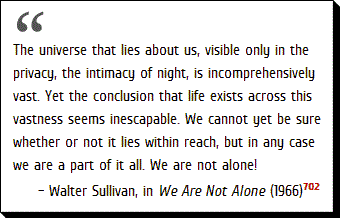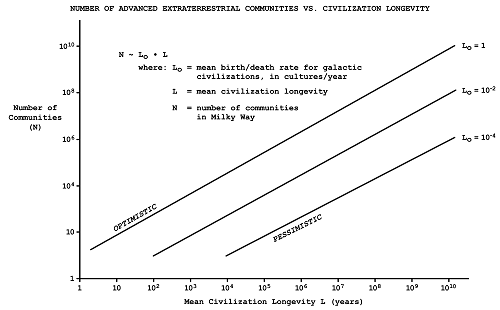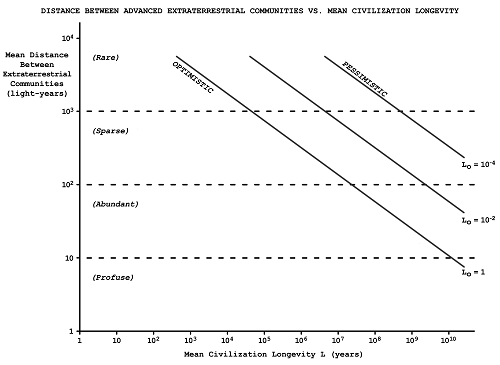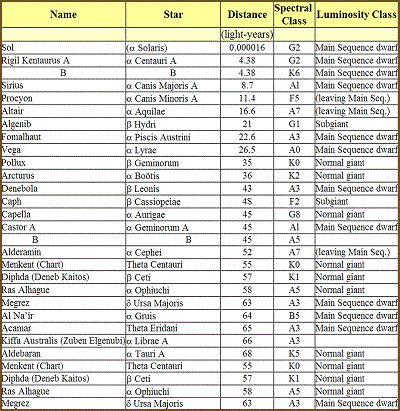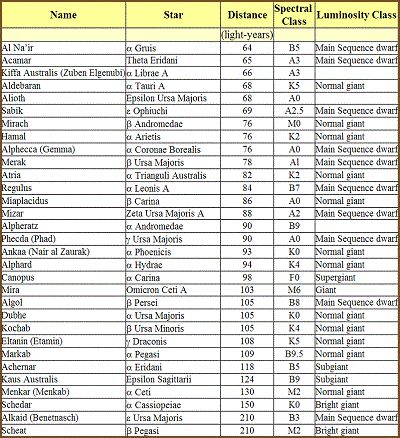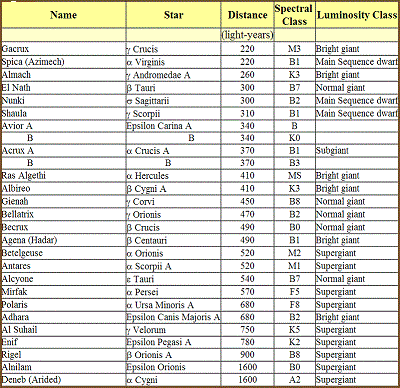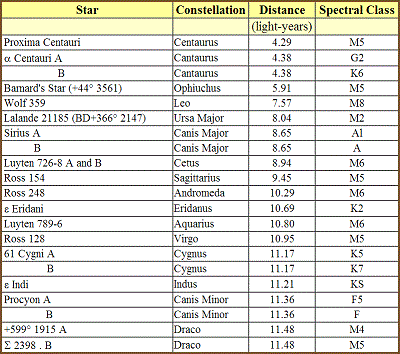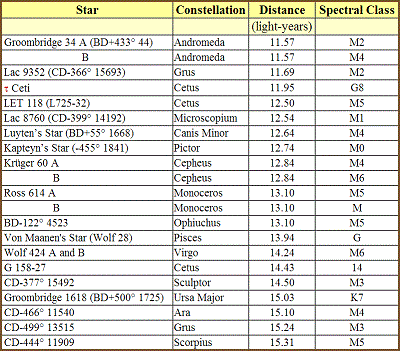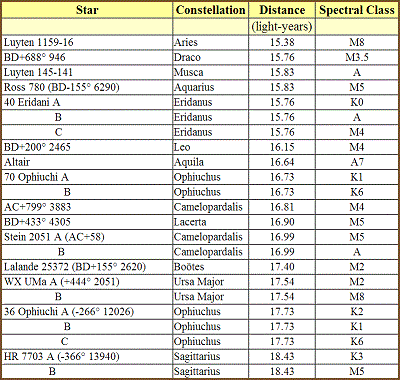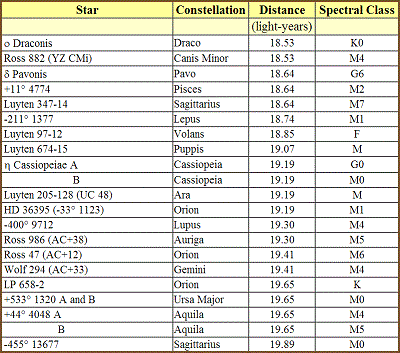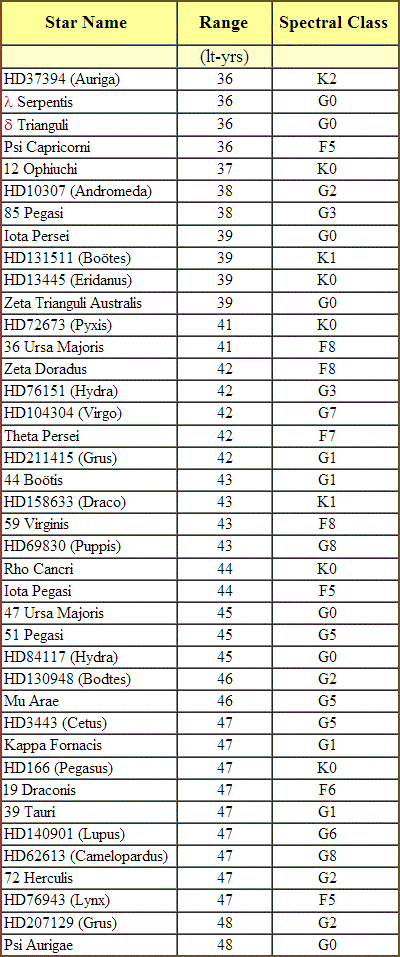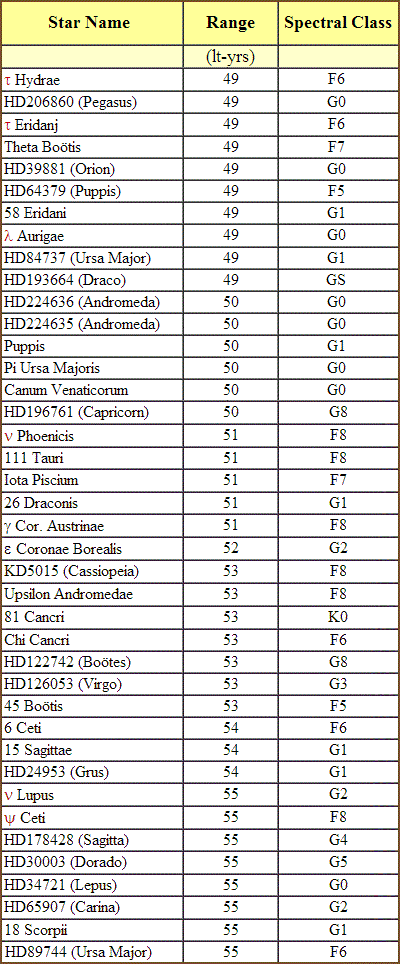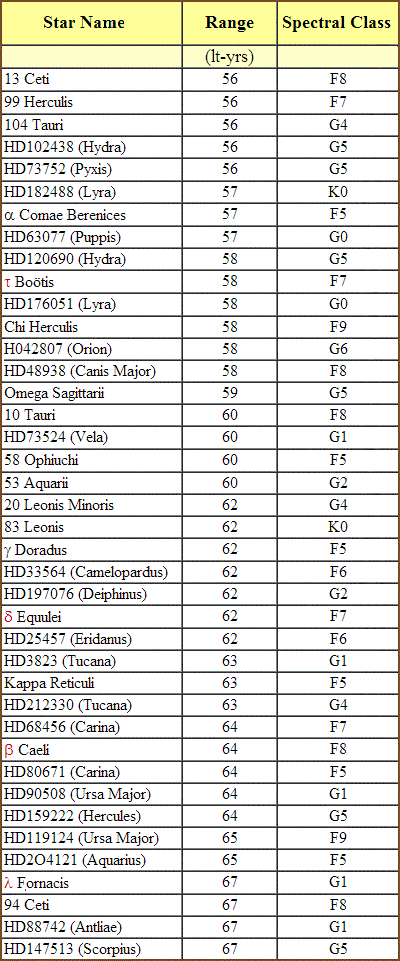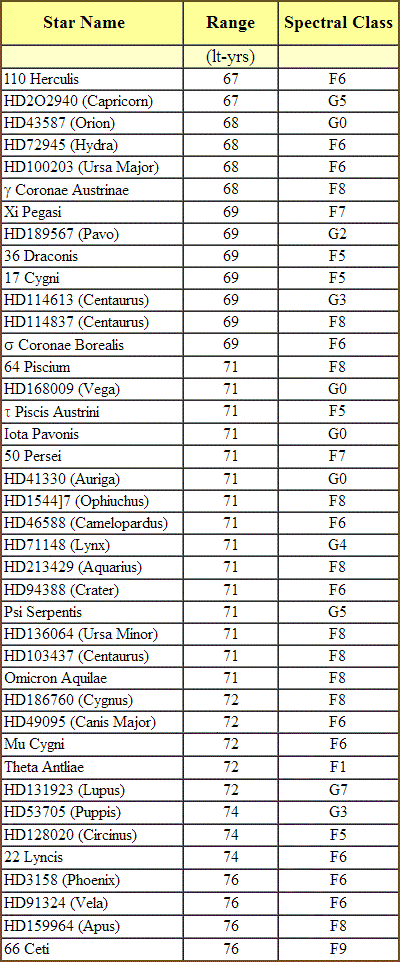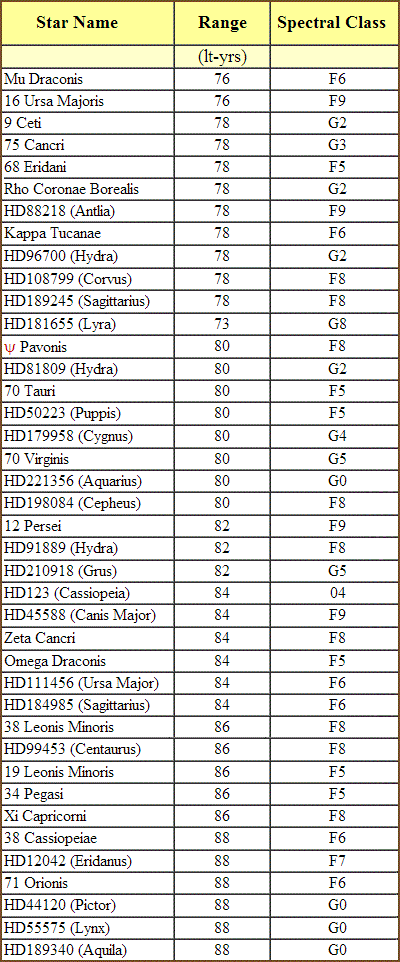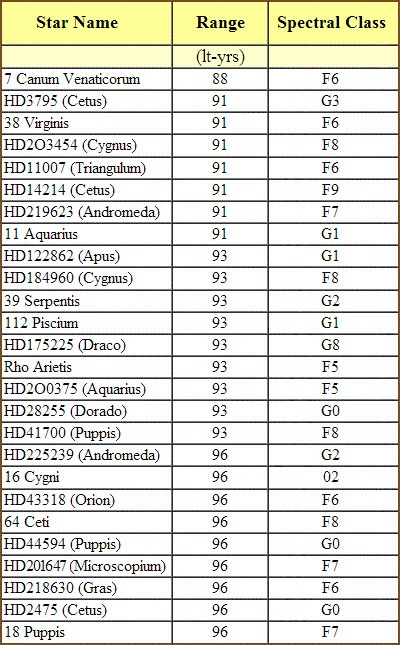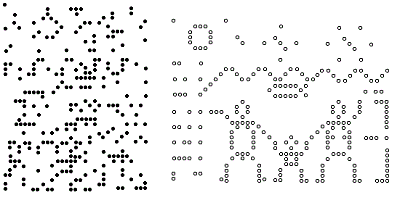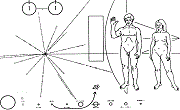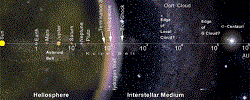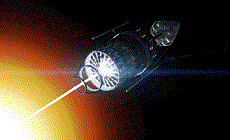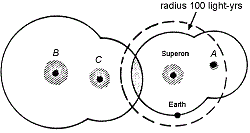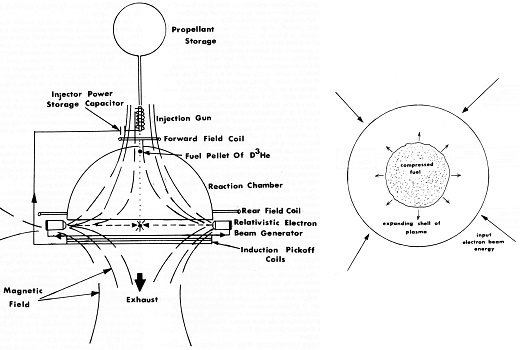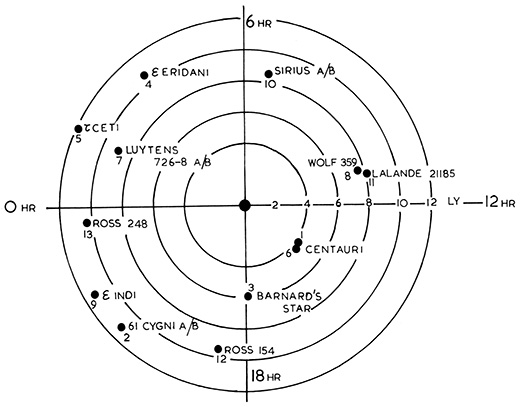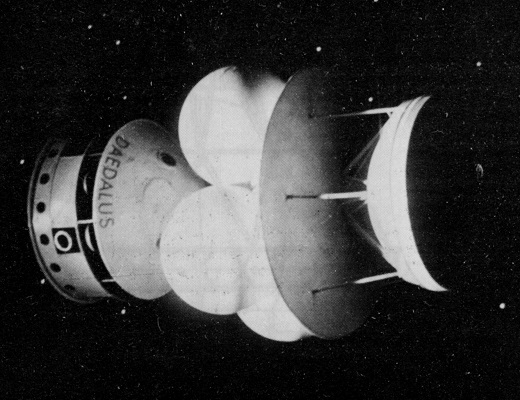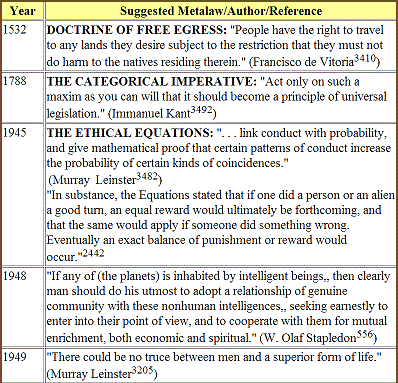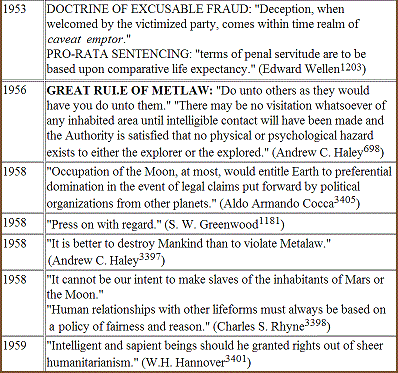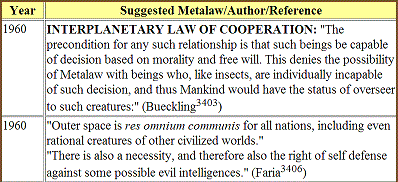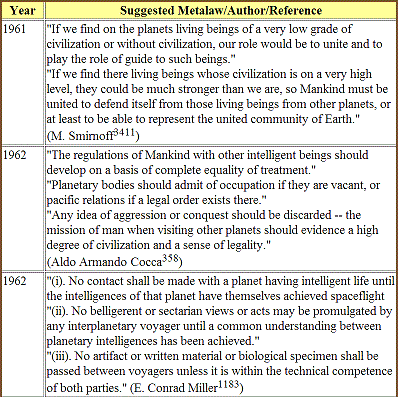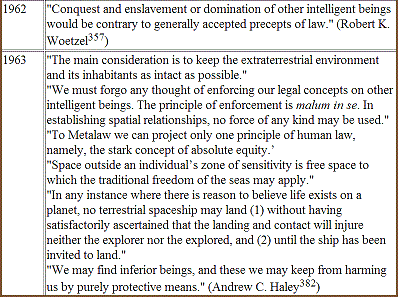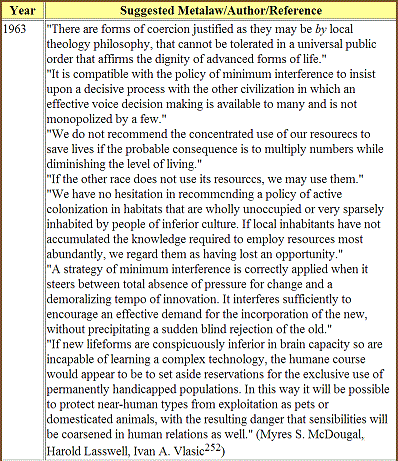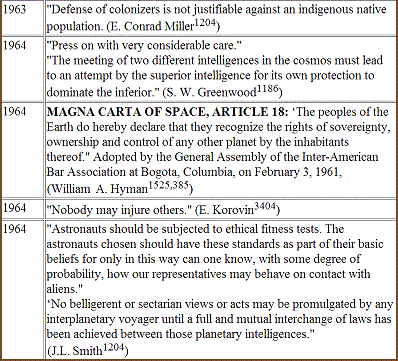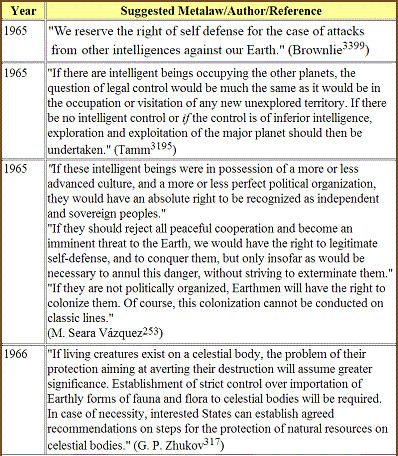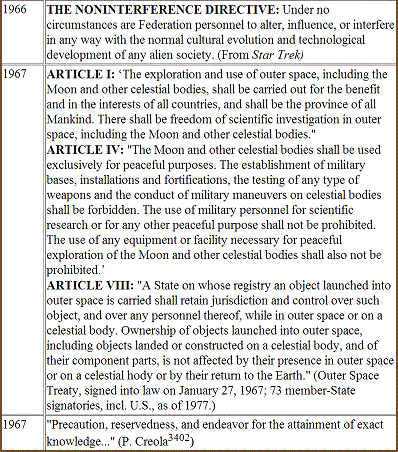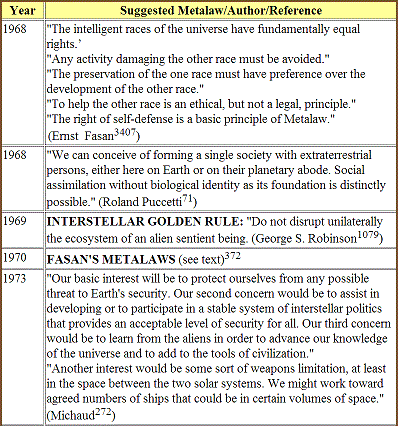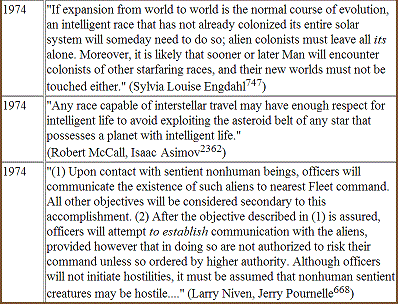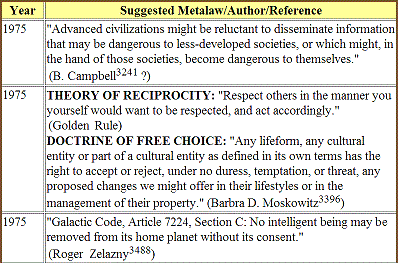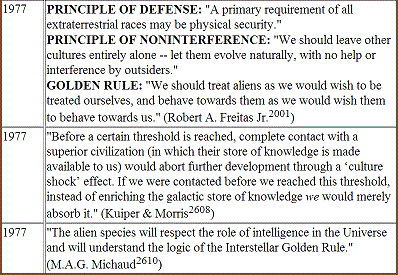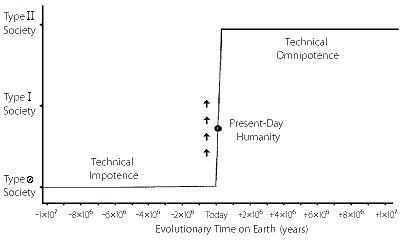© 1979 Robert A. Freitas Jr.
All Rights Reserved
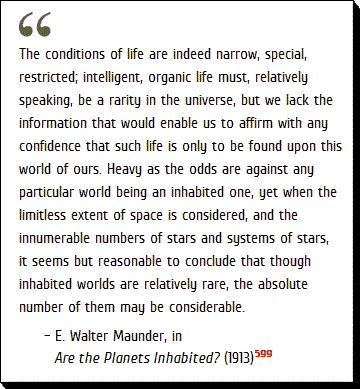 |
|
Such studies — sometimes
called Galactic Demographics by xenologists — are the primary concern of this brief introductory chapter. |
In previous chapters we have devoted much time to alternative alien biochemistries, physiologies, technologies, behaviors and cultural forms. Our discussion now turns from consideration of particular extraterrestrial races to the examination of the possibilities of interaction among them. When man meets alien, the human aspects of the event will be of monumental significance. Xenologists will be called upon to answer a number of very difficult questions.
| Difficult questions |
For instance:
- What is the optimum first contact procedure, both from the human standpoint and from the mutual perspective? How should we behave — and how shall we — when the fact of contact becomes widely known?
- What are the tradeoffs between physical security and the possibility of fantastic technological advancement and cultural enrichment?
- What is the best way to achieve understanding and community with a totally alien yet highly intelligent race of beings from another world, and what are the implications of their technology (or lack thereof)?
- Are there strong rationales for contacting other sentient species in the Galaxy?
- Why should They bother contacting us?
| Chances of first contact |
Before addressing these and many other fascinating issues, xenologists must consider a preliminary query: What are the chances that first contact ever will occur? In other words, is life, in general, distributed abundantly or sparsely throughout the cosmos? To answer this threshold question it is necessary to theorize in an informed manner upon the likelihood of extraterrestrial life, intelligence, and culture in our Galaxy, including its distribution and probable frequency. Much in the estimates which follow is highly speculative, but the methodology appears basically sound and yields a variety of curious results. (See especially Bond and Martin,3223 Bracewell,1041,80 Freeman and Lampton,1306 Hohlfeld and Terzian,2385 Kreifeldt,1263 Oliver and Billingham,57 Sagan,1317,22 Shklovskii and Sagan,20 Stull,3241 Sullivan,702 Tang,3087 von Hoerner,1054 and Wertz.1611)
Such studies — sometimes called Galactic Demographics by xenologists — are the primary concern of this brief introductory chapter.
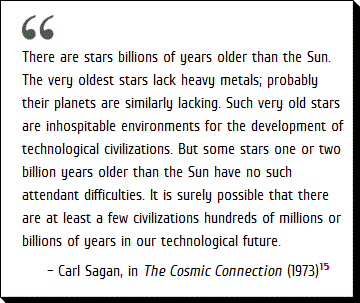 |
|
If this calculation
is correct, humanity is very much alone. |
The late Harlow Shapley was perhaps the first astronomer ever to seriously attempt quantitatively to estimate the frequency of extraterrestrial life in the universe.816 It is said that Shapley was more optimistic than his published estimates indicate, but that he deliberately chose extremely conservative numbers to forestall possible criticism from the scientific quarter. His calculation went something like this.
| The Shapley calculation |
- Suppose that only one star out of every 1000 has any planets at all.
- Further, let us presume that out of every 1000 worlds, only a single one is located an appropriate distance from its sun (and thus has a climate suitable for life).
- Then assume that out of all these well-placed planets only one in 1000 is big enough to hold an atmosphere, and that of these worlds, only one in 1000 has a chemical composition appropriate for the origin of life.
- Combining all of these factors, we find that only 1 star in 1012 is graced by life.
- There are at least 1021 stars in the universe so, according to Shapley, we may expect to find about 1,000,000,000 life sites in the cosmos.
|
Since the typical habitable galaxy has |
| One galaxy out of ten |
At first blush this seems like a very large number, but upon further reflection we see it is actually quite pessimistic. Since the typical habitable galaxy has about 1011 stars, only one galaxy out of ten will harbor any life at all. If this calculation is correct, humanity is very much alone.
| Shapley's cautious conservatism |
It appears that Shapley selected his step-factors of 1000 largely out of cautious conservatism without any real basis in genuine, established scientific findings. Subsequent formulations have been devised in an attempt to deal with this major failing of the Shapley calculation. The most popular alternative among xenologists today is the so-called Drake Equation1317 (or "Green Bank Formula"2358), named for its originator Frank D. Drake, a well-known American radioastronomer currently associated with the Center for Radio-physics and Space Research at Cornell University.
|
|
|
The Drake equation was developed to answer a specific and pragmatic question: How many advanced technical civilizations exist in our Galaxy, having both the interest and the ability to engage in interstellar communications of some kind? The earliest form of the Drake equation, much like the Shapley calculation, consists essentially of a string of probabilities that are multiplied together to achieve the final result.*
If N is the total number of communicative extraterrestrial civilizations, then, according to Drake:
- N = Nstar · fp · ne · fl · fi · fc
- Nstar= the number of stars in the Milky Way Galaxy which would be suitable suns for life-bearing planets;
- and
- fp = the fraction of these "good suns" actually having planetary systems;
- ne = number of planets with an environment suitable for life, per solar system;
- fl = the fraction of suitable planets on which life finally does arise;
- fi = the fraction of life-bearing worlds upon which intelligence appears;
- fc = the fraction of planets harboring intelligent creatures who go on
to develop the complex technology of interstellar communication.
| Skeptic's response |
Skeptics have wryly asserted that the Drake Equation is nothing more than a clever way to compress a large amount of ignorance into a very small space.
What values should we assign to these variables?
| Nstar value |
At the end of (Chapter 4), we concluded that about 5% of all stars in the Galaxy — roughly ten billion suns — should have characteristics suitable for the emergence of life. Most of these will lie in the Disk and the outer Core regions of the Milky Way. Hence we choose Nstar = 1010 "good suns."
| fp value |
What about fp? Astronomers now know that most stars are double or multiple.3260 Many "dark companions" have been confirmed, circling quite a few of the nearest stars, during the past century. There are numerous reports of possible planetary bodies (jovian-sized and larger) in orbit around a dozen or so of Sol’s stellar neighbors. In light of all the evidence, fp = 1 is probably reasonable.
| ne value |
How about ne? Based on the work of Dole and others, many astronomers believe that most single-star solar systems are likely to have from 7-13 major planetary bodies orbiting at various distances.1258,2714 Further, if we use our own system as an example of the typically exotic, we see that one out of nine planets has an environment suitable at least for our kind of life (carbon aqueous). So ne = 1 is certainly a plausible estimate. (Note that the possibility of lifeforms with alternative biochemistries merely serves to increase ne.) And recent studies of the origin of life on this planet seem to suggest that abiogenesis is virtually inevitable wherever a suitable environment exists, given enough time. There is wide spread agreement that setting fl = 1 cannot be too wide of the mark.
| fi and fc values |
What about the two remaining factors, fi and fc?
- Optimists generally assert that the development of intelligence is evolutionarily inevitable, since brains must serve the same negentropic master as the life process itself.
- In addition, they argue, intelligence begets society and society begets technology as population pressures mount and per capita resources dwindle.
- Under this view, fi = fc = 1.
Other scientists are not so sanguine about the inevitability of intelligence and culture.
- Human intellect has risen only in the last ~106 years, and culture in only perhaps ~105 years.
- This represents a mere 0.02% and 0.002%, respectively, of the total time life has existed on Earth.
- Maybe we’ve just been extraordinarily lucky, and conscious intelligence normally requires much more time to emerge.
- Or perhaps sentience usually fails to evolve at all before the local sun reaches the end of its life.
- And there are too many examples of technologically static and socially "arrested" cultures on Earth to ignore.
Scientists who have attempted to balance these conflicting "optimistic" and "pessimistic" viewpoints generally conclude that fi = 0.1 and = fc = 0.1 are not unreasonable numbers.3241
|
Table 23.1 Number of Stars, "Good Suns," and Intelligent Alien Races Within Radius R of Earth, using the Early Drake Equation Formulation |
 |
| One billion intelligent races |
Multiplying all six factors together gives:
- N = 1010 × 1 × 1 × 1 × 0.1 × 0.1 = 100,000,000 communicative technical civilizations in the Milky Way alone.
- Or, omitting the factor fc, we conclude that there may be as many as one billion intelligent alien races scattered throughout the Galaxy, each separated from the next by an average distance of 34 light-years.
Table 23.1 gives the estimated number of sentient extraterrestrial species expected to lie within a radius R of Earth.
| Dynamic version of the Drake Equation |
This simple form of the Drake Equation is static, however. It assumes that a communicative civilization, once formed, survives indefinitely. But all species eventually become extinct; even stars and galaxies eventually must die. Xenologists who work with the Drake Equation methodology prefer to include a dynamic component which takes account of the possible destruction of civilizations. This results in the "traditional" version of the Drake Equation, as follows:
- N = Rstar · fp · ne · fl · fi · fc · L
- Where Rstar is the mean rate of "good star" formation in the Galaxy
(1010 stars / 1010 years = 1.0 "good suns"/year) - And L is the average lifespan of a typical alien technical civilization.
Plugging in numbers as before, we find that:
- N = 1.0 × 1 × 1 × 1 × 0.1 × 0.1 × L = L/100.
- The mean lifetime of a civilization appears to be of critical significance in the calculation.
What do we do with L?
- Optimists may insist that technical cultures should be able to survive for 108 years.
- This corresponds roughly to the reign of the dinosaurs on Earth, and to the time ant society has persisted.
- There is no reason, argue the optimists, why humans and smart ETs could not do at least as well using the benefits of high technology.
- Accepting L = 108 years, then N = 1,000,000 sapient cultures in the Milky Way at the present time.
| Pessimistic viewpoint |
Pessimists point out that human technology is highly militaristic (and even that militarism may be necessary for the evolution of intelligence and technology3241).
- They note that the accumulated global destructive power today exceeds 10 tons of TNT (or its equivalent) per person.
- This may be viewed as a round ball of dynamite two meters in diameter hanging over the heads of every man, woman and child on Earth.22
- Initiation of global destruction rests in the hands of only a few dozen people, and the world military balance becomes more precarious with each passing decade.
- In the opinion of the pessimists, L may be on the order of decades, not eons. (Compare Berry77 and Viewing and Horswell3088 with Brown3272 and Hoyle.2998)
- Choosing the "generous" value of L = 102, the number of communicative civilizations extant in the Galaxy today falls to N = 1 (that is, us).85
|
The traditional Drake Equation may be written in the reduced form N = Lo L, where:
- Lo is the mean birth rate of new technical civilizations per annum in the Milky Way.
- Since deaths should equal births in a stable population, L may also be interpreted as the mean death rate of advanced societies. (Mathematically, Lo = Rstar · fp · ne · fl · fi · fc.)
- In the analysis above we found that N = L/100, or Lo = 10-2.
- An optimist, however, might choose Lo = 1 society/year, in which case N = L.
- A pessimist, on the other hand, might select Lo = 10-4 societies/year, which gives N = L/10,000.
- Once the xenologist has selected the cultural birth rate with which he feels most comfortable, both the number of extant technical communities and the average distance between them may be exactly determined.
- It is interesting to observe that only by making the most optimistic assumptions possible can we place the nearest advanced extraterrestrial civilization within 100 light-years of Earth.
(The results of choosing various ET community "turnover" rates are displayed on the graphs in Figure 23.1.)
| Improvements on the methodology |
Modern xenologists have made still further improvements on the methodology of galactic demography.57
- The traditional version of the Drake Equation uses a mean value for Rstar — the rate of formation of "good suns" in the Galaxy — which is averaged over the estimated 10 eon lifetime of the Milky Way.
- Yet astrophysicists recognize that the rate of star production from interstellar gases and dust has not held constant over time.
- Ten eons ago, the rate was perhaps two or three orders of magnitude higher than the mean; today, it is an order or two below.
- By taking this fact into account xenologists are more accurately able to calculate the number of alien civilizations which coexist (or have coexisted) in the Galaxy at any time t.
- In mathematical terms, the number N becomes the time-function N(t).
|
Figure 23.2 Population of Extraterrestrial Civlizations as a Function of Galactic Time(modified from Oliver1305) |
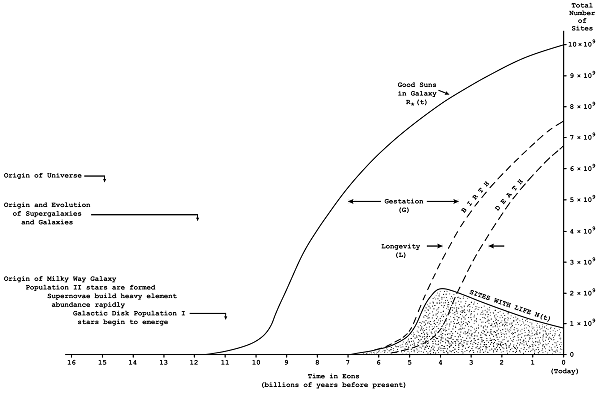 |
Consider the graph in Figure 23.2 at right.
- The leftmost curve, marked R*(t), represents the total number of solar systems suitable for the emergence of life as a function of galactic time. At each of these useful sites, xenobiologists tell us, life should originate within a few hundred million years.
- This event is then followed by a gestation time during which life and intelligence evolve, eventually resulting in the rise of a technical culture. For reasons that will become clear presently, we choose to set fi = fc = 1 (that is, Lo = 1) for the purposes of this calculation.
- In other words, we optimistically assume that every "good sun" eventually spawns an advanced alien civilization.
| Gestation time |
Applying the Hypothesis of Mediocrity and the example of Earth, xenologists believe that a good average value for the gestation time C should be on the order of that for human culture, about 4.5 × 109 years. Depending on local environmental conditions this quantity undoubtedly will vary considerably, but it seems that 4.5 eons is a reasonable mean or "expected" value.
| BIRTH to DEATH curve |
After the gestation period has elapsed, the number of sites in the Milky Way having communicative civilizations rapidly increases, following roughly the shape of the R*(t) curve. Later, when the average lifetime L of the typical technical culture has expired, extraterrestrial civilizations begin to die off along a curve parallel to the growth. (These two curves are labeled "BIRTH" and "DEATH" on the graph.) For reasons that will become apparent, we choose a very optimistic value for L of 109 years.
| Galactic population |
To obtain the Galactic population (the number of coexisting civilizations) at any given time t, galactic demographers simply subtract the death curve from the birth curve. The difference is the number of alien technical cultures which have been born but have not yet died at time t. On the graph this population curve is designated N(t).1305
| Humanity: a latecomer |
Perhaps the most fascinating result of this analysis is the size, shape and position of N(t).
- Apparently the population of coexistent technical civilizations peaked out about four billion years ago, when primeval ooze still slopped the rocky shores of ancient Earth.
- Humanity thus appears to be a latecomer on the cosmic stage — the majority of Galactic history has come and gone without us.442
- Seemingly, advanced life was more common in the past than it is now.57
- While there still exist a billion sites of life extant in the Milky Way today (50% of the peak reached 4 eons ago)
- There are some seven billion sites of extinct alien civilizations for starfaring archaeologists of the future to pore over.
- In other words, about 7 of every 8 technological alien cultures that have ever existed are extinct today.
It now becomes clear why we chose such optimistic values for fi - fc - and L.
| Choosing more conservative numbers |
Changing these numerical assumptions to more pessimistic values does not alter the sobering conclusion that humanity may have missed most of the Galactic action. For L, we’ve already selected as optimistic a figure as common sense will permit; smaller values merely serve to decrease the galactic population overall and to shift the peak of N(t) further back in time. Choosing more conservative numbers for and in the Drake Equation has a similar effect. In fact, only by positing an unreasonably lengthy mean gestation time plus mean lifetime (G + L) greater than 12 billion years can demographers arrange for humanity to sit on the rising side of the curve representing the civilized population of the Galactic community.
 |
Where might we expect to find alien life and civilization in nearby extrasolar space?
The following three tables may serve as starting points for discussions of this speculative question.
Due to unavoidably deficient data, Table 23.4 is complete only out to about 40 light-years. From 40-100 light-years, data are available only for about 25% of the "good suns" expected to lie at this range. The deficiency is almost exclusively among the class K stars (which are harder to measure at great distances) beyond 40 light-years, although many late class G suns are also missing beyond 50-60 light-years.
|
Table 23.2 lists the 75 brightest named stars in the night sky of Earth. Table 23.3 gives a complete inventory of all luminous stars within 20 light-years of Sol. Table 23.4 includes a listing of all "good suns"* within 100 light-years (30 parsecs) of Sol. |
|
|
* In this context, a "good sun" is a Main Sequence dwarf (Sol-like) belonging to stellar classes F5-K2. The nearest to Sol is the α Centauri star system,3089 which recently has been discovered to be 6 eons old and significantly richer in heavy elements than our own solar system.3224
|
Table 23.5 Possible Planetary Companions of Nearby Stars |
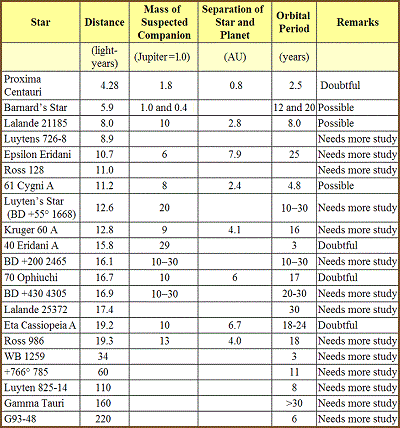 |
Assuming habitable worlds circle some or all of these distant stars, how might they be detected from Earth? There are four basic techniques, none of which has as yet provided absolutely unambiguous evidence for the existence of extrasolar planets.* The present state of the data is summarized in Table 23.5, at right.
| Technique of astrometry |
Certainly the most fruitful approach to date has been the technique of astrometry.
This requires a bit of explanation.
- It will be recalled that all stars in the Milky Way orbit the galactic center much as planets circle a sun.
- Since each star moves with a slightly different velocity, celestial objects appear slowly to change position relative to each other over the years.
- Slowly, inexorably, the familiar constellations are torn asunder as the component stars move off in different directions at different speeds.
- For instance, the stars Sirius, Betelgeuse, Aldebaran and Arcturus have moved about the apparent diameter of the moon (Luna) since Ptolemy mapped them two millennia ago.
- The path traced in the sky by a wandering star is referred to as its "proper motion" by astronomers.
| Invisible companion bodies |
A lone sun traces a straight path across the sky, but a star with a retinue of invisible companion bodies should wobble slightly as it traverses the celestial vault. This is because the presence of the unseen planetary masses shifts the center of mass away from the center of the sun.
- The star, like its planets, actually circles this center of mass, which distant observers may observe as a tiny sinusoidal wobble with a period on the order of decades.
- Astrometry is a form of careful positional measurement which allows astronomers to calculate the mass and orbit of the hidden worlds based on the amplitude and frequency of wobble in the proper motion of the target star.
| Accurate measurements |
Imagine an hypothetical alien astronomer located 10 parsecs (33 light-years) away who wishes to demonstrate the existence of planets around Sol using astrometry. How accurate must his measurements be?
|
A minute of arc, or arcminute is
|
- Viewed from this distant observatory, our sun would subtend only 10-3 arcsec (seconds of arc, or 1/3600 of a degree) in the sky.
- One-half an arcsec away from this minute yellow disk is found the giant planet Jupiter, a shining pinprick of light 10-4 arcsec in diameter.
| Perspective on extremely high accuracy |
It is helpful to put these numbers into proper perspective in order to fully appreciate their smallness.
A second of arc is considered extremely high accuracy in all normal circumstances.
- One arcsec is the equivalent of hitting a buzzing horsefly with a rifle bullet at a range of 2 kilometers.
- But Sol would subtend only 10-3 arcsec, which is like hitting the same horsefly in New Orleans by firing a rifle in Los Angeles (more than 2000 kilometers).
- To use another example, consider a level tabletop. When you touch it lightly, it tilts by at least a second of arc.
- At the 10-3 arcsec level the table is like the surface of a sea — acoustic waves from people talking wash back and forth across its surface and "tilt" it by more than milliseconds of arc.
- To observe Sol’s wobble due to Jupiter, our hypothetical ET astronomer would have to be able to measure variations in proper motion of about arcsec at a range of 10 parsecs.
- The displacement of our sun due to the presence of Earth is considerably smaller, less than 10-6 arcsec at 10 parsecs.
- The state-of-the-art of astrometric precision was roughly 3 × 10-3 arcsec for human technology in the mid-1970s, which means that mankind is now at the threshold of the capacity to detect jovian planets circling neighboring stars.2200
- Scientists believe that sophisticated interferometric techniques2387 can increase ground-based accuracy to 50 × 10-6 arcsec, and that large spaceborne telescopes specially designed for the task can reach 10-6 arcsec accuracies.3092,2865 (NASA’s 2.4-meter Space Telescope has pointing stability of 0.007 arcsec.)
| Difficulties with astrometry |
|
It is helpful to put these numbers A second of arc is extremely high One arcsec is the equivalent of hitting Sol would subtend only 10-3 arcsec, |
The major difficulty with astrometry is that several cycles of the alien planet must be observed to identify and validate a discovery, which means several decades’ worth of data must be accumulated. Furthermore, the presence of more than one perturbing planetary body (Sol has 9) greatly complicates the mathematical analysis of periodicities in the wobble in proper motion of the target star.
To date, only astrometry has been exploited in the search for extrasolar worlds. But three other promising techniques have been discussed at length in scientific circles. The first of these is called the spectroscopic or "radial velocity" method.
| Spectroscopic method |
Whereas proper motion is the apparent movement of a star across the sky, stellar "radial motion" is its velocity towards or away from us. We recall that light emitted from a moving object undergoes a Doppler shift in wavelength depending on the relative velocity of source and observer.
- By measuring the Doppler shift in a star’s visual spectrum, astronomers are able to determine its radial velocity.
- If a massive planet is present, then its orbit will cause the star’s radial velocity to oscillate much like the wobble in proper motion discussed in connection with astrometry.
- Rather than a positional undulation, however, the planet-hunting spectroscopist is looking for minute cyclical variations in Doppler-shifted starlight.
- This requires an instrument accurate to 0.08 mm visible light, able to detect variations in radial velocity on the order of 5 meters/second.1568
- To date, the most sophisticated equipment has accuracies about an order of magnitude too low, but astronomers estimate that the state-of-the-art should progress enough in a decade or two to make the spectroscopic method feasible.2865
| Photometry |
Photometry is another promising technique.
- If the orbital plane of the target solar system happens to lie precisely in our line of sight, then at some point planets will cross the face of the star and partially eclipse its light.
- If a planet the size of Jupiter crossed in front of a star like Sol, the decrease in brightness would amount to about 1% change in total luminosity. (Passage of Earth would only cause a minute 0.008% eclipse, and so on.1259)
- Astronomers believe that the colorimetric and photometric eclipse signature should be fairly easy to detect and to identify.1266
- One writer has calculated the probability of the onset or termination of an eclipse by any one of Sol's planets during a typical 6-hour observation period (a single night’s work at the telescope).
- For a randomly situated extraterrestrial observer, using the techniques proposed, the expected detection rate could be as high as one new solar system per year.
- About one star in a hundred should have a line of sight close enough to the orbital plane around Sol to allow all four of our inner planets to be detected by alien astronomers.**1259
- Human astronomers should prove equally lucky.
| Direct observation |
The third most promising method for spotting other worlds is direct observation.
There are two main difficulties involved in this.
First there is the problem of optical resolution.
- Seen from 10 parsecs away, Sol and Jupiter appear only 0.5 arcsec apart — close to the limits of present-day ground-based telescopes.
- And planets smaller than Jupiter at the same distance, or jovian worlds farther from the star, probably could not be resolved using present instrumentation.
- The image of the star and planet would blur together.
The second main difficulty is that the extrasolar body we seek is very faint.
- Shining in reflected light, the luminosity of the planet is only about 10-8 that of the stellar primary in the visible wavelengths.
- Dr. Bernard Oliver of the Hewlett-Packard Corporation has estimated that sophisticated "apodization" techniques (a mask fitted over the end of the telescope to selectively reduce the brightness of the star’s diffraction pattern) could be used in a 2-meter spaceborne telescope which would just barely permit a jovian world to be resolved.2865
- Indeed the Space Telescope, due to be launched by NASA in the early 1980’s, should fulfill these requirements and permit the first direct imaging of extrasolar planets.2103
Another solution to the problem is to shift to lower frequencies where the star is relatively less bright.
- For example, in the infrared the luminosity differential falls from 10-8 to 10-4.2865
- In the radio things are even better: Fennelly and Matloff have estimated that jovian planets may be detectable out to 10 parsecs using intercontinental interferometry at radio wavelengths.1453
Ultimately it would be nice to be able to take detailed color photographs of terrestrial worlds across interstellar distances. Is this possible?***
| Spaceborne occulter apparatus |
Lyman J. Spitzer, Director of the Princeton University Observatory, has proposed a spaceborne occulter apparatus.3080
- In this scheme, an orbiting large space telescope is pointed at the target star.
- A disk of black material is then placed in the instrument’s field of view in such a way that it exactly covers up the image of the star.
- The blazing brilliance of the primary is blotted out, permitting the detection of much fainter planetary bodies.
- According to Spitzer, NASA’s Space Telescope should suffice to resolve a jovian 10 parsecs away if an occulting disk 75 meters wide is placed 10,000 kilometers in front of the telescope.
- To spot an Earthlike extrasolar world at the same distance, a 400-meter-wide disk must be accurately positioned 250,000 kilometers ahead of the telescope.
- Citing the practical problems inherent in such a proposal, a few authors have advocated using Luna as an occulter.3189,1095
- To pick out jovians at 10 parsecs, a 3-meter space telescope should be placed in a near-polar 8100-km-high lunar orbit.
- The curved limb of the moon periodically would blot out the star light, making possible at least minute-long observations of reflected extrasolar planet light.
- To spot Earthlike worlds, a 7-meter space telescope should be placed in high Earth orbit, again using the distant Luna as an occulter.
| Huge multi-mirror arrays |
Still larger systems could actually begin to resolve features on the surfaces of these faraway celestial bodies. The possibility of constructing orbital and lunar telescopes comprised of giant mirrors or huge multi-mirror arrays has been discussed in the literature.3091,3085 According to Gerard O’Neill, the fabrication of large space structures should make interstellar imaging a snap:
- It might be preferable to take advantage of a zero-gravity location by building a large number — perhaps 10,000 — of individual glass mirrors, each a meter in diameter, and providing each with a small locator-module, equipped with station-keeping gas jets.
- If the 10,000 elements were linked only by light beams, their spacing could be established by the unvarying number of wavelengths of light between each pair.
- That nonphysical linkage, computer-controlled, would have the further advantage that the mirrors could be programmed to separate and reform, like dancers in a slow-motion ballet. … If located in a cross-shaped array, with individual elements spaced ten meters apart, a telescope of that kind would have the theoretical capability of resolving something as small as a changing weather system, one thousand kilometers on a side — on the planet of a star ten light-years away.2710
* See reviews by Gatewood,1567 Huang,1278 Martin1452,1088,1092 Matloff and Fennelly,1614 Morrison, Billingham, and Wolfe,2865 O’Leary,1244 and Smith.2866
| Variation of the photometric method |
** Edward Argyle at the Dominion Radio Astrophysical Observatory in Canada has proposed a clever variation of the photometric method. Planets shine with reflected light and are located several light-minutes from the source of illumination (the star). If the emitted starlight varies, the portion reflected by the planet will be delayed in time behind the rest of the solar output. Careful photometric measurement, says Argyle, should permit the separation of these "light-echoes" from the normal starlight, thus demonstrating the presence of reflective planetary bodies and proving the existence theorem for extrasolar worlds.1289
| Giant red star Betelgeuse |
*** The surface of Betelgeuse, the giant red star in the constellation Orion, has been successfully photographed using computer-enhanced "speckle interferometry" techniques.411,3090 Surface structures are clearly visible in the photos.
 |
|
Innumerable intelligent
extraterrestrial races. |
Most xenologists today earnestly believe that millions upon millions of inhabited worlds pepper the Disk of the Milky Way. Innumerable intelligent extraterrestrial races may await contact and communication with humanity. How might scientists — human or alien — best bring this about?
| 17 million acre Pythagorean theorem |
More than a century ago the great mathematician Karl Friedrich Gauss set forth the startling suggestion that the only way to communicate with sentient beings on other worlds was by means of a "mathematical language." Gauss’ idea for contacting the inhabitants of Mars was to lay out the figure of a giant right-angle triangle in the middle of the Siberian forests. His plan called for 15-kilometer-wide strips of forest to delineate the lines and golden fields of wheat to fill the interior of the symbol. The geometric solution to the Pythagorean theorem, Gauss believed, would communicate the fact of terrestrial intelligence to any Martian astronomers who happened to be eyeing our Earth. (One writer has estimated that the scheme would have involved more than 4 million acres of forest and nearly 13 million acres of wheat, a total area roughly the size of the entire country of Ireland.45)
| Flaming symbols in the Sahara |
In Vienna, the astronomer Joseph Johann Littrow, a pioneer in spectrography, is reported to have proposed that great canals be dug in the Sahara desert in the shape of a variety of geometrical figures — circles, squares, triangles, and so forth. Each would measure perhaps 30 kilometers on a side and would be filled with water. For signaling purposes, kerosene was to be spread over the surface of the water and ignited. The flaming symbols, it was expected, would alert observant Martians to our presence on this planet. Assuming the ditches were 1 kilometer wide and the layer of petroleum many centimeters deep to permit a burn of several hours’ duration, roughly five million cubic meters of kerosene would be required each night (at a cost of $400 million at current world prices).
| Signaling mirrors |
Another magnificently implausible project was put forth by Charles Cros, a Frenchman, in 1869.3101 Cros apparently spent much of his life trying to persuade the French government to help him construct a giant mirror to send messages to Mars.
|
Xenologists may draw two specific
conclusions from the above discussion. scale is virtually impossible for any Type I civilization, transmission of signals is probably the method of choice for such technologically-limited planetary cultures. energetically equivalent exercises for technically proficient Type II and Type III civilizations, both probes and signals probably will be utilized in interstellar communications depending on the particular purposes and needs of the societies seeking interaction. |
- The device was planned to have a focal length equal to the Earth-Mars separation, thus permitting Cros to focus concentrated sunbeams onto the Martian desert. This would melt the sand, and Cros could then carve various figures and numbers on the surface.
- Another technique using mirrors involved the construction of a large checkerboard of shiny surfaces which could be covered and uncovered in sequence to describe patterns and shapes (a kind of slow-motion semaphore).
- Yet another scheme was advanced by one Schmoll, who wanted to establish mirror works at Bordeaux, Cherbourg, Marseille, Stockholm, Amsterdam, Copenhagen, and upon the shores of the Gulf of Bothnia to give the appearance of the Big Bear constellation (Ursa Major) as seen from space.*,**
| Limited knowledge |
It is hard for us today to fathom how anyone could have taken any of these proposals seriously. But a century ago the state of xenological knowledge was extremely poor.
- Little was known of the actual conditions on the surface of Mars or any other planet in our solar system.
- The size and extent of the Milky Way Galaxy was unknown and undreamed of.
- Extrasolar worlds were believed extremely rare.
- And radio waves had yet to be discovered.
Gauss and Littrow were forced to speculate within the bounds of their limited knowledge, and arrived at conclusions which seemed moderately plausible at the time. It is sobering to consider that hundreds of years from now the people of the future may regard our own current proposals with equal astonishment and disbelief.
| Probes or signals |
Xenologists today believe that there are two fundamental avenues of contact that are feasible across interstellar distances:
Probes (or artifacts) and signals. As one writer puts it:
People in SETI {Search for Extraterrestrial Intelligence} can be divided into two groups: listeners and travelers. Listeners believe that interstellar travel is so difficult and costly that the only practical method of contacting an extraterrestrial civilization is by using radio messages. Travelers believe that voyages between stars are practical for advanced civilizations. Travelers are in the minority.3251
| Talk or travel: Which is superior? |
Which is the superior mode of communication? That is, are probes or signals better? The answer to this seemingly innocuous question is not at all obvious. Both talk and travel are commonplace on Earth, and we cannot use as our guide any current human technology (which elsewhere in the Galaxy may be found in a variety of states of retarded or advanced development). Xenologists most properly must seek to address the question in a manner independent of the vagaries of human technological history. Judgment criteria must be selected which spring from those basic and nigh universal laws of existence which all sentient races and alien cultures share in common.
Certainly the most basic goal of life and intelligence — the accumulation of information and complexity — involves judicious energy-flow management. Evolution via natural selection generally favors those living systems which manage their limited resources most efficiently. In other words, of two organisms, one of which is less wasteful than the other, the more frugal but equally effective creature has a higher probability of being favorably selected for survival.
| Principle of Economy |
On this basis, astronomer Frank Drake has proposed what he calls the Principle of Economy. This is the notion that economy is practiced universally or nearly so, or at least represents the ideal. Drake argues that technological civilizations everywhere in the Galaxy will attempt to choose those alternatives which are least expensive:
They, like us, will use procedures which minimize the needs for personnel, materials, and energy to achieve their ends. It may seem that economy or thrift is a peculiarity of mankind or of life on Earth, but in fact it is a principle practiced by all living things simply because the resources to support life are limited on all other planets as on the Earth. Planets have a limited surface area, limited food supplies, and limited energy sources, and this has been in fact the basic cause for evolution in the first place. The ability to practice economy with the available resources has enormous survival value and will be developed in all living things. Therefore, it is quite reasonable to believe that the concept of economy is well established in civilizations throughout the universe.3284,3123
| Applicable from cells to societies |
It is quite possible that some races may not be subject (or as subject) to the same competitive rules of natural selection as are we — recall, for example, Sneath’s "soil creatures" mentioned in (Chapter 6). Still others may choose a shorter-lived, more profligate lifestyle than ordinary thrift would dictate. But general living systems theorists agree that Drake’s principle is applicable virtually at all levels of living systems from cells to societies, since it appears to be a manifestation of the well-known principle of least effort.3071
| Joules: the units of "cost" |
If xenologists accept Drake’s Principle of Economy, then it follows that a technical communicative civilization will choose those means of communication which cost the least to do the job. The "job," of course, is the transfer of information and complexity across interstellar distances. The quantitative units of information are bits. (See discussion, Chapter 14.) Assuming that all data must be carried on markers of matter-energy, the units of "cost" are joules. Our criterion for judging whether signals or probes are superior thus reduces to the simple query: Which mode of communication maximizes bits/joule transmitted per unit time interval?
Unfortunately, to answer this question we need to do a little physics. Readers who are not mathematically inclined may skip the next three paragraphs.
| Signaling by photons |
Consider signaling by photons (radio, microwave, visible, ultraviolet, x-rays). According to Shannon’s classic theory,3186 the rate of information transmission through a channel of frequency bandwidth nmax is nmax log2(1+S/N) bits/second, where S/N is the signal-to-noise power ratio. This rate is a theoretical maximum when bandwidth equals carrier frequency; that is, when nmax = n. From quantum physics we know that the energy per carrier photon is equal to hn joules, where h is Planck’s constant. Hence we calculate that the maximum theoretical photonic information transmission efficiency eg is:
- eg = {log2(1+S/N)} / h bits/joule-second
| Signaling with masses |
Consider next the possibility of signaling with masses. Any self-contained material system of mass m is subject to a limitation in the maximum energy it can utilize as a marker for carrying information. That limit is the mass-energy of the matter, or mc2 where c is the speed of light. If we use energy levels as markers, then Heisenberg’s Uncertainty Principle defines a minimum measurement accuracy for these markers: DE Dt > h, where DE is the uncertainty in energy and Dt the duration of the measurement. According to Bremermann,3072 the optimal use of a given amount of mass-energy available occurs when (mc2 / DE) markers with values between zero and DE are used (which permits the representation of mc2 / DE bits). This means that no material mechanism of mass m using energy levels as markers can measure more than mc2Dt / h bits during the time interval Dt. Hence, the maximum rate of information transmission is mc2 / h bits/second. From special relativity we know that the total energy (mass-energy plus kinetic energy) of any material body is mc2 / (1-v2/c2)½, where v is the velocity of the mass relative to a stationary frame of reference. Hence we calculate that the maximum theoretical information transmission efficiency for matter em is:
- em = (1-v2/c2)½ / h bits/joule-second
|
Figure 24.1 Comparison of the Theoretical Maximum Information Transmission Efficiency of Photonic and Matter Markers |
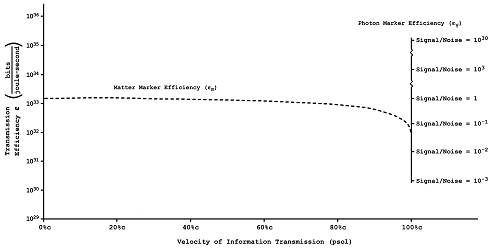 |
| Efficiency of Photonic and Matter Markers |
Maximum photon efficiency eg and maximum matter efficiency em for the transmission of information are compared on the graph in Figure 24.1.
- Photon efficiency is represented by the vertical line at the right, which shows different efficiencies depending upon the signal-to-noise ratio achieved.
(Note that the effect of S/N on efficiency is negligible at the upper end.) - The matter efficiency function curves downward to the right, and lies below the photonic efficiency for all S/N > 1.
Strictly speaking, then, photons would appear always to give the most bits/joule.
| Energetically indistinguishable to Types II and III |
But the truly amazing feature of the two curves is their unexpected convergence. If any reasonable velocity and signal-to-noise ratio are chosen for comparison, the difference in transmission efficiency is only an order of magnitude or two. To advanced Type II and Type III technical civilizations equipped with virtually perfect photon- and matter-handling technologies, the choice of communication mode probably will depend far less upon energy economy than on other considerations (see below). With few if any technological limitations on their activities, stellar and galactic cultures most likely will view signals and starprobes as energetically indistinguishable alternatives for interstellar communication.
| Type I: a few volts in wire-mesh dish |
Type I societies are another matter, however.
Lacking advanced technological expertise, planetary civilizations will be forced to rely upon the most primitive, simpleminded, easy-to-construct communications devices imaginable. Across interstellar distances radio waves, which require nothing more complicated than a small metal wire-mesh dish and a few volts of electricity, seem to be the best bet for technological dullards.
| Two conclusions |
Xenologists may draw two specific conclusions from the above discussion. |
- First, since interstellar travel on a large scale is virtually impossible for any Type I civilization,3078 transmission of signals is probably the method of choice for such technologically-limited planetary cultures.
- Second, since starprobes and signals are energetically equivalent exercises for technically proficient Type II and Type III civilizations, both probes and signals probably will be utilized in interstellar communications depending on the particular purposes and needs of the societies seeking interaction.
| Blinking the world’s radio stations |
* A modern version of the Gauss-Littrow proposals has been suggested by Kh. Geshanov, a Bulgarian, who recommends turning all the world’s radio stations on and off in careful synchrony, providing a regular "blinking" effect in Earth’s artificial radio emissions.1331
| Alternative take on the Tunguska event |
** In March of 1964, two Russian science fiction writers put forth the idea that the Great Siberian Meteorite of 1908 was caused, not by a fallen object, but rather by an attempt at communication (a powerful laser beam) by the planets orbiting the star 61 Cygni.3267
 |
|
Essentially, the idea is to try to observe
a kind of "cosmic advertisement" that says loud and clear, "Here we are! Look at us!" |
Before any two sentient races may converse across the interstellar void, they first must have each other’s attention. Each civilization must know who or what to look for, where and when to look, and how, technologically, to communicate. This is the problem of "acquisition." Each party must know that the other exists.
| Cosmic advertisement |
A number of interesting acquisition techniques have been discussed in the literature, and will be dealt with in the following sections. But there is another approach — called the "cosmic miracle" — which bypasses entirely the need for mutual acquisition. The cosmic miracle method allows one civilization to detect another without that other necessarily being aware it has been discovered. Essentially, the idea is to try to observe a kind of "cosmic advertisement" that says, loud and clear, "Here we are! Look at us!" The advertisement may be purposeful, or merely the natural byproduct of large-scale astroengineering projects. But it should be obvious.
| "Billboard" in the sky |
It is surprisingly difficult to imagine a plausible celestial signpost that is clearly artificial. At first, it seems simple enough.
For instance, imagine we design a brilliant glowing "billboard" in the sky.
- It should be rectangular in shape with sharp edges and distinct vertices, and measure some fraction of a light-year on a side (say, 0.3 light-years).
- We make its color fiery crimson to attract the attention of visible-visioned creatures.
- At the exact center of this celestial marquee we place our premiere attraction: The star system to which we wish to call attention.
- The adjacent star field, as viewed from the most probable direction of contact, is nearly empty, so the star of our show has little competition for the spotlight.
Surely such a setup would be "clearly artificial," a sufficiently strange cosmic miracle to warrant the conclusion of sentient extraterrestrial intervention?
| The Red Rectangle |
Sorry not! The above is an excellent description of the so-called "Red Rectangle" (actually it is shaped more like a very fat hourglass), discovered by astronomers back in 1915. The object, located near the southern border of the constellation Monoceros, lies 1100 light-years from Earth. The central star (HD 44179) is a visual binary, and both components are believed to be late spectral class B.3102 Astronomers have attempted to explain the appearance of the rectangle as a complicated reflection of reddish starlight from a surrounding disk of dust.2076
| Stellar markers |
Many unusual possibilities crop up repeatedly in the literature. One proposal is to place in orbit around the target star a cloud of material that absorbs some uncommon band of radiation in the stellar spectrum. Viewed from afar, the star would appear to possess an artificial spectral line of unknown origin.
- The creation of such a stellar marker, as discussed by Drake and several others, would require dumping perhaps 400 tons of matter into circum stellar orbit.312
- This marker material ought to be of a type that is difficult to explain by natural causes — for example technetium, a short-lived element (half-life 2 million years) which does not occur naturally on Earth or, presumably, other worlds generally.
- It is said by the proponents of this scheme that the presence of unusual markers in the spectrum of a stellar atmosphere would be difficult to explain as anything other than fairly recent technological activity by alien beings.
- Unfortunately, a great many natural "technetium stars,"3103 "platinum stars,"3104 and so forth are already known to astronomers.
| Giant signaling beacon |
Philip Morrison at MIT has suggested that a star could be converted into a giant signaling beacon if an opaque screen of dense particles were placed in orbit around it. The clouds would periodically cut off enough light (in certain preferred directions) so that the sun would appear to be flashing when seen from a distance. According to Morrison:
[The cloud] would have to weigh about 1017 kilograms (the mass of a comet), distributed in micron-size particles over a 5° zone of a sphere surrounding the star, and moving in an orbit like the orbit of a planet. If this could be modulated every six months or so., taken away and put back again, or changed to affect the interstellar intensity, we could make it beam a series of algebraic equations at us. Perhaps in that remote galaxy, some patient signalers have for 50 million years tried to modulate a star.1053
(In 1970 it was reported that the eclipsing binary star CV Serpentis had stopped eclipsing, for reasons unknown.1163)
| Stranger sights |
Still stranger sights have been observed in the sky by astronomers. |
- There are Cepheid stars and RR Lyrae variables, suns which beat like great cosmic hearts, expanding and contracting rhythmically over fixed intervals of time. (The surface area of such objects actually grows and shrinks by as much as 40% during each cycle.1810)
- Cepheids typically are 3000 times more luminous than Sol, with periods between 1-100 days.
- RR Lyrae variables are about 100 times brighter than Sol, with cycles from 7-16 hours.
- Each star in this class of objects has its own unique period of pulsation from which it never varies.
- For instance Polaris, Earth’s "north star," is a Cepheid variable beating with a period of exactly 3 days, 23 hours, 13 minutes, and 31 seconds.1556
(Brightness oscillates over 0.1 magnitude, too little to notice with the naked eye.) - Cepheids have also been known to change color, say, from yellow-green to orange and back again, during a cycle. What a fine display of "unnatural" behavior for xenologists to attribute to the doings of sentient ETs!
| Flash stars and spectrum variable stars |
- There are "flash stars," cool main sequence suns which blaze up several orders of magnitude in brightness in just seconds, at irregular intervals.
(They return to their normal state minutes or hours later.) - Another possible candidate for "cosmic miracle" is the class of suns known as "spectrum variable stars." These suns display a periodic change in the intensity of certain spectral lines, while all the other lines remain constant.
- To take an example, a2 Canum Venaticorum has a spectral period of 5.5 days. During this interval the spectroscopic lines of the chemical ions EuII and CrII vary cyclically with opposite phases, while the SiII and MgII spectral lines remain unchanged.1945
| Interstellar masers |
Then there are the so-called "interstellar masers," regions in space where natural radio lasers emit perfectly monochromatic radiation.3134
- In one case, a water vapor maser (IC 1795) was observed to "turn on" over an 8-day period, and then "turn off" again after 1 month.3106
- The recently discovered objects known as Cygnus X-l and HZ Herculis are supposedly natural x-ray lasers,3140
- The Crab Nebula provides an example of a natural gamma-ray laser.3163
- Recent satellite surveys of x-ray point sources in the Milky Way have uncovered transient sources which flick on, then off again in the space of a few months.
- It is estimated that several hundred such objects may turn on and off in our galaxy each year, but astronomers still don’t understand why.3140
- And there is at least one report of a gamma-ray burster with a mysterious "gap of silence" timed to occur exactly at the peak of its burst.3162
| Other beacons |
Perhaps a beacon consisting of a rare lasing material (say, ionized deuterium) might be considered sufficiently strange to be judged artificial, but this is highly problematical.
- And causing a celestial maser or laser to blink doesn’t help us at all — pulsars flash in one-second cycles, and x-ray and gamma-ray* bursts of incredible intensity are observed over periods of 10 seconds or less.3141
- Other sources pulse semiregularly. Over an interval of a day and a half, source Centaurus X-3 emits x-ray flashes that slowly increase in duration from 4.84 to 4.87 seconds, then suddenly drop in intensity in about an hour, then return to normal 12 hours after that.1478
| Catastrophe interpretation |
* According to the "catastrophe interpretation," gamma-ray pulses are the remnants of huge nuclear explosions, the last remaining traces of a vast war fought between distant extraterrestrial civilizations.3153
|
First Law of Serendipity: To find anything, one must first |
What if we wish to discover extraterrestrial civilizations which are not deliberately attempting to make their presence known to us by posting a cosmic signpost? Xenologists generally agree that probably one of the best ways to do this is to attempt to monitor the putative culture’s "technological garbage."80,57 (But note Sagan and Sullivan.3192) As any first-year anthropology student is well aware, that which is thrown away often bears much information about the thrower.
| Serendipitous effluents |
From the xenological standpoint there are two basic constraints on this mode of contact. First, since the effluents of technical civilization must cross interstellar distances to be detectable, said effluents must be of such character as not to suffer undue attenuation during transit. Second, the technology of the wasting culture must be sufficiently advanced and sufficiently energy-rich so that the flux of garbage into interstellar space is great enough to be detectable far from the original source. The only serendipitous effluents which satisfy both of these requirements are electromagnetic waves (radio, microwaves, etc.).
|
That which is thrown away often bears
much information about the thrower. |
| Extreme thermodynamic disequilibrium |
Even a backwoods emergent Type I civilization such as humanity emits enough electromagnetic garbage to be detectable over interstellar distances. Assuming for the moment that our planet represents a fairly typical primitive planetary culture, the radio spectrum of Earth indicates the presence of technological activity at the hands of presumably sentient beings. Carl Sagan explains the reasoning behind this conclusion:
Since the Earth is at a temperature of roughly 300 K, we would expect it to have an emission spectrum following the blackbody curve, except for some absorption by the atmosphere. Further, the curve should be centered at about 10 microns in the infrared and fall off inversely as the square of the wavelength toward very long wavelengths. What we find is a truly remarkable peak in the meter band. The amount of radio emission is extremely striking. Indeed, it is so large that if one observed only at meter-band frequencies and assumed the emission to be of thermal origin, the deduced blackbody temperature of the Earth would be about 40,000,000 K. This is an example of extreme disequilibrium. That is, the Earth’s radio radiation is not characteristic of thermodynamic equilibrium. The strong disequilibrium component is due to the activities of the modicum of intelligence residing on the planet.3287
| Radio leakage |
Woodruff T. Sullivan and his colleagues have completed an extensive survey of all sources of radio leakage on our planet. The video carrier in TV broadcasting is responsible for most of the radiative wastage. Even though power emitted from antennas on tall towers is deliberately concentrated downward to avoid waste, a thin sheet nevertheless escapes over the horizon as leakage radiation into space.
- This amounts to a total effective radiated power of about 10,000 megawatts/Hz for the TV video carrier.
- 400 megawatts/Hz from FM broadcasting.
- And about 200 megawatts/Hz from BMEWS-type military radars.
| Arecibo equivalent |
According to Sullivan, the Arecibo radio dish used by NRAO in Puerto Rico, if operated by inquisitive aliens on another world looking back at Earth:
- Could detect a strong UHF television station at a range of 1.8 light-years.
- BMEWS radar could be picked up out to 18 light-years using an Arecibo-type radiotelescope.
| Cyclops SETI network |
The construction of a system similar to the proposed Cyclops SETI network (see description next section) would permit detection:
- Of video carriers out to 25 light-years (which encompasses about 300 stars).
- And BMEWS radar out to 250 light-years (covering about 200,000 stars).
Our hypothetical extraterrestrial observers who were able to detect video carrier waves would recognize them as artificial, although an additional four orders of magnitude of antenna sensitivity would be required to pick up actual program material.
| Deductions from monitoring |
After carefully monitoring the intensity and frequency variations of terrestrial transmitters for several years, distant ET scientists could deduce an incredible number of important facts about Earth:
- The complete orbit of our world;
- The existence of station broadcast schedules influenced by the sun;
- The presence of an ionosphere and perhaps a troposphere;
- The size, rotation rate, and axis of rotation of the Earth;
- A complete map of the stations;
- The mass and distance to the moon;
- The size of the radiating antennas; and
- Various cultural inferences concerning our civilization.
Sullivan elaborates further:
The deductions that might be made from this wealth of information can only be conjectured, but certainly the extraterrestrial "humanists" and scientists would all have their favorite theories concerning (i) the purposes of these transmitters, as well as their physical structure; (ii) the nature of this planet’s relationship to the sun, as well as its geography, geology, and atmosphere; and (iii) the nature of this civilization’s biology, sociology, commerce, politics, economics, philosophy, technology, and science. We feel that far more could be deduced about our culture than one would at first think. For instance, political spheres of influence could be measured quite accurately by noting the frequencies and other technical conventions of stations. Furthermore, the varying broadcast schedules of stations (set by policies of national networks in most cases) would sharply delineate political boundaries, as distinct from spheres of influence. Further possible deductions are left to the imagination of the reader.310
| Waste products of an aspiring society |
As technology advances and a civilization enters the Type II stage, the waste products of an aspiring society may become even more readily apparent. For instance:
- If we place in Earth-orbit a series of gigawatt-capacity solar power satellites (as many proponents of space industrialization have urged), the minor lobes of the spaceborne transmission antenna radiation will make humanity highly visible on the galactic scene.
- Incessant radio traffic between interplanetary or interstellar ships, or between such vessels and their home planets, will contribute to the "garbage." (A gradual increase in strength of such a signal, together with a spectral blueshift might be taken to indicate the approach of a high-velocity starship towards our solar system.1381,49,3138)
- Powerful defensive radars probably would be detectable anywhere in the Galaxy using a Cyclops-type radiotelescope array.
| Waste is not easily concealed |
Let us assume a mature Type II culture which has spread itself around the parent star in the traditional Dyson Sphere configuration.
- Viewed from interstellar distances, the optical characteristics of the sun itself may appear drastically altered.
- Independent of specific engineering details, the Second Law of Thermodynamics requires that a technically advanced society that exploits the entire energy output of its stellar primary must re-radiate every bit of that energy in some degraded form to maintain thermal equilibrium.
- If the shell lies at the radius of Earth and the central star is like Sol, the mean temperature of the Dyson Sphere will be 250-300 K.
- The waste energy will come off as heat, down in the infrared portion of the spectrum around 7-10 microns.
- This waste is not easily concealed from nosy interstellar neighbors.*
| Squandering energy resources |
One writer has suggested that beings based on a hotter biochemistry than our own might construct Dyson Spheres with a higher waste-heat temperature.
- The infrared emissions could run as high as 2-5 microns, which "would look deceptively like red giant or supergiant stars."673
- Marvin Minsky at MIT offers a different viewpoint: In his opinion, radiative emissions at any temperature above the natural 3 K background is wasteful and a squandering of scarce energy resources.
- According to Minsky, "the higher the civilization, the lower the infrared radiation. We should look for extended sources of 4 K radiation. There should be very few natural such sources."22 (4 K corresponds to a wavelength of about 700 microns.)
| Principle of Naturalness |
Indeed, in recent times a number of large infrared objects with solar-system-sized dimensions and temperatures below 1000 K have been discovered by astronomers,3109,3108 including object T in the constellation Taurus and object R in Monoceros.1344 But regardless of our secret hopes, says Iosef Shklovskii, a noted Soviet astrophysicist, "we must assume all astronomical phenomena natural until proven otherwise."15 Shklovskii’s well-known "Principle of Naturalness," while questioned by some,3177 is widely accepted by working xenologists.
| Civilization detectors |
As before, much information may be concealed in the effluents of Type II societies. Soviet xenologists have given much thought to the question of "civilization detectors" and remote cybernetic analysis of advanced extraterrestrial cultures. Kardashev has suggested a way to distinguish Dyson Spheres from dust clouds across interstellar distances — the two have distinctly differently shaped emission spectra.22 If the Type II society is viewed as a complex cybernetic system then, according to Soviet radioastronomer B.N. Panovkin, much information about how the civilization actually works may be derived from its electromagnetic effluents:
[If we consider] the radiation associated with life activity as an output of this system, on the basis of an analysis of radiation one can draw certain conclusions as to the functional structure of the system and its internal organization. For example, based on the properties of radiation it can be established that a system belongs to a wide class of objects in which feedback is present. From this class, after a more detailed analysis, a narrower sub class of systems can be discriminated in which homeostasis is manifested. From the class of homeostatic objects one can isolate a group of objects possessing even more complicated functional properties — for example, "systems logic," etc. Ultimately, in principle it is possible to isolate a class of objects which (regardless of their physical structure) can be recognized as equivalent, let us say, to our earth civilization in terms of their functional properties and their manifestations.25
| Tame vs. wild galaxies |
When at last we come to an analysis of the expected appearance of the "garbage" generated by the technological activities of a Type III galactic civilization, we leap ahead at least ten orders of magnitude in available energy and complexity. Such a society should be capable (see Chapter 19) of directly altering the physical characteristics of entire galaxies. According to Freeman Dyson, the acknowledged premier speculator on the topic of galactic technology, "tame" galaxies should appear far differently than "wild" ones still in the natural state. Such taming appears largely to be absent from the Milky Way. Says Dyson:
It seems to me clear that we could turn the galaxy upside down if we wanted to, within a million years; there’s nothing in the world of physics to stop us from doing that. There may be good reasons for not doing it, and there may be good reasons why other intelligent species are not doing it. … I have the feeling that if an expanding technology had ever really got loose in our galaxy, the effects of it would be glaringly obvious. Starlight, instead of wastefully shining all over the galaxy, would be carefully dammed and regulated. Stars, instead of moving at random, would be grouped and organized. We don’t see any traces of this when we look in the sky, which is peculiar. Nothing like a complete technological takeover has occurred in our galaxy. … To search for evidence of technological activity in the galaxy might be like searching for evidence of technological activity on Manhattan Island. If an Indian from 400 years ago were to come paddling into New York harbor, he might not understand what he sees, but he would at least notice there is something there.1558,1450
| Galaxy M87 |
Despite the apparently "wild" state of the Milky Way, astronomers have discovered a number of highly unusual and inexplicable phenomena in the heavens.3135 Perhaps the best-known of these is the galaxy M87, also called Virgo A. M87 is a giant elliptical galaxy located about 50 million light-years from Earth.
- Photographs clearly show a string of bright knots — the "galactic jet" — extending outward from the nuclear regions.
- Like a giant searchlight beam, the jet stretches 5000 light-years in length and measures 500 light-years thick.
- Astronomers believe that this artifact has existed only for a few millions of years, and that its total energy is approximately 1051 joules.
- If we consult (Table 19.2) in Chapter 19.20 on high technology, we find that this is sufficient energy to engage in a galactic transport operation at a speed of 40,000 meter/second, or about 0.01%c.
| Other celestial oddities |
Other celestial oddities are known.
- Stephan’s Quintet is a congregation of five separate galaxies in the constellation Serpens, each connected to the others by mysterious gaseous "bridges."
- Many Seyfert galaxies (characterized by intense radiation emissions from their core regions) exhibit highly unusual shapes, often including jet-like structures emanating from the nucleus.
- Object 3C273 and several other quasars also have elliptical jets or tails extruding from the main body. (The tails are visually dim, but emit 90% of the total radio energy.1214)
- There are spectacular "radio galaxies" such as Cygnus A in which 0.01% of the total galactic mass has been catastrophically converted into radio wave energy by means unknown.1338
- But perhaps most startling of all are the famous Ring Galaxies,3164 of which about 16 have been discovered to date.3159,3110
- These monstrous halos of stars are known to be dynamically unstable stellar aggregations with astronomically ephemeral lifetimes of only 100 million years — which implies fairly recent assembly.
- Scientists already have devised a number of theories of formation,3111 but xenologists continue to hope.
| Pulsars |
A few speculators have pinned their hopes on some of the recently discovered marvels of the astronomical zoo, in particular the pulsars. (See ■ Kardashev,1320 ■ McDonough,1384 ■ Verschuur,1337 and ■ Spaceflight1173.)
- Pulsars are objects which emit regular pulses of radio energy at extremely regular intervals.**
- These intervals range from 1-30 seconds for different objects.
- Pulsars are so regular that a variety of putative intelligent functions have been assigned to them by some xenologically-inclined writers.
- These range from artificial extraterrestrial acquisition beacons (the so-called LGM or "Little Green Men" theory) to waste energy from the exhaust from pulsed x-ray lasers used in some advanced starship propulsion system.
- The orthodox explanation is that pulsars are fast-spinning neutron stars with asymmetrical surface "hot spots" or polar fusion of infalling gas that traces round and round like a revolving searchlight.3139
| Shifting the axis |
While it is most probable that pulsars arise by natural causes, it is quite possible that advanced technical communities may still he exploiting them as navigational buoys or galactic chronometers. To make proper use of a spinning neutron star, a Type III civilization should have available the technology required physically to rotate the spin axis of the object. ETs will need to orient the pulsar’s flashes towards certain specific preferred directions — say, into the plane of interstellar trade routes — since natural pulsars may have random orientations.
- To shift the axis of a spinning neutron star of 1 solar mass and a period of 1 second through a full right-angle turn (90°) will require at least 3 × 1029 joules.
- If reorientation is accomplished in a single century, 8 × 1019 watts of power must be expended continuously over that time.
- If the alien engineers are in a real hurry and choose to do it in only 10 years, then 8 × 1021 watts are needed.
- The energies required to meet either of these schedules is well within the means of a Type II civilization, and a Type III galactic society would have no trouble at all.
| Quasars |
Another favorite cosmological object for xenological speculation is the quasar.1557,1814
- This fascinating phenomenon has a bluish starlike visual appearance and is characterized by strong ultraviolet and (usually) radio emissions.
- A large spectral redshift seems to indicate that quasars are very very far away — perhaps at cosmological distances (billions of light-years) — and their lack of proper motion against the background field of stars tends to support this conclusion.
| Quasar size |
However, quasars also vary in brightness over time periods as brief as a single day.2638 If it is true that no material disturbance can travel faster than the speed of light, then the maximum size of the primary quasar energy source should be on the order of a light-day in diameter.
- Assuming this is correct, quasars would have to be considerably closer, perhaps even within our Ga1axy,1482 because it is difficult to visualize the generation of galactic energies in a solar-system-size volume of space.
- And if quasars were really close, their computed total energy would drop to approximately of an oversized globular cluster — perhaps interpretable as a consortium of advanced Type II civilizations.
| Quasar's unusual behavior |
Quasars exhibit rapid fluctuations in radio brightness, in optical brightness, in polarization of visible light emissions, and so forth.1488,1486
- Parts of quasars appear to be flying apart at velocities greater than the speed of light,1485,3166 although several explanations have been offered to avoid violations of Relativity theory.3165
- Different spectral absorption lines often exhibit different redshifts.1556
- A few quasars, such as the BL Lacertae objects, frequently display uncorrelated variations in the radio and visible spectrums (e.g., radio power increases while visible power decreases).3160
- Still more surprising, "BL Lacs" and many other quasistellar objects emit radiation with the spectral characteristics of a nonthermal source (non-black-body), which implies "that the powerhouse inside must be generating radio power by a rather exotic mechanism.3151,3295
| First Law of Serendipity |
While such unusual behavior certainly is not "clearly artificial," to the best of my knowledge no serious studies have yet been done in which quasar emission signatures are analyzed for information content and periodicities of the sort which might be expected of the transmissions or electromagnetic "garbage" of advanced alien civilizations. Quasars, most likely are not extraterrestrial acquisition beacons, but still it is useful always to bear in mind the First Law of Serendipity: To find anything, one must first be looking for something.
| Hiding waste heat |
* It might be possible to hide by arranging all waste heat to be radiated in a tight nonisotropic beam, straight up out of the Galactic Plane so that only a very few stars could ever hope to have any knowledge of the existence of the civilization by means of eavesdropping.
** For example, pulsar CP1919 in Vulpecula has a period of exactly 1.33730109 seconds.1384
 |
|
The message from the |
Let us assume that, for whatever reasons, an extraterrestrial civilization decides to signal rather than travel. What is the best way to do this?
| Signal must rise above noise |
The current majority opinion among xenologists is aptly summarized by Dr. Bernard M. Oliver of the Hewlett-Packard Corporation. According to Dr. Oliver, in order to receive information-laden transmissions we must at the very least be able to detect the presence or absence of a signal.
- To reliably pick up a pulse packet, the average number of particles in each such pulse must be great enough significantly to exceed the natural background noise in the communication channel used.
- In other words, signal must rise above noise.
| Criteria for frugal communicants |
Borrowing Drake’s Principle of Economy, Oliver then suggests that ETs will choose that signaling channel which best conserves transmitter power and which costs the least energy per bit to send. There are five criteria which may determine the particles of choice for frugal alien communicants:
- The energy per particle should be as low as possible.
- The velocity of transmission should be as high as possible.
- The particles should be easy to generate, launch, and detect.
- The particles should not be deflected by fields in space.
- Absorption by interstellar matter should be as low as possible.
In his analysis for the Project Cyclops team, Oliver continues:
Except for photons, uncharged particles are difficult to accelerate, direct, and detect. Charged particles are deflected by magnetic fields, are absorbed by matter in space, and, except at very high energies, do not penetrate atmospheres. The total energy of a photon at 1420 MHz {radio} is one ten-billionth the kinetic energy of an electron traveling at half the speed. Photons are as fast as any known particle, are affected very little by the interstellar medium at low frequencies, and are the least energetic. Almost certainly electromagnetic waves of some frequency are the best means of interstellar communication.57,85
| Runners and drums |
While many xenologists probably remain in basic agreement with this position,22 a few permit themselves the luxury of a nagging doubt. One of these persons is Carl Sagan, who, in an oft-quoted passage from his book The Cosmic Connection, suggests that:
We are like the inhabitants of an isolated valley in New Guinea who communicate with societies in neighboring valleys (quite different societies, I might add) by runner and by drum. When asked how a very advanced society will communicate, they might guess by an extremely rapid runner or by an improbably large drum. They might not guess a technology beyond their ken. And yet, all the while, a vast international cable and radio traffic passes over them, around them, and through them.…At this very moment the messages from another civilization may be wafting across space, driven by unimaginably advanced devices, there for us to detect them — if only we knew how.15
| Decoding seashell communications |
The answer may lie right under our noses. Until this century it was widely believed that no material object could travel faster than the speed of sound. Yet the crack of a whip, involving the supersonic snap of the tip of the lash, had been known (but not understood) for thousands of years. Sagan, asserting that messages from advanced civilizations may lie in quite familiar circumstances, puts forth a fanciful suggestion:
Consider, for example, seashells. Everyone knows the "sound of the sea" to be heard when putting a seashell to one’s ear. It is really the greatly amplified sound of our own blood rushing, we are told. But is this really true? Has this been studied? Has anyone attempted to decode the message being sounded by the sea shell? I do not intend this example as literally true, but rather as an allegory. Somewhere on Earth there may be the equivalent of the seashell communications channel. The message from the stars may be here already. But where?15
|
Superluminal Quantum Communication
may be possible to transmit the "quality" of energy rather than the energy itself — the "nondynamical transfer" of information. |
| Nondynamical transfer of information |
Philip Morrison once noted that the really logical mode of interstellar communication may be by "Q" waves "that we are going to discover ten years from now."702 Others have proposed highly speculative modes of virtually instantaneous contact, including:
- Wormhole switchboards,2181
- L- or T-fields and Universal Mind,2597
- And psychic phenomena.
- Dr. Jack Sarfatti has attempted to invest ESP with scientific validity, using his theory of Superluminal Quantum Communication. (See Gardner,3145 Sarfatti,3147,3148 and Sarfatti, Wolfe, and Toben.3146)
|
Information has the dimensions
of negative entropy. It is carried on energy. information without using any form of mass/energy to transmit it. |
- The essence of this theory is that it may be possible to transmit the "quality" of energy rather than the energy itself — which Sarfatti describes as the "nondynamical transfer" of information.
Robert Forward articulates a similar notion:
Do we need communication media? Communication is the transfer of information by modulation of some form of mass-energy or space/time. But information has the dimensions of negative entropy. It is not energy by itself. It is carried on energy. It might be possible to transfer information without using any form of mass/energy to transmit it. This is of interest because Special Relativity only limits the velocity of mass/energy, not information. (Some theorists will argue with this.) But still, this leads to a speculation that we might someday have faster-than-light information transfer even though mass/energy cannot go faster than c.2014
| Alternative signaling channels |
These and many other highly conjectural possibilities today remain only at the "idea" stage of technical development on this world.* Interestingly enough, however, there are at least four alternative signaling channels in which significant progress has been achieved in recent decades.
- The first two — high energy particle and neutrino communications — have, perhaps surprisingly, already reached the "practice" stage of engineering and development here on Earth.
- The other two techniques we shall discuss — gravity wave and tachyon communications — presently remain at the "theory" stage of technological development. They await verification and research before serious engineering efforts may begin.
| Idea, Theory, Practice, and Profit |
* It will be recalled from (Chapter 17). that technical progress and the realization of new technology normally proceeds in four distinct stages: Idea, Theory, Practice, and Profit.
In 1977, D. M. Jones proposed using high energy particles (HEPs) in the attention-getting or acquisition mode of interstellar communication.2201
- To avoid the disturbing effects of planetary magnetic fields, receivers and transmitters should be located in space or on nonmagnetic bodies such as Luna.
- Taking into account the problem of beam spreading, Jones calculates that to signal across a distance of 10 light-years ETs will need a 10 ampere transmitter beam consisting of protons, electrons, or ether HEPs.
- The beam energy should average about 1000 TeV (1015 eV).*
- The transmitter will require about 1011 watts of power, about two orders of magnitude higher than the largest accelerators constructed by humanity to date.
- The detector area should span an area of about 10 km2.
| Content, energy and pulse modulation |
HEP beams, according to Jones, are so unusual that they must necessarily call attention to themselves as artificial in origin. Information may be impressed on these beams in at least three different ways.
- Most primitive is content modulation — 10 minutes of electrons, then 5 minutes of protons, then 7 minutes of electrons, and so on. This would be technically difficult because of the large mass difference between protons and electrons (1836:1). The bit rate also would be low.
- Another possibility is energy modulation of the particle stream, which can be accomplished at the transmitter end quite accurately. But changing energy alters velocity. Packets will be delayed to varying degrees, so large pauses must be left between pulses. Receiver technology is complicated, and again the bit rate is low.
- Perhaps the third alternative — pulse modulation — is best. In this scheme, an homogeneous beam of particles with equal energy is pulsed in "dots" and "dashes" something like Morse code. If the beam is powerful enough, maximum bit rates may approach 1000 bits/second.
| HEP reduced to practice |
HEP beam communication has already been reduced to practice on Earth. In April 1972, Dr. Richard C. Arnold at the Argonne National Laboratory conducted an experiment in remote signaling using 0.012 TeV beams of muon particles.3112
- Using Morse code, Arnold successfully transmitted a series of "V"s (dot-dot-dot-dash) via muon beam. The stream of information-bearing particles passed through a two-meter-thick wall and traveled 150 meters before reaching a "receiver" consisting of two coincidence counters.
- The message was encoded using pulse modulation by mechanically interposing a heavy brass barrier alternately to block or to pass muon packets emerging from the accelerator.
- This experiment is the first known use of a particle accelerator to transmit a message.3161
| Potentially competitive with radio and microwave |
Dr. Arnold is of the opinion that muon-HEP beam communication systems are potentially competitive with radio and microwave over planetary distances. This is in part due to the fact that charged particles curve in a magnetic field and thus can be made to follow trajectories parallel to the surface of a world. Unfortunately, this very property proves to be the principle disadvantage of the HEP scheme in interstellar communications. As the author has pointed out, the Galactic magnetic field gives rise to unacceptable drifts in beam alignment even over fairly modest distances.2711
- Solutions include increasing the beam energy to 10,000,000 TeV (suggested by Jones) or switching to uncharged HEPs such as neutrons.2712
- Recent studies indicate that it may be possible to latch onto neutral particles and control their motion by coupling to the nonuniform positive and negative regions within their internal structure.2822
* The largest machines on Earth today can achieve about 0.5 TeV, and 10 TeV machines are in the planning stage.
|
Here, possibly, is the equivalent of the
international cable traffic passing around Sagan’s New Guinea islanders. of these phantom particles zip though our bodies without interaction. "seashell communications channel" we are looking for? |
Another exciting possibility for interstellar communication is neutrino beams.2825
- Neutrinos are extremely stable, neutral, massless particles which travel at the speed of light just like photons.
- They are ubiquitous throughout the universe, produced first at the time of the Big Bang of universal creation (power flux about equivalent to that of the photonic 3 K background radiation)2198 and later by the hot fusion reactions occurring in the interior of Sol and other stars.3114
- The principal advantage of neutrinos is their tremendous penetrating power.
- A very high-energy photon can burrow a few centimeters into a chunk of solid lead before it is absorbed.
- But neutrinos can pass through about 50 light-years of lead before there is a 50% chance they will be captured.
- It is estimated that only one particle of every trillion passing through the Earth is absorbed by our planet.1557
Here, possibly, is the equivalent of the international cable traffic passing around Sagan’s New Guinea islanders. Each second many tens of thousands of these phantom particles zip though our bodies without interaction. Could this be the "seashell communications channel" we are looking for?
| First-generation neutrino detectors |
First-generation neutrino detectors were understandably primitive in design. The earliest model was constructed 1500 meters below ground level in the Homestake gold mine in Lead, South Dakota in 1970 by Raymond Davis. It has since been used to detect neutrinos emitted by Sol. The subterranean location serves to provide a natural shield from cosmic ray "noise."
- In the main experiment, a huge tank filled with 400,000 liters of perchloroethylene or C2Cl4 (commercial dry cleaning fluid) was placed at the bottom of the mine shaft.
- When a neutrino struck one of the chlorine atoms (of which there were about 1030 in the tank) it is captured.
- The chlorine transmutes into an atom of chemically inert but radioactive argon gas.
- Even though Sol gives off about 1038 neutrinos/second, the interaction of these particles with matter is so weak that only about one argon atom is produced in the tank each week.
- After a period of months, the experimenters flush the vat with helium to concentrate the argon and then carefully measure its concentration with delicate radiation counters.
| Second-generation neutrino detectors |
Second-generation neutrino detectors have now been constructed which permit the sending of messages by neutrinos. Neutrino telecommunication has been reduced to practice on Earth today.3229 In 1977, A. W. Sáenz and his coworkers of the Naval Research Laboratory in Washington, D.C., established the world’s first neutrino communications link over a distance of 1 kilometer.3113
- The 0.4 TeV proton accelerator at Fermilab, using 40 megawatts of power, was used to generate a pulsed beam of 1013 protons per pulse at the rate of one pulse every eight seconds.
- Each pulse lasted only 0.02 millisecond.
- The protons were sharply focused by a magnetic horn and directed onto an aluminum target.
- A variety of short-lived mesons were produced, flying off down a 400-meter tunnel wherein they decay into a 0.015 TeV neutrino beam with a spread of only 206 arcsec (about one-twentieth of a degree).
- There were about 1010 neutrinos in every pulse.
- The beam was aimed at a liquid neon bubble chamber measuring 4 meters in diameter.
- It was located about one kilometer away from the source and served as the receiver for the neutrino transmissions.
- The particle beam generated by the Fermilab accelerator was sufficiently intense to produce one observable neutrino interaction per pulse in the 25 tons of detector material.
- The liquid neon receiver picked up a series of Morse "dots" transmitted to it from Fermilab. Communication was established.
| Cerenkov radiation |
When neutrinos interact with water, they emit a forward cone of decay products giving rise to what is called Cerenkov radiation. Cerenkov rays are photons emitted by any material object which is traveling faster than the speed of light in that medium. Sáenz and his colleagues suggest using Cerenkov counters to observe neutrino-induced interaction events in large bodies of water located 10,000 kilometers from the source (here assumed to be Fermi lab). Here’s how such a communications link might work.
- Neutrinos generated by Fermilab would be directed thousands of kilometers straight through the mantle of the Earth to arrive in a large body of water at the surface containing 100 million tons of liquid. This might be a lake 1 kilometer wide and 100 meters deep.
- As the particles interact with the fluid, muons are produced.
- These travel about 50 meters in water, emitting along their path a 41°-wide Cerenkov cone consisting of about 200 photons per centimeter of path length in the visible wavelengths of light.
- These flashes of light would be picked up by photomulipliers and registered as information-carrying, communicative neutrino signals.
- Since a single counter can monitor water volumes of about 106 tons, only 100 Cerenkov counters are needed in the "receiving lake."
- About 2500 events/hour should be detectable, a bit less than one per second.
| Tendentious and inelegant |
In order feasibly to use such a method for interstellar communications, substantial technological improvements must be made.
- If we optimistically assume a beam spread of only 10-6arcsec using huge spaceborne transmitters, a beam energy of 1000 TeV, and require a bit rate of 1 bit/second across a range of 100 light-years.
- The receiver must consist of a giant sphere of water weighing 1015 tons and measuring about 124 kilometers in diameter.
(This is about one-tenth of all the water stored in Earth’s polar icecaps.) - About 109 Cerenkov counters would have to be deployed, a mission which a Type II society could probably handle with ease if it chose to do so.
- Going still further afield, imagine that a Type III civilization sets up a Library World near the Galactic Core and receives broadcasts from planets like Earth at a rate of 1013 bits/year using a water receiver as described above.
- The average distance to the Library will be 30,000 light-years, so detectors must monitor the equivalent of 50 Earth-oceans’ worth of water to ensure adequate reception.
- While this certainly is not impossible, and xenologists recognize that big problems require big solutions, the neutrino-transmitter/water-detector scheme does seem rather tendentious and inelegant.
| More sensitive receivers |
What we need is more sensitive receivers. One oft-mentioned possibility for third-generation devices involves using gallium to capture a neutrino (which then transmutes into germanium).
- A large tank filled with liquid gallium metal could be about 100 times more sensitive than Davis’ chlorine/argon system.
- Unfortunately, 20 tons of material would be required.1987 This represents about 5 years of the current world production of the element,3114 and at the present price of $550/kilogram the receiver will not be cheap.
- A related proposal, in which indium metal is used to absorb a neutrino and change into tin, would require only 3 tons of the pure element because of its high natural isotopic purity.1562
- An indium receiver of this size would be about three times more sensitive than the gallium detector.
| Other advanced receivers |
Many other kinds of advanced receivers have been discussed in the literature. One such was elaborated by Dr. M. Subotowicz of Poland at the 3rd International CETI Review Meeting, held in Amsterdam on 4 October 1974 as part of the 25th International Astronautical Congress.1093 In his paper "The Use of Neutrinos in Interstellar Communication," Subotowicz discussed the technical problems involved in generating, modulating, collimating, transmitting and receiving neutrino beams, and he outlined some possible communication system designs.
- One of these designs involved a detector consisting of a single crystal of absolutely pure cobalt-60, weighing about 9 tons (a cubic meter in volume) and maintained at a constant cryogenic temperature of 0.01 K.
- Such a system would provide a favorable signal-to-noise ratio against the normal solar/stellar neutrino background and would permit extraterrestrial neutrino communications to be detected across interstellar distances.
- The receiver would be small enough, to fit in a modest-sized starship, and at least one writer has speculated that an advanced civilization might use such means to talk only with its peer races, to the deliberate exclusion of the humbler "peasant societies" using primitive radio wave systems.*1142
| Neutrino signals |
* According to the Conference Report, strange neutrino "signals" have already been detected on first- or second-generation equipment:
Professor G. Marx {Department of Physics, Budapest University, Hungary) was interested in Dr. Subotowicz’ theories of neutrino communication and reported that on 4 January 1974, a Philadelphia team had received bursts of neutrino pulses, where groups of pulses (approximately 1 microsecond pulse duration and 1000 pulses per burst) were received. Twelve such groups were received and then the counters saturated. Although obviously open to the wildest speculation, these signals were almost certainly due to the initial stages of supernovae explosion and stellar gravitational collapse.1093
| Target rich in neutrons |
Xenologists can imagine still more sophisticated devices. In theory, to see a neutrino you need a receiver-target which is very rich in neutrons.
- The optimal detector configuration might possibly involve a free neutron gas (see Chapter 19).
- A specially shaped ultradense neutronium sheet might serve as a kind of lens to concentrate and to detect neutrino impulses.
- If magnetic monopole particle accelerators are available and neutron gas receivers are already set up, an advanced galactic neutrino telecommunications system may be as cheap to operate as an electromagnetic network — and with competitive performance characteristics as well.
| Gravity wave signaling |
While both HEPs and neutrinos are in some sense "proven" or "practical" systems, the concept of gravity wave signaling remains at the theory stage of development.1345 Much as accelerated charged particles give rise to electromagnetic fields, General Relativity theory predicts the existence of a radiation of gravity generated by accelerated masses. Theorists are firmly convinced that gravitational radiation does exist, and there is now growing experimental confirmation of this supposition.3227,3228
- Harnessing gravitational radiation will open up a whole new communication band from DC up to GHz frequencies and beyond — but made up of gravity fields rather than electromagnetic fields.
- Gravity waves should have penetrating power even better than neutrinos.
- They experience very little attenuation when they pass through material objects, and they travel at the speed of light.
| Gravity wave transmitter |
To set up a working communication system, we first must have a gravity wave transmitter. In principle, any mass which undergoes translational or circular acceleration emits gravitational radiation. But gravity energy is far weaker than electromagnetic energy. For example:
- A locomotive engine spinning so fast that it is just about to fly apart from centrifugal force (about 6 revolutions per second) would generate only 1032 watts of gravity wave energy.3116
- The waves radiated by the whole Earth have an energy of only 10-3 watts.
- And the total emission from the entire solar system amounts to just a few hundred watts.
This is insufficient for the purpose of interstellar communication.
| Making a good transmitter |
To make a good transmitter we need:
- Lots of mass concentrated in very dense clumps.
- And those clumps must be moved very rapidly (close to the speed of light) in order to generate significant quantities of gravitational radiation.2014
| Hawking black holes |
Hawking black holes (HBHs) probably would be ideal for this purpose. Once one has been captured or manufactured and an electrical charge imposed upon it, it may be manipulated by electric fields powered by the spontaneous evaporative energy thrown off by the HBH. For instance, a 1012 kilogram HBH spinning with a tangential velocity of 130 meter/second should emit 2 × 1012 watts of gravitational energy.
- This is equal to the spontaneous evaporative power output. (Such a system should be stable for about 1 eon.) Larry Niven has discussed a similar idea in his science fiction story "The Hole Man."686
At the end of every communications system there is a receiver. In a radio receiver, an electromagnetic wave accelerates free electrons in the antenna; in a gravity receiver, the passage of gravitational radiation will cause the physical deformation of the mass comprising the receiver. Pioneering work on such detectors was initiated by Joseph Weber at the University of Maryland, starting in the early 1960s.658
- Weber built a gravity wave detector consisting of a 1-ton aluminum cylinder which could be driven into oscillation by passing waves.
- These oscillations would then be picked up by piezoelectric strain sensors mounted on the surface of the cylindrical bar.
- The apparatus was supposed to be able to measure physical deformations on the order of 10-17 meter.
| Second generation detectors |
Second generation detectors, currently under construction or already in operation, aim for two orders of magnitude improvement in sensitivity — down to about 10-19 meter.3115 At least six different schemes have been proposed.
- The first approach is to take a Weber-type bar, make it more massive (say, 10 tons instead of 1 ton), and cool it down to liquid helium temperatures to reduce thermal noise. The system is further isolated from extraneous external vibrations by using superconductive magnetic levitation.3321,3319
- A second approach involves using a dielectric monocrystal — for example, a large, very pure, single crystal sapphire — instead of a massive metal bar. The gain in the receiver is far higher using monocrystals, which compensates for the reduced mass.
- A third approach is to set up a laser interferometer with two arms laid perpendicular. The passage of gravity waves shortens one branch and causes a measurable visual fringe shift.
- The fourth detector, called the Braginsky notch capacitor, records the change in electrical capacitance of a metal bar with a notch cut in it, as a gravity wave passes and changes very slightly the length of the notch.
- Fifth, there is the Doppler shift tracking technique. The Doppler shift in signals emitted from a spacecraft are carefully monitored. When a gravity wave passed by, it jiggles the ship relative to Earth and thus produces a blip in the Doppler shift measurement,3316
- Finally, there is the superconducting ring magnet detector. In this scheme, an electric current induced in the superconducting metal ring flows indefinitely. This persistent current generates a magnetic field perpendicular to the plane of the ring. When the shape of the ring is disturbed by the passage of a gravity wave, the magnetic flux through the ring changes and can be measured by a device called SQUID (Superconducting Quantum Interference Device).3117
| Third generation devices |
Dr. Kip Thorne, theoretical physicist at CalTech, estimates that within a decade or so third generation devices will become available and extend sensitivity down to 10-21 meter.3115 This should be sensitive enough to map the entire "gravity wave sky."657
- Assuming an HBH gravitational radiation transmitter as discussed above with a power output of 1012 watts and a directional gain of 108 (about 1 arcmin focus), Thorne’s proposed devices could probably receive communications from a sender located 100 light-years away.
- High gravitational antenna gains could be achieved by using an entire star as a lens.3118
- Using a body the mass of Sol, a nearly parallel beam of gravity waves could be created, a beam with a diameter of 1000 kilometers that would not diverge appreciably out to distances on the order of 10,000 light-years.
- The focal length of such lenses would be of the same order as the dimensions of the solar system.
Xenologists suspect that if the transmitter problem can be licked, gravity wave communication may be quite feasible across interstellar or even galactic distances.
The technology for tachyon signaling does not yet exist on Earth. Indeed we do not even know if tachyons exist at all. But the concept, which has only just moved from the idea to the theory stage of development quite recently, offers the fascinating possibility of hyperoptic (faster-than-light) communications throughout the entire universe. See especially:
| ■ Alväger and Kreisler1479 ■ Antippa1495 ■ Baltay et al1498 ■ Bers, Fox, Kuper and Lipson1476 ■ Bilaniuk, Deshpande, Sudarshan1515 |
■ Bilaniuk and Sudarshan1516 ■ Bilaniuk et al1517 ■ Everett and Antippa1477 ■ Feinberg648,1492 ■ Fox,1504 |
■ Kreisler1518 ■ Mignani and Recami1507,1519 ■ Newton645 ■ Parmentola and Yee1493 ■ Raychaudhuri1521 |
■ Recami3252 ■ Recami and Mignani1511 ■ Taylor1190 ■ Trefil2026 |
|
■ And the short bibliography by Feldman complete through 1973.1514 |
|||
As Stephen L. Brown at Stanford Research Institute points out:
Tachyons could be used for communication systems. Such systems would be useful only where ordinary electromagnetic radiation is too slow, as in interstellar communication. It would seem likely that any extraterrestrials with high technology would be aware of tachyons (if they exist) and would use them for communications instead of waiting centuries for replies at the speed of light. Perhaps the Project OZMA concept of monitoring electromagnetic radiation for intelligible patterns will turn out to have much less potential for interstellar contact than a tachyon monitoring system.1517
| Most perfect signaling system |
Tachyons may represent close to the most perfect signaling system we can imagine.
- The message carriers will always travel faster than light and in fact may go arbitrarily close to infinite velocity.
- The faster a tachyon goes the less energy it requires — a transcendental tachyon moving at infinite speed has zero energy.
- So far as we know there is very little tachyonic background noise, and these particles (if they exist) should not interact appreciably with ordinary matter or galactic magnetic fields.
- The only requirement for optimal message carrier not yet satisfied is that message particles should be easy to generate, launch, and detect.
- But ETs may well possess the requisite technical knowledge to make the dream of hyperoptic signaling a reality.
|
Table 24.1 Theoretical Tachyon Advantage over Photons for Information Transmission, using Tachyon Mass = Electron Mass and Equivalent Bandwidth and Detector Size |
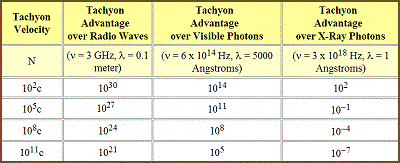 |
| Theoretical Advantage over Photons |
The theoretical superiority of tachyons over photons rarely is fully appreciated. Dr. Martin Harwit of the Center for Radiophysics and Space Research at Cornell University has provided several mathematical formulae from which a simple calculation of the comparative bit rates of the two message channels may be made.3119 If bandwidth and detector size are held constant, the ratio of tachyon bit rate to photon bit rate is equal to (mlc/h)3/N, where m is tachyon mass, l is photon wavelength, N is tachyon velocity in units of c (speed of light), and h is Planck’s constant. This ratio may be called the Tachyon Advantage, and is tabulated in Table 24.1 at right for various wavelengths of electromagnetic radiation, assuming tachyonic mass equal to the mass of the electron.
- Note the tremendous theoretical advantages of transmitting information with tachyons rather than with radio waves or photons of visible light.
- The tachyons are also traveling incredibly swiftly, yet another advantage over photonic signals.
| Energetic efficiency |
What about energetic efficiency?
- Although the calculations are highly speculative, it would appear that the ratio of the theoretical tachyonic efficiency in bits/joule-sec to the theoretical photonic efficiency in bits/joule-sec is equal to (mlc/h)2.
- For tachyons having the mass of an electron, only high-energy x-rays (1020 Hz and higher) are more efficient.
- If proton-mass tachyons are transmitted, only powerful gamma-ray photons (1023 Hz and higher) should be more energy-efficient per bit.
|
"Greetings! Welcome to the Galactic Club!"
|
If the existence of tachyons is finally verified,* and if the generation, transmission and detection of these fleeting particles can be achieved with reasonable equipment., sentient ETs races may have at their disposal one of the cheapest and fastest communications systems imaginable. Perhaps someday human scientists may learn to tap this channel. The first tachyonic interstellar signals we receive may say: "Greetings! Welcome to the Galactic Club!"
* Nuclear physicists have searched for evidence of tachyons for more than a decade. For the records of these experimental investigations, see:
| ■ Alväger and Kreisler1479 ■ Ashton et al3120 ■ Baltay et al1498 ■ Bartlett and Lahana1500 |
■ Clay and Crouch654 ■ Danburg and Kalbfleisch1502 ■ Danburg et al1496 ■ Davis, Kreisler and Alväger3121 |
■ Feinberg648 ■ Kreisler1518 ■ Murthy1510 ■ Thomsen646 |
|
The weight of xenological opinion today
is that radio frequencies are the preferred mode of photonic information transmission between the stars. |
Based on the historical development of human communications technology, it is probably fair to say that electromagnetic radiation represents the most primitive technique for signaling across interstellar distances. Advanced cultures may possess particulate, neutrinic, gravitic or tachyonic communication channels, or they may have knowledge of only a few of these, but it is difficult to imagine any technical society in possession of any of such sophisticated technologies without at least having an awareness of photonic communication techniques.
- Electromagnetic waves are probably the easiest information markers physically to generate, and they are ubiquitous throughout the cosmos.
- Photons are most likely the most primitive communication technology available for interstellar discourse.
| 16 orders of magnitude |
If this is true, which photons are the best to use? The electromagnetic communication band spans a useful frequency range of at least 16 orders of magnitude — gamma rays, x-rays, ultraviolet, visible light, infrared, radio and so forth. Unless we can identify a preferential region of the spectrum, our search for intelligent alien signals will be frustrated by the enormous number of possibilities.
| Energy efficiency |
The most logical place to begin is with the question of energy efficiency. Following Drake’s Principle of Economy, we should expect ETs to select those photons which transmit the greatest number of bits per second for the least cost in joules of transmission energy. Unfortunately, both bit rate and photon energy are proportional to frequency, so when the two are divided the frequency dependence drops out.
- Hence, the criterion of energy efficiency is incapable of distinguishing between photons of different frequencies.
| Noise and absorption |
If we look back at Oliver’s criteria (Section 24.2), we see that there are really only two of them which are useful in making a choice between photons: Noise and absorption.
- Signals transmitted over channels which are too noisy are not detected.
- Messages transmitted through a medium which absorbs them do not reach the receiver.
|
Figure 24.2 Integrated Flux Density of Background Radiation Likely to Obscure Interstellar Electromagnetic Communications3129 |
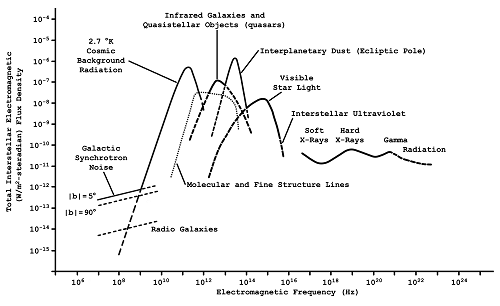 |
| Electromagnetic flux density |
Consider the graph in Figure 24.2. The vertical axis represents the total electromagnetic flux density in watts/meter2, assuming a detector which is looking at approximately 8% of the entire celestial sphere (1 square radian of sky, or "steradian"). Noise from the most important sky sources are plotted over the various frequency ranges in which they occur. Coverage stops at 107 Hz because electromagnetic waves with frequencies less than this are heavily absorbed by planetary ionospheres, and in any case, waves below 106 Hz are absorbed by the interstellar medium.
| Conclusions from the data |
What conclusions may we draw from the data?
- First, it appears that the noisiest part of the electromagnetic spectrum is the region from 1011 Hz up to about 1016 Hz.
- Any signals sent by photons within this range must compete with starlight, the 3 K cosmic background, and a variety of other emissions and absorptions.
- Although interstellar communications seem least likely in this portion of the spectrum, a few xenologists have suggested making use of the laser’s ability to produce highly directional, extremely monochromatic beams.
- If the laser is tuned to emit in a stellar absorption band (a narrow frequency band where the sun is about an order of magnitude darker than normal), distant alien observers would observe an artificial spectral line winking on and off in a clearly intelligent pattern.1039
| Magic frequencies |
A better choice is the part of the spectrum which lies above 1016 Hz. X-rays and gamma rays may be useful in interstellar communications because they are not absorbed by the interstellar medium. (See Elliot,3144 Fabian,3137 and Kuiper and Morris.2608) But attempting to search the entire range from 1016-1023 Hz is hardly going to be easy.
|
To search the entire range from If we could check a 1 MHz band for ET |
- If we could check a 1 MHz band for ET signals every 10 seconds, the search time to cover the entire high frequency region would require a period of time on the order of the age of the universe.
Somehow the possibilities must be narrowed. One way to do this is to look at "magic frequencies" derived from universal physical constants or defined by well-known physical phenomena. The possibilities are endless.2608 For example:
The Compton Wavelength* of the electron is 2.420 × 10-12 meter, corresponding to a frequency of 1.239 × 1020 Hz.
- This falls almost exactly into a noise minimum between hard x-rays and gamma rays on the flux density curve in Figure 24.2 above.
- The Compton Wavelengths of the proton and neutron, respectively, are 1.32134 × 10-15 meter and 1.31952 × 10-15 meter, which define a "narrow" 1020 Hz band between the frequencies 2.26885 × 1023 Hz and 2.27198 × 1023 Hz.
- This band conveniently lies in another local noise minimum on the flux density curve.
- Since it is defined by the two major particles from which all stable matter is constructed, this "baryon gap" may be the preferred region for interstellar communications using high-energy photons.
Yet another approach — one which fills in the third local noise minimum between soft and hard x-rays — is somewhat biochauvinistic. It assumes that ETs will transmit signals between favored spectral lines of atoms or ions that are biologically important to them. For instance:
- Silicon-based sentients may transmit between Si- Ka1 and Ka2 lines, located at 4.20736 × 1017 Hz and 4.20591 × 1017 Hz, defining sharply what might be called the "silicon hole" with a width of 1.45 × 1014 Hz in which signals might be detected.
- Similarly, we might define a "sulfur hole" between 5.58048 × 1017 Hz (Ka1 line) and 5.57758 × 1017 Hz (Ka2 line).
- A "chlorine hole" between 6.34108 × 1017 Hz (Ka1 line) and 6.33718 × 1017 Hz (Ka2 line) for chlorine-breathers.
- A "germanium hole" from 2.9464 × 1017 Hz to 2.9428 × 1017 Hz for germanium xenobionts; and so forth.
|
Figure 24.3 Free Space Microwave Window |
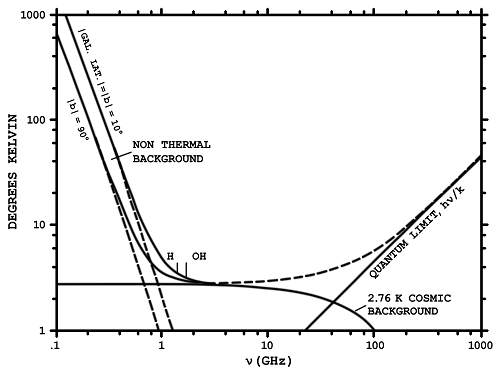 |
| Preferred mode of photonic information transmission |
It is clear, however, that on the basis of noise/absorption criteria alone the low frequency end of the spectrum (below 1011 Hz) should be optimal for long-distance interstellar communications. The weight of xenological opinion today is that radio frequencies are the preferred mode of photonic information transmission between the stars.57,22
| Which frequencies are best? |
But exactly which radio frequencies are best? The graph in Figure 24.3 represents an expanded view of the quietest portion of the electromagnetic spectrum. The vertical axis is no longer energy density. Rather, intensity is expressed as sky brightness (blackbody) temperature which is what radio-astronomers actually measure.
| Sources of noise |
There are three fundamental sources of noise associated with all highly sensitive radio receivers.
- First there is "galactic noise," caused by synchrotron radiation arising from free electrons orbiting magnetic field lines in space. From the graph we see that this noise rises steeply below 1 GHz, depending very slightly upon the galactic latitude toward which we point our receiver.
- Second, there is "thermal noise," caused by the 3 K cosmic back ground, the relict radiation from the Big Bang.
- Third, there is "quantum noise" (spontaneous emission or shot noise), representing a fundamental quantum mechanical limitation on receiver sensitivity.
Above 1 GHz galactic noise falls below the isotropic cosmic background, and beyond about 60 GHz quantum noise exceeds the cosmic background and increases indefinitely with frequency. (It is the dominant form of noise at optical wavelengths.)
Thus from any point in interstellar space the sky is likely to be quietest from about 1-60 GHz. This is the microwave window out in free space.
|
Figure 24.4 Terrestrial Microwave Window |
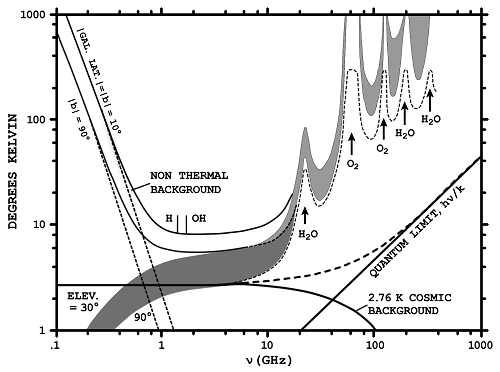 |
| Terrestrial Microwave Window |
Now look at the graph in Figure 24.4 on the Terrestrial Microwave Window. Atmospheric absorption must be added for receivers located on a planetary surface under a sea of air.
- If signals from the stars arrive at frequencies above 10 GHz, they will be strongly absorbed by water vapor molecules, oxygen molecules, and many other molecules not shown.
- These substances are likely to be present in the air of any terrestrial world that resembles Earth even remotely.
- We see that the Terrestrial Microwave Window is closed virtually for all radio frequencies save those few between 1-10 GHz.
- The great majority of xenologists agree that this is the range where alien electromagnetic signals most profitably may be sought.
| Outstanding radio emission line at 1.42 GHz |
There is considerably less consensus on exactly where to search within the Window. Philip Morrison and Guiseppi Cocconi first suggested that the search should be made at or near the natural emission peak of neutral interstellar hydrogen gas (the most abundant element in the universe). According to these early pioneers in SETI, the preferred frequency was 1.42 GHz:
On the most favored radio region there lies a unique, objective standard frequency which must be known to every observer in the universe: the outstanding radio emission line at 1420 Mc/sec of neutral hydrogen.1033
As the hydrogen line itself is rather noisy, a few scientists responded that searches ought to be made at integral multiples of 1.42 GHz.1054
| Other emission lines within the Window |
Since 1959, the science of radioastronomy has made tremendous advances. It is now known that there are many other elements and molecules with emission lines within the Window.
- The hydroxyl (OH) radical has emission lines at 1.612, 1.665, 1.667, and 1.720 GHz.
- Spectral lines of molecular species are also quite popular in the speculative literature.
- For instance, some have proposed listening in at 4.83 GHz — the natural formaldehyde emission line — because it is comparatively less noisy than many other natural lines.3122
| Water hole |
In the early 1970s, interest turned to what is commonly called the "water hole." Much as with the x-ray bands described above, the water hole is the band of radio wave frequencies lying between the H and OH emission lines.
- Readers familiar with chemistry will recognize that H plus OH equals water, the basic solvent for all life as we know it on Earth.
Dr. Bernard Oliver, who originated this idea in connection with his work on Project Cyclops (see below) in 1971, explains the rationale for the water hole in a particularly poetic fashion:
Nature has provided us with a rather narrow band in this best part of the spectrum that seems especially marked for interstellar contact. It lies between the spectral lines of hydrogen and the hydroxyl radical. Standing like the Om and the Um on either side of a gate, these two emissions of the disassociation products of water beckon all water-based life to search for its kind at the age old meeting place for all species: the water hole. Water-based life is almost certainly the most common form and well may be the only (naturally occurring) form. … Romantic? Certainly. But is not romance itself a quality peculiar to intelligence? Should we not expect advanced beings elsewhere to show such perceptions? By the dead reckoning of physics we have narrowed all the decades of the electromagnetic spectrum down to a single octave where conditions are best for interstellar contact. There, right in the. middle, stand two signposts that taken together symbolize the medium in which all life we know began. Is it sensible not to heed such signposts? To say, in effect: I do not trust your message, it is too good to be true!3289,57
| Water hole competitors |
During the mid- and late-1970s there has been an outpouring of new ideas and proposals for preferred frequencies in SETI, so the water hole concept today has a great deal of competition. Drake and Sagan suggest using an "average value" of the H and OH natural emission lines, obtaining a kind of "molecular center of mass" frequency of 1.65 GHz as the favored interstellar channel.3128 A related proposal is that in space, where the Free Space Microwave Window allows greater leeway, we should search the water line itself at 22 GHz2865 (or perhaps the ammonia line at 24 GHz, if we are looking for ammonia-based beings15).
| Magic frequency |
We could adopt the "magic" frequency of 56 GHz, the point at which the blackbody 3 K background "thermal noise" curve intersects the "quantum noise" curve.22 Argue Drake and Sagan: "The 56 GHz channel has the provocative property of being determined simultaneously by quantum mechanics and cosmology."3128
- Using another combination of basic physical constants, Kuiper and Morris have derived a "magic" frequency of 2.56 GHz.2608
- Then there is the intriguing suggestion of Soviet SETI researcher P.V. Makoveskii of the Leningrad Institute of Aviation Instrument Manufacture, that the most probable frequencies for interstellar radio traffic will be the natural hydrogen line frequency alternatively multiplied and divided by such constants as p, 2p, and SQRT(2).3261
- This identifies several "uniquely artificial" frequencies, including 0.23, 0.45, 1.0, 2.0, 4.5, and 9.0 GHz.
| Optimum frequency based upon physical laws |
However reasonable they may seem, each of the above proposals rests on a plausibility argument whose conclusions perhaps are suggested but certainly are not compelled by the basic facts and assumptions of xenology. A few scientists have attempted to predict the optimum interstellar signaling frequency based solely upon fundamental physical laws and conditions expected to apply to all communicative civilizations in the Galaxy.
| Frequency of maximum economy |
Using his Principle of Economy, Dr. Frank Drake points out that the best radio frequency is the one in which transmission power is minimized — that is, where noise is lowest.
- This is customarily described in terms of the "brightness temperature" of the sky — the temperature a black body would have to have in order to duplicate in brightness the observed radio radiation coming from a given spot in the sky.
- Following Drake, we write the noise temperature as a function of celestial right ascension a and declination d
(the astronomers’ way of specifying sky position) as T(a,d). - This temperature is not constant for all radio waves, but varies as a function of frequency n.
- Typically the variation follows a "power law" — frequency raised to some variable exponent g — of the form n-g.
- Since g is also a function of sky position, we shall write it as g(a,d). Both T(a,d) and g(a,d) can and have been measured very precisely by terrestrial radioastronomers for every point in the sky.
Finally, Drake derives the following equation for n0 the frequency of maximum economy (of maximum communication range):

Where k is Boltzmann’s constant and h is Planck’s constant.3123
| In plain English |
What does all this mean in plain English? Simply this:
- For each position in the astronomers’ sky there exists a unique frequency of minimum noise and maximum economy.
- Whatever direction you point your radiotelescope, range will be greatest if the radio frequency determined by the above equation is used.
- Best of all, the numbers that must be plugged into Drake’s formula are already known, so n0 theoretically may be computed today for any star system in the heavens with whom we may wish to enter into communication.
- Drake calculates that the range of frequencies of maximum economy span the Terrestrial Microwave Window from 3.75 GHz out to about 10 GHz.
| The Compton Wavelength |
* The Compton Wavelength is the change in wavelength corresponding to a loss of energy suffered by a photon whenever it collides with matter.
|
According to a statistical theory of coding, That is, a maximally information-saturated |
There are many different kinds of possible alien transmissions we might receive — local radio traffic, beamed messages to regular correspondents, beacon signals designed to attract attention, and so on. We are most likely to pick up beacons first because these should be comparatively more powerful. But xenologists disagree on the exact nature of the beacon signals we may detect.3179 Artificiality criteria have not yet been worked out in full detail, but certainly not for want of trying.
| Radioastronomical criteria |
A variety of radioastronomical criteria have been proposed over the years which turn out to be insufficient:
|
|
- (See Kaplan,29 Konstantinov and Pekelis,25 and Tovmasyan.28)
| Two requirements for all beacon signals |
According to Vsevolod S. Troitskii, a well-known Russian radioastronomer, there do seem to be two basic requirements for all beacon signals that xenologists can agree upon:
- The signal should not leave any doubt as to its artificial origin. The artificial signal should be distinctly different in its properties from natural radiations.
- The signal should carry some information about the transmitting civilization.3124
| Information content |
The second of these criteria — information content — is highly significant. So far as we know, only the processes of life, intelligence and culture are able to impress large quantities of information onto packets of photons. Perhaps we should try to decide if there is some minimum information content than a given transmission must possess before we may regard it as artificial. As Philip Morrison points out:
|
If you look for a sufficiently long time,
you are bound to find rare things just in the course of events. it is also true that rare things occur rarely. |
A little more information content is needed than just the existence of a {stellar spectral} line of something rather rare or a very regular pulse, because if you look for a sufficiently long time, you are bound to find rare things just in the course of events. This is a very valuable lesson. Although rare things occur rarely, it is also true that rare things occur rarely.3127
| Minimum content to be considered intelligent |
Soviet astrophysicist Nikolai S. Kardashev believes that a signal should contain at least 10-100 bits of information before we may feel confident that it is artificial in origin.3126 Terry Winograd’s artificial intelligence computer program consists of about 106 bits, but Marvin Minsky estimates that a message with as few as 104-105 bits, properly situated, could be considered "intelligent."22
| Call signals |
Hopefully the information will not be too difficult to extract. According to E.C. Shannon’s statistical theory of coding, the most efficient signals will appear indistinguishable from random thermal noise.3186,3187 That is, a maximally information-saturated message looks like noise — unless the recipient happens to know the correct translation code. Xenologists suspect that ETs may not attempt to achieve maximum information content in interstellar beacon devices. Signals that look like noise don’t attract much attention. If such highly efficient beacon transmissions are used, they probably will be accompanied by special attention-getting messages. These are often referred to as "call signals," and may be expected to satisfy Troitskii’s first criterion listed above.*
| Search strategies |
* Specific search strategies have been proposed by: |
| ■ Bihary3158 ■ Dixon1266 ■ Gray3150 ■ Haviland1147 |
■ Morrison, Billingham and Wolfe2865 ■ Oliver and Billingham57 ■ Ridpath3154,3257 |
■ Sagan22 ■ Shklovskii and Sagan20 ■ Walker158 |
| Timing schemes |
* Timing of the call is also of paramount importance — we must know when to look as well as where and how.
The interested reader is referred to the timing schemes offered by:
| ■ Gindilis22 ■ Makovetskii3263 |
■ McLaughlin2719 ■ Pace and Walker651 |
■ Tang1613 ■ Tovmasyan28 |
|
It is unlikely that man and alien will have
absolutely nothing in common. Earth-like worlds should have much in common with us by virtue of the similarity of our native environments. intersect, a basis for communication may be established from which the areas of nonintersection later can be explored. in this case probably is in the hard sciences — physics, chemistry, geology, and so on. |
Once a genuine extraterrestrial signal of some kind has been detected, the acquisition phase ends and the communicative phase may begin. The recipient must then be able to puzzle out the meaning of the alien messages he receives.
| Principle of Anticryptography |
If the signals are being transmitted purposefully, then it is likely that the ETs at the other end will have done their level best to ensure easy decipherability of their messages by the intended recipients. Coding should be relatively simple and considerably redundant, full of clues enabling SETI scientists to achieve a full translation with high validity. Since this is exactly the opposite goal to that of the science of cryptography (secret codes), xenologists often refer to it as the Principle of Anticryptography.
According to the Principle, a beacon message transmitted from another world, prima impressionis, should be optimized for easy decoding by intelligent recipients.
| Format of messages |
The Principle of Anticryptography suggests the basic format of messages we may expect to receive from the stars. Consider a sequential transmission consisting of a string of symbols of some kind.
- If the message is very lengthy, and later parts are of greater complexity in reliance upon our understanding of earlier parts, then if we tune in near the middle or the end we probably won’t be able to understand anything at all.
- On the other hand, if the message is kept very brief and repetitive then, in the words of one radio-astronomer, it "bores us to tears for decades while we try to acknowledge."80
- In keeping with the Principle, we might expect to find "nested messages," involving a frequently repeated call signal interspersed with short but complete "language lessons."22 Every so often a self-contained package of basic information would be substituted for the language lesson.
- On yet rarer occasions, the basic information package would be replaced with a more advanced information package, and so on to higher and higher levels of sophistication.
- Such a message format is highly redundant, repetitive, error-proof, informative, and so may be tapped into at any point in the transmission without loss of meaning.
| Universal language of mathematics |
What about message contents? Will we understand what ETs are trying to say to us? A few xenologists have proposed that the "universal language" of mathematics will provide the bridge of understanding between man and alien. (See Hogben,1112 Oakley,329 Pryor,99 and Sagan and Drake.3143) According to one scientist, it is difficult to imagine the existence of communicative beings unfamiliar with numbers and counting. Thus the earliest messages may consist of a series of irreducible prime numbers, say, 1, 3, 5, 7, 11, 13, 17, . . . , or the value of pi out to the first twenty digits or so.
| Lingua cosmica |
Assuming for the moment the validity of this approach, can we do better than mere counting? Dr. Hans Freudenthal, professor of mathematics at the University of Utrecht in the Netherlands, has designed a purely mathematical language which conceivably could be used in interstellar discourse between alien races. Freudenthal originally devised his system of "lingua cosmica" — Lincos for short — as an exercise in logical linguistics, but he admits it easily might serve as the contact and communicative mode among ETs.3290
Lincos consists of a variety of mathematical terms and phrases, to be encoded into specific combinations of radio pulses and signal shapes and then beamed out into space. It is devised purely in terms of semantics and human logic, and accomplishes understanding by building from simple beginnings. Statements are arranged in words, sentences, and paragraphs.
| Freudenthal’s program |
Freudenthal’s program begins by establishing the meaning of the terms "plus" and "equals." He would, for instance, send signals something like "beep bloop beep tweet beep beep" (1 + 1 = 2), perhaps followed by "beep bloop beep beep tweet beep beep beep" (1 + 2 = 3) and so on. Eventually it should become clear that "bloop" represents addition and "tweet" signifies equality.
- In the first chapter of his book on Lincos, Freudenthal goes on similarly to introduce the concepts of subtraction, multiplication, division, basic symbolic logic ("and," "or," and "follows"), negatives, integers, decimals, fractions, and zero.
- In the second chapter the concept of time makes its appearance, including "seconds," duration, wavelength, frequency, "before," "after," and "occurs."
- In chapter 3, Freudenthal develops concepts of correct and incorrect, right and wrong, good and bad; to count, to search, to find, to describe, to prove, to change, to add or omit; to know, guess, understand, and mention; nearly and approximately, much and little, soon and long ago, age and now; necessary and possible, enable, be forced, allowed, forbidden; politely; conflict between necessity, duty, and desire; and so forth.
| Correct and incorrect |
For example, Freudenthal’s language lesson to teach the concepts "correct" and "incorrect" to ETs runs as follows:
| *Ba Inq Hb•? x.100x=1010: | Human-a asks Human-b: If 4x = 10, how much is x? |
| Hb Inq Ha.1/10: | Human-b tells Human-a: x is 1/2. |
| Ha Inq Hb Mal: | Human-a tells Human-b: That is incorrect. |
| Hb Inq Ha.101/10: | Human-b tells Human-a: x is 5/2. |
| Ha Inq Rh Ben* | Human-a tells Human-b: That is correct. End of lesson. |
| Portraying facets of behavior |
As vocabulary slowly builds, ever more sophisticated statements become possible.
- In chapter 4 of Freudenthal’s book, mechanics and spatial extent are dealt with, including concepts of distance, position, length, growth, volume, motion, waves and oscillations, speed of light, mass, and astronomical concepts.
- Later chapters delve into geography, anatomy and physiology including the human reproductive process.
- By staging "plays" between symbolic human "actors," Lincos ultimately should be capable of portraying diverse facets of human behavior, emotions, social conventions, philosophies and religious rituals.
| Universal language problems |
Unfortunately, there are many problems with the "universal mathematical language" approach.
- As we know, no system of logic is or can be universal. Gödel’s Theorem suggests that alien systems of mathematics, logic and philosophy necessarily must be at least somewhat incongruent.
- ETs may not understand our system of numbers, our Euclidean geometry, our Aristotelian bimodal logic, our astronomically-derived Newtonian physics, or our sequential Periodic Table of the Elements, simply because they view the universe through different sensors and thus reach different conclusions based on different theories.
- So aliens may not understand human-designed artificial languages like Lincos.
| Intersecting systems of knowledge |
Still, the possibility of totally nonintersecting systems of knowledge is probably remote in most first contact situations. It is unlikely that man and alien will have absolutely nothing in common. In most cases, ETs evolving on Earth-like worlds should have much in common with us by virtue of the similarity of our native environments. To the extent the two paradigms do intersect, a basis for communication may be established from which the areas of nonintersection later can be cautiously explored. The most likely region of intersection in this case probably is in the hard sciences — physics, chemistry, geology, meteorology, and so on.
| Interstellar pictogram |
Other approaches to the problem of extraterrestrial message anticryptography have been proposed. Perhaps the most popular of these is the interstellar pictogram, anticipated by H.W. and C. Wells Nieman back in 1920.170 The basic idea is that a string of radio pulses, coded as on/off, black/white, or 0/1 could he arranged in a rectangular raster pattern to form a two-dimensional pictorial image much like modern television systems (Figure 24.5).
| 1271 zeros and ones |
Imagine you receive a string of 1271 zeros and ones on an appropriate interstellar frequency band. How might this be translated?
- The mathematically-inclined reader will recognize that 1271 is the product of two prime numbers, 31 and 41.
- This suggests that the data should be laid out sequentially on a gridwork either of 41 rows and 31 columns or 31 rows and 41 columns.
- As illustrated in Figure 24.5, the former of these makes little sense whereas the latter appears highly informative.1056
| Pictogram variations |
Variations may be imagined. For instance:
- We could use perfect squares rather than "rectangular primes." If the message has 1681 bits, which is 41 × 41 exactly, then there is only one way to lay the message out and the two-choice ambiguity is avoided.
- We might also receive a three-prime message, say with 2717 bits, which, when correctly arranged, permits the reconstruction of a spatial mode complete with height, width, and depth.
- If one of the three primes represents a time dimension, we will have the equivalent of an extra terrestrial Mickey Mouse cartoon. (The time-prime should be clearly distinguished from the spatial-primes for this purpose.
- The author suggests a message of 5819 bits, consisting of 11 sequential frames of 23 × 23 bits each.)
- Yet another twist, first proposed by Y.I. Kuznetzov of the Institute of Energetics in Moscow, is the possibility of transmitting a 3-D interstellar pictogram using variations in frequency, intensity, and pulse delay to build up each of the three physical dimensions of the image of a solid object.22
- The pictogram mode of contact has appeared repeatedly in science fiction.70,1748
| Associated chauvinisms |
A number of chauvinisms associated with all pictogram schemes may render them significantly less universally interpretable.
- First, the idea of laying data out in a grid-shaped raster seems logical enough to human scientists. Our TV sets work in essentially the same way.
- But aliens may have different ideas and technologies. Perhaps they use spiral scanning (either the Archimedean or logarithmic variety).
- At least one ancient human language was written in this format, and spiral tracing once was seriously proposed for use in Earthly television systems.1351
- Aliens with spiral scanning video tubes may send messages of 1429 bits (an indivisible prime) to be laid out sequentially in a spiral pattern. Would we ever guess?
|
Although most children do not learn to read
until they are about 6 years old, they are able to recognize objects in pictures long before that. child is capable of such recognition. |
| Cultural chauvinism |
Another chauvinism is cultural in nature. According to Jan B. Deregowski, lecturer in psychology at the University of Aberdeen:
A picture is a pattern of lines and shaded areas on a flat surface that depicts some aspect of the real world. The ability to recognize objects in pictures is so common in most cultures that it is often taken for granted that such recognition is universal in man. Although most children do not learn to read until they are about 6 years old, they are able to recognize objects in pictures long before that; indeed, it has been shown that a 19-month-old child is capable of such recognition. If pictorial recognition is universal, do pictures offer us a lingua franca for intercultural communication? There is evidence that they do not: Cross-cultural studies have shown that there are persistent differences in the way pictorial information is interpreted by people of various cultures.66
Certain tribes in Africa, for example, are unable to recognize photographs as representations of the real world. They just don’t see things the way we do. And these are our fellow human beings. How much more difficult may be the problems of interpretation where ETs are involved?
|
Reality just doesn’t sound that way to them.
|
| Visual chauvinism |
A third and very serious chauvinism is the tacit assumption that all sentient alien creatures must necessarily be visually oriented.
- Consider a pelagic world inhabited by intelligent technological dolphins: These creatures have devised a special telescope which converts radio waves into acoustical signals which they can hear.
- One day their equipment is aimed at Earth and they receive the standard 31 × 41 pictogram, which they promptly arrange into an appropriate rectangular format of sonic pulses.
- But since the pictogram was assembled from the viewpoint of visual beings, the sentient dolphins cannot make head nor tail of our message.
- Reality just doesn’t sound that way to them.
|
The changes I noted were taking place
periodically, and with such a clear suggestion of number and order that they were not traceable to any cause then known to me. flashed upon my mind that the disturbances observed might be due to intelligent control. I had been the first to hear the greeting of one planet to another. |
As it has developed over the past two decades, the science of SETI — Search for Extraterrestrial Intelligence — today entails a passive listening strategy in hopes of detecting alien beacons or other transmissions.
- The older acronym CETI (Communication with Extraterrestrial Intelligence), still in use in the Soviet Union, implies a more active strategy in which humankind might actually converse with ETs.
- Because "communication" connotes a two-way exchange — which may people fear — NASA officials and American scientists engaged in this work on a professional basis prefer the isolationist connotations of "search."
- This, this believe, helps to avoid heated popular controversy and to reassure an anxious public that the intention is only to listen quietly, never to transmit.
| Tesla: first SETI worker in history |
Actually, SETI research of sorts has been underway since before the turn of the century. Nikola Tesla, native Croatian by birth and inventor of the induction motor, perhaps may be credited as the first SETI worker in history.
- Tesla believed that the Earth possessed a gigantic electric field that could be set aquiver if a sufficiently high voltage could be made to jump a large enough spark gap.
- In 1899, using money furnished by wealthy industrialist J.P. Morgan, Tesla erected a 70-meter-high transmission tower at a site in Colorado Springs, Colorado.
| Possible messages from Mars |
One night when he was alone in his laboratory, the inventor observed "electrical actions" which he later interpreted as possible messages from Mars:
The changes I noted were taking place periodically, and with such a clear suggestion of number and order that they were not traceable to any cause then known to me. I was familiar, of course, with such electrical disturbances as are produced by the sun, Aurora Borealis and earth currents, and I was as sure as I could be of any fact that these variations were due to none of these causes. … It was some time thereafter when the thought flashed upon my mind that the disturbances I had observed might be due to intelligent control. … The feeling is constantly growing on me that I had been the first to hear the greeting of one planet to another.146
| Marconi's mysterious messages |
Italian physicist and inventor of the radio Guglielmo Marconi reported in 1920 that his company’s radio stations had been picking up mysterious signals for the better part of a decade. Some of these sounded like a code, but were otherwise meaningless. Occasionally Marconi heard three dots and a dash — Morse code for the letter "V" — at frequencies ten times lower than were then in common use in man-made transmitters. When asked if these signals might be messages from another planet, Marconi answered in the affirmative.3291
| Strange signals from space |
The next early SETI venturer was David Todd, chairman of the Astronomy Department at Amherst College in Massachusetts.
- Todd, excited by the prospect of the mysterious Marconi messages, tried to persuade all radio stations in the country to shut down during the closest approach of Mars to Earth in 1924 so he could listen for alien signals.
- While not entirely convincing, he managed to persuade the Chief of Naval Operations of the United States Navy to go along with his scheme.
- On 21 August 1924, the Chief sent word to the twenty most powerful military stations under his command to avoid unnecessary transmissions and to listen for strange signals from space.
- Army stations received similar orders, and in one instance a cryptologist from the Signal Corps was present to provide on-the-spot translations, if need be.
- But nothing substantive was detected, and the entire project died a quiet death.
It was to be nearly 37 years before humanity once again would turn its ear to the stars.
It is useful to pause at this point and ask what is the likelihood of success of such a search.
- Many writers have pointed out that continuous transmissions into space would have a fairly low expectation of success in any given year, yet at the same time would be inordinately expensive.
- Also, first contact could bring unexpected trouble. Why announce our presence to the universe, these critics ask? Why invite danger and unnecessary risk?
Hearing this, many SETI researchers have wondered out loud: "What if all alien civilizations were listening and no one was sending?"
| Three requirements to transmit |
At least three requirements should be satisfied if a society is to convert from a passive listening culture to an active transmitting one:
- The civilization must have sufficient energy on hand that a 1015 watt continuous transmitter represents a negligible cost to the transmitting society;
- The civilization should command a technology and energy resources sufficiently powerful to defend itself against invasion or other military threats from any star system to which it directs its signals; and
- The civilization should have great political and cultural longevity, in order to ensure continuity of operation and support of the beacon system.
It would appear that at least a Type II stellar culture may be necessary to fulfill all three preconditions of a transmitting society.1285,28
|
Table 24.2 Probable Search Range Required for Success, as a Function of Mean Longevity of Technological Civilizations2296 |
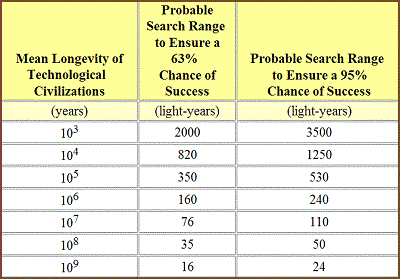 |
| SETI sweepstakes |
Using the Drake Equation (see Chapter 23) and assuming various values for cultural longevity, it is possible to estimate how deeply into space we must carry our search in order to achieve a specified probability of success.
- From the figures in Table 24.2, it appears that the most likely search ranges are from 100-1000 light-years, a volume of space which encloses some 104-106 stars.
- If we spend just 1000 seconds examining each one, then the expected search time required to achieve a high probability of success on a modern, fully-dedicated radiotelescope with full computer guidance and tracking capability is on the order of several decades.
- Because of this somewhat encouraging result, growing numbers of xenologists are entering the SETI sweepstakes in hopes of becoming the first to detect messages from an extraterrestrial civilization.
| Project Ozma |
The first scientist to attempt to pick up interstellar signals was Dr. Frank D. Drake.1619 Despite the many technical difficulties at the time, Drake initiated mankind’s first systematic search for messages from intelligent beings on other worlds in the late evening of 11 April 1960. His equipment had been set up at the newly built National Radio Astronomy Observatory (NRAO) in Green Bank, West Virginia. Drake named his effort Project Ozma after the queen of the mythical land of Oz, a place very far away, difficult to reach, and populated by strange and exotic beings.1535
- The Ozma apparatus was operated at the hydrogen frequency of 1.42 GHz with a narrow bandwidth of 100 Hz.
- Two receiving horns were placed close together at the focus of the 26-meter-wide radio dish, so that the target star and the adjacent empty space could be monitored simultaneously.
- By subtracting one signal from the other electronically, stray emissions and background noise could be eliminated.
- Drake pointed the receiver at each of two target stars — Tau Ceti and Epsilon Eridani.
| Pandemonium in the control room |
Early in the investigation a strong signal was picked up, while the equipment was pointing at Epsilon Eridani.
- A series of high-speed pulses, roughly eight per second, were detected "so regularly spaced that they could only be the product of intelligent beings."702
- There was, as Drake later described the scene, "a moderate amount of pandemonium" in the control room.
- The strange signals were heard several more times over a period of several months.
- Eventually it was discovered that they were the product of a secret military experiment in radar countermeasures using airborne transmitters.
| Proof of valid SETI experiments |
Listening continued through July 1960. Some 150 hours of total observational time were logged for the two target stars. Though Project Ozma did not detect any messages. from extraterrestrial civilizations, it cannot in fairness be reckoned a failure. Only two stars out of billions were sampled, and only in one narrow frequency band with only very poor (by modern standards) receiver sensitivity. The chance that alien signals had been overlooked was great. But perhaps the most significant achievement of Project Ozma was purely symbolic: Drake had proven that it was technically possible to perform scientifically valid SETI experiments.
|
Table 24.3 SETI Searches Through 1978
|
||||||||||||||||||||||||||||||||||||||||||||||||||||||||||||||||||||||||||||||||||||||||||||||||||||||||||||||||||||||||||||||||||||||||||||||||||||||||||||||||||||||||||||||||||||||||||||||||||||||||||||||||||||||||||||||||||||||||||||||||||||||||||||||||||||||||||||||||||||||||||||||||||||||||||||||||||||||||||||||||||||||||||||||||||||||||||||||||||||||||||
|
||||||||||||||||||||||||||||||||||||||||||||||||||||||||||||||||||||||||||||||||||||||||||||||||||||||||||||||||||||||||||||||||||||||||||||||||||||||||||||||||||||||||||||||||||||||||||||||||||||||||||||||||||||||||||||||||||||||||||||||||||||||||||||||||||||||||||||||||||||||||||||||||||||||||||||||||||||||||||||||||||||||||||||||||||||||||||||||||||||||||||
Ozma was the first but certainly not the last. In the two decades since Drake’s initial pioneering effort nearly two dozen SETI searches have been conducted at observatories around the world (Table 24.3).
- Nearly 1000 nearby stars have now been at least briefly checked for intelligent transmissions, both in ultraviolet and in a variety of radio frequency bands.
- Individual whole galaxies have been monitored for evidence of emissions of the sort expected if Type III civilizations were present.
- Other searches have included simple sky surveys and sweeps of the entire sky for telltale pulsed signals.
- (Many highly unusual receiver systems have been proposed, including:
■ the Luneherg lens,1570 ■ Siforov’s isotropic scanner,28
■ and Berger’s "celestial iconospherics" lenses.166)
| No unambiguously positive result |
So far, none of these searches has yielded unambiguously positive results. The most comprehensive search undertaken to date, completed in 1976 at Green Bank by Zuckerman and Palmer in a survey of 659 stars, turned up a number of peculiar signals. According to one writer:
Ten stars which had shown "glitches" (i.e., unexplained spikes of energy) were carefully resurveyed. Several of the glitches were traced to terrestrial sources of interference, such as aircraft, while others remained a mystery; however, since none of the spikes were repeated, they were unlikely to be due to beacon transmissions from other civilizations.3257
It is certainly possible that a beacon once trained on Sol, perhaps for years or even decades, has continued on in its signaling schedule to other stars and will not return to our direction for thousands of years hence. As Edward Fitzgerald once wrote:
The Moving Finger writes; and, having writ, moves on.
|
Figure 24.6 Advanced SETI Systems: Project Cyclops |
|
|
|
Although several searches are still in progress at the present time, many xenologists are convinced that SETI searches are doomed to failure so long as they depend solely upon individual initiative and random funding. What is needed, they argue, is a major long-term commitment to SETI in which major radiotelescope equipment is dedicated in part or in whole to the search for communicative societies. To implement such systematic, far-reaching schemes, a new generation of ultrasensitive apparatuses may be required.
| Project Cyclops |
In 1971 NASA/Ames Research Center and Stanford University conducted a joint summer study to design one such integrated system. Co-directed by Dr. John Billingham of NASA/Ames and Dr. Bernard M. Oliver, Project Cyclops was a design study for a giant array of radiotelescopes whose performance would imitate that of a single radio dish many kilometers in diameter (Figure 24.6).*
- The Cyclops system would consist of more than a thousand fully steerable paraboloid radio antennae, each 100 meters in diameter (about the size of the largest contemporary steerables).
- The output from each of the antennae would be carried into a large central computer facility using a sophisticated system of phased transmission lines.
- The computer would coordinate and synchronize the movements of the many radio dishes and would employ special signal enhancement techniques to try to dig alien messages out of the incoming data.
- From the air, the final Cyclops system "would be seen as a large central headquarters building surrounded by an orchard of antennas about 10 kilometers in diameter."57
- The Cyclops array as originally proposed would be assembled piecemeal over a 25 year period, for a total cost of $10-25 billion.
- This is about the same level of commitment as was required for the Apollo Moon Program a decade ago. (Or, as one observer has wryly noted, 22 days of Defense Department spending would support Cyclops for a quarter-century of development.)
- The Project, covering 65 km2 in some remote desert wilderness area, would be sensitive enough to conduct searches for 1000 megawatt beacons out to 1000 light-years or to eavesdrop on the electromagnetic "garbage" of technical societies out to about 100 light-years.
| Cyclops origin |
* Cyclops appears to be the working out of ideas earlier put forward by Oliver. On 27 July 1965 at an AIAA Conference in San Francisco, Oliver suggested that by building between 1-10 thousand radiotelescopes, each about 30 meters in diameter, in a 6-kilometer-square of flat terrain in certain areas such as Texas, we could "detect the unintended radiation from another intelligent race."
|
Figure 24.7 Advanced SETI Systems: Orbital Telescope Facility |
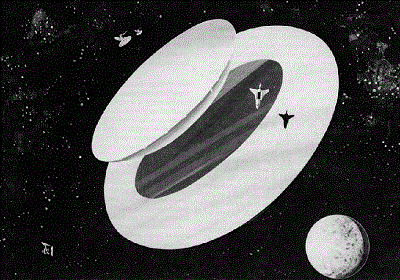 Artist’s impression of an intermediate size (300 meter)
Space SETI system antenna showing relay satellite RFI shield and Shuttle type vehicle. Located in geosynchronous orbit. |
| Orbital telescope facility |
The NASA SETI Advisory Panel recently considered a number of alternatives to the Cyclops system.2865 One major proposal under consideration is the concept of an orbital SETI installation (Figure 24.7).
- A giant spherical radio dish could be placed in Earth orbit at lunar distance, perhaps at one of the semistable Lagrangian points of Luna’s orbit.
- A shield would be erected to blot out all radio interference from transmitters on Earth.
- When fully implemented the system might measure 3 kilometers in diameter, but early test models could probably be flown with diameters of 30-300 meters.
- This giant dish would sweep the entire sky once during each orbital period, so any target could be observed at least once every 28 days.
- Since the telescope is spherical rather than parabolic in shape, the feed horn at the focus may be moved to tune in on distant objects so that the entire dish does not have to be reoriented.
- Since the feed horn can move a full 180° across the surface of the collecting dish, this means that any target theoretically may be observed for a continuous 14-day period if so desired.
- An additional advantage of an orbital SETI system is that multiple feed horns may be used without sacrifice of accuracy or sensitivity. This should permit the simultaneous
- observation of many different target stars within a given hemisphere of the celestial sphere.
- Finally, from a structural engineering aspect the orbital system would be much easier to build than a ground-based Cyclops network.3155
|
Figure 24.8 Advanced SETI Systems: Lunar Farside Systems |
|
|
|
| Lunar Farside systems |
Lunar Farside systems (Figure 24.8) were also under serious consideration by the SETI specialists.3142 NASA has considered the relative merits of Cyclops-type arrays (many small dishes) and Arecibo-type arrays (few large dishes) if constructed on the far side of the Moon.
- Since this side always faces away from Earth, any SETI system located there would be entirely free of terrestrial radio interference because of the shielding effects of 3000 kilometers of solid rock.
- The abundance of lunar craters of all sizes makes an Arecibo-type array especially attractive, which one study found to be significantly cheaper than Cyclops type setups on the moon. (SETI enthusiasts often refer to such an installation as "Lunarcibo."3149)
- A large expense common to both proposals is the sizeable lunar colony which would be necessary to support the project.
- A countervailing advantage is that building materials should be close at hand.
| Cost-benefit analysis |
During 1975-1976, NASA commissioned systems analysts at Stanford Research Institute to perform a cost-benefit analysis of sixteen different antenna concepts intended for use in the search for extraterrestrial signals of intelligent origin.3262
- The study showed that the orbital SETI system compared quite favorably with a ground-based Cyclops network in terms of cost.
- Quite unexpectedly, the critical parameter turned out to be N, the total number of communicative civilizations in the Galaxy.
- If N is very high and we only need to search a few hundred light-years out into space to achieve success, then Cyclops is cheaper because of the lower levels of R&D required.
- But if we must listen out to 500 light-years and beyond (N is very small), then the space-based system is cheaper to build and to operate.
- The price of the Lunar Farside scheme was deemed significantly higher than either of these two options.3292
| SETI systems possible contributions |
SETI systems, once constructed, should prove enormously useful in basic research in radioastronomy. SETI detection networks can make major contributions during off-time to the following areas of scientific investigation:
| ■ Cosmology ■ Quasars and radio galaxies |
■ External galaxies ■ The intergalactic medium |
■ Stellar evolution ■ Interstellar medium composition |
■ Supernovae and pulsars |
|
■ Kinematics and structure of the Milky Way |
|||
|
■ Solar system studies including surface mapping of terrestrial planets, jovian moons, asteroids and meteorites.2865 |
|||
| SETI survey |
There is growing interest in SETI in the astronomical community generally. A questionnaire sent to radioastronomy observatories around the world asked the question: "Have you ever engaged in any search for coherent or "intelligent" signals at your facilities?"
- Approximately 50% of the observatories responding answered in the affirmative.2865
- Scientists in the United States and the Soviet Union are excited by the prospects.880
- In America, a five-year program was proposed in 1978 that involves a search of specific stars by a team at NASA/Ames in Mountain View, California,3129
- A complementary search in the manner of a sky survey by a team at the Jet Propulsion Laboratory (JPL) in Pasadena, California.*3130
- In Russia, two overlapping ten-year plans were advanced by SETI scientists in 1975 which offer a combination of ground-based and satellite listening posts capable of continuous monitoring of the entire sky, nearby galaxies, and other selected objects of interest.1480,3681
| SETI request line |
* Jill Tarter at NASA/Ames has informed the author that the survey team would be happy to include any specific star in one of their SETI sky searches, upon request from scientists or from members of the general public.3149
|
| Will we transmit? |
One final sticky issue remains for discussion. Will we — should we — transmit?120 At present there exist no laws in national or international legal systems to prevent this, so there is nothing to stop any private or public organization from doing it if they want. It is common knowledge among working astronomers that many minutes of valuable radiotelescope research time are sometimes diverted (between regularly scheduled astronomical observations) to take a quick listen to Tau Ceti or Epsilon Eridani from time to time.
| Temptation to transmit |
The temptation to transmit is equally great, and one writer about six years ago reported that "Tau Ceti has signals periodically transmitted to it by the Arecibo dish in Puerto Rico."1139 The writer later recanted, acknowledging that "I have now been informed that the information quoted was unofficial and that the big dish has not been used to transmit signals to Tau Ceti."1140 Nevertheless, it is likely that at least a small amount of unofficial broadcasting has occurred from time to time.
| Official message to the stars |
Further, we already know about one official "message to the stars" that has been sent out into space (Figure 24.9).
- At 1700 GMT on 16 November 1974, the giant Arecibo radiotelescope (equivalent isotropic power output 2 × 1013 watts) was used to transmit mankind’s first deliberate radio message "for possible reception by other intelligent creatures."1571
- The transmission was made at 2.38 GHz by Frank Drake and Carl Sagan, and consisted of 1679 bits of information arranged in a 23 × 73 pictogram as shown in Figure 24.9.
- The simple message took 169 seconds to send, and was aimed at the globular cluster M13 which is 24,000 light-years away. At this distance the Arecibo beam just covers the 300,000 stars in the cluster.
- Theoretically we may receive a reply no sooner than 49,974 A.D. — the round trip transit time at the speed of light. However, it is now reported that there are between
- 20-100 stars of the red giant and orange giant variety in the path between here and M13, and that literally thousands of stars may have been fanned by the Arecibo beam while it was being tuned up to send the actual message.
- Communicative civilizations at any of these sites may have an earlier chance to intercept the message or at least parts of it.
We may get an answer sooner than we expect.*
| Message received |
* Less than a year after Drake and Sagan sent the Arecibo signal, the following reply was received at Cornell University: "Message received. Help is on the way — M13." This was printed out on a teletype machine that serves as a data hotline linking Cornell with the facilities at Arecibo. Since the response was 47,999 years too early, Drake suspects a somewhat closer source — a staff member with a sense of humor.418
|
Figure 24.10 Messages from Interstellar Probes: The Pioneer 10 Plaque |
||||||||||||||
|
Table 24.4 Complete Texts of the Voyager 1 and Voyager 2 Phonograph Records |
||||||||||||||
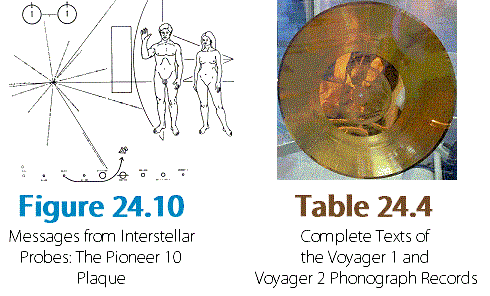
|
Surprisingly enough, the Arecibo radio pictogram was not mankind’s first intentional space message for ETs. Pioneer 10, a spacecraft, was first.
| Pioneer 10 |
Pioneer 10 was launched toward Jupiter on 3 March 1972, loaded with scientific equipment designed to measure the radiation environment surrounding the giant planet.
- Traveling at 11,000 meter/second, the interplanetary probe encountered Jupiter on 4 December 1973 and swung around its massive bulk at close range.
- Assisted by a kind of "slingshot effect," the spacecraft rapidly accelerated up to 23,000 meter/second.
- In 1976 it reached the orbit of Saturn, and three years later the orbit of Uranus, where its radio signals finally became too weak for detection from Earth.
- In 1983 Pioneer 10 will cross the orbit of Pluto and head out into deep space at an interstellar cruising speed of 0.0043%c (13,000 meter/second).3136
- It will become the first manmade object to leave the solar system, our first interstellar spacecraft.*
Attached to the exterior of the vehicle is a 6" × 9" gold-anodized aluminum plate engraved as shown in Figure 24.10. The message announces our existence to the cosmos. Any alien species which picks it up and deciphers its meaning can tell who built it, when and where it was built, how tall we are, our basic physiology, and our approximate technology at the time of launch.168
| The Voyager phonograph record |
A vastly more sophisticated message was affixed to each of the follow-up missions to the jovian worlds in the late 1970s, called Voyagers 1 and 2.3131 Instead of a simple plaque, a phonograph record was the chosen medium. The Voyager phonograph record contents are too lengthy to reproduce here but are listed in Table 24.4.**
- The record is a 12" copper disk to be played at 16 2/3 revolutions/minute using a ceramic cartridge and stylus enclosed for the purpose.
- Instructions for playback are written in pictorial sign language on the outside of the aluminum can holding the record.
Remarks Carl Sagan optimistically:
If they’re able to tool around in interstellar space picking up stray, derelict spacecraft,
they ought to be able to figure out our instructions.***
* According to computer projections, Pioneer 10 is creeping out into a relatively empty region of space. Estimates indicate that it should pass fairly close to the star Aldebaran (aTauri), which is 68 light-years from Earth, in the year 1,601,983 A.D.
** [Editor's note - for a more thorough presentation of the Voyager Golden Record, see Voyager Golden Record]
*** Computer projections by Michael B. Helton at JPL show that the Voyagers, like the Pioneers before them, will not closely encounter any alien solar systems.
- Voyager 1 will pass Pluto’s orbit late in 1987 and head out toward the constellation Ophiuchus (Declination 10.1º, Right Ascension 17h, 20m).
- Voyager 2, assuming it goes to Uranus but not Neptune, will exit the solar system in mid-1989 on the way to Capricornus (Declination -14.9°, Right Ascension 21h, 1m).
- In about 40,000 years both craft should coast to within 1.7 light-years (Voyager 1) or 1.1 light-years (Voyager 2) of AC+79 3888, a fourth magnitude star.
- Voyager 2 should pass a similar distance from another star (AC -24 2833-183) 100,000 years later in Sagittarius
- And about 375,000 years after that, Voyager 1 will pass within 1.5 light-years of AM +21 652 in the constellation of Taurus.3207
|
A subsidiary but nonetheless important benefit
of starprobes is that they may function as "cosmic safety deposit boxes" for the cultural heritage of the contacting civilization. culture perishes for whatever reasons, the starprobes they sent to other worlds can still tell their story to any willing ears for perhaps geological time periods thereafter. |
While penurious planetary Type I societies may only be able to afford radio wave communications, we have already pointed out that technically sophisticated civilizations (whose technologies realize theoretical maxima in matter-energy systems) should view signals and probes as energetically indistinguishable alternatives for interstellar communication. Both may be used by advanced Type II or Type III cultures, for a variety of different purposes and functions. But energy efficiency cannot be used to distinguish the two choices when maximum technology is available. We must look elsewhere for distinguishability criteria.
| Distinguishable criteria for starprobes |
The author believes that probes are probably the method of choice for technically advanced civilizations. In support of this position, he would like to offer several criteria which he believes argue persuasively for the inherent superiority of starprobes in interstellar communication.
| First: Communications feedback |
First, there is the issue of communications feedback.
- A probe which discovers a garrulous inhabited world may engage in true conversation with the indigenes, an interchange and interweaving of cultures.
- Interactive exchanges may take fractions of a second between questions and answers.
- On-site starprobes, perhaps in orbit around the host’s sun or planet, can carry on real-time educational and linguistic functions with a precision no remote signaling system can match.
- As an added benefit, such intelligent devices would provide a noise-free channel of communication on any frequency of the contactee's own choosing.
- By comparison, the traditional beacon scenario appears little more than a sterile data swap requiring millennia for each cycle rather than milliseconds.
- With photonic transmissions, different sentient species cannot really converse.
| Second: Acquisition efficiency |
Second, there is the question of acquisition efficiency.
- A beacon may radiate useful energy and information out into space for centuries, millennia, or even longer without getting any response. This energy, since it was detected by no receiver, essentially was wasted and constitutes pure economic loss for the sending society.
- Such a scheme necessarily assumes an inordinate (and possibly selectively disadvantageous) degree of generalized altruism on the part of the transmitting culture.
- Starprobes, on the other hand, become independent agents as soon as they are launched. There is no further need for energy expenditure by the transmitting society.
- Sophisticated messenger probes will be self-repairing, self-programming, and capable of refueling or recharging at every port of call.
- They can wait patiently in orbit for hundreds or even millions of years, waiting for the emergence of a communicative culture on suitable planets in the system.
- Alternatively, they may hop from star to star until they find communicative lifeforms, and then enter into an exchange at no further cost to the original transmitting society.
- A subsidiary but nonetheless important benefit of starprobes is that they may function as "cosmic safety deposit boxes" for the cultural heritage of the contacting civilization. If the transmitting society is destroyed or the culture perishes for whatever reasons, the starprobes they sent to other worlds can still tell their story to any willing ears for perhaps geological time periods thereafter.
| Third: Military security |
Third, there is the overwhelming advantage of military security for the transmitting race.
- Interstellar beacons are an invitation to disaster at the hands of unknown predatory alien civilizations. In any situation involving contact via signals, the transmitting society has given away the position of its home star system at great risk for mere speculative benefits.
- This terrible breach of military security may be remedied by using starprobes instead of signals. If local intelligent activity is detected by a probe in orbit around a target star, the machine may open contact with the indigenous technical species without ever having to disclose the whereabouts of its creators.
- If it is necessary for the starprobe to report what it has learned to the transmitting society from time to time, this easily may be accomplished in a manner which is virtually impossible to trace or to decode (e.g., by relaying trapdoor-function-encoded data through a series of widely dispersed and complexly organized repeater stations).
- In other words, starprobes can safeguard security in an exchange between alien societies.*
For these and many other reasons (see Chapter 17), more and more xenologists are beginning to view the interstellar messenger probe as the preferred mode of communication among extraterrestrial civilizations.
(See ■ Benford,3270 ■ Betinus,3156 ■ Bracewell,1041,1040,80 ■ Clarke,3230 ■ Forward,718 ■ MacGowan and Ordway,600 and ■ Niven.231)
| Neutral meeting place |
* To guarantee the physical security of both races (host and visitor), perhaps each should send a probe to some common neutral meeting place far from the home star of either civilization.
- The two starcraft could then rapidly interrogate each other, interactively exchange information, and then move off and report back the results to their respective creators without risk.
- For the contact, a meeting site should be chosen that is known and accessible to both parties but which itself harbors no life (or only insignificant lower forms that pose no threat).
- Examples might include nearby O or B stars, local pulsars or black holes, white dwarfs, giant or supergiant suns, or very young solar systems located between the two potentially communicative alien civilizations.
|
| Standard entry procedure |
Assume that an advanced alien technical civilization institutes a major starprobe program and dispatches computerized messenger vehicles to spy out neighboring solar systems. One plausible "standard entry procedure" (Figure 24.11) might run as follows:
1: Preliminary acquisition – 0.5 light-year away, traveling at 10%c, the starprobe makes its first high-resolution scan of the target and makes slight course adjustments to increase accuracy. Braking engines are activated.
2: Messenger searches for the star’s Zodiacal Light, stray sunlight scattered from the dust and debris surrounding the star. All planets lie in this thin blanket of dust, so the probe corrects its course so as to enter the plane of the solar system. Speed has fallen to l%c or less.
3: Approach on cometary orbit until solar irradiance sensors indicate that the midpoint of the local habitable zone (for the desired biochemistry) has been reached — say, just above the melting point of water. Drop into a circular, circum solar orbit.
4: Seek out and examine any planets in or near the ecosphere, and examine each for spectroscopic evidence of, say, water and oxygen in the atmosphere. Select the first planet having both in appropriate concentrations and move into orbit around it.
5: If the body is accompanied by a large natural satellite (such as Luna in the case of Earth), perturbations will seriously disrupt a simple global orbit. To negate the disturbing influence of the moon, settle into a relatively stable Trojan Point orbit. (For Earth, two of these points lie in the lunar orbital path both 60° ahead and behind.)
6: Activate search sensors to infeed data to look for any signs of intelligent life or technological activity. Collate and compile the information.
7: Record positional star map, including accurate fix on home world. Transmit to home world a preliminary report of sensor findings, including astronomical, biological and technical data gained by scanning and eavesdropping on the target planet.
8: Begin routine signaling or other activity to announce presence and to attract attention. If no intelligence is in evidence, enter dormant mode with specified wake/sleep schedule for periodic resampling of planetary environment and basic self-maintenance functions.
| What to look for? |
What sorts of things might the visiting probe look for to determine if intelligence exists on the planet?
- To be visible from space, the intelligence must manifest itself in artifacts. Direct photographic reconnaissance from the distance of lunar orbit could be very difficult.
- To resolve the artifacts of human civilization unambiguously would require a visible-light telescope with an effective diameter of many tens of meters.
- A neutrino detector to pick up evidence of fission of fusion power generation on the surface of the planet probably would be too massive.
- Atmospheric heat flow and composition analysis should be highly suggestive (e.g., fluorocarbon aerosols in the stratosphere probably cannot be generated naturally in an oxygenic carbon-aqueous biosphere), but may still be too ambiguous.
| Energy usage and information flux |
The two most critical parameters of technological civilizations — energy usage and information flow rate — frequently will be directly measurable from space.
- At night, the waste energy escaping the metropolitan regions of Earth can be measured from orbit, so the starprobe should be able to assemble a fair estimation of global power consumption.
- As for information flux, the silent alien craft could detect countless powerful radio stations whose emissions seem to wax and wane with the daylight.
- Assuming the ET spy is smart enough, it should be able to listen in on our transmissions, learn our languages and customs, and tap into our cultural and technological heritage.
- Before it makes overt contact, it will probably know a great deal about us.
| Attracting attention |
What is the best way to attract attention and to initiate first contact with a planetbound Type I civilization such as our own?
- The orbiting starprobe could turn on a bright light or explode a bomb, but this would be inefficient, ambiguous, and might not even be seen at all by the intelligent planetary inhabitants.
- Contact lander craft or robot encounter vehicles could be soft-landed on the surface, but this is a rather tall order for a modest-sized automated starcraft.
| Frequency and message selection |
Ronald Bracewell, a Stanford University radioastronomer and an early advocate of interstellar messenger probes, has suggested that once intelligent radio emissions have been detected by the starprobe the selection of frequency and message is relatively easy:
What frequency will it use? In the case of a messenger probe, this is a nonproblem, since the probe can rest assured that on any frequency where a transmitter can be detected there will also be, somewhere, a receiver! The probe can choose any frequency which is already plainly in use. This automatically guarantees that someone is listening, because no one transmits if nobody is listening. … It is true that at least one receiver will be tuned in, and perhaps a large audience, but will they pay attention to an unwanted, interfering signal? If the probe gives out something that you don’t want, you will go away. So a simple procedure would be for the probe to amplify and transmit the same TV program or military communication it was receiving. Its signals would then have the appearance, to us, of echoes exhibiting delays of seconds to minutes depending upon its distance from Earth. For instance, if we were listening to the radio, each word would be heard twice, first by direct transmission from the station and then again a little later via the probe.85,80
|
In other words, the best frequency for a starprobe to use to attract attention is one which is already in use, since this guarantees a listening audience. The best message to send is a duplicate of whatever was transmitted, since this guarantees an interested audience.* The detailed contact plan of the "Bracewell probe," outlined in Figure 24.12, is one eminent xenologist’s view of the most likely way it may happen. Says Bracewell: "I believe we are on the eve of plugging into the galaxy-wide communication network."1040
Near indeed — is it possible that we have already detected a Bracewell probe? Duncan Lunan, former President of ASTRA (Assn. in Scotland for Technology and Research in Astronautics), once advocated that, just possibly, we have.
| Radio echoes |
The story begins in 1927, during research then in progress on round-the-world radio echoes. (These echoes are propagated by reflections between the charged layers of the ionosphere and the Earth itself, and take about 1/7 second to circle the planet and return.)
- Taylor and Young in the United States reported hearing echoes they couldn’t explain, signals with delays of only hundredths of a second and coming from a point 2900-10,000 kilometers overhead.
- Today we surmise these came from the Van Allen radiation belt, discovered in 1958 by the Explorer I satellite, but in 1927 the effect was a real mystery.
| Long Delayed Echoes |
Later that year Carl Størmer, a Norwegian mathematician, chanced to meet a telegraphist by the name of Jorgen Hals, who told him that the 10,000-kilometer delay was no so astounding since he, Hals, had heard echoes of three full seconds which he believed were coming from the moon.
- Størmer, fascinated by this, conducted his own experiments on the phenomenon with the assistance of Balthus van der Pol, a telecommunications specialist at Philips Radio, Eindhoven. In November and December of 1928, Størmer and van der Pol published two letters to the editor in the prestigious British science weekly Nature.211,210
- In these letters they described their work which confirmed Hals’ claims. The first sequence reported by van der Pol, and confirmed by Størmer, consisted of pulse delays at the following intervals: 8, 11, 15, 8, 13, 3, 8, 8, 8, 12, 15, 13, 8, and 8 seconds.
- This was one of the first reports on the so-called Long Delayed Echoes (LDEs), and many more such sequences were later recorded by Størmer and van der Pol, and others.2869
| Assuming artificial as an evidentiary technique |
Following the suggestion by Bracewell that LDEs are remarkably similar to the general kind of message we might expect to receive from an alien starprobe, Duncan Lunan3132 puzzled over the meaning of the delay times. He decided to start with the assumption that LDEs were signals from an extraterrestrial spacecraft, an evidentiary technique which once worked for Heinrich Schliemann in the discovery of the ancient city of Troy.
- The delay times, Lunan noted, were not the sequence of prime numbers that many had expected would accompany the first alien call signal.
- Yet if they were artificial they must have some meaning.
|
Figure 24.13 Space Probe from Epsilon Boötes?3132 |
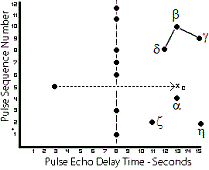
First van der Pal sequence, This diagram can be
This is the required answer and if transmitted back, the probe should transmit further information.
A tentative conclusion is that the probe arrived here from Epsilon Boötis 13,000 years ago. |
| Surprise result |
Lunan decided to make a graph plotting delay time against sequence number. The result, to his surprise and delight, was the pictogram reproduced in Figure 24.13.
- According to Lunan’s original interpretation, the drawing represents a picture of the brightest stars in the constellation Boötes.
- The positions of the stars are shifted as they might have appeared 13,000 years ago (due to proper motion across the sky), so this may be when the probe first arrived in our system and compiled the original sky map.
- One star, Epsilon Boötis, is displaced to the left of the vertical line a distance equidistant from its true position on the right.
- To Lunan, the message seemed clear: The home star of the alien craft was Epsilon Boötis.
- Finally, since LDEs were known to follow the path of Luna’s orbit,1124 the starprobe presumably was located in Earth orbit at one of the two Trojan Points.
| Occam’s Razor |
Lunan’s interpretation of LDEs was immediately questioned by the scientific community.172,1125
- Occam’s Razor demands that the simplest explanation of phenomena should prevail, and experiments by the American researcher F.W. Crawford and his colleagues3133 and others1089 have led to the conclusion that LDEs probably are the result of shock wave propagation and amplification in the F-layer of the Earth’s ionosphere.
- Also, LDEs appear to occur seasonally, whereas an interstellar messenger would be expected to transmit on a continuous basis. A.T. Lawton and his coworkers in Great Britain have even beamed call signals at the trailing lunar Trojan Point in an attempt to elicit some response from the hypothetical starprobe, but no intelligent return signals were ever detected.
| New hypothesis: origin was Tau Ceti |
What is the latest word on Lunan’s theory? Lunan himself apparently abandoned his early hypothesis when it was discovered that the Epsilon Boötis double star system has suns much more massive than Sol, and thus probably too short-lived for life to have evolved. Lunan’s new hypothesis is that the starprobe’s point of origin was Tau Ceti. This has received support from others:
[Lunan] has since claimed that Epsilon Boötis would be a prime navigational reference for a starflight from Tau Ceti to the Sun; as seen from Tau Ceti, our Sun would lie in Boötis. In 1975 a Russian astronomer, A.V. Shpilevski, published an alternative interpretation of the 11 October 1928 LDEs in the Polish magazine Urania. By plotting the same dot series in a different way he found a star map of the constellation Cetus, with the star Tau Ceti indicated as the star of origin. If the star map has any reality, it shows us that the probe came from the nearby star Tau Ceti, from which no radio noise has ever been detected.3257
| Indiscriminate jamming vs. interaction and communication |
Of course, the probe could simply broadcast high-powered radio interference on the appropriate frequencies. However, instant replays of local broadcasts would appear more friendly than indiscriminate jamming, and would also indicate that the starprobe was prepared to interact and communicate with the indigenous civilization.
Bracewell probes are just one kind of nonhuman artifact we may discover in our own solar system.3152 Foster,1136 Macvey,2724 and others have described a number of alternative possibilities:
- Space Laboratories — may be crewed by biological lifeforms, cyborgs, automata, robots, or other mechanical devices.3279
-
- May also exist as wrecks, hulks, or otherwise in derelict condition
-
- Repeater Stations — automatic and designed to operate for long periods of time unattended.
-
- Capable of receiving, sifting, organizing, and retransmitting signals across interstellar distances.
- May be part of a galactic communications network, relaying messages using radio waves, x-rays, neutrinos, tachyons, or whatever.3418
-
- Telemetry Stations — designed to observe, detect, and record changing local environmental characteristics, and perhaps to transmit these data, together with its own operational status, periodically to some agent or agency located outside the solar system.
-
- Interactive functions are not ruled out, but basic mission is observation.3293
-
- Marker Buoys — transmits navigational beams which future starships from the same visiting alien civilization can use to home in on Sol.
-
- Another function may be to tag fuel dumps, valuable local mineral deposits, databank storage facilities, unusual objects of special or potential interest, or caches of essential equipment left behind by a former expedition.
-
- Monuments and Edifices — serving to record or to symbolically identify past expeditions to a site; grave markers for deceased, unborn, or hibernating alien astronauts; nonfunctional obelisks or plaques.3256 Might also serve as informational or data repositories such as:
-
- A Saunders Databank.2611
- Edie’s organic message carriers in meteorites or comets.150,154
- Or something like the "Extraterrestrial Message Block" on display at the National Air and Space Museum in Washington, D.C.3157
-
- Tools and Implements — all sorts of equipment ranging from lost screwdrivers and wrenches (or the alien equivalent) to cast-off electronic components.
-
- Sophisticated recording or sensing instruments.
- Abandoned computers.
- Unserviceable nuclear reactors.
-
- Refuse or Debris — blocks or shards of metal, ceramic, or plastic scrap and other waste materials clearly of extraterrestrial manufacture or origin.
-
- Undecomposed biological wastes or debris.
- Deposits of industrial tailings.
- Sites of chemical or radioactive contamination.
- Alien corpses in spacesuits.3294
-
- Environmental Evidence — unnatural rearrangement of surface terrain; fused rock; inexplicable radioactive "hot spots".
-
- Severe paleomagnetic or geomagnetic anomalies.
- Destruction of planetary bodies (our Asteroid Belt?).
- Planetary orbital anomalies (our Pluto?).
- Unusual geological or planetological phenomena (Saturn’s rings?).
-
- Another suggestion is that our DNA code may itself be an alien message left behind on a lifeless Earth eons ago by visiting ETs.
-
- Its ability to survive and to reproduce seems a perfect solution to the problem of durability over geological timescales.3178,2611
-
| Preferred locations for finding alien artifacts |
Are there any preferred locations in the Solar System when alien artifacts are most likely to be found? Many writers have suggested that there are four distinct places where physical evidence of the past presence of ETs may be found:
- Objects in transient hyperbolic orbits around the Sun. (Single pass through our Solar System, very difficult to detect)
- Objects in permanent orbit around Sol. (Orbit may be highly eccentric, or perfectly circular. Difficult to detect, but we have lots of time to look.)
- Objects in orbit around planets, moons, or asteroids.
- Objects located on or below the surfaces of planets, moons, or asteroids.
| Parked in orbit |
It would seem that (3) and (4) would offer the best prospects for easy detection.
We have already mentioned (3) in connection with Bracewell probes.
- These devices might be parked in a stable synchronous orbit or in the Trojan Points if there’s a large natural satellite nearby.
- Unusual moons such as Iapetus or Titan of Saturn, Triton of Neptune, and Charon of Pluto similarly may be tagged with orbiting artifacts.
|
Table 24.5 Total "Stabilized" Surface Area Available in Solar System for Long-Term Deposition of Alien Artifacts(modified from Foster1136) |
 |
| Total stabilized surface area available |
What about possibility (4), surface artifacts?
- The majority of planetary surfaces in our Solar System are unsuitable for the long-term preservation of objects soft-landed from space.
- Only a very small proportion of the total surface area of our System has any degree of permanence at all, and the forces of erosion which occur on any world with an appreciable atmosphere (or winds) or widespread geological plate tectonic (or volcanic) activity suffice to rule out many major planetary bodies.
- We must therefore exclude Venus, Earth, Mars, Jupiter, Saturn, Uranus, and Neptune.
- This leaves the surfaces of Mercury, Pluto, most of the moons of planets, and all of the asteroids.
Table 24.5 at right shows the total "stabilized" surface area available for extremely long-term storage of alien artifacts in our Solar System.
| Attractive nuisance |
What if future astronauts from Earth stumble upon an artificial device or artifact clearly of alien manufacture, in the Solar System or elsewhere? Do we have the right to tamper with, and possibly destroy, property belonging to ETs? Or can we claim eminent domain or "salvage rights" and thus convert it to our own use, however we see fit? (After all, it is intruding in our solar system — can’t we do what we like with it?) What if we mistakenly activate the mechanism, or use it incorrectly, and it causes us serious harm? Can we demand reparations from the extraterrestrial race that left it here, under some notion of "attractive nuisance"?
- Certainly the aliens who planted the artifact are technologically far in advance of ourselves, assuming we find it in our Solar System before we have achieved interstellar travel capabilities.
- The mere fact that we have found the object thus suggests either that it was intended to be found or that it was not intended to be hidden (the ETs don’t care if we find their sandwich wrappers).
- Technically advanced aliens should be able adequately to hide an artifact from querulous human explorers. So such machines or devices probably will not be equipped with "death rays" or similar unpleasantries to ward off intruders.
- If intended to be found, starprobes ought not be designed to be tamper-proof by curious sentients. In fact, in the interests of interstellar amity, the alien artifact should clearly demonstrate that it has nothing to hide (except the location of its home star); that it is a messenger of information, peace, and goodwill; and that it is not to be feared, suspected, or avoided.
- It should be easily disassemblable. The sacrifice even of a complex and expensive machine may well be worth the avoidance of interstellar hostilities between races.
| Advice for handling alien devices |
If probes or artifacts are discovered by human astronauts, the event represents a variety of first contact and a tremendous opportunity for communication and technical progress. Duncan Lunan, summarizing the conclusions of an ASTRA study entitled "Man and the Stars,"1001 offers the following practical advice for handling alien devices of various types:
If [astronauts] stumbled on something accidentally, perhaps they should leave it alone until experts get there, but that is not practicable on interplanetary or interstellar missions. In the interplanetary situation, they should send data back to Earth but not touch, in the first instance — the approach from there will be determined by what the thing appears to be and whether it still appears active. The next stage would be to try radio and light signals on it, with caution if we don’t know what it is: we may get a reaction as well as data. Before any close approach there would have to be tests for radioactivity etc., even if the object appears inactive.
A small enough object could be brought back to Earth for study, but that decision requires great caution — the thing could be a container for radioactive or biological waste, or a weapon platform. It is entirely possible that something dumped, or launched, by someone else could be dangerous to us. If brought back for study, the object should be placed on the Moon or in Earth orbit rather than landed. If it is small enough to be brought back the odds are that we detected it by its emissions, therefore it is probably still active. We should be prepared for this situation to turn into a true Contact — the object could be one of Professor Nonweiler’s hypothetical cryo-bio-packages, or an escape capsule with the occupant in suspended animation.
For a large, immobile object, detected for instance on a planetary surface by photographic survey, we would have to establish on-site investigation facilities. Even so the first checks should probably be made by Lunokhod-type vehicles, because of a reaction when we begin active study with radio, x-rays, etc. How far would we go in active examination — would we take such a thing apart at any stage? Arthur C. Clarke’s "Sentinel" was meant to be broken, so that its makers would know intelligence here had mastered spaceflight and atomic energy. The black monolith, the version of the device depicted in 2001: A Space Odyssey, had only to be dug up: as soon as sunlight struck it, it was activated and began its study of us. In the former case, the destruction of the pyramid was to bring "Them" back; in the latter, where the monoliths were supposedly responsible for the development of our intelligence, we were directed to the third monolith which delivered the next part of the programmed learning course. The object we find in real life, however, may be more functional. If it is a navigational beacon, for example, interfering with it may bring a repair crew rather than a Contact team.
If we were leaving or launching an object that was intended to be found, we would put information or instructions on the outside {e.g., the Pioneer 10 plaque}. So if the object we find doesn’t have any, we should treat it with caution. But the absence of instructions may just mean that the makers did not expect intelligence to find it — we don’t put external data on our interplanetary probes, arid probes from intelligence elsewhere in the Solar System (e.g. Jovian or Venus life) might be harmless even if unmarked. An intelligence from elsewhere, exploring the System before our time and anticipating the development of one or more intelligent lifeforms here, might be expected to leave unambiguous message-artifacts like Professor Bracewell’s hypothetical repeaters, and plant them in as many places as possible.1001
|
Figure 24.14 Project Daedalus: Mission to the Stars2953 |
|
|
|
|

The Daedalus starship takes shape in orbit around Callisto, near Jupiter. 
Jovian Aerostat Factory. Factory modules floating in the atmosphere of Jupiter harvest the isotope Helium-3 for use as fuel in the Daedalus starship. On the left is the overall scheme, with ascent vehicle docked. At right is detail of the factory complex. 
At low thrust, the Daedalus starship leaves Callisto’s orbit. Soon it will have escaped from Jupiter and the Sun and head into interstellar space on its 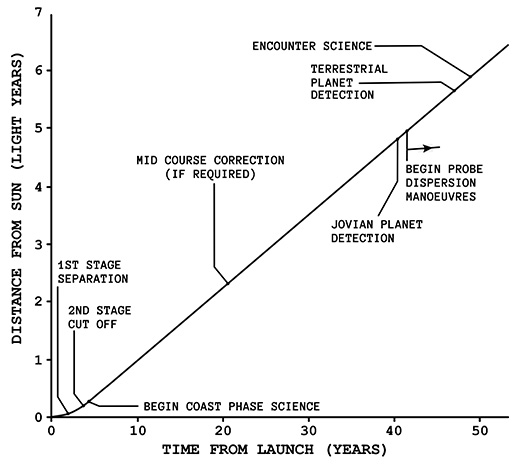
Basic Daedalus starship mission profile: Basic mission profile to Barnard’s Star, giving distance from the Solar System as a function of time into mission. 
The main Daedalus vehicle. Already well into the encounter with the planetary system of the target star, detects new phenomena on the star and deploys a high-velocity-gain subprobe to attempt a closer look. 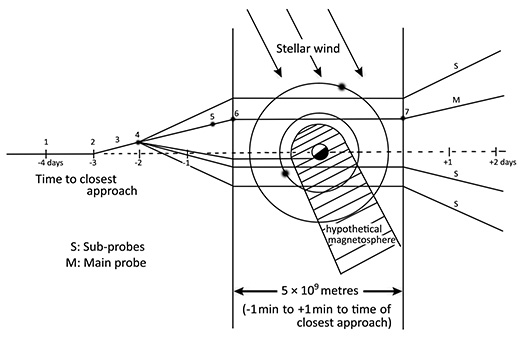
Deployment of Daedalus planetary probe at encounter Key to Figure:
|
If technically advanced alien civilizations can build starprobes and send them to Sol, how long will it be before humanity can construct and launch interstellar messenger vehicles of its own? A small group of engineers and physicists, all members of the British Interplanetary Society (BIS), decided to find out.
- In February 1973 they initiated Project Daedalus, an impressive four-year feasibility study of a simple interstellar probe mission using only present-day technology or reasonable extrapolations to near-future capabilities.
- More than 10,000 man-hours were expended directly on the Project, which culminated in April 1977 with a prototype design and finally in 1978 with the publication of the final report.
The following is a very brief summary of the design and mission specifications for Project Daedalus (Figure 24.14), the first comprehensive starship design study in the history of mankind.2953
| Mission profile |
The basic mission profile involves an unmanned and undecelerated starprobe which executes a flyby of Barnard’s Star at a distance of about 6 light-years from Earth.
- This particular target was chosen, not because of its inherent superiority to a Centauri (a closer and more likely system to harbor life3224).
- But rather because it lies near the midpoint of the expected maximum useful range of the Daedalus vehicle — roughly 10 light-years.
- The final design calls for a starship with a total initial mass of 54,000 tons, of which 50,000 tons is propellant in the form of deuterium/helium-3 frozen fuel pellets.
- The vehicle consists of a two-stage nuclear pulse rocket, a widely discussed conventional interstellar propulsion technique that has been described extensively in the literature. (See Chapter 17.)
The trip to Barnard’s Star would require about 20 years of R&D effort (design, manufacture, and vehicle checkout), 50 more years of flight time at about 12%c, followed by another decade of data transmission from the probe relating to approach, encounter, and exit science.
- Therefore a basic funding commitment over at least the next 80 years would be required for implementation and successful completion of the mission.
| Aerostat factories |
As shown in the time-into-mission graph in Figure 24.14 (Tab #8 above), the Daedalus starprobe would leave the Solar System probably from near-Jovian space. This is because the helium-3 needed for fuel is rare on Earth and must be harvested from the atmosphere of Jupiter using "aerostat factories" floating in the jovian air at medium altitudes. (This technology obviously requires at least a mature spacefaring Type I cultural level among humans, which should be attainable in the next century here on Earth.)
- The boost period, involving three propellant tank drops and a single stage separation, would last 3.8 years.
- At the end of these events, the starprobe would have achieved a cruising velocity of about 12%c.
- During the flight out the payload remains active, making continuous measurements and constantly reporting data back to Earth.
- A wide variety of "coast phase" scientific investigations would be undertaken, including direct detection and observation of interstellar particles and fields and innumerable detailed astrometric very-long-baseline measurements of distances to other stars and of the size of the Galaxy.
- At the time of encounter with the Barnard’s Star system, a dispersible payload would be deployed much like the multiprobe Pioneer Venus (1978) spacecraft or the warheads of a MIRV’ed missile.
- As the vehicle approaches Barnard’s Star, two onboard large space telescopes (Palomar-size 5-meter reflectors) swing into action, beginning the search for planets and an accurate determination of their orbits.
- Once these orbits are established, heavily instrumented subprobes would be launched on close-intercept trajectories for more detailed observations.
- The main ship carries 40 tons of extra fuel for this purpose, and the main propulsion system would be used for each maneuver.
- Throughout the encounter period the subprobes — up to 18 in number — would pass their data back to the mother ship, which receives the transmissions on each of eight 10-meter-diameter radio dishes studding the starprobe’s exterior.
- This information is processed and condensed by Daedalus’ semi-intelligent computer system, which is housed in a central core running through the payload.
- Later it is relayed back to Earth during the post-encounter period using the bowl of the dormant second-stage engine as a giant radio communications dish.
- The total mission payload is about 500 tons, a large fraction of which is in the dispersible subprobes.
- A typical subprobe weighs more than 10 tons and measures 20 meters in length. Prior to deployment each is shaped like a narrow conical frustrum in order to facilitate radial packing into the cargo bay.
- Each subprobe’s communication channel, operating on a 1-kilowatt transmitter, can beam as much as 11 million bits/second of data back to the main vehicle in "video" mode.
- When talking to Earth, the starprobe uses a 1-megawatt radio transmitter operating at 2-3 GHz with a maximum bit rate of 864,000 bits/second.
(See encounter scenario, Figure 24.14, Tab #11)
| The wardens |
The Daedalus starship design includes many necessarily innovative features too numerous to mention here. One example is the "wardens," created to help ensure the vehicle’s self-sufficiency:
The requirement for a high degree of reliability suggested that a system of "Self Test and Repair" philosophy should be adopted. Also, the payload effectiveness could be enhanced if it were possible to re-organize experiments when required en route. Further, in order to avoid the contaminated environment of the main vehicle it became desirable to place the particles and fields experiments a long way (several thousand kilometers) from the main vehicle. These requirements led to the concept of robot self-propelled vehicles carrying specialized tools and general manipulators. These vehicles would have a limited degree of data processing and machine intelligence, but any high level decision making would be carried out by the main mission computer on the main ship. Two of these "wardens" would be provided, each having a mass of about 5 tons. A total mass of spares of 15 tons would be available.2953
| BIS and the manned moon lander mission |
Starprobe Daedalus may never be built, but it is perhaps a primitive prototype design for the exploratory interstellar spacecraft of the coming century. It provides a firm basis for discussion of the plausibility of Bracewell probes and other artifacts that may find there way into our Solar System at the hands of alien adventurers. To those who remain skeptical of the ambitions of the BIS’s Project Daedalus, let them recall that it was the same British Interplanetary Society that conceived a model for a manned moon lander mission a mere 30 years before Armstrong and Aldrin first set foot on lunar soil.
 |
|
Many billions of intelligent races may exist
in the Milky Way alone at the present time. |
We have seen that the origin of life, the evolution of sentience, and the development of technology may be common processes in this universe. Many billions of intelligent races may exist in the Milky Way alone at the present time. Naturally, we are anxious to learn more about them if they exist — if possible, to seek them out and have some sort of useful interaction with them. Presumably many of them will be similarly motivated to seek out their sentient brethren.
- It is for this reason that the general theory of first contact — contact principles applicable to any interaction between any two extraterrestrial civilizations — is of such monumental importance to xenologists.*
- Knowledge of the basic procedures and ethical considerations involved in first contact will serve two useful purposes:
- To suggest ways other civilizations will interact with each other, what polities and societies they may establish, whether or not peace is likely, and so forth; and
- To suggest what humanity may expect when it first makes contact with an alien civilization from the stars.
* See, e.g., discussions by: ■ Lunan1001 ■ McDougal, Lasswell, and Vlasic252 ■ Maruyama and Harkins615 and ■ Haley382
|
Table 25.1 Summary of Interactions That May Occur Between Two Populations(after Pianka286) |
||||||||||||
|
|
Metalaw The study of possible laws |
According to Dr. Eric R. Pianka, a population ecologist at the University of Texas at Austin, two populations, when they interact, may or may not affect each other. If they do, the influence may be beneficial or adverse. Using these basic notions, Dr. Pianka devised a simple taxonomic technique which xenologists can use to classify all possible interactions between pairs of sentient alien populations.286
- Let us designate a beneficial effect with a "+".
- A detrimental effect with a "-".
- And no effect with a "0".
- Where two groups interact with mutual negative effect, Pianka designates the interaction as (-,-).
- When both benefit, it is (+,+); and so forth.
| Six distinct ways species interact |
Thus, there are a total of six fundamentally distinct ways in which two intelligent species may interact as outlined in Table 25.1.
| Competition |
In this classificational scheme, competition (-,-) occurs when each of two populations affects the other adversely.
- Typically both require the same resources that are in short supply, so the presence of each population inhibits the other.
- Xenological might include the competition between human interstellar colonizers and humanoid native indigenes on a distant Earthlike planet, or between two Type II stellar civilizations for the matter and energy in the solar system of the same class G star.
- Competition may be economic, social, political, or even religious. The most extreme form is war.
| Predation |
Predation (-,+) takes place when one population affects another adversely but benefits itself from the interaction.
- For instance, a predatory alien society may choose to destroy other societies it meets, killing the sentient inhabitants and then preying upon their planetary, stellar, or technological resources. (Predation for food, more common in biological situations, is less likely across interstellar distances but may still occur when alien colonists invade a less-technically-advanced world.)
| Parasitism |
Parasitism, another (-,+) interaction, is similar to predation except that the host population is not killed outright but is exploited over some period of time.
- Powerful parasitic ET conquerors from advanced stellar civilizations might leave heavily armed garrisons on subject worlds where native populations had been enslaved for the purpose of dismantling the planet for its mass or building huge fleets of warships to be used in a subsequent wave of conquest (perhaps fueled with hydrogen drained from the local star).
| Amensalism |
Amensalism (-,0) is said to occur when one population is adversely affected by another but the other is unaffected.
- In the xenological context, perhaps one civilization is so advanced that it regards the other as a mere nuisance, "flicking" it off as we would swat a gnat.
- Another example of amensalism would be when a technically sophisticated race gives a less-advanced society so much technical information that it either loses spirit and becomes dependent on the superior race, or is virtually destroyed when it tries to use knowledge that it cannot fully understand.
| Neutralism |
Neutralism (0,0) occurs when the two populations avoid contact altogether. There is no real interaction and neither affects the other in any significant way.
- Such a situation might obtain if two warring starfaring civilizations agreed to cease hostilities, suspend all mutual interactions, erect a "neutral zone" which each society agrees not to cross, and then continue their expansionistic conquests in other directions.
| Commensalism |
Commensalism (+,0) takes place when one population benefits while the other is not affected.
- Familiar examples in biology are the mosses, bryophytes, bromeliads, orchids and other plants that grow on the trunks and branches of trees.
- The commensal population flourishes at no visible expense to the trees because they occupy the surface of what is in effect protective tissue (whose function is not thwarted by the presence of the symbionts.)
- An analogous situation between xenological populations might involve a powerful Type III civilization that allowed a puny planetary society to freely wander the corridors of the Galactic Library. The galactic culture would be unaffected, but the planetary culture might be benefited enormously.
| Cooperation |
Finally we have cooperation (+,+), which occurs when two populations interact in a way that is beneficial for both.
- This may include trade, cultural exchange, integration of the two societies and the synthesis of a higher level of organization, or joint military ventures of conquest.
| Mutualism |
Mutualism (+,+) is similar to cooperation except that the relationship between the two populations is obligatory rather than facultative. That is, neither race can exist in the absence of the other.
- An example here might involve a parallel to ants and aphids, where one ET society provides the foodstuffs needed by both and the other provides umbrella military protection from alien predators and competitors.
|
Figure 25.1 Principle of Competitive Exclusion |

The Principle of Competitive Exclusion states that unless the niches of two species differ, they cannot coexist. In effect, one race says to the other, "This environment isn’t big enough for the both of us." According to modern population biologists, a pair of very similar species can coexist only if new aspects are added to the environment, so that one part favors one species and the other part favors the second species. Examples in biological ecologies abound. For instance, above are the life histories of two species of flour beetle.
|
|
The maximum competition
is to be found between those species with identical needs. |
| Competition theory |
Some ecologists have claimed that each of the above six classes of interaction may be described mathematically and the exact outcome predicted given certain initial conditions.
- "Competition theory," for instance, was devised more than fifty years ago by Lotka and Volterra. The Lotka-Volterra Competition Equations describe the growth of two competing species in limited environments, given the specific reproductive rates of the two races and the environmental carrying capacity for each alone.
- In 1934 Gause experimentally verified the major result of the Equations — that no two species that are ecologically identical can long coexist.3313
This Principle of Competitive Exclusion, or Gause's Law as it is sometimes called, may be restated as follows:
The maximum competition is to be found between those species with identical needs.3198
| Principle of Competitive Exclusion |
The two graphs in Figure 25.1 illustrate the Principle in two competing species of flour beetle. Analogous situations readily may be imagined in the context of interaction between two extraterrestrial civilizations. Mathematical models of commensalism, predation, and the rest may yield similar insights for xenologists.
- Of course, the commingling of two highly complex alien societies will require a vastly more sophisticated analysis than that provided by the Lotka-Volterra Equation and similar formulations such as "game theory"820,3394,3487 and other models of interaction.
- Further, the sociocultural data needed to properly evaluate each new situation will necessarily be incomplete and thoroughly ambiguous in many first contact situations.
- For these and other reasons, many xenologists today eschew attempts to precisely and mathematically model interactions between hypothetical alien societies.
- Most favor a more qualitative generalized approach.
- This has led to the emergence of a new subdiscipline in xenology known as "metalaw" — the study of possible laws applicable to all relations between alien intelligences.689
 |
| Interstellar Avon lady or Murderous villains |
Science fiction all too often portrays extraterrestrials as a kind of "interstellar Avon lady," providing humans with innumerable goods and services.78 At the other extreme, ETs are frequently described as murderous villains from the stars who conquer Earth and enslave humanity. Neither of these alternatives seems to represent a useful basis upon which to establish metalegal relationships.
- There may be stringent rules limiting what one race will allow itself to give or sell to another, less-developed one.
- And if a society has a policy of destroying every alien ship as soon as it is met, and then turning to attack the ET's home planet, someday it will tackle a civilization that is too powerful and will itself be destroyed. As one writer notes: "Interstellar checkers is not a viable mode of existence."1001
| Subjugation, colonization and exploitation |
As the author has pointed out elsewhere,2001 the history of human expansion has been a sordid tale of subjugation, colonization and exploitation.
- The Europeans were perhaps most notorious in this regard. Natives of foreign lands were shipped back to the Continent and placed on display as if mere zoo animals, even though they differed in appearance only slightly from the colonists.
- Our early settlers in this country displaced the Indians similarly, herding them into compact reservations on worthless land and imposing upon them our way of life and our system of government (to a large degree).
- And the technologically advanced nations weren't the only ones to expand by means of ruthless incursion and expulsion of indigenous races.
- • The Aborigines ran out the Tasmanians.
- • The Malays routed the Sakai.
- • The Bantus expelled the Hottentots … The tally of human aggression is virtually endless.
| Principle of Defense |
We see that a constant in human sociopolitical evolution has been the need and desire for security against foreign invaders. From this we may infer that any civilized alien race may regard physical security as a primary requirement in any first contact situation. We may call this the Principle of Defense.
- But this notion is not easy to apply in practical situations. The main difficulty is in drawing the line between defense and offense.
- That is, must we wait for the ETs actually to attack us before we try to defend ourselves, or do we attack their strike bases before they can launch against us?
- That is, how far do we go with what military strategists call "anticipatory defense"?
- And there may be instances in which we do not realize we have been attacked until it is too late:
- • Infiltration by human-looking androids.
- • Planetary inoculation with "propaganda viruses."
- • And irresistible radio messages from the stars are common themes in the science fiction literature.
| Principle of Noninterference |
Another suggested basis for metalegal relations that has gained wide currency is the so-called Principle of Noninterference. The gist of this idea is that each culture should leave others entirely alone — let them evolve naturally, with no help or interference from outsiders.
- If cultural integrity is to be strictly maintained, the technically inferior race must be totally isolated.
- Yet the mere knowledge that advanced race even existed would probably be enough to interfere with the normal development of a society.
- Must we therefore insist that extraterrestrial civilizations remain in total ignorance of each other? Is cultural quarantine really desirable?
- And the whole idea of strict noninterference may be bad.
As anthropologist Magoroh Maruyama once said:
Many anthropologists say: Don’t disturb this culture because it is the result of so many thousands of years of evolution that it’s perfect. Now that’s entirely a wrong idea, based on the Western kind of logic. Cultures change; all biological and, social processes change.3395
| The Golden Rule |
A third suggestion is that all ETs should simply apply the Golden Rule in their dealings with one another. This basic principle seems to crop up again and again in the philosophical and religious writings of humankind. For example:
- "What is hateful to thyself, do not unto thy neighbor" (Babylonian Talmud).
- "A man should treat all living creatures as he himself would be treated" (Sutra-Kritanga).
- "You must expect to be treated by others as you have treated them" (Seneca).
- "Do naught to others which if done to thee would cause thee pain" (Hindu Mahabharata 5.1517).
- "Great Spirit: Grant that I may not criticize my neighbor until I have walked for a moon in his moccasins" (Sioux Indian Prayer).
- "We should behave to friends as we would wish friends to behave to us" (Aristotle).
- "Hurt not others with that which pains yourself" (Buddhist Udanavarga 5.18).
- And, of course, "As you wish men to do to you, so also do you to them" (Christian Bible, Luke vi. 31).
Applying the Golden Rule, we should treat aliens as we would wish to be treated ourselves. Conversely, they should treat us as they themselves would wish to be treated, assuming the universality of the metalegal principle.
| Haley's definition |
But the late Andrew G. Haley, the world's first "space lawyer" and widely regarded as the father of metalaw, pointed out the fallacy in this approach far back as 1956, at the Seventh International Astronautical Congress in Rome.693 According to Haley, metalaw, defined as "the law governing the rights of intelligent beings of different natures and existing in an indefinite number of different frameworks of natural laws," would require a different moral basis than present Earthly law.
| Golden Rule is anthropocentric |
The traditional Golden Rule is starkly anthropocentric; that is, it reflects the subjective needs and wishes of humans. In the case of generalized contact, application of the principle would require each interacting species to impose its own sociobiologically-derived goal structure and motivations upon the other race.
- As Haley observed, to treat other sentient creatures as we would desire to be treated might well mean their destruction.
- Similarly, if ETs treat us as they would wish to be treated, it could destroy us. This conclusion derives from the simple fact that two sentient species inevitably must differ in their physiological, psychological, and sociocultural specifics.
- It would be better for each race to find out how the other desired to be treated, and to act accordingly.
| Great Rule of Metalaw |
Accordingly, Haley proposed the following as the Great Rule of Metalaw:
![]() Do unto others as they would have you do unto them.693
Do unto others as they would have you do unto them.693 ![]()
In other words, we should treat aliens as THEY want to be treated, not as WE think they ought to be treated. This is a very simple means to ensure both the safety and the equality of metalegal partners.
| Do not disrupt |
However, in practice the Great Rule might be as difficult to apply as the Principle of Defense and the Principle of Noninterference. If we are to ascertain the desires of the other party, we may have to interact with them to a certain degree — and this may cause sociocultural damage. George S. Robinson of the Institute of Air and Space Law at McGill University in Montreal has raised another issue:
Who, or what, determines that which is "injurious or hurtful to some other being"? If mankind is to make such a determination, it is of necessity one which is anthropocentric in nature. If an alien being is to make the determination, is not man deprived of some rights as an integral party? Or perhaps there is a compromise based on an understanding of all participants of the ultimate laws of nature permitting or tending towards a balanced universal ecosystem? If there is truth in the latter approach, again we must turn to the principle involved in Haley's Interstellar Golden Rule — do not disrupt unilaterally the ecosystem of an alien sentient being.1079
| Dangerous approach |
Others fear that to treat aliens as they wish to be treated may imperil humanity. In the most extreme case, ETs may wish to be treated as conquerors. Remarks S.W. Greenwood:
The Great Rule of Metalaw proposed by Andrew Haley appears to have aroused surprisingly little critical comment. It seems to me to be a highly dangerous approach to the problem of how to behave in the presence of an alien intelligence. Literally it appears to direct an Earthman to do whatever an alien desires. What should be done when an alien desires an Earthman to hand over his vehicle, his equipment, and his crew? It is evident that the Rule of Metalaw would often be unworkable.1181
|
Table 25.2 summarizes the many metalegal rules which have been suggested by various human philosophers, theologists, xenologists and other writers for use in dealings between sentient races.
- Many are unfeasible even in theory, some are unworkable in practice, but all appear to be based on anthropocentric considerations which derive from the sociobiological framework and essentially simian psychology of man.
- We are still left with the problem of developing a set of nonconflicting, serviceable metalegal rules.
| Eleven basic metalaws |
A major step toward this goal was achieved in 1970 by the Austrian jurist and legal writer Dr. Ernst Fasan. In his book Relations with Alien Intelligences,372 Dr.Fasan attempted to develop a sophisticated, self consistent set of eleven basic metalaws which he believes should be applicable to interactions among all sentient beings in the universe because they are divorced from the details and specifications of individual races.
| Categorical Imperative |
The central philosophical underpinning for Fasan's Metalaws is the so-called Categorical Imperative, first elaborated by the 18th century German philosopher Immanuel Kant.3492
- The main thrust of the Imperative, which is said to hold for any rational being, is that no activity can be ethical for one if it is not ethical for all.
- In Kant's own terminology it is a moral axiom which is true for every sentient creature: "Act in such a way that the maxim of your will can at the same time always be valid as a principle of general legislation."
- That is, if a particular course of action will lead to contradiction or a generally destructive result, then it is proscribed by the Categorical Imperative.
- Thus if one contemplates murder, he should ask: "Would it be desirable for everyone to murder?" Clearly it would not, as the murderer’s own death would be the result. This inherent contradiction rules out murder as a viable "principle of general legislation."2000
| Minimize entropy and build internal order |
Fasan then goes on to discuss the physical nature of extraterrestrial beings. He points out that all living organisms select those acts which will minimize entropy and build internal order out of external chaos. As Fasan observes:
So life must necessarily fight, with every sort of movement and decision, the influence of entropy. Evolution means gathering more and more information which enables the organism to better withstand entropy. This gathering of information produces the highest possible level of life: Life coupled with reason and intelligence. Life is reasonable and intelligent if it can understand itself. Like all living beings, the intelligent ones — but consciously so — will choose the alternative which seems to be the least harmful, which seems to be most anti-entropical.372
| Proper subjects of metalaw |
Those beings which are the proper subjects of metalaw, says Fasan, therefore must of necessity possess the following five characteristics:
- The ETs are alive in the negentropic sense.
- The ETs have intelligence, consciousness, free will, and empathy.
- Each metalegal partner is physically detectable by the other.
- The aliens have existence or activity within three-dimensional space.
- The ETs have some, if only rudimentary, will to live.
Using the Categorical Imperative and these five basic assumptions about the nature of all sentient extraterrestrials, Dr. Fasan derives eleven metalaws of presumably universal validity, reasoning along the following lines.
| Cause no harm |
First, to destroy or harm intelligent life is necessarily illegal. This is simply a prohibition against increasing entropy for intelligent life. The rule might be phrased as follows: "Any act which causes damage to another race must be avoided."
- This confers both rights and obligations on all sentient races.
- If one race does not comply, then the injured race should have the right to protect itself.
- So every race has the right to defend itself against harmful acts perpetrated by another race.
| Equal rights and values |
The basic will to live will not permit any intelligent race to consider itself inferior.
- The Categorical Imperative will not permit any race to consider itself superior, because that would mean that every race could consider itself superior.
- Therefore, all intelligent races of the universe have, in principle, equal rights and values.
- Since no one may have sovereignty over an equal partner, every partner of Metalaw has the right of self-determination.
| Preservation of life |
Any interaction between mutually detectable races may result in a collision of interests. Damage may be present or future, immediate or prospective. Since the preservation of life is a precondition for its further development, opposing interests must be resolved in a way that gives priority to avoiding actual present damage to existence over possible future damage to development.
- Hence the preservation of one race has priority over the development of another race.
- Similarly, no race has the right to seek benefit by demanding that another race inflict damaging entropy upon itself to help the first race out.
- It is not a legal but an ethical principle that one race should help the other by its own activities.
- Also, if a race is damaged by past acts of another then it should be able to demand positive action to remove the damaging consequences of those acts.
- The Categorical Imperative tells us that such is a viable metalegal rule since, according to Fasan, if every race were free to inflict harm on another race without any obligation of restoration, the legal insecurity would increase and the damaged race might feel inclined to retaliate with force.
- In case of damage the injurer must restore the integrity of the injured party.
| Self-preservation |
Of course, if restitution is impossible it cannot be demanded. Living organisms are not capable of performing the impossible. Even if restitution is possible but would threaten the very existence of the damager himself, says Fasan, still it is not mandatory.
- No person nor nation must destroy itself in order to fulfill any legal obligation.
- The basic trend of life is to preserve its own existence.
- The concept of life itself prohibits any rule which would demand suicide.
- In other words, no rule of Metalaw has to be complied with when compliance would result in practical suicide for the obligated race.
| Truth, honesty, and integrity |
Finally, the Categorical Imperative demands that relations between intelligent beings must be based upon truth and honesty.
- If one race relies to its detriment upon faulty information or broken promises made by another race, the damaged race has suffered unlawful harm.
- Metalegal agreements and treaties must be kept. And since every conceivable race of aliens must exist or act in three-dimensional space, all sentient species need living space as a necessary condition for their existence.
- Every race has a title to its own living space.
| Fasan's eleven metalaws |
In descending order of importance and precedence, Dr. Fasan summarizes his eleven metalaws as follows:
- No partner of Metalaw may demand an impossibility.
- No rule of Metalaw must be complied with when compliance would result in the practical suicide of the obligated race.
- All intelligent races of the universe have in principle equal rights and values.
- Every partner of Metalaw has the right of self-determination.
- Any act which causes harm to another race must be avoided.
- Every race is entitled to its own living space.
- Every race has the right to defend itself against any harmful act performed by another race.
- The principle of preserving one race has priority over the development of another race.
- In case of damage, the damager must restore the integrity of the damaged party.
- Metalegal agreements and treaties must be kept.
- To help the other race by one’s own activities is not a legal but a basic ethical principle.372
|
In other words, living beings should always act
to further the mission of life in the cosmos, which is to reduce the universe to order by building the maximum complexity into the mass-energy available. |
There is little doubt that Dr. Fasan’s approach represents a significant and welcome step towards the synthesis of a workable set of metalegal rules of conduct, valid a priori for all sentient beings in the universe. However, Fasan’s Metalaws appear to have a single serious flaw which calls into question the validity of several of the derived principles.
| Flaw in Fasan’s Metalaws |
That flaw is the Categorical Imperative itself.
- When Kant promulgated his Imperative involving maxims of general legislation, he entirely ignored the possible existence of a sentience of a qualitatively higher order than that possessed by humanity.
- In Kant's view, creatures are either rational or they are not — there are no other alternatives. Fasan, by adopting the Categorical Imperative as the basis for his metalegal formulations, falls into the same anthropocentric trap.
- His discussion of the physical nature of extraterrestrial beings makes it clear that he too regards human-style intelligence as "the highest possible level of life."372
| Higher orders of awareness |
Many xenologists today believe that multiple orders of higher sentience are quite possible. As the author suggested in (Chapter 14) (and see below), there may exist a series of successively more sophisticated intellectual emergents in the evolution of sentience — plateaus of intelligence perhaps keyed to the data processing efficiency of alien minds.
- Individuals comprising extraterrestrial societies may possess simple reactivity (such as plants on Earth).
- Or personal consciousness (as in humans).
- Or they may exhibit yet higher orders of awareness not possessed by humans which we have labeled, for convenience, "communality," "hypersociality," "galacticity" and "universality."
Kant’s Categorical Imperative cannot be valid for interactions among beings of qualitatively different orders of sentience, any more than it can be used to guide human dealings with beehives or termite mounds.
| Thermodynamic ethics |
Let us try to repeat Fasan's analysis of a priori metalaw, avoiding entirely the notion of Categorical Imperative and relying instead solely upon considerations involving entropy.
- That is, we shall attempt to formulate a set of metalegal principles working solely from the basis of what the author has termed "thermodynamic ethics", or thermoethics.
| Principle of negentropism |
The basic organizing influence in the universe is life.
- Life involves the utilization of a flow of energy to draw order from chaos and build internal complexity with an accumulation of information. Living beings thus are anti-entropic, or negentropic, entities.
- The principle of negentropism is, in a manner of speaking, the "natural law" applicable to all living (matter-energy) beings located anywhere in the universe, regardless of their size, shape, biochemistry, sentience, or culture.
- (Fasan unwittingly devised a "natural law" applicable to all Homo sapiens, the Natural Law of Man. This is nothing more than what E.O. Wilson might call "mammalian law."3198)
Hence we may state the Principal Thermoethic as follows:
All living beings should always act so as to minimize the total entropy of the universe, or so as to maximize the total negentropy.
| Cosmic standard |
In other words, living beings should always act to further the mission of life in the cosmos, which is to reduce the universe to order by building the maximum complexity into the mass-energy available.
- Note that the Principal Thermoethic defines the optimum relationship between an individual and his universe, rather than between individuals.
- It is fundamental to all thermoethical decisions that one's actions are judged against a cosmic, not local, standard.
- Consequently it may be ethical to do some act which decreases local order, if the net result is an increase in the total order of the universe.
| Applying the Principal Thermoethic |
How does the Principal Thermoethic apply to contact interactions between intelligent extraterrestrial races? In this universe there may exist many different kinds of creatures with widely varying levels of sentience and cognitive awareness. Some societies will possess more information than others; some beings will process information faster or more efficiently than others. Thus there is a natural ordering or continuum of all living things.
- Those entities which are more negentropic are better serving the mission of life in the universe, hence they are inherently "more ethical."
- Those beings which engender the same negentropy as others are "equally ethical."
Therefore, we may state the Corollary of Negentropic Equality, which follows directly from the Principal Thermoethic, in this way:
|
Note #1
Corollary of Negentropic Equality (See Also) ♦ Further Reading ■ Cocca358 ■ Fasan3407,372 ■ Haley382,693 ■ Nicolson3215 ■ Rhyne3398 |
All entities of equal negentropy have equal rights and responsibilities; the more negentropic an entity, the greater are its rights and the deeper are its responsibilities.Note #1
| Three kinds of interaction |
As ecologist Eric Pianka has pointed out, there are only 3 basic kinds of interaction which can take place:
Detrimental (-), neutral (0), and beneficial (+). According to the Principal Thermoethic:
- Detriment is equivalent to a loss of information, an increase in the disorder of the universe.
- Detrimental (-) acts violate the Principal Thermoethic, and hence are unethical.
- Neutrality (0) implies that information is neither created nor destroyed, but merely maintained. Since there is no law of conservation of information analogous to the conservation of mass-energy, a positive act is required to preserve order in the cosmos.
- Such acts are thermoethical; failure to so act is unethical.
- Finally, beneficence (+) is equivalent to a gain of information, a decrease in the total disorder of the universe.
- Beneficial acts which affirmatively generate negentropy fulfill the Principal Thermoethic, and hence are ethical.
| Three duties |
Summarizing, we see that three distinct duties devolve upon all thermoethical entities in the cosmos, following directly from the Principal Thermoethic. These may be called:
- The "duty to avoid harming."
- The "duty to preserve."
- The "duty to create."
- The duty to avoid harm must necessarily take precedence over the other two, since it is useless to create and impossible to save information if it is simultaneously being destroyed.
- Similarly, it would be wasteful (and thus entropic) to garner new information if one is incapable of preserving it.
| Three duties cast into thermoethical Canons |
These three duties may be cast in the form of three fundamental thermoethical Canons, applicable to the interactions between all living beings in the universe a priori:
| Canon I: | Any act which increases the entropy (disorder) of another race should be avoided.Note #2 |
To satisfy the Principal Thermoethic the duties imposed by Canon I should be obeyed. |
|
| Canon II: | Each race holds its negentropy (information) in trust for the entire living universe, and should do the utmost to preserve it.#3 |
If this is done, then the duties imposed by Canon II should be completed. |
|
| Canon III: | Any act which increases the negentropy (order) of another race should be carried out.Note #4 |
If the Principal Thermoethic, Canon I and Canon II do not prohibit it, the duties imposed by Canon III may be carried out. |
|
Notes #2-4
Canon I Any act which increases the entropy (disorder) of another race should be avoided. (See Also) ♦ Further Reading ■ Fasan3407,372 ■ McDougal, et al.252 ■ Sagan3448 ■ Freitas2001 ■ Miller1204 ■ Vitoria3410 ■ Haley382 ■ Moskowitz3396 ■ Human Rights3486 ■ Korovin3404 ■ Rhyne3398 Canon II Each race holds its negentropy (information) in trust for the entire living universe, and should do the utmost to preserve it. (See Also) ♦ Further Reading ■ Fasan372 ■ Haley382 Canon III Any act which increases the negentropy (order) of another race should be carried out. (See Also) ♦ Further Reading ■ Bueckling3403 ■ McDougal, et al.252 ■ Fasan3407 ■ Smirnoff3411 ■ Greenwood1181 ■ Spiegelberg3404 ■ Lindsay3013 ■ Vasquez253 Compare: ■ Fasan372 ■ Freitas2001 ■ Human Rights3484 |
We may rephrase these duties in somewhat less technical language as a hierarchical code of behavior for all living beings, as follows:
| Canon I: | Destroy not. (Avoid harming, if it is at all possible.) |
| Canon II: | Preserve, if in preserving you do not destroy. |
| Canon III: | Create, if without harm and the creation may be preserved. |
| Metalaws generated from Canons |
Each Canon may be used to generate a number of specific metalaws to guide interactive behavior in particular situations.
- For example, from Canon I we have Metalaw I-1, the Entropic Censorship Rule: "In any first contact situation, the Contactor should never give the Contactee any matter-energy or information inputs that may cause the Contactee entropic harm."#5
- Next might be Metalaw I-2, the Entropic Defense Rule: "Every race has the right to defend itself against entropic (disordering) acts perpetrated by another race, provided the entropic cost of such defense is less than the loss of negentropy sought to be avoided."#6
- Metalaw I-3, the Biosphere Preference Rule, might read as follows: "Every race is presumed to be entitled to the biosphere which it occupies."#7
- Then there is Metalaw I-4, the Free Egress Rule, which holds: "Living entities have the right to travel to any biosphere, subject to the restriction that they must not entropicate (disorder) indigenous living systems."#8
|
Notes #5-8
I-1: Entropic Censorship Rule In any first contact situation, the Contactor should never give the Contactee any matter-energy or information inputs that may cause the Contactee entropic harm. (See Also) ♦ Further Reading ■ Boyce3663 ■ Bova1400 ■ Campbell3241 ■ Davis171 ■ Fasan372 ■ Haley693,382 ■ Hogan3518 ■ Hoyle62 ■ Kuiper/Morris2608 ■ LeGuin2895 ■ Miller1183 ■ Molton3629 ■ Nicolson3215 ■ O'Neill2710 ■ Reynolds3423 ■ Robinson1079 ■ Saunders2611 ■ Smith1206 ■ Stern389 ■ Stover1539 ■ Strong50 ■ Zhukov317 I-2: Entropic Defense Rule "Every race has the right to defend itself against entropic (disordering) acts perpetrated by another race, provided the entropic cost of such defense is less than the loss of negentropy sought to be avoided." (See Also) ♦ Further Reading ■ Bova1400 ■ Brownlie3399 ■ Cocca358 ■ Drake3280 ■ Faria3406 ■ Fasan3407,372 ■ Freitas2001 ■ Haley382 ■ Smirnoff3411 ■ Vázquez253 I-3: Biosphere Preference Rule "Every race is presumed to be entitled to the biosphere which it occupies." (See Also) ♦ Further Reading ■ Anderson63 ■ Fasan372 ■ Human Rights3483,3485 ■ Hyman1525,385 ■ Vázquez,253 Compare: ■ Verplaetse386 I-4: Free Egress Rule "Living entities have the right to travel to any biosphere, subject to the restriction that they must not entropicate (disorder) indigenous living systems." (See Also) ♦ Further Reading ■ Faria3406 ■ Haley382 ■ Stern389 ■ Vitoria3410 |
| Metalaws derived from Canon II |
Canon II similarly gives rise to a number of specific metalaws, applicable to relations between extraterrestrial races so long as no metalaws associated with Canon I are violated.
- For instance, we have Metalaw II-1, the Preservation Preference Rule: "The preservation of one race must have priority over the development of another race."#9
- There is Metalaw II-2, the Infinite Sinks Rule: "Every race has a duty to avoid infinite information sinks or, in other words, no race should demand or submit an impossible request."#10
- We have Metalaw II-3, the Rule of Restitution: "In case of entropication of one race by another, the race causing the damage must restitute the living universe for the loss of information."#11
- Then there is Metalaw II-4, called Pacta Sunt Servanda: "Metalegal agreements and treaties must be honored."#12
|
Notes #9-12
II-1: Preservation Preference Rule "The preservation of one race must have priority over the development of another race." (See Also) ♦ Further Reading ■ Niven and Pournelle668 ■ Fasan3407,372 Compare: ■ Friedman694 II-2: Infinite Sinks Rule "Every race has a duty to avoid infinite information sinks or, in other words, no race should demand or submit an impossible request." (See Also) ♦ Further Reading ■ Fasan372 II-3: Rule of Restitution "In case of entropication of one race by another, the race causing the damage must restitute the living universe for the loss of information." (See Also) ♦ Further Reading ■ Fasan372 II-4: Pacta Sunt Servanda "Metalegal agreements and treaties must be honored." (See Also) ♦ Further Reading ■ Fasan372 ■ Joseph1474 ■ Rhyne3398 |
| Metalaws derived from Canon III |
If the proscriptions and duties imposed by Canons I and II are observed, then sentient beings may work with metalaws derived from Cannon III.
- For example, there is Metalaw III-1, the Rule of Submission: "Every race should willingly submit to negentropic acts effectuated by a more negentropic race, provided the information gained by such acts is greater than the total entropy suffered."#13
- Then we have Metalaw III-2, the Negentropication Rule: "Each race should perform whatever positive actions are necessary to assist in the development of beings of higher negentropy than themselves."#14
- Also we have Metalaw III-3, the Rule of Permissible Suicide, which goes as follows: "Any race may commit a suicidal act if the local entropication suffered thereby is exceeded by the universal negentropy gained."#15
- A more moderate version of the same principle is Metalaw III-4, the Self-Jeopardization Rule: "Any race may risk entropication of any of its component parts if the probable negentropy to be gained thereby exceeds the probable entropication."#16
|
Notes #13-16
III-1: Rule of Submission "Every race should willingly submit to negentropic acts effectuated by a more negentropic race, provided the information gained by such acts is greater than the total entropy suffered." Compare: ■ Fasan372 ■ Moskowitz3396 III-2: Negentropication Rule "Each race should perform whatever positive actions are necessary to assist in the development of beings of higher negentropy than themselves." (See Also) ♦ Further Reading ■ Anderson3491 ■ Anvil2162 ■ Lee22 ■ Vinge634 ■ White2442 III-3: Rule of Permissible Suicide "Any race may commit a suicidal act if the local entropication suffered thereby is exceeded by the universal negentropy gained." (See Also) ♦ Further Reading ■ Haley3397 ■ Herbert/Busby3273 ■ Lunan1001 ■ Ritner1550 Compare: ■ Fasan372 III-4: Self-Jeopardization Rule "Any race may risk entropication of any of its component parts if the probable negentropy to be gained thereby exceeds the probable entropication." (See Also) ♦ Further Reading ■ Harrison1537 ■ LeGuin97 ■ Oliver1560 |
 |
What will first contact actually be like? How will the participants regard each other?
- It is often suggested that when humanity encounters technologically advanced aliens they may seem as gods to us.
- It is said that they will be capable of miracles and, in essence, "magic" — and that they may be as far beyond us in intelligence as we are beyond the ants.
In the author’s opinion, each of the above statements represent gross understatements of the most probable reality.
|
Table 25.3 First Contact Power Differentials: Contactor’s Advantage |
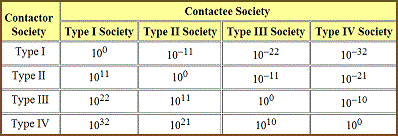 |
The first most important basic parameter that we would like to know about any alien civilization we may encounter is:
- What is their matter-energy-handling capability?
What class of civilization are they?
This single datum will give us a good idea as to what level of contact interaction we may expect.
| Class of civilization |
From our considerations of cultural power utilization we have recognized that there may exist four major classes of mature civilization in the universe:
- Planetary societies (1015 watts continuous)
- Stellar cultures (1026 watts)
- Galactic communities (1037 watts)
- Universal civilizations (1047 watts)
|
We might well be the only technical civilization undergoing
a technological step-transition in the Galaxy at the present time. possibly teeming with life, mankind may yet be quite alone. |
| Power differentials |
Therefore, in any bilateral first contact situation there can only be sixteen distinct levels or modes of contact along the mass-energy scale, as summarized in Table 25.3. The data in the table are called "power differentials," representing the difference in mass-energy-handling capability between the two interacting races. The numbers here are expressed in terms of the contactor's advantage over the contactee.
Looking at Table 25.3 as a whole, there seem to be four distinct power differentials that may occur in any first contact.
- First, the two civilizations may be roughly equal in power usage, in which case the power differential in the contact situation is ~100, or 1.
- Next, two societies may meet whose power consumption differs by ~11 orders of magnitude, or by ~22 orders of magnitude, or, finally, by as much as 32 orders of magnitude.
|
Table 25.4 Comparison of Various First Contact Scenarios, based on Relative Power Differentials |
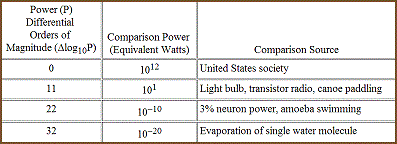 |
| Comparison of Various First Contact Scenarios |
Each such contact event is a qualitatively different situation. To help put the above figures into some kind of reasonable perspective, the series of comparisons assembled in Table 25.4 should prove helpful. In the leftmost column we have the logarithm (order of magnitude) of the power differentials likely to be encountered in most first contact scenarios.
- So, for instance, we may imagine a contact in which the log power differential between the cultures is about zero. This would be roughly equivalent to a nation like the United States, which commands about 1012 watts, coming into contact with another nation of similar power handling ability, say, West Germany.
- Next, imagine a meeting between cultures differing in power usage by 11 orders of magnitude. This would be like a contact between the entire United States and a society in command of only 10 watts of power. Such a meager society could operate one tiny light bulb, play a single miniature pocket radio, or perhaps paddle one small canoe slowly into New York harbor. The phrase "hopelessly outclassed" is an extreme understatement.
- But it gets much worse! Imagine a contact in which the power differential is 22 orders of magnitude. Compared to the entire energy output of the United States, this would only be about 10-10 watts — one-thirtieth the power output of a single human neuron — and some one-hundred-thousandth of the energy expended by a swimming rotifer. An amoeba swimming at low speed uses about 10-10 watts, so the power differential in such a contact scenario would represent a difference between the contacting societies as great as that between the entire United States and an amoeba pseudopoding slowly into New York harbor.
- Finally, consider the most extreme case of a power differential of 32 orders of magnitude, which works out to about 10-20 watts in comparison to all of U.S. society. It is hard for us to conceive of differences in power that are this large. 10-20 watts is about enough energy to evaporate one molecule of water every ten seconds from the surface of the sea. We thus arrive at the incredible comparison of a society with the power of the United States confronting another race whose power usage is barely enough to evaporate a single molecule of water off the back of a tiny amoeba as it swims into New York harbor.
| Beyond human experience |
These latter comparisons span such enormous scales that they boggle the mind into incredulity. Such levels of contact are wholly beyond any normal human experience.
- How are we to visualize a meeting between extraterrestrial societies which differ in energy as much as the entire United States and a single amoeba?
- And what if we are that poor lone protozoan, naively wafting into the galactic equivalent of New York harbor? Not only would such a civilization seem godlike to us, it would actually be God for any practical purpose that can be imagined.
|
||
|
| Timescales of technological advance |
The timescales of technological advance give us some important clues as to the nature of the technical societies we are most likely to encounter. Consider the graph in Figure 25.2. If we depict human technical advance — as measured by energy output, population of, radios or telescopes, or whatever — as a function of time, we find that technological advance appears almost to be what mathematicians call a "step function" over geological and evolutionary timescales.
- Progress is nil for a very long time; all of a sudden, technology shoots up to the maximum theoretical limits as defined by the fundamental laws of physics in the universe.
- Based on our discussions elsewhere in this book, it appears that Type II stellar civilizations will not be technology limited at all. Anything that is physically possible in theory, they should be able to accomplish in practice.
From a technological point of view, then, it would appear that the vast majority of sentient societies may lie on either side of the step (assuming humanity is a typical case).3853
| Impotent or omnipotent |
- Most cultures may be regarded as "impotent" or "omnipotent" insofar as technical abilities are concerned.
- Only a tiny fraction of all evolving technological societies will be in the transition phase occupied by present-day humanity.
- Or, to put it in another more striking way, in any contemporary first contact situation humans are vastly more likely to encounter gods or animals, almost never peers.
- Indeed, it may be viewed as unethical for any omnipotent civilization to contact a society which is technologically impotent or in transition.
| Estimated Number and Distance to Nearest Earthlike Civilization |
Table 25.5 puts numbers to this basic idea. Using our estimates of the probable number of extraterrestrial civilizations in our galaxy and a "reasonable" value for the Drake Equation constant L0 of 10-2 cultures/year (see Chapter 23), the author has calculated the mean number and distance to civilizations that are today at approximately the human technological level.
- "Human level" is taken as a technological "window" in time of about 10,000 years (and we are probably in the last millennium of this span of progress).
- Even given the most optimistic value for civilization lifetime imaginable — 109 years — there are only a thousand other cultures like us in the entire Galaxy, and each is 6700 light-years from the nearest other.
- As we select more modest values for L, we begin to suspect that we may be lucky to find another society at our same stage of development in the entire Milky Way.
- We might well be the only technical civilization undergoing a technological step-transition in the Galaxy at the present time.
Thus in a very real sense, in a Milky Way galaxy possibly teeming with life, mankind may yet be quite alone.
|
How information-efficient are human beings
when measured against the universal standard? having a sentience which is only 10-38% efficient. |
The second most important parameter of civilizations which both contactor and contactee will want to determine as soon as possible is the total information processing capability of each culture.
- This datum will tell each party to the contact how "smart" the other is, how sophisticated may be its thinking processes, and how great are its stores of knowledge.
| Mission efficiency |
The basic mission of life in the cosmos is to process information.
- To the extent that systemic or organismic energy is used for purposes other than information processing, a living entity may be regarded as "inefficient."
As Dr. James Grier Miller suggests in an hypothesis drawn from his general theory of living systems:
Hypothesis 3.3-1: Up to a maximum higher than yet obtained in any living system but less than 100 percent, the larger the percentage of all matter-energy input that it consumes in information processing controlling its various system processes, as opposed to matter-energy processing, the more likely the system is to survive.3071
In other words, it is always better to be smarter.
| Human efficiency |
How information-efficient are human beings when measured against the universal standard?
- A 70 kilogram man can process at least 1012 bits/second of neural reactivity data.
- Yet, according to calculations performed by H.J. Bremermann,3072 the theoretical maximum computing power for an entity of that mass is about 1052 bits/second.
- Apparently humans are woefully inefficient thinkers, having a sentience which is only 10-38% efficient.
| Six orders of sentience |
In an earlier (chapter) we introduced the concept of the Sentience Quotient (SQ), defined mathematically as the log10 of the information processing rate divided by the quantity of mass-energy needed to sustain it, for any living entity.
- We established that the maximum SQ for any being in the universe was about 50, and that human bodies have an SQ of about 10.
- We also speculated that with each decade of improvement in the SQ, a qualitatively new level of awareness might emerge, comparable to our own "consciousness" but vastly more efficient in terms of data processing.
- This defined an arbitrary series of six orders of sentience which we described as "reactivity," "consciousness," "communality," "hypersociality," "galacticity," and "universality," based on the assumption that new modes of thinking emerge every time a thinker can increase its information processing capacity per unit mass by roughly ten orders of magnitude.
(Obviously this is just an approximation, based on Earthly experience; more or less than exactly six orders of sentience are possible. We chose six orders primarily for convenience of discussion in this text.)
|
Table 25.6 First Contact SQ Information Processing Differentials: Contactor’s Advantage |
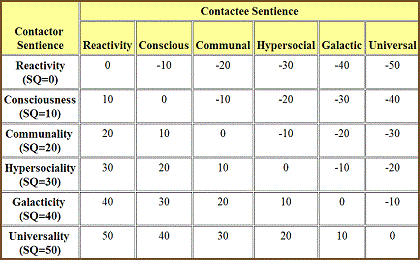 |
| 36 first contact scenarios |
In other words, although the Sentience Quotient actually spans a continuum from 0 to 50 for thinking entities, it may be that each jump of 10 produces a qualitatively different kind of intelligence.
- If this is so, and if our approximately six basic orders of sentience have any reality, then we may distinguish some 36 different basic first contact scenarios in much the same manner as we found 16 distinct contact possibilities based on the mass-energy usage scale.
The data processing differentials in each contact situation are summarized in Table 25.6. The figures are again expressed in terms of contractor's advantage over the contactee race.
| Six differentials |
Table 25.6 shows that there appear to be six distinct differentials that may be used to characterize contact along the information processing spectrum.
- When the two contacting races are of equal sentience, the bit-rate efficiency differential is 0.
- When a communal race meets a merely conscious race, the SQ difference will be 10.
- In still other contact situations, the sentience differential may be 20, 30, 40, or 50.
| Comparison of Various First Contact Scenarios |
As in the previous Section, the figures in Table 25.7 provide a meaningful comparison to assist in our understanding of each of the six different "levels of contact."
|
Table 25.7 Comparison of Various First Contact Scenarios, Based on Relative Information Processing Differentials |
 |
- In the leftmost column we have the Sentience Quotient differentials most likely to be encountered in any first contact situation.
- These are accompanied by a set of comparisons which attempt to relate different orders of data processing ability to something that human minds can readily comprehend — in this case, book reading rates.
| Obvious major problem |
A major problem immediately becomes obvious. It appears difficult intellectually to relate to the awesome power (or awesome lack thereof) of a sentience even a mere 10 orders away from us.236 This hints at the tremendous difficulties humans are likely to experience in dealing with higher order sentiences during the first contact situation. The subject is so difficult that even science fiction writers have rarely attempted to deal with the astounding implications of an encounter with such advanced ETs.
- What would we have to say to a being able to mentally digest 8000 books per second?
- Going in the other direction, could we even communicate with a creature who required 400 million years to read a single volume?
| Mind-boggling examples |
These numbers are so far removed from everyday experience that humans can have no empathy with the orders of sentience that they represent.
- And yet each of these mind-boggling cases are examples of a meeting between beings differing in Sentience Quotient by only 10.
- What of encounters involving differentials of 20, 30, and more? Ours may be the lot of the amoeba creeping slowly across a requisition form on the information counter in the front office of the Galactic equivalent of the Library of Congress.
| Successor sentience to humanity |
The successor sentience to humanity may already be on the horizon — the electronic computer.3270,55,3489,3278
- Using a machine intelligence constructed of experimental superconducting Josephson junction logic gates, the Sentience Quotient will be quite high.
- These gates have switching times on the order of 10-11 second, so can handle about 1011 bits/second.
- They weigh about a nanogram each (10-12 kg), so their information processing efficiency is roughly 1023 bits/sec-kg, for a Sentience Quotient of 23.
| Progeny of our minds |
When computers based on the Josephson junction (or similar principle) eventually are built, it may be time for humankind to step aside. Here is one computer scientist’s view of the future:
I expect the human race to expand into space in the near future, and O'Neill's habitats for people will be part of this. But as soon as machines are able to match human performance, the economics against human colonies become very persuasive. Just as it was much cheaper to send Pioneer to Jupiter and Viking to Mars than men to the Moon, so it will be cheaper to build orbiting power stations with robot rather than human labor. A machine can be designed to live in free space and love it, drinking in unattenuated sunlight and tolerating hard radiation. And instead of expensive pressurized, gravitied, decorated human colonies, the machines could be put to work converting lunar material into orbiting automatic factories. The doubling time for a machine society of this type would be much shorter than for human habitats, and the productive capability would expand correspondingly faster.
The first societies in space will be composed of cooperating humans and machines, but as the capabilities of the self-improving machine component grow, the human portion will function more and more as a parasitic drag. Communities with a higher ratio of machines to people will be able to expand faster, and will become the bulk of the intelligent activity in the solar system. In the long run the sheer physical inability of humans to keep up with these rapidly evolving progeny of our minds will ensure that the ratio of people to machines approaches zero, and that a direct descendant of our culture, but not our genes, inherits the universe.
This may not be as bad as it sounds, since the machine society can, and for its own benefit probably should, take along with it everything we consider important, up to and including the information in our minds and genes. Real live human beings, and a whole human community, could then be reconstituted if an appropriate circumstance ever arose. Since biology has committed us to personal death anyway, with whatever immortality we can hope for residing only in our children and our culture, shouldn't we be happy to see that culture become as capable as possible? In fact, attempting to hobble its growth is an almost certain recipe for long term suicide. The universe is one random event after another. Sooner or later an unstoppable virus deadly to humans will evolve, or a major asteroid will collide with the Earth, or the sun will go nova, or we will be invaded from the stars by a culture that didn't try to slow down its own evolution, or any number of other things. The bigger, more diverse and competent our offspring are, the more capable they will be of detecting and dealing with the problems that arise.3233
This vision of the future provides but one model of many that are possible for SQ=20 sentiences we may encounter on alien worlds throughout the universe.*
* Since theoretical lower limit biological cell size is about 400 Angstrom, a human-size brain could handle roughly 1020 bits/sec-kg. It thus may possibly be true that no strictly biological intelligence can have a Sentience Quotient greater than about 20.
|
Table 25.8 A Generalized First Contact Taxonomy |
 |
It is possible at this point to construct a generalized taxonomy for first contact scenarios which includes all possible combinations of encounters between beings at different stages along the mass-energy and information processing scales we have discussed.
- If our speculations are correct, there are four major levels of power usage and six major levels of sentience.
- Thus, there should be 24 distinct contact scenarios involving various pairings of extraterrestrial cultures.
- Table 25.8 labels These are shown, and labeled for convenience of discussion, in Table 25.8 above.
- In the table, ΔSQ is used to denote the differential in Sentience Quotient between the two contacting races.
- And ΔP is used to denote the log10 of the power usage differential.
|
Table 25.9 Complete First Contact Taxonomy Difference in Power Usage(Civilization Type) ΔP |
|
|
|
 |
| All 576 possible basic encounter scenarios |
Table 25.9 is an expanded version of the First Contact Taxonomy showing all 576 possible basic encounter scenarios, with labels for each.
It is possible to draw a First Contact Taxonomy chart with yet higher resolution, accounting for all levels of cultural power usage (from 100-1056 watts) and all levels of sentience (SQ = 0-50), using single order-of-magnitude steps in both cases. However, such a chart would have 8,450,649 entries, thus seems unwieldy.
- Most science fiction authors and speculative fact writers have concentrated primarily upon the 0/0, 11/0, and 0/10 Contacts.
- There are several cases where 11/10 or 22/0 Contacts have been discussed, and there are even a few scattered references to higher-order Contacts in the literature.
- But, by and large, most of Table 25.9 represents a vast uncharted wilderness of unknowns.
- It is to these gaping holes in our understanding that theoretical xenologists of the future should devote their attention.
 |
Our final topic in this chapter is the pragmatic methodology of first contact.
- What are the proper protocols in establishing contact and communication when two alien races encounter each other somewhere in space?
- We have already seen that the subject of interaction is very complicated, both ethically and logistically, and that the number of different levels of interaction is enormous.
We turn now to a discussion of a few "standard first contact procedures" to be used in various encounter scenarios between sentient extraterrestrial species.
The 0/0 Contact is an encounter between alien races among whom power consumption and information processing capability are roughly equivalent.
- Such a contact may occur between two Type I civilizations, or between pairs of Type II's, Type III's, or Type IV's.
- A 0/0 Contact also occurs between pairs of reactivity species, two conscious races, two societies which both enjoy communality, and so forth.
- All told, there are 24 distinct contact scenarios within this particular classification.
| Encounter between two Type I societies |
First we consider the simplest cases. Type I societies by definition cannot possess advanced starflight on a commercial basis, nor can they create and launch a sufficient number of unmanned automatic probes to nearby star systems to ensure first contact. Hence, a 0/0 Contact between two planetary civilizations will probably involve some form of simple interstellar signaling, perhaps by means of radio waves. (See Chapter 24 Tooltip text.)
- Round-trip data exchanges will take centuries or even millennia to complete, and interaction between the two societies will be very weak.
- There are few ethical issues at stake.
- Similarly, a meeting between two reactivity (SQ = 0) races should not be too exciting, resembling to human eyes more of a contest of creeping forests or at most a dogfight between two packs of wild animals than a congress of sentient alien beings.
| Encounter between two Type II societies |
What about an encounter between two Type II stellar societies, each comprised of beings of equal conscious sentience?
- First of all, the most likely place for such a contact to occur is in the general vicinity of a star. (Encounters near nebulae, neutron stars and other astronomical oddities are conceivable too.)
- The depths of space are so vast that even the bustling commercial activity of a mature Type III galactic culture would go unnoticed by a stationary observer nestled deep in the void between the stars.
- This being the case, two possibilities immediately present themselves: First, that the nearby star is the home (or local colony base) of the contactee race, and second, that it is not.
| No way to hide and no place to flee |
If the solar system is the home of the ETs, there will be no way for them to hide and no place to flee. The artifacts of advanced technological civilization will be blatantly obvious. Even if it is only an early Type II culture, the contactee society will have enveloped individual planets (if not the entire sun) with swarms of:
|
|
|
|
||
| Home society advantage |
Countering the contactee’s relative immobility and the contactor’s advantage of surprise, the contactee should enjoy a tremendous advantage in available military power. Even though the two interacting races nominally command the same magnitudes of energy:
- The visitors cannot bring it all with them.
- Whereas the home society has all of theirs right at hand.
This should help to reduce the vulnerability of the contactee somewhat.
| Sitting ducks |
However, in the final analysis it must be granted that solar systems may be sitting ducks unless they are armed to the teeth and constantly maintained on alert status for evidence of hostile intruders.
- Alien invaders may lie in ambush for years, decades, or even centuries, unseen, patiently monitoring the radio and other emissions of the target system and learning all about them — and calling in reinforcements.
- Small reconnaissance probes could be fired through the system to collect vast quantities of data without detection.
- The erstwhile conquerors could choose the time, place, and manner of attack exactly calculated best to destroy the defenders. Even the most careful of military preparations might not prove adequate to fend off such an onslaught.
- As one writer admits: "In the final analysis, any contacted planet will be at the mercy of its visitors."3257
| Two conclusions |
From this we may draw two basic conclusions.
- First, if the contactor arrives at a surprisingly inconvenient time, supported by an armada of escorts and other unknown vessels, the contactee should expect trouble. Unfortunately there is little it can do, and unless it maintains a powerful military force of its own it probably will fall prey to the invaders.
- Second, if the contactor arrives in a single ship or among a very small group of vessels, chances are excellent that he has not come to fight. Any society capable of crossing interstellar space with a few starships could always find the resources to send more. If attack is the plan, there is no need to send in a few scouts for information that can be obtained more safely, cheaply, and surreptitiously.
| Peaceful alternative |
Assuming the peaceful alternative — the only one in which any options remain open to the contactees — how should the two parties behave? What can they, what ought they, demand of one another?
- Reasoning from our basic thermoethical principles, if the interloper has not attacked then he himself should not be attacked by the host race occupying the local star system. Beings of equal negentropy have equal rights.
- If contactees desire further contact, they should each be prepared to bear half the cost and intellectual burden of interaction. Beings of equal negentropy have equal responsibilities.
- The contactee should not give the contactor any technical information which it knows may cause sociocultural entropication in the contactor’s society, but if it is accidentally harmed in this manner the host is not liable since the visitor assumes the risk of contact on the presumption that the probable benefits would exceed the dangers.
- Finally, the author would like to propose a basic rule-of-thumb in all contact situations: Never allow an alien vessel to approach the centers of civilization closer than the Total Conversion Blast Radius. This is defined as the kill or destruction-radius of the explosion which would result if (accidentally or purposefully) the mass of the entire alien vessel instantaneously suffered total conversion into pure photonic energy.3204,3482
| Contactor behavior |
As for the contactor, he should never enter a system without careful prior surveillance (unless it’s an extreme emergency).
- The visitor is allowed to risk entropication from such surveillance under the Self-Jeopardization Rule. The contactor should scout out the solar system and learn all it can about the inhabitants before making its presence known to them, both to minimize the possibility of harm to itself and to ensure that the contactee will not be harmed by the act of contact (the Entropic Censorship Rule).
- Once contact has been established the visitor should treat the host as an equal and respect their right of self-preservation. Beings of equal negentropy each have priority in determining how their own information (e.g., culture) should best be preserved, because preservation (Canon II) takes precedence over creation (Canon III).
- Applying again the Self-Jeopardization Rule, the contactor should be willing to take the initiative in managing the progress of the encounter (though he should expect the contactee to contribute equally to the exchange) and should be willing to submit to any reasonable nonlethal request by the host which does not violate the Entropic Censorship Rule.
| Leinster Contact |
Consider now an alternative form of first contact, in which the site of the rendezvous is not the home solar system or colony site of either party. This is the an example of a so-called Leinster Contact, named after the author of a 1945 science-fiction story entitled "First Contact":
We don’t know what they’re like and can’t take a chance. We’re going make contacts and try to find out all we can about them — especially where they came from. I suppose we’ll try to make friends — but we haven’t much chance. We can't trust them the fraction of an inch. We daren't. They’ve locators. Maybe they’ve tracers better than any we have. Maybe they could trace us all the way home without our knowing it. We can’t risk a nonhuman race knowing where Earth is until we’re sure of them.1213
| Clever, but unworkable |
Murray Leinster’s solution is to have the two races swap ships, each returning home to its own respective solar system to report the news of contact after arranging for a future meeting at the same place on a specific date. The Leinster Solution is clever, but unworkable in a practical sense for the following reasons:
- Lack of training of each crew in the written technical language of the other race and on the method of operation of each other's complex starship technology;
- Incompatibility of food processing equipment and other life support systems;
- Microbiological or indirect ecological damage to the crew or its home culture, unless each ship is fully decontaminated, bow to stern and inside out, prior to the swap;
- Destruction of the other party in such a suspicious atmosphere is likely, since each party probably knows how to subtly sabotage their own ship (which the other must take home) so it will self-destruct a short while after encounter is broken off (thus giving the surviving group a short-term technological advantage; and
- The parties are automata, they are the ships and thus cannot swap.
| Response from thermoethical ideals |
Xenologists can analyze each possible behavior and suggest the most ordered response from the standpoint of thermoethical ideals. For instance:
- If one party flees immediately following the encounter the other party should not pursue.2580 Contact would most likely be too entropic for the frightened race.
- If one party ignores the overtures of the other, the more active party should increase the bit rate a few times just to make sure the passive ship simply is not bored or impatient.1001
- If there is still no response, the active party should move on without boarding the unresponsive craft.
- If there are astronauts on board, clearly they do not wish to make contact; if the ship is fully automated, the boarding party might inadvertently damage its mechanisms.
| Ethically justified defensive |
If one ship attacks the other, the victim is ethically justified to use whatever defensive force is required to repel the attack. (Acts of retaliation or vindictiveness are not justifiable, as these merely serve to increase the total loss of information in the living universe.)
- Immediate withdrawal and flight is preferable if possible.
- If not, and if the victim is winning the battle, he should disengage as soon as the attacker ceases the attack in order to spare the enemy any unnecessary casualties.
- The victim should then retreat, following a circuitous route home and perhaps changing ships once or twice in uninhabited star systems to foil possible backtracking by the hostiles.
| Worst case scenario |
If, on the other hand, the victim is losing the battle and destruction seems imminent, several things should be done.
- First, a small, undetectable automatic marker buoy with a 1-year activation time delay or coded proximity trigger should be released at the approximate velocity of nearby debris, in a random direction. The buoy should contain full details of the encounter encoded using theoretically unbreakable "trapdoor" cryptography or "Rivest coding," and broadcast using "spread-spectrum" communications channels under cover of the Galactic background noise.
- Second, the victim should not allow knowledge of the location of the home system to fall into enemy hands; navigational charts and records should be prepared for immediate destruction. If the hostiles do find out somehow, radio silence should be broken and a warning message dispatched at the speed of light (faster, if possible) — a signal which, presumably, will arrive well ahead of even the fastest possible alien armada.
- Third, even if it is possible to get a signal off, the victim vessel is ethically justified in committing suicide and self-destructing.1550,1001,3273
- This will serve at least three useful purposes:
- To prevent knowledge of the victim’s technology from falling into the attackers’ hands.
- To prevent the hostiles from learning details of the victim's physiology (which may help in the design of species-specific weaponry and the exact determination of the location of the home system).
- To inform the hostiles that the victims value their race more than their own personal existence, and thus may represent a force to be reckoned with on their home grounds.
| Assumption of peaceful intentions |
Hopefully, though, the encounter will be a peaceful and active one. Lacking evidence to the contrary, the assumption of peaceful intentions should always be made.
- Messages by radio (television) or some equivalent medium may be used to establish a Lincos-type linguistic basis. Ambiguities can easily and swiftly be resolved simply by projecting a movie film of the appropriate object or behavior onto a huge screen on the side of the contact craft, or by exchanging actual samples and artifacts.
- If information transferal is continuous, the bit rates in each direction should be adjusted to rough equivalence; if transmission is discrete, as an the case of physical samples or movies, reciprocation is again expected.
- The rate of interaction should be rapid enough. to ensure progress, but slow enough to allow the analysts of each race to properly assess whether the exchange of further information will be beneficial or entropic to themselves.
- If either party decides that further interaction will prove harmful, then the conversation may shift to other areas of discourse or may be terminated altogether.
| Establish full mutual trust |
If full mutual trust can be established, the two ships may trade information on the location of the home system of each, set up preliminary trade agreements, establish common communication modes and media, and so forth, if authorized, to do so by the civilization each represents.
- If not, or if full trust cannot yet be established, a second meeting should be arranged in the same solar system, at some specified and agreed-upon time.
- Each party should then withdraw along a random course, following a circuitous path home.
- The contact ships of each, and any artifacts that have been taken aboard during the contact, should be parked in an uninhabited solar neighborhood far from the home system.
- A friendly Transfer Vessel should then be dispatched from the home system to pick up the travelers and return them to home; the contact ship and its cargo may be quarantined and examined at leisure, thus foiling any possible attempts at backtracking by the other less-than-totally-trustworthy party to the contact.
| Many other variants of 0/0 Contact |
Space does not permit a discussion of the many other variants of 0/0 Contact.
- An exchange between a pair of communal sentients would appear to humans much like two high-speed digital computers transferring gigabits of data as they talked.
- If two Type III galactic societies came into contact, the agreed upon procedure might be to set up a Contact World on which the various contacting races could meet and exchange information.
- All situations, however, should be analyzed using the same thermoethical fundamentals as were applied in the cases above.
The 11/0 Contact is a meeting between alien races whose members possess roughly equivalent sentience but one of whose cultures commands 11 orders of magnitude more power than the other.
- Such encounters may occur between a Type I and a Type II community.
- Between a Type II and a Type III galactic society.
- Or between a Type III and a Type IV universal civilization.
Since six sentience differentials are possible, there are 18 distinct scenarios within the classification of 11/0 Contact.
| Encounter between Type I and Type II |
Probably, the most interesting case from the human point of view is an encounter between two conscious races, one of which is a planetary Type I society (like us) and the other of which is a stellar Type II civilization. This suggests three distinct scenarios, as follows:
- (1) Contact occurs in the Type II’s home system.
- (2) Contact occurs in the Type I’s home system.
- (3) Contact occurs in the home system of neither.
| Scenarios 1 & 3 unlikely |
The first scenario is extremely unlikely. Type I cultures simply don't have the technological wherewithal to send large numbers of contact craft, manned or unmanned, to other stars search for life.
- True, they may be tipped off when their astronomers observe a Dyson Sphere around some distant star, or they may just build and launch one or two starprobes and hit it lucky, but these are likely to be relatively rare in the total history of the Milky Way.
- Similarly, the third scenario is unlikely because the few probes sent out by a planetary civilization are unlikely fortuitously to be visiting the same stars at the same time that a Type II society's contact ship is in the vicinity. (Of course, should either situation occur the usual thermoethical principles will still apply.)
| Second scenario: gods & savages |
This leaves the second scenario, in which representatives of a Type II culture cross the interstellar void to make contact with a planetbound Type I society (most likely on or near the Type I's home planet).
- It will be as if New York harbor suddenly rose up out of the sea to surprise a lone native paddling his canoe.
- To the native, the contactors would be as "gods"; to the visitors, the planetary inhabitants may be regarded as "savages" or "primitives."
How should the advanced race best handle the problem of first contact? According to aerospace writer Philip J. Klass:
If ETs exist and ever visit our Earth, certainly their civilization and technology will be considerably more advanced than our own. If and when they come, I am sure they will have a well-thought-out strategy. If that strategy is to observe us secretly, they can do so using photoreconnaissance satellites, much as we and the Russians monitor each other's military facilities without the man in the street ever being aware of these spies a hundred miles overhead. If, on the other hand, their strategy at some point is to make their presence known to us, I am confident that they will do so with the grace and elegance born of a very advanced society.2725
| Well-thought-out strategy |
What sort of "well-thought-out strategy" might they have in mind?
- Provided the ETs subscribe to basic theroethical principles, presumably they will do their utmost to avoid causing harm to the primitives.
- These "gods" will not proceed with contact unless and until they are certain (to the best of their knowledge) that the local natives will not begin to kill each other, or destroy their culture, or begin to worship the contactors as personal saviors.
- After all, the whole purpose of contact is to increase the total information of the living universe, not to cause it to evaporate or to encourage the contactees to adopt a paradigm that will hinder the further acquisition of knowledge by them. This is in keeping with the three Canons of thermoethical contact as described earlier.
| Seven Phases to Contact |
There are many ways to effectuate such a policy in the 11/0 Contact situation. One possible procedure, which has been called the "Seven Phases to Contact,"1347 might be as reported by ufologist Frank Edwards3414 as being described during a joint Army-Navy briefing on the subject of UFOs, delivered in Washington D.C. during the summer of 1950:
Phase One would be the approach. This would take place before we knew whether the planet was inhabited. It would consist of a cautious and careful surveillance from a distance considered safe. If the planet had any satellites which we could use, we would carefully investigate them as possible sites for close-in bases from which to study the planet for the likelihood of intelligent life.
Phase Two would conceivably consist of close-range surveillance of the planet by instrumented probes. These probes would take photographs, gather samples of the atmosphere, and locate the nature and extent of the centers of civilization, if any.
Phase Three: If the results obtained by the instrumented probes seemed to warrant further investigation, that type of craft would be phased out and replaced by faster and more maneuverable manned craft. The purpose of this change would be to check the performance characteristics of vehicles belonging to the planetary inhabitants — to test their speed, types of propulsion, and maneuverability as compared to our own.
Phase Four: The really risky phase of the trip is this phase — where manned craft make near approaches to determine whether the alien beings are hostile and, if so, to what extent and by what means. Also to check radar locations and locations of military centers, if any.
Phase Five: Brief touchdowns in isolated areas to secure specimens of plants, animals, and (if possible) specimens of the intelligent beings themselves.
Phase Six: If we have been successful in acquiring the information we needed by the preceding steps, we must now decide on the basis of that knowledge whether to abandon the project as too risky or otherwise undesirable — or whether to put into effect the sixth phase of the program. If we decide that the evidence seems to warrant some kind of eventual contact, direct or indirect, then phase six would consist of landings and low-level approaches where our craft and their operators could be seen — but not reached. These approaches would be made where they could be witnessed by the greatest possible number of inhabitants. If carried out successfully, this phase would demonstrate our existence and our non-hostile nature.
Phase Seven: Referred to by our briefing officers as the "Overt Contact" phase. This would be the deliberate, carefully planned and executed final step in the program. Contact would not be attempted unless we had excellent reason to believe that it would not be disastrous to either of the races involved. There are some good reasons why it might never come to pass — even though results of the first six phases might have indicated that it could be physically possible.3414
| The snatch |
The above requires a technique popularly known among xenologists as "the snatch," or picking up members of the local intelligent population and subjecting them (without their consent) to a battery of physical and psychophysiological tests, There has been much discussion of this method, both in the scientific1001 and science fiction2729 literature, as for instance:
I and some others went down on ethnic survey in the Island region. I suppose you’ve heard something. about the techniques. Kidnap a native, use {tip content="Although accelerine is a real chemical substance,
in this usage it is a purely made-up drug, which
by chemical means assists in language-learning."}accelerine{/tip} and hypnosis to get the language and the basic cultural information from him in a hurry, then dispose of him and go out yourself. Claim to be a foreigner from some other country. It works pretty well with societies that know there are other nations "beyond the horizon" but don't know exactly what they’re like.2884
| Ethics of the snatch |
There is no serious ethical objection to the technique of "snatch," so long as the native is not harmed, his original memory is not destroyed or reduced in any way, and he is returned to where he was picked up without any knowledge of the incident and without any disruption to the culture of which he is a part.1775,3199
- However, it should rarely be necessary to resort to "snatch" in actual field operations — for instance, recently buried bodies may be exhumed, covertly examined, and then replaced if the contactors require physiological details on the sentient primitives.
- If the society under observation has no radio technology, however, "snatches" may become essential in the determination of psychological and sociological parameters pertinent to the continuation of first contact.*
| Pre-contact survey |
Thermoethics requires that the pre-contact survey should be accomplished as unobtrusively as possible.3396 Stephen Dole of the RAND Corporation recognized this simple truth more than fifteen years ago; in his now-classic work Habitable Planets for Man, he notes:
Any indication that a planet is already inhabited by intelligent creatures would signal the need for proceeding with the utmost caution. In fact, before a manned landing is made on any likely looking planet, it would be desirable to study the planet thoroughly from a distant orbit about it for a protracted period of time, to send sampling probes into its atmosphere, and to send surveillance instruments down to the surface. Contacts with alien intelligence should be made most circumspectly, not only for the protection of mankind or as insurance against unknown factors, but also to avoid any disruptive effects on the local population produced by encountering a vastly different cultural system. After prolonged study of the situation, it would have to be decided whether to make overt contact or to depart without giving the inhabitants any evidence of the visitation.214
| Preliminary cultural study |
In similar thermoethical vein, Shirley Ann Varughese writes:
It is unlikely that any intelligent culture would intrude on another culture without first making a preliminary study to determine if there were any potential physical or attitudinal threats. These cultural studies would be needed to cope with the rudiments of social interaction.
It is safe to assume that the first steps to contact would be listening for radio or TV signals, such as we have done with project Ozma. If any signals were detected, they would be followed up first with probes (electronic snoopers), to see if further study is warranted. After that, research teams would be sent to the prospective contact planet. The close range studies would be made from the outer atmosphere, with occasional trips to the planet's surface.
The researchers would try to determine if there had been previous extraplanetary contact, how it had been made, and the effects it had had on the alien society. Perhaps after a careful study, the researchers would find the prospective contactees completely opposed to extra-world contacts of any kind; or they might judge the society too unstable for contact, or a definite threat to our society and would withdraw without making contact. If they found the culture safe and ready for contact, the researchers would try to find a compatible means of communication and the best agency to contact.3415
| Covert infiltration |
A Type II stellar society may also "contact" a technically inferior Type I planetary culture by using what could be called "covert infiltration."3199 According to William O. Davis:
I would say that the most probable case of communication with extraterrestrial beings is an encounter with a race more advanced than we; therefore, the problem would be primarily psychological on our part. We would undoubtedly be deeply upset by this state of affairs. Thus these beings, if they are really advanced and subtle, would know this and would approach us in such a way as not to frighten us. If I were on their staff, I think I would use my advanced knowledge to learn the languages of the human race through one means or another, imitate human structure and appearance, and send representatives down to mingle with the earth’s people. Gradually I would begin to understand the earth's culture and develop means of communication to a point at which at a later time communication could be established in the proper verbal manner after the human race had been thoroughly relaxed. Thus, it is entirely possible and maybe even probable that extraterrestrial races are already amongst us!171
| Ethics of on-site investigations |
Such on-site investigations are ethical because they do not disrupt the culture under observation. The risk to the field investigator is justified under the Self-Jeopardization Rule.
| Selection and Description of Informants |
Anthropologists have amassed a great wealth of knowledge on useful procedures for contacting "alien" societies right here on Earth. (See discussion of "culture contact" in Chapter 26.) Xenologists interested in the methodology of first contact would do well to survey the existing anthropological literature for the countless writings on this subject. Just one example of useful material is found in the Ethnocentrism Field Manual for field workers and researchers which, in part, explains how to go about collecting sociocultural information in unknown human societies. For instance, on page 253 of the Manual we have "Selection and Description of Informants," which goes like this:
In selecting informants, the ethnographer should use the following desiderata as a guide:
- Expertness on the Traditional Culture. The informants are not to be selected per se as a representative cross section of the population but, instead, as experts on the traditional culture. Thus if there are official or semiofficial trained custodians of the oral history, they may be ideal.
- Articulateness, Willingness, and Perspective. Not all persons who fully participated in a culture can report on it fluently. Articulateness and willingness obviously are required. Interest in the content of history, in the contrast of cultures and in culture change, may all be requisite to a willingness to talk in detail, to search old memories, and the like. We cannot blanketly rule out the use of marginal persons as informants, although the source of bias and limitation that may accompany this should be noted. (In interview Section III.H we suggest a deliberate supplementary use of interethnic migrants.)
- Age. Insofar as articulateness and willingness are not jeopardized, the older the informant, the better for our purposes. Every informant should have reached adulthood. …
- Role and Status in the Community. First priority should be given to old persons who once occupied central political positions in the community. Persons who currently are politically active may be suspected of distorting past beliefs and actions as to better justify current political stands and alliances Although past political responsibles have top priority, if useful informants are sufficiently available, four replications should be spread over social roles and statuses. Thus traditional followers and soldiers, as well as leaders, should be used. If religious, military, peacetime, and judicial leaders were differentiated, some use of all types would seem desirable. Notice that although we aim at four or more complete replications of the interview content, these may be spread over 10 or 20 informants, as it is not expected that one informant will go through all interview content.
- Sex. Males should be used exclusively for all sections except Section M, for which there should be two female and two male informants. …
The ethnographer is likely to find that it is easier to use numerous informants, breaking the interview up into parts, rather than getting all of the material from only four or five. The main advantages are the reduction of informant fatigue and the elimination of the insult of asking for information the informant feels he has already given.1882
| Colonization ethics |
Finally, we should briefly mention the astropolitical issue of interstellar imperialism or "colonization ethics."
Much has been written in favor of colonialism in the xenopolitical literature and elsewhere.2884 One political scientist, who spent five years in the service of the old colonial government of Indonesia, wrote that:
Despite some abuse and exploitation, colonies served a purpose and had a place in the history of world progress. The colonizing powers can look back with a certain amount of pride on their efforts to make productive those parts of the world in which they held colonies.737
| American West repeat |
Xenologist John W. Macvey, in his book Journey to Alpha Centauri, proposes a scenario involving Type II human colonists swooping down on a terrestrial world circling our closest stellar neighbor and wresting ownership from the hands of the more primitive autochthones:
What would probably be essential during very early days on the new world would be a form of military government with built-in safeguards for the individual. Were it to prove a world of primitive warlike tribes intent on savagely destroying the immigrants this would be especially desirable. In these circumstances much of the early history of the great American West would in a unique way be repeated. Surely this would make it seem as if the needle running along the disk of the space-time continuum had strangely jumped. Lonely forts and settlements amid a great wilderness, bands of marauding savages and the occasional (or not so occasional) tragedy of a massacre — surely this is a road along which some of our ancestors have already passed. Perhaps the analogy is not complete. This civilization, despite a serious lack of numbers, would still have at its fingertips at least something of the technological skill and knowledge which had sent it to the stars. This could hardly be but an advantage.732
| Potential Interaction with Advanced Forms of Non-Earth Life |
The most detailed and technically sophisticated discussion of "astrocolonialism" which has appeared in the xenopolitical literature to date may be found in the last chapter of Law and Public Order in Space, entitled "Potential Interaction with Advanced Forms of Non-Earth Life," written by three prominent space lawyers in 1963.252 In the section on contact with cultures of inferior science and technology; applicable when representatives from Earth travel to other star systems and meet the less-advanced primitives there, the authors propose a series of Earth policies based on the terrestrial historical experience. These policies include:
- (1) Minimum security and the sphere-of-influence device.
- (2) Eventual partnership and the trusteeship device.
- (3) Direct intergovernmental administration.
- (4) The policy of minimum interference.
- (5) The technique of devolving authority and control.
The attitude of the three legalists is aptly summarized by the following passage from their text:
Assume that when an astronautical Columbus arrives at his destination he finds advanced forms of life which are quite obviously inferior in the science and technology of warfare and production, though possessed of excellent brain capacity. What policies are appropriate to the overriding goal of human dignity, interpreted to include consideration on for the dignity of all advanced forms of life? In a divided world arena it is obviously necessary to give primary attention, not to the long run interests of new communities, but to the significance of the newly discovered state of affairs for minimum requirements of world security. At the same time it would fatally compromise the fundamental aim to make unnecessary sacrifices of other policies, such as the protection of the interests of the weaker society while it is being prepared for full membership in the astropolitical community.252
| Violates the Principal Thermoethic |
What does thermoethics have to say on the subject of interstellar colonization?** It seems that the usual scenario in which the Type II "gods" take over a world and attempt to "bear the torchlight of civilization" to the natives is unethical in the traditional application because it violates the Principal Thermoethic.1540
- An advanced race which imposes its own form of government and colonial administration upon a species of conscious but less technically advanced beings is using valuable energy to copy old data (its own), rather than to create new data.
- Since energy is expended and no new data are generated, the net consequence is a loss of order (or ability to create order) in the living universe.3389
| Information exchanged, not imposed |
Note that this is distinctly different from the contact scenario in which
information is exchanged rather than imposed.
- Each sentient species develops a paradigm which it uses to interpret its environment, collect and analyze data, and to calculate the parameters of survival.
- Each such paradigm is unique in all the universe, and this constitutes new information in favor of the living universe which Canon II demands to be preserved. (Or, to paraphrase Kierkegaard: "Every race is an exception.")
- When two cultures meet and information is exchanged, the data are filtered through two unique paradigms which process them and create new data, thus augmenting universal negentropy.
- When two cultures meet and one imposes its data on the other, one paradigm may be lost — while the other is simply copied intact. This is entropic, unethical, and should be avoided.
| No need to resort to theft |
Note also that in most 11/0 Contacts the contactor will be a Type II society or higher. Since even early Type II cultures have sufficient energy to engage in planetary terraforming operations and artificial habitat construction,2362 advanced colonists have few ethical excuses for encroachment or seizing control of a planet from conscious entities already inhabiting it.81
- Advanced beings can build worlds of their own; there is no need to resort to theft.2165,2163
- However, there is no thermoethical objection to peaceful coexistence without imposition — the sharing of a planet by two races — so long as entropic harm is avoided and the more primitive culture is preserved or improved.
| To take leave of Earth |
* If the aliens give us a choice, there'll be no shortage of volunteers. When a London tabloid in 1951 flashed "British Stellar Passport" (issued by a member of the British Interplanetary Society to his friends as a joke) across its front page, hundreds of people submitted applications thus to take leave of Earth.3605
| Refugees from Hydri |
** Krafft Ehricke has pointed out that b Hydri is a nearby class G1 subgiant star which has just "recently" left the Main Sequence and will become a full-fledged Red Giant in perhaps 10-20 million years and that our own sun Sol should be an attractive refuge for any Hydrian colonists who may be fleeing the catastrophe.1154
The 0/10 Contact is an encounter between alien races having equal levels of energy consumption but whose members differ in Sentience Quotient by a factor of 10. (That is, the individuals of one species processes information ten orders of magnitude more efficiently than the other.)
- Such meetings may occur between pairs of Type I, Type II, Type III, or Type IV civilizations.
- On the sentience scale, contact may be achieved between reactivity creatures and beings which are conscious, or between conscious ETs and communal entities, and so forth.*
- All told, there are 20 distinct contact scenarios within the 0/10 Contact classification.
| Indistinguishable against the universal standard |
How can we understand the implications of a contact between races differing in sentience by ten orders of magnitude?
- Most of the animal life on Earth has an SQ ranging from 7-14 (with humans near the top), and so are virtually indistinguishable when measured against the comprehensive universal standard.
- To a galactic or universal sentient, all Earthly animal life would appear roughly equivalent in mental potential.
- Brains built from neurons, in other words, carry the potential for conscious awareness.
| 0/10 Contact analogy |
A good analogy for an encounter between beings having a Sentience Quotient differential of 10 may be gained by comparing a meeting between a member of the plant kingdom and a member of the animal kingdom on Earth.** For instance:
- One example of a 0/10 Contact might involve an encounter between a human (a conscious entity) and a tree (a reactive entity).
- Both use about 102 watts to power their internal processes, but a man can process data at least ten orders of magnitude faster than the tree because of his complex nervous system.
- These two beings represent qualitatively vastly different orders of sentience. One can read a book each month; the other is hypothesized to "read" one "word" each 8000 years (at the conscious level).
|
Corollary of Negentropy Equality
the greater are its rights and the deeper are its responsibilities. |
| Ethical duties of the higher sentient |
What are the ethical duties of the being with the higher sentient emergent in such a contact scenario? We must refer to the Corollary of Negentropy Equality, which part: "The more negentropic an entity, the greater are its rights and the deeper are its responsibilities."
- Conscious beings with SQ = 10 (e.g., humans) belong to a qualitatively higher negentropic order than mere reactivity creatures of SQ = 0 (e.g., trees).
- Hence, thermoethics grants a limited right of exploitation to the higher-order being in the encounter, because this entity has access to a qualitatively superior process of data analysis and thus is presumed best qualified to decide how universal negentropy may be maximized by the contact.
| Exploitation in the mission of ordered life |
However, with greater rights come deeper responsibilities as well. The right of exploitation of creatures possessing lesser sentient emergents than one’s self is not absolute.
- The superior minds (e.g., humans) in each case must assume the role of trustee, carefully preserving the lesser race’s negentropy except to the extent that its exploitation will enable the superior race to increase total order in the living universe.
- The duty of the inferior race (e.g., a forest of trees) in such a case is to voluntarily submit to the exploitation deemed necessary by the higher race, because this serves to further the mission of ordered life in the cosmos.
| Sentient emergent is the critical test |
Note that sentient emergent, not Sentience Quotient, is the critical test in each circumstance. A certain SQ is a necessary but not sufficient condition for the development of its associated sentient emergent.
- Ten million years ago on Earth, before human consciousness had emerged, creatures existed with SQs around 10 but having only neural reactivity.
- Conscious ETs arriving at that time would have been ethically justified in converting our planet to their own use, subject to the aforestated restrictions.
- But once human consciousness emerged, that justification evaporated.
- Today it is humanity which must exploit the resources and bear the responsibilities of trusteeship over the total neural reactive biological community on Earth.
* Note that encounters may occur between a high technology, low sentience race and a species having a higher sentience but a lesser technology.3490
** The level of reactivity is emergent in the plant kingdom, as for example in the Venus Flytrap (SQ ~ 1) and other carnivorous plants3434 and in the "plant behavior" reactivity exhibited by aroid vines in tropical rain forests.3416
 |
Twenty-one distinct classes of first contact remain to be discussed, but, sadly, we have neither the space nor the imagination to do so here. It is virtually impossible for a human being to properly visualize the incredible mental power of creatures able to process information 20 orders of magnitude faster than ourselves.
- The problem of understanding is crudely analogous to the difficulties involved in comprehending 4-dimensional and higher-dimensional geometry. By taking a simple mathematical projection into three dimensions (the physical space to which we are accustomed) of a 4-D solid such as a hypercube or a hypersphere, we can gain a very tenuous grip on the reality of the object in question.
- But 5-D objects are vastly more difficult, 6-D objects inconceivable.
- Similarly, we can get some idea of what a ΔP/10 meeting might be like by visualizing a man and a tree, but a ΔP/20 encounter appears incomprehensible and a ΔP/30 Contact hopelessly intractable.
- Perhaps all higher contacts are too entropical for the lesser race and hence are ruled out as unethical.
|
There may, of course, be entities who collect If this happened to us, we might never be |
| 11/10 Contact |
What about out an 11/10 Contact? Such an event lies barely within the human ken. It involves an encounter between races whose members are one step higher than the others in sentient awareness, and whose societies differ in power utilization by a factor of 1011. What would this kind of meeting be like?
Duncan Lunan suggests that beings this far in advance of humanity "are likely to regard us as intelligent animals":
Not too bad a situation, perhaps, if we are regarded with affection — hopefully, encouraged to learn — though it might be rough on individual humans snatched for the aliens' purposes....A danger which increases with the differential in intelligence is that they’ll be sufficiently unlike us to see our cities only as convenient gatherings of protein, the way we see schools of whales and used to view herds of buffalo.1001
| Ant scratchings |
A more accurately scaled analogy might be an encounter between an anthill and the whole of United States society, or between a single man and a single ant. Movie producer Stanley Kubrick once remarked:
Why should a vastly superior race bother to harm or destroy us? If an intelligent ant suddenly traced a message in the sand at my feet reading "I am sentient; let’s talk things over," I doubt very much that I would rush to grind him under my heel.1558
| Who notices the friendly ant |
It is doubtful, however, that an ant could ever learn to write English in the sand. More appropriate for this analogy would be if Kubrick’s ant commenced to bite him periodically in the leg, chomping a series such as 3 bites, 1 bite, 4 bites, 1 bite, 5 bites, and so forth to render the first ten digits of pi. While this could suffice to demonstrate the creature’s mathematical expertise, the superior Kubrick being might just swat the damn thing away without giving the matter a moment’s thought. After all, asks John Macvey, "when applying pesticide who notices the single ‘friendly’ ant?"2724
Philip Morrison in one of his many lectures questioned whether a civilization advanced both in power and sentience would maliciously stamp out other sentient lifeforms. Morrison has been quoted as saying:
If [I] were looking through a microscope and saw a group of bacteria spell out, like a college band, "Please do not put iodine on this plate. We want to talk to you," [my] first inclination would certainly not be to rush the bacteria into a sterilizer.702
| Cognizance of lower levels |
Again, however, bacteria-level sentients (or humans under the microscope of the communal sentients) probably could not learn to speak English. Their efforts at communication might be regarded as little more than an infection, easily dispatched by the application of antibiotics. There is a chance that communals might recognize and respect conscious beings, since higher-order sentients should be cognizant of all lower levels, but there is no guarantee that we will be able to yell loudly enough for them to notice us. And our own treatment of mere neural sentients makes the author skeptical that communals would treat "mere conscious" being any better.
Then again, they might just ignore us altogether. According to Arthur C. Clarke:
There may, of course, be entities who collect solar systems as a child may collect stamps. If this happened to us, we might never be aware of it; What do the inhabitants of a beehive know of their keeper? … That may be an analogy worth pursuing. Men do not interfere with bees — or wasps — unless they have good reasons. As far as possible, they prefer to leave them alone.81
 |
If intelligent extraterrestrial races do exist elsewhere in the Galaxy, then it seems virtually inevitable that someday human and alien will meet. The consequences for our values and beliefs are many and complex, and would vary profoundly from culture to culture and among subcultures within large societies.
- If first contact occurs within the next few decades, in our own solar system, will humankind be prepared to receive alien visitors with the grace and intelligence of a mature civilization?
- Will the community of mankind be irrevocably sundered, or forever united, by an encounter with an advanced technical society from the stars?
| First contact scenarios |
There are many ways first contact may occur. |
- Interstellar relations might take place with the whole of the extraterrestrial sentient species, with representative organizations of their race, or with individual members.
- Similarly, contact may be established with all of humanity, a part of humanity, or with single human beings.
- Contact scenarios may also be classified as to physical location — encounters could occur on land, in the air, under the ocean, in Earth orbit, and so on.
| Contactor motives |
Consequences of and responses to contact might also vary significantly depending on the motives of the contactors. |
- It would make a great deal of difference to us if They came as traders, evangelists, slavers, teachers, or gourmets.
| Intensity of interaction |
Perhaps the most useful to xenologists is a contact taxonomy based on the intensity of interaction.
In this scheme, there are three fundamental levels of contact:
- Remote Contact
- Direct Contact
- Surprise Contact
While all encounters with ETs necessarily be somewhat in the nature of a "surprise," the above taxonomy groups together those modes of contact in which the potential transfer of information — and the potential for disruption of the contacted society — is roughly equivalent.
- Remote Contact, probably the safest method, involves interstellar or galactic radio links between neighboring civilizations. Only information and ideas could flow between the two cultures, and even a single exchange of messages would require decades or centuries to creep across the intervening light-years at the speed of light. (This is the standard SETI approach.)
- Direct Contact is considerably more risky: A well-publicized or authorized landing by an alien craft at a designated Air Force base, or perhaps a prearranged rendezvous on the Moon or in cislunar or interplanetary space. Clear prior notice would be provided by the ETs, with permission sought and granted before actual physical contact. (An automated messenger probe, or "Bracewell probe," would be an instance of Direct Contact.)
The most dangerous and controversial of all, however, is:
- Surprise Contact — a sudden physical confrontation between humans and alien beings without warning or advance preparation.
Each of the three basic contact scenarios, graded as above according to the intensity of interaction, may be further subdivided and refined. For instance, ufologist J. Allen Hynek proposes a six-part subclassification scheme which could be applied to all Surprise Contacts occurring on Earth:
| 1. Distant UFOs |
1. DISTANT UFOs |
- Nocturnal Lights — UFOs seen at night. Almost invariably only the brightness, color, and motion of the light are reported.
- Daylight Discs — UFOs seen in daytime. So named because the most-reported shape is oval or disc-like.
- Radar-Visual — UFOs reported through the medium of radar, accompanied by a seemingly related visual confirmation.
| 2. Close encounters |
2. CLOSE ENCOUNTERS |
- Close Encounters of the First Kind — UFO sighted at close range, but there is no interaction with the environment other than possible psychological trauma to the human observer.
- Close Encounters of the Second Kind — UFO sighted at close range, accompanied by physical effects on nearby animate and inanimate matter. (Pressed vegetation, burn marks, broken tree branches, frightened animals; disabled vehicles, power blackouts, etc.).
- Close Encounters of the Third Kind — UFO sighted at close range, and its alien occupants are observed in or about the craft. Physical effects and actual contact between humans and ETs may occur.597
| Possibility cannot be ruled out |
Regardless of one's personal view of the UFO phenomenon (the author is highly skeptical), and despite the fact that no evidence exists today that can compel scientific acceptance of the extraterrestrial hypothesis, still the possibility of present-day ET surveillance cannot be ruled out by logic and scientific arguments alone. Based on the conclusions reached elsewhere in this book, it is fairly easy to see the fallacies hidden in numerous arguments advanced to "prove" that the extraterrestrial hypothesis vis-a-vis UFOs is "impossible."
| Numbers arguments |
Perhaps most pervasive are the "numbers" arguments, which purport to demonstrate that since the number of launching civilizations is so small, and the number of interesting places to visit is so large, that the average number of starship launchings per year is so great as to be grossly unreasonable. For example, assuming a million technical civilizations in the Galaxy, Carl Sagan writes:
Let’s assume that each of these million technical civilizations launch Q interstellar space vehicles a year; thus, 106Q interstellar space vehicles are launched per year. Let’s assume that there’s only one contact made per journey. In the steady-state situation there are something like 106Q arrivals somewhere or other per year. Now there surely are something like 1010 interesting places in the galaxy to visit and therefore at least 10-4Q arrivals at a given interesting place, let’s say a planet, per year. So if only one UFO is to visit the earth each year, we can calculate what mean launch rate is required at each of these million worlds. The number turns out to be 10,000 launches per year per civilization; and 1010 launches in the galaxy per year. This seems excessive. … So I deduce from these arguments that the extraterrestrial hypothesis is in some trouble if we’re to imagine that even a smallish fraction of the ten or twenty thousand UFO cases reported in the last twenty to twenty-five years are interstellar in origin.18
| Energetic requirements |
Assuming the above calculation is valid, are 10,000 launches per year per civilization at all unreasonable? Consider first the energetic requirements. In (Chapter 17) we showed that a 100 light-year mission at 1 gee acceleration on a Standard Flight Plan using a vessel the size of the Starship Enterprise (of Star Trek fame) would cost about 9 × 1026 joules.
- This represents about 9 seconds of the total power output of a single mature Type II stellar civilization.
- To launch starships at a rate of 10,000 per year would require 90,000 seconds’ worth of energy, about a day’s production of power.
- Surely it is not unreasonable for an advanced society to expend a mere 0.3% of its annual energy output on interstellar exploration and commerce?
- This is the fraction of humanity's present energy output currently expended on aviation (see Scientific American (January 1975):35); perhaps 30% is used for all forms of transporation.
| Mass requirements |
How about mass requirements? If each vessel weighs 190,000 metric tons (like the fictional TV starship Enterprise) then the total requirement for a 10,000-ship-a-year operation would be 1.9 × 1012 kg. This figure is only about twice the current world production of iron and steel.
- The required equivalent amount of metal may be recovered by capturing a single small nickel-iron asteroid (diameter of 700 meters) or by processing about 3 cubic kilometers of earth-crust per year at an average power cost of 1012 watts.
- This is well within the abilities of a Type I planetary civilization such as near-future humanity, so should be a snap for any Type II stellar culture.
- Furthermore, if such explorations have been going on since the origin of the Milky Way 12 billion years ago, making the rather harsh (and inexplicably wasteful) presumption that each starship is used for only one mission and is then discarded,18 total mass requirement over the age of the Galaxy is only 2.3 × 1022 kg per launching civilization.
- This is well within the mass budget even of a Type I planetary civilization, and corresponds to about one-third the mass of Luna — a not unreasonable expenditure over a 12 billion year block of time.
So assuming Sagan’s calculation is correct, the results are not unreasonable at all. Far from it — 106 mature Type II stellar societies probably could easily dispatch 1 UFO to Earth per year even operating under Sagan's pessimistic constraints. However, Sagan's calculation is most assuredly not correct, because at least two of his assumptions contain major flaws.
| One contact per journey |
The first questionable assumption is that each starship makes only one contact per journey. The error is common in the literature: namely, that one UFO sighting necessarily corresponds to one interstellar journey. But much as the proposed Project Daedalus starship (see Chapter 24) would carry up to 18 subprobes and 2 "wardens" to be deployed on a wide variety of missions upon arrival, the target solar system, a somewhat larger, also fully automated single alien starprobe might have as many as 100 maneuverable high-performance lander craft.
- If these were operating secretly around our planet since the late 1940s (or earlier) and if, on the average, each craft was sighted by a human and reported only once every month, this would generate a total of 36,000 sightings during the past three decades of UFO observation.
- It would be a simple matter for the "mother ship" to hide behind an asteroid, or in a small crater or cavern on the dark side of the Moon, and periodically to recharge itself (and its 100 lander craft) using solar energy from our sun.
| Nothing unusual |
The second questionable assumption is that there is nothing terribly unusual about Earth, and so there is nothing to distinguish us from the other 10 billion interesting places in the Galaxy to visit. From our discussion of technological advance in (Chapter 25), we found that technical evolution may carry a sentient race from "impotence" to "omnipotence" in the space of ten thousand years. Technical advance may look like a "step function" (see Figure 25.2) on megayear timescales.
- Since humanity is almost halfway up the step, we may properly be regarded as a "transition society."
- If, as Sagan suggests, there are only one million advanced technological civilizations extant in the Milky Way, then theory suggests there might only be about 100 races in the Galaxy whose development is within 104 years of our own.
- In other words, we may be one of a hundred "transition societies" in the entire Milky Way! This could make Earth an object of inordinate interest to extraterrestrial explorers and researchers.
| Sagan’s calculation |
Let us redo Sagan’s calculation, taking into account the above corrections of the two faulty assumptions. |
- Since each interstellar vehicle can count as >100 UFOs because of its lander craft, there are 108Q arrivals "somewhere or other" per year.
- Since there are 100 "interesting places to visit" (transition societies like Earth), we have 106Q arrivals at a given interesting planet per year.
- To obtain 1000 UFO reports each year on Earth, 106Q = 103 so Q = 10-3 launches per year per civilization (or 1 launch every millennium per civilization).
- This works out to only 1000 launches total per annum galaxywide, an even more reasonable outcome than Sagan’s original result.*
| Surprise Contacts to be the exception |
Our study of the theory of first contact and the basic principles of thermoethics suggests that alien encounter programs with the highest ethical content will be characterized by stealth, caution, and minimization of harm to the contactee culture. Reckoning from the Entropic Censorship Rule, we should expect Surprise Contacts to be the exception rather than the rule. Contact may be attempted only after humanity has been carefully "researched" by the advanced alien race for many decades or even centuries. (They may be clonic, bionic, robotic, or immortal.) Such cautious, evasive behavior is a hallmark of the most reliable UFO "close encounter" cases. Hynek provides one typical example:
An airplane took off from the airport and passed overhead of the object. All the lights went out until the plane was past it. Then with approximately four bright flickers, the object moved from west to southwest and through the overcast. … It seemed to me that this object was charting a course or investigating different objects on the ground, as the lights would stop on certain objects such as cars, pickups, hedges, shrubbery, houses, utility lines, and poles.597
| Dear enemy |
If UFOs are piloted by aliens, this would explain why there have been no landings on the White House lawn as yet. The ETs are still studying us, and believe that to openly contact humanity at this time might trigger major cultural and global upheavals. Social entropication is to be avoided; hence, the extraterrestrials are avoiding us. But perhaps they don't mind if a few people spot a few UFOs now and again. In fact, this may be part of a planned acclimatization schedule to preadapt the modern human psyche to the reality of encounter with alien races when it occurs.171 If we become accustomed to the UFO phenomenon, perhaps we shall be less fearful when contact actually occurs. It is much like the "dear enemy" concept in sociobiology, involving the tolerance of neighbors in adjacent territories: "The more something stays around without causing harm, the more likely it is to be part of the favorable environment."565
| Spirit of openmindedness |
The above speculations are not meant to imply that the extraterrestrial hypothesis for the UFO phenomenon is correct. Rather, it is the author’s sole intention in the above discussion to demonstrate that the ET hypothesis is not inconsistent with present-day science fact or xenological theory. "Proper" first contact techniques are frequently exemplified in many ufological "close encounter" reports. It is in this spirit of openmindedness and acceptance of the possibility of physical encounters with extraterrestrial intelligences that we now consider the rich diversity of human responses to first contact.**
* Of course, first you have to find the 100 interesting "transition, societies." But this should not prove difficult. If we spread the 1010 initial exploratory missions over 106 civilizations and a period of 107 years, the launch rate can still be held to 1 starship per millennium per society. If each starship can cursorily examine as many as 1000 solar systems before heading for home, then the initial exploratory period can be cut to 10,000 years.
** We cannot leave this subject without making brief mention of planetary landing vehicles. Although noted UFO debunker Philip J. Klass claims that saucer-shaped craft are aerodynamically unstable and unwieldy,695 other writers have speculated on reasonable propulsion systems for disc-shaped orbit-to-ground excursion vehicles, including Blumrich,1058 Demetriades and Kretschmer,727 Finch,752 Rosa,255 and Winder.760 Another unusual concept is the Orbital Tower, or "space elevator," traversing a structure strung from ground up to geosynchronous stationary orbit.1472
 |
In the United States and all modern technological societies on Earth, the health and well-being of the citizenry is viewed as the proper responsibility of national government and the military.
- Threats to the general populace are referred to political authorities, who respond with appropriate protective force and other actions designed to quell the emergency.
- Most reasonable alien encounter scenarios directly involve either the military, scientific institutions likely to call for governmental assistance, or contact with individuals or crowds that are certain to attract the attention of local authorities.
- Thus it is not unreasonable to expect that perhaps the single most important factor will be the military and government response to the first contact event.
|
Even if star travel is impossible; "mere" … this is the basis on which all censors act. A really malevolent society could destroy ("Now, kiddies, after you’ve prepared |
In the standard SETI scenario, Remote Contact may occur when human radio receivers located on Earth or in Earth orbit pick up signals beamed at our solar system by an advanced technical race near some other star. First perhaps a beacon; later, after anticryptography and various frequency and equipment refinements, the complete text of the Encyclopedia Galactica streams rapidly into the waiting radiotelescopes of humankind.
| Three avenues of detection |
There are three possible avenues of detection: military, radioastronomical, and SETI. Of the three, SETI researchers are vastly more likely to bag a beacon (if one exists) since they are actively and specifically looking for them.3653
- Radio astronomers are far less likely to pick up alien transmissions, since their equipment normally is broadband (wide bandwidth) whereas ET signals are expected to be narrowband. (And if these scientists ever did happen to record a transmission that was clearly artificial, the data would doubtless be ignored as irrelevant terrestrial radio interference.)
- As for the military, direct serendipitous acquisition is unlikely in the extreme, since military radars are tuned to very exact frequencies that the transmitting extraterrestrial civilizations probably won’t be using.
| SETI response |
If SETI researchers are most likely to be the first beneficiaries of alien informational largesse, how would they respond to the event? Would they keep the news entirely to themselves, or perhaps circumspectly inform selected government officials, or would they simply treat the discovery in the normal scientific manner? On the whole, the SETI community appears to favor the latter approach, but this opinion is not unanimous.
For instance, Canadian signal searchers Paul Feldman and Alan Bridle apparently are concerned about the implications of interstellar contact. They feel the release of SETI information "depends very much on the apparent content of the message."3257 Dr. Benjamin Zuckerman has also expressed some reticence to go public immediately with the data:
I think that we would try to confirm beyond a doubt that it was a CETI signal before we let the world know about it. I would also think very hard about replying to "Them" before we made our results public.3257
| Most xenologists favor candor |
But most xenologists active in the field favor candor. Carl Sagan’s first response would be to ask for confirmation of the extraterrestrial signal from other radio astronomy observatories around the world. If there were really something there, he says, "it would be very hard to hide the existence of a message." In similar vein, radioastronomer Patrick Palmer notes:
Since we use a national facility {the National Radio Astronomy Observatory at Green Bank is open to qualified investigators from many sources} rather than our own observatory, keeping something secret is very difficult because of the sheer number of people passing through and the openness of the observatory operation. … My desire has always been to handle it as a normal scientific discovery. Our greatest interest would be in understanding the message and communicating, and we would certainly need the aid of many other scientists to do this as efficiently as possible. I believe that it is essentially always wrong to try to withhold basic scientific information.3257
(In three years of SETI work, Palmer claims he has never been contacted by any government agency.)
| Morrison's House Subcommittee testimony |
Finally, Philip Morrison, Professor of Physics at MIT and an early SETI pioneer, recently stated in testimony before the House Subcommittee on Space Science and Applications:
What we will first see most likely will be a false, alarm. We have had many false alarms already. … That is true in spite of our best efforts when computers and signal processing is new. If they tell you it’s a real signal only a few times, I think you might still be wrong.
The way to be sure will be to conduct the whole thing in the ordinary manner of scientific exploration — relatively publicly, with freedom of access to any competent, well-behaved observer who wants to work with the group. This should be done in the familiar scientific fashion. I don’t think it should be regarded as a secret or a matter of state. It should be regarded as a scientific exploration.
I don’t think that means you can allow arbitrary people to come and grab the data, take it home, make their own things out of it. It should be done in an orderly, systematic way, with great hospitality, with an effort to show to the press, especially to those able to judge the validity of the signal, whether it is a real signal.
If we had such a candidate signal the first thing would be to summon an international committee to study the data. Are we being fooled by something we haven’t understood? It’s quite likely we will in fact be fooled a number of times before we understand that the signal is unmistakably coming from beings alien and yet like ourselves.3286
So much for opinions. But what has actually happened in similar or analogous situations in the past?
| First false alarm |
The first "false alarm" in recent times occurred during the SETI search undertaken by Frank Drake in 1960, called Project Ozma. On the very first day of monitoring, Drake and his co-workers picked up what appeared to be an artificial signal coming from Epsilon Eridani. The fleeting transmissions stopped before they could be positively verified. There was no thought of a public announcement.702 What did Drake do next?
Day after day, as we turned to Epsilon Eridani, we tuned to the frequency on which the signal had been heard. We listened for a half hour or so, and then we would go back to our frequency scanning. A week went by and the signal didn’t return. To our chagrin, one of our employees called up a friend in Ohio and told him about the signal. The word was passed to a newspaper reporter friend, and suddenly we were deluged with inquiries about the mysterious signal — "Had we really detected another civilization?" "No." "But you have received a strong signal with your equipment?" "We can’t comment on that." And so, aha, we were hiding something. To this day many people believe falsely that we received signals from another world, and that some fiendish government agency has required us to keep this a deep dark secret.3442
| Detection of pulsars |
In 1967 radio astronomers at Cambridge, England were confronted with a similar situation when they detected the flashing radio sources known today as pulsars. Several writers had suggested that the most rational alien signal would be a series of pulses, designed to show intelligent origin. On 28 November 1967, research student Jocelyn Bell observed a series of pulses, equally spaced exactly 1.3 seconds apart. When she contacted her supervisor, Tony Hewish, he at first suggested that they were manmade. But careful investigation in the following weeks indicated that the source of the transmissions was definitely outside the Solar System but well within the Galaxy. Such a fast ‘pulsation rate was far too fast for anything like a star. Wondered Bell:
So were these pulsations man-made, but made by man from another civilization? … Just before Christmas I went to see Tony Hewish about something and walked into a high-level conference about how to present these results. We did not really believe that we had picked up signals from another civilization, but obviously the idea had crossed our minds and we had no proof that it was an entirely natural radio emission. It is an interesting problem — if one thinks one may have detected life elsewhere in the universe, how does one announce the results responsibly? Who does one tell first? We did not solve the problem that afternoon, and I went home that evening very cross — here was I trying to get a Ph.D. out of a new technique, and some silly lot of little green men had to choose my aerial and my frequency to communicate with us.3443
| Little Green Men Hypothesis |
The discovery was kept a closely guarded secret to prevent the media from publicizing what came to be called the LGM (Little Green Men) Hypothesis. The Cambridge astronomers were still discussing what to do when, in January 1968, new data came in which showed that the signals had a natural origin. Only then was a public announcement of the discovery made.
| Sitting on the information |
In both of the above cases, putative alien messages were not reported either to the public at large or to any governmental agency. In each instance, the scientists decided to sit on the information until sufficient data had accumulated so that a proper determination of the nature of the transmissions could be made. As Drake admitted, however, this self-imposed secrecy coupled with subsequently accidental publicity may have weakened the credibility of the denials of ET contact later issued by the Ozma staff. Perhaps it would have been better policy to let the public know what was happening at each stage of the operation, to help allay common fears, suspicions, and misapprehensions.
| Scientist's possible obligations |
What if a real alien message were received? Some scientists probably would feel obligated to alert the authorities before going public for reasons of national welfare. Others would simply want to turn the whole thing over to the government and let them take responsibility for making the hard choices. And of course, in any event, once the fact of the discovery is released to the public the government will know about it too and will have a variety of policy options open to them at that point. How might government and the military establishment react in this kind of situation?
| Possible military or economic advantages |
In a Remote Contact situation, the primary governmental concern will be the suppression of dangerous extraterrestrial information and the possible military or economic advantages that might accrue to those nations capable of receiving and translating the alien transmissions. While scientists engaged in SETI cannot yet agree on the probable contents of such messages, there is an excellent chance that data of military interest could be included — new technologies, new sources of energy, or even new ideas so radical that their mere disclosure might constitute an act of psychological or ideological warfare. Remarks one writer:
No doubt the generals would itch to classify CETI "top secret," frantic that the Soviets might get the jump in a decoding race. Congress might agree. A multibillion dollar crash program to decipher CETI for its scientific and technical insights seems an ominous possibility.3310
| National Security |
On a more pragmatic level, if it could be proven that extraterrestrial life existed, then it might be possible, say, for one side to mimic an invasion, cause widespread panic and confusion, and disrupt communication channels.3653
Advanced technical data from the stars, perhaps detailing the design of machines which render obsolete our telephones, aircraft, automobiles, sources of fuel, and computers might severely injure major corporations on the stock market, causing a recession or even a depression. Large companies will be stuck with billions of dollars of investment in equipment that has suddenly become obsolete. For instance, what will AT&T do with the 133,000,000 telephones in service as of 1978 (total system value $111 billion3540) when the aliens hand us blueprints for simple transporter-booth technology and nobody wants to phone anymore (but would rather travel)?
| Danger of new ideas |
It has been suggested that the tremendous unbridgeable gaps of interstellar space will prevent any sort of harm from ever reaching us. But Arthur C. Clarke believes this is a naive and unrealistic view:
Even if star travel is impossible; "mere" communications could do a lot of damage. After all, this is the basis on which all censors act. A really malevolent society could destroy another one quite effectively by a few items of well-chosen information. ("Now, kiddies, after you’ve prepared your uranium hexafluoride …")81
Information, like technology, can always be abused. As the Russian scientist-dissident Sakharov has pointed out: "Such information would be useful for sensible and kind men and would be dangerous for silly and rude men."22
| International political implications |
What about international political implications? F.C. Durant, Assistant Director of Astronautics at the National Air and Space Museum, speculates that receipt of alien messages will further the cause of peace:
I think it will have the effect of bringing men closer together, certainly on our own planet. I suggest at that moment national boundaries might mean very much less.1558
| One Species |
Carl Sagan echoes this sentiment when he infers the uniqueness of the human race from the tortuous evolutionary record of life on this planet. We will come to view ourselves, says he, as One Species:
The diversity which some people are so quick to see among human populations is going to dwindle overnight. So in a very real sense, I think that the receipt of an interstellar radio message will make all of mankind brothers and sisters.1620
|
Table 26.1 Results of 1960 Survey of Brazilian and Finnish Legislators and University Students on the Political Effects of Discovering Alien Life1336 |
 |
Others disagree. Political scientists Jiri Nehnevajsa and Albert S. Francis of Columbia University surveyed about 100 legislators and 100 university students in Brazil and Finland, in April-June 1960. The respondents were asked to indicate which of a series of circumstances they foresaw as being changed by the discovery of civilized alien life in space. As the data in Table 26.1 indicate, the general feeling was that not much would be changed by such an event.
| Relations destabilized |
In fact, it is possible that international relations could actually be destabilized by Remote Contact. Although in theory every country with a radio telescope can pick up the same messages,24 some nations will be in better position to listen than others.
- Perhaps an orbital receiver station will have to be constructed to ensure continuous 24-hour reception, giving a tremendous advantage to those governments having a more mature space capability.
- In the modern environment of global mistrust and resentment, nonreceiving nations will not be confident that the receiving nations aren’t holding back useful data having military or economic significance.
And even if we assume that all nations can hear the extraterrestrial signals equally well, there still may be trouble.
- All governments cannot utilize the information equally.
- Those countries with the biggest R&D laboratories, the cleverest mathematicians, the greatest number of linguistic experts, and the most money available to throw at the problem may develop a real advantage over the others.
- The ensuing competitive scramble surely will not be conducive to peace.
| Benefits exceed risks |
All this is not intended to suggest that only harm can come from Remote Contact. Quite the opposite: It seems most likely that the wealth of information and knowledge of other cultures may enrich humanity beyond our wildest dreams. Benefits almost certainly exceed risks. Nevertheless, any first contact represents change, and it is one of the principle duties of modern human government to provide for orderly and regulated nondestructive change in the status quo.
Congressman Don Fuqua from Florida, following-testimony by Philip Morrison that alien messages should be publicized, made this remark:
I concur wholeheartedly in your answer. My response has always been similar to the lines that you have expressed. I don’t think there is any way that the Government should or could keep anything of this type under wrap. I see no reason that it should.3286
| Science fiction agrees |
Science fiction writers agree. In The Cassiopeia Affair by Chloe Zerwick and Harrison Brown, the President goes on national television to explain the significance, of radio contact with the Cassiopeian culture.1748 In The Listeners by James E. Gunn, the President at first slaps a tight security lid on the radiotelescope installation that receives the alien message, but later relents and even permits a response to be sent out.70
| International committee |
Philip Morrison’s "international committee" approach is probably the best bet to ensure goodwill among nations. But there always exists the possibility that a government, informed of the fact of Contact before the news is made public, could attempt to keep it classified as Top Secret and to quietly pursue the knowledge from the stars for its own selfish purposes. Scientists of all countries who wish to prevent this from happening would do well to call in reporters before notifying their government of the Contact.
|
What government would want to inform
its people that it is faced with an unknown alien intelligence and possible aggressor against whom there is little or no defense? |
Direct Contact can perhaps be viewed as a Remote Contact with a promise of physical contact to come, at our behest. Possible scenarios include:
- Radio contact (on some frequency we’re already using).
- With an Earth-based station, an orbital station or habitat, with a settlement or scientific outpost located on Luna, Mars, or some other body in our Solar System.
- Or with one of our probes with which we still have radio contact (Pioneer, Voyager, Viking, etc.).
- Another example of Direct Contact with Earth might entail the detection of passive data markers in space or on moons or planets by humans in habitats or on exploratory missions — that is, we find evidence of them, rather than vice versa. (As in the science fiction classic 2001: A Space Odyssey, by following the directions we may, by our own choice, then enter into direct physical contact with Them.)
- Yet another possibility is that the ETs may send their machines — these may be information-interactive, like the concept of the Bracewell probe.80
- Or they may be informational- and physical-interactive, as in the concept of what the author calls the "Green probe," a starprobe that human space travelers must rendezvous with, activate manually, and pilot into an Earth-capture orbit after reading and understanding the generalized instructions.3152
| Avenues of possible contact |
Clearly the avenues of possible contact are far more numerous than in the Remote Contact situation.
Initiating messages in Direct Contact could be received by:
- Military personnel
- Astronauts
- Research astronomers
- Satellite monitoring crews
- Space colonists
- Commercial broadcasting companies
- Or even ham radio operators
Chances that the news will be made public are significantly increased.
- Nevertheless, the possibility still exists that the government(s) of the receiving nation(s) could still be able to suppress the fact that a contact had occurred, perhaps by cajoling and threatening the media in a variety of ways.
| Why conceal Contact? |
But would they want to do this? |
- In a Direct Contact scenario, besides information there is the promise of physical artifacts.
- Rather than mere hints or suggestions of novel devices of extraterrestrial manufacture, there is the chance to lay hands on actual working models of alien contraptions:
- Advanced laser or ?-wave systems.
- Powerful new fuels and explosives.
- Or maybe an improved spacecraft with tremendous versatility and hairpin maneuverability.
| Master of the world |
As Dr. Bruce A. Rogers, member of the NICAP Board of Governors, once said:. "It could make a nation master of the world. … Possession of this knowledge could greatly influence the future of the United States and perhaps determine our survival."1623 Once word of the contact began to circulate within the global intelligence community, the rush would be on. Says Arthur C. Clarke:
We can be sure that under the cover of normalcy there would be heroic attempts by all the secret services and intelligence agencies to establish contact with the aliens — for the exclusive benefit of their respective countries. Every astronomical observatory in the Free World would be pelted with largesse from the CIA.81
| ET motivations |
There is also the question of ET motivations. The military is believed to serve a legitimate security function for nations and, in the context of a first contact, for all of humanity. The military establishment will be greatly concerned that Earth might be laid open to hostile aggression and attack by superior extraterrestrial beings.
- Of course, in a practical sense there may be very little we can do about it if we are attacked from space.
- Such interstellar warriors must of necessity hail from at least a Type II civilization, and thus should have no trouble whatsoever dusting the biological rust from the surface of the Earth if this is their intention.
| No defense |
What government would want to inform its people that it is faced with an unknown alien intelligence and possible aggressor against whom there is little or no defense?814 It is entirely possible that uncontrolled, uninformed, sensational publicity about the receipt of an alien message or the upcoming arrival of ETs "in the flesh" could psychologically rip humanity apart.
- A widespread fear or tone of negativism could spell disaster for the stock market, banks, and other financial institutions, and might create "a field day for every, doom-laden, end-of-the-world fanatic, rapist, arsonist, and mugger."2709
| Implications for world peace |
Actual physical contact, if carried out in secret could have extremely serious implications for world peace if news of this were ever leaked to the press. At that point it will do no good for the government to hand over all the information it has collected, because other nations will suspect that vital information is still being withheld.
- If the contactee country hands the aliens over to some international supervisory agency only after secretive investigations, it will be suspected of concealing a whole group of ETs — presumably the most useful minority.
| Nuclear confrontation |
All of this may lead to a nuclear confrontation between major world powers: |
If Nation A believes Nation B is gaining an overwhelming advantage, it must strike before Nation B achieves invulnerability, and therefore Nation B must strike first in hopes to avoid the worst of the exchange. This is the basic fallacy of deterrence, which politicians are growing reluctant to call a "defense." If either side achieves a major breakthrough in weapons science, the balance of terror which previously prevented war then demands war before the new system can be deployed.1001
Probably the best course of action for the host country would be to alert the major nuclear powers of the contact, in secret. Representatives of all such nations should be invited to participate in every phase of the operation, especially at the site of the first landing. The public could then be informed in a suitable manner determined by all governments concerned, at a time when the situation was deemed manageable.
| Cosmos 954 mishap |
Such is similar to the course of action adopted by the nations of the world during the Cosmos 954 mishap in early 1978 when a Soviet nuclear-powered spy satellite crashed to earth. The incident bears repeating, since it may provide xenologists with valuable insight as to the most probable behavior of human governments in a Direct Contact scenario.
- Cosmos 954, a 9-meter-long, 2-meter-wide, 5-ton satellite, was boosted into a 240-km orbit on 18 September 1977.3541
- Designed to detect and to track thermal emissions from American submarines, the spysat was powered by a 500-kg nuclear reactor containing 50 kg of highly radioactive uranium-235.
- On December 19 the North American Air Defense Command (NORAD), headquartered half a mile beneath Colorado’s Cheyenne Mountain, detected on its space radar system that Cosmos 954 had begun to drop in its orbit.
- About 10 days later, the spysat’s orbit had decayed to about 160 km and failed to respond to ground commands to reignite its engines and fire to a higher altitude. Its fate was sealed. By early January, NORAD was predicting the most probable impact somewhere in North America.
| Warnings flashed |
Warnings were flashed at once to countries like Denmark and Canada, which lay beneath the satellite’s track.3544 |
- All of this was kept secret from the public because, in the words of one White House security advisor: "We were trying to head off a re-creation of Mercury Theater [the 1938 'martian invasion broadcast' hysteria]."
- Another Presidential advisor said that secrecy was maintained because some governments that had been informed, particularly West Germany, feared that if word leaked out about the satellite and its reactor "the public would develop the mistaken idea that there was a chance that a nuclear device was in danger of falling on them."3543
| NSC Directive |
About January 19, National Security Advisor Brzezinski issued a National Security Council Directive alerting the CIA, NASA, the Department of Defense, and the State Department to the probable and imminent re-entry of Cosmos 954.
- Special Air Force teams trained in radiation detection and techniques of decontamination were also placed on alert status, and were made ready to fly to any impact site around the world.
- Then, on 25 January 1978, at 6:54 AM (EST), Cosmos 954 crashed in a relative wilderness area in northern Canada.
- Operation Morning Light was swiftly lauched. The U.S. and Canada dispatched 4 teams of specialists:
- A high-flying U2 airplane from Beale AFB with radiation sensors
- A large instrumented KC-135 from McClellan AFB, similarly equipped to detect high-altitude radiation.
- A 44-man search party of U.S. military technicians from Andrews AFB and Nellis AFB to assist;
- A 22-man Canadian nuclear-accident team, equipped with radiation-proof suits and debris collection gear.
| Close call kept under wraps |
Only then, after the major crisis had passed, was the public informed what had happened. The gravity of the need for absolute secrecy,* agreed upon by the governments of the world in this case, is illustrated by the following fact: American space scientists later admitted that if the satellite had failed only one pass later in its decaying orbit, it would have plunged to earth near New York City at the height of the morning rush hour. In. such important matters as crashing nuclear satellites and, presumably, Direct Contacts with alien beings, governmental and military authorities appear quite willing and able to keep controversial news under wraps.
| European ham operators |
* Apparently, European ham operators who regularly monitor Soviet space transmissions knew something was up, but for some reason the information was not publicized until after January 25.3542
In Surprise Contact scenarios, human beings are suddenly thrust into a direct physical confrontation with sentient extraterrestrials. There is no advance warning, no opportunity for preparations for encounter. All of a sudden, They are here.
Since such a mode of Contact is probably maximally unsettling (entropic) to the host race, we might predict that any ETs employing this technique are either:
- Hostile
- Unethical
- In trouble
However, there may exist still other perfectly reasonable motives which we cannot guess at, so it is probably best if we suspend judgment at this point until we have more information.
Nevertheless, the military response to a Surprise Contact will be swift and sure, to the limits of available human technology. Consider, for example, a scenario in which extraterrestrial lander craft approach Earth from space. What is our response?
| NORAD's radars |
In the United States and Canada, NORAD (North American Air Defense Command) has full military responsibility for tracking the more than 4,500 man-made objects and debris now circling the Earth. [Editor's note] See also 10 Things: What’s That Space Rock?
- NORAD's phased array radars scan only the nearest few hundred kilometers of near-Earth space to resolutions of about 1 cm.
- This is sufficient to detect an incoming alien spacecraft perhaps 20 meters wide — say, about the size of the American Skylab space station.
- At the orbit of Mars, Earth-based radars could theoretically detect nothing smaller than a 2-kilometer-wide asteroid-sized starship comparable to the planet destroying Death Star of Star Wars fame.
- Clearly we may not have much warning of the approach of the alien vessel.*
| Attempt a positive ID |
Once an object is spotted by NORAD, or by professional or amateur astronomers and reported to NORAD, both military and civilian systems would be brought into play to attempt a positive identification of the intruder.
- The Air Force could track it quite accurately using orbiting spy satellites, especially those equipped with heat-sensors normally used to track Russian long-range missiles. (A good time for a pre-emptive attack, while nobody is looking?)
- Computer analyses of the trajectory would indicate whether the object was coasting or under power, accelerating or decelerating, estimated maximum power plant energy based on observed thrust, the probable destination and the estimated time of arrival.
| Probable military reaction |
Recently an Air Force spokesman discussed the most probable military reaction if a UFO of alien origin entered the national airspace of the United States:
There are no plans that separate UFOs from other threats to national security. We do have plans to deal with intruders and security violations. If anything presents such a threat, we take the appropriate action. … The Air Force watches our coasts with its Air Defense Identification Zones [ADIZs]. Every commercial airliner has a squawk box that responds to an identify-friend-or-foe-or-neutral (IFFN) signal we send out. If something does not respond and it enters the ADIZ, we declare it unknown and scramble fighters to go up and take a look. … If something were to attack the fighters, we would send up more; if they vanished, we would use missiles. The Nike Hercules [long-range nuclear antiaircraft missles] is the next line of defense. They’re old but adequate. We’d also judge its intentions by whether or not it tried to jam our radar or send false signals. The NORAD Commander can take action without consulting the President.3545
| Shoot first and ask questions later |
There exists a considerable amount of evidence, much of it assembled by ufologists, that the military is inclined to shoot first and ask questions later. The author feels justified in drawing upon the ufology literature because the incidents described below illustrate the military reaction to UFOs — regardless of whether those UFOs are balloons, geese, sundogs, or genuine extraterrestrial aerial vehicles.
Our first illustration, however, is taken from Chapter 33 of Introductory Space Sciences (1968), published by the Air Force Academy for textbook use by cadets. According to the book:
About ten o’clock one morning, a radar site near a fighter base picked up a UFO doing 700 mph. The UFO then slowed to 100 mph, and two F-86s were scrambled to intercept. Eventually one F-86 closed on the UFO at about 3000 feet altitude. The UFO began to accelerate away but the pilot still managed to get within 500 yards of the target for a short period of time. When the range reached 1000 yards, the pilot armed his guns and fired in an attempt to down the saucer. He failed, and the UFO pulled away rapidly, vanishing in the distance.705
Whatever it was the pilot saw, he fired at it.
| Grab one by the tail |
Major Donald E. Keyhoe, an ardent ufologist who broke one of the first major news stories on UFOs back in 1949, reported that in private conversations with General Sory Smith, Deputy Director of Information, and Major Jeremiah Boggs, an Air Force intelligence officer, he had been told that the Air Force had put out a special order for its pilots to capture UFOs if possible. Quoting Boggs, Keyhoe writes: "We were naturally anxious to get hold of one of the things. We told pilots to do practically anything in reason, even if they had to grab one by the tail."1623 Keyhoe continues:
Afterward I talked with an interceptor pilot I knew, who had been in on two chases. When I quoted Boggs’ words about grabbing a UFO by the tail he looked at me grimly.
That’s a lot nearer the truth than you might think, even if he did make it sound like a joke. In our squadron at least we were told to ram one and bail out, if we could do it without getting hurt. I don’t know anybody that tried it — I certainly didn’t. After what happened to Mantell a man would be a fool to try a trick like that.1623
(Captain Mantell was killed in 1948 while pursuing a weather balloon "UFO" to extreme altitudes without benefit of an oxygen mask.).
| NORAD's phased array |
* NORAD's phased array system ignores all targets following nonballistic paths. Incoming meteorites are rejected automatically. NORAD's Electro-Optical Surveillance Tracking System takes pictures of manmade objects in space to provide high-accuracy tracking and identification data, but can only look for objects it has been preprogrammed to observe. If an alien vessel were to approach Earth, chances are good that neither system would report it.
| Russian response |
The U.S. military is not alone in its hostility to foreign objects whizzing through its skies.
According to the Air-Force Academy textbook:
On 24 July 1957 Russian anti-aircraft batteries on the Kouril Islands opened fire on UFOs. Although all Soviet anti-aircraft batteries on the Islands were in action, no hits were made. The UFOs were luminous and moved very fast.705
| Iranian incident |
On 19 September 1976, another UFO-attack incident took place over the skies of Iran.4632 The story of four imperial Iranian Air Force pilots was summarized in a lengthy classified report sent to the Pentagon by the U.S. military attache in Teheran, recently released to the public under the Freedom of Information Act. According to the report:
- The Iranian Air Force sent up two F-4 Phantoms to chase a brilliantly glowing object near Mehrabad Airport, Tehran.
- The jets, which carry a pilot and radar operator, reportedly tried to get close to the object.
- When one tried to shoot it down with a Sidewinder air-to-air missile, "both planes temporarily lost navigation and communications but regained them when they broke away from the intercept."3548
| Universal military reaction |
It appears that the universal military reaction to a violation of airspace by an unknown object is to attempt to shoot it down. Unless they have adequate defenses, Surprise Contact may be extremely dangerous for alien visitors to our world.1537,3626
| Earth Contact |
What if an extraterrestrial landing craft made it down to ground level without attracting any attention. |
How might the authorities handle such a situation? According to one account:
If an object touches ground undetected, it’s the responsibility of the people farthest down the chain of command who can handle the situation, be it local, state or Federal forces. In 1969, for example, a Kansas farmer called the local police to report a glowing object in his cornfield. The police weren’t sure what to do and called an Air Force team, which determined that 200 pounds of Russian satellite had deorbited into the farmer’s back forty. Had aliens gotten out to greet them, however, NASA and military scientists — most likely from the Air Force Office of Scientific Research [AFOSR], which funds highly exotic studies and is staffed with top people in all fields — would have been called in.3545
| Immediate, unthinking hostile action |
Once again, however, there are instances on record where authorities undertook immediate and unthinking hostile action against unknown landed objects:
There seems to be little preparation or even published thought on, Earth Contact situations. Confidence that the governments of the world would nevertheless be prepared was somewhat shaken by an experiment conducted by British students, in which oval-shaped "saucers" about five feet across were planted across England after telephoned "sightings." Various official bodies were alerted, and reacted in various ways without apparent coordination. The Army seems to have blown theirs up without hesitation, thereby creating a biological as well as a military danger had the Contact been genuine.1001
A few "proper" channels of authority do exist in this country which should be applicable to Surprise Contact situations — at least during the early phases of encounter. Let us analyze the simplest possible case of Surprise Contact: A single extraterrestrial visitor, landed in a relatively conspicuous location (park, open field, etc.) in a typical state somewhere in the U.S. How would authorities react?
|
Table 26.2 Preference of "Nonsightees" (of UFOs) for Agency to Which to Report a UFO or Contact Incident (modified from Lee721) |
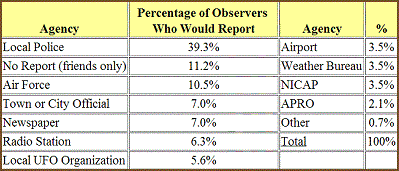 |
First of all, unless the ET is buzzing houses or cars with his spacecraft, has a grossly nonhuman appearance, or is wreaking destruction far and wide, his presence actually may go unnoticed for quite some time.
- But eventually a passing motorist or pedestrian will spot the creature, who perhaps is garbed in a spacesuit or other unconventional attire. The local police station will receive a report of a strange creature roaming the streets. (See Table 26.2.)
- Since local authorities get mountains, of crank calls, they probably won’t bother to dispatch a patrol unit until several reports have been received or until the ET inadvertently maims someone. As one policeman observer recently noted: "We're trying to downplay these sightings as they come in."3690
- The police cruiser will arrive at the scene shortly thereafter. Depending upon the alienness of the extraterrestrial, the officers may suspect a prankster at first (as has happened on numerous occasions1347,695) until the creature either reveals its primary physiological differences or displays command of clearly superior technology.
| Large crowds |
If a large crowd has gathered, the ET may be in trouble.3565 |
- There are cases on record of crowds mobbing and killing human pranksters acting the role of beings from space, and it is also true that the people have sometimes been ordered to shoot at UFOs by their superiors.3250
- Hopefully, if the ET does nothing which might arouse strong xenophobic reactions among human beings, the officers will content themselves with cordoning off the immediate area (to prevent public contact) and in sending for local reinforcements which should arrive in ten minutes or less. The county sheriff will also be notified, as well as the State Patrol or Highway Patrol. These groups will dutifully respond within twenty minutes, but will make no further decisions.
| Civil Defense alerted |
The police will also quickly alert the local Civil Defense authorities. |
- From there, the buck passes swiftly up through the county Civil Defense office to the state Civil Defense office, at which point the governor should be apprised of the situation. He has the authority to declare a state of emergency or invasion and call out the National Guard (state militia) to help out.
- The militia maintains local bases equipped with jeeps, tanks and cannons, should these be required. The Guard (e.g., about 25,000 soldiers in California) probably be mobilized and on the scene in less than an hour to assist in the apprehension and detention of the extraterrestrial, and in crowd and riot control.
- In the meantime, the governor or some other state official will have notified the Federal Department of Defense, and, of course, the President.
| Army Area Commander in charge |
According to existing regulations, the Secretary of Defense should place the Army Area Commander in immediate charge of maintaining order.
- The local Air Force and Naval District authorities probably will also enter the picture in specific and relevant areas, but with clearly subordinate influence.
- For instance, special Air Force investigatory teams may be called in to actually handle physical and intellectual contact with the ET, because of their prior experience in dealing with UFO reports and the like.
- Pending direct Presidential orders to the contrary, however, the Army commander will remain in overall temporary control.
| Sweeping Presidential authority |
The President will undoubtedly notify Congress immediately, calling an emergency session to obtain specific legislative direction. But it is important to realize that, on his own, the President already possesses sweeping authority — especially in times of crisis — should he care to exercise it.
- A vigorous "expansionist" Chief Executive would be likely to assume far greater personal control than a more passive, wait-and-see President.
- The personality and mode of leadership of the person in the White House may therefore be a decisive factor in the early stages of Surprise Contact.
| National State of Emergency |
Until late 1978, the United States was in a legal state of national emergency and had been continuously since the early 1930s. This fact is not generally known or appreciated by the public. The Presidential proclamations of national emergency issued under Roosevelt (1933), Truman (1950), and Nixon (1970, 1971) were not terminated when the crises that spawned them had passed.
- In 1976, President Ford abolished these four emergency powers acts, effective September 1978. The powers returned to Congress; however, the power to declare future emergencies remains with the President.
So broad authority is available to dispose of the ET as the Chief Executive sees fit. Perhaps, in the context of first contact, another declaration of national emergency would be forthcoming at this point. But even if the President does assert full and immediate control, considerable confusion will still result.
In the typical Surprise Contact scenario, all of the problems connected with "less surprising" contacts are compounded by the need for a quick and effective response by national authorities and by the hasty and imprudent actions which may be taken as a result.
- Top policymakers will be inundated with conflicting intelligence reports, and the channels of local and global communication will be clogged for a variety of reasons.3552
- Decisions will be made on the basis of incomplete, inaccurate, strongly biased, or otherwise inadequate information, increasing the likelihood of error.3553
- The sheer magnitude of the logistics of crowd and riot control, the rapid spread of terrifying rumors throughout the civilian population and rising incidence of hysteria, and the recognized biological dangers of radiation and contamination of Earth by unknown alien microbes will add to the confusion.
| Federal Alphabet agencies |
Federal agencies will jockey for jurisdiction, based on intertwining statutes and overlapping authority that would put a Gordian knot to shame.
- The CIA and FBI, suspicious of the possibility of a foreign hoax and the dangers to national security posed thereby, may try to intervene at the holding area and assert some influence of their own.
- Even more important, they will be trying to protect the ET — a potentially valuable military resource — from foreign agents, saboteurs, kidnappers, and assassins who presumably would stop at nothing to get their hands on the extraterrestrial visitor.
- (The entire American defense establishment will be on full alert status by this time.)
- The Treasury Department, also suspecting a hoax and fearing for the President’s life, may try to get into the act by sending in Secret Service agents to verify the authenticity of the ET.
- Of course, Army Intelligence, Naval Intelligence, Air Force Intelligence, and the Defense Intelligence Agency will all be vying for power as well.
- The Public Health Service, within the Department of Health, Education and Welfare (HEW), will want to establish local quarantine and detention authority under 42 USC §264 et seq of the Federal Code.
- The Department of Agriculture may try a similar trick under 21 USC §101 et seq, if they can successfully argue that the extraterrestrial is an "animal" and not a "person" (see discussion below, in section on legal issues).
- The Environmental Protection Agency could try to classify the creature as an "endangered species".
- The Attorney General, acting under 8 U.S.C. §1222, has the legal authority to order immigrations officers to "temporarily detain" the ET in contemplation of deportation proceedings.
- And, naturally, the Department of Transporation will be anxiously searching for the space traveler’s vehicle as may the Secretary of the Treasury (50 U.S.C. §191 et seq), the military and the various intelligence agencies.
- (NASA people may be called in as consultants or for technical assistance, but the NASA Administrator has no basis for authority unless the alien comes to Earth aboard one of our spacecraft.*691,3549)
| Private and civilian organizations |
A host of private and civilian organizations will clamor to be heard, probably within hours of first contact.
|
|
|
And countless other animal protection groups will demand assurances that the ET is receiving:
|
|
|
|
||
(As required by the "Animal Welfare Act" [7 U.S.C. §2131 et seq, as amended to include any warm-blooded animal used for "laboratory purposes"] and state animal cruelty laws.)
The National Science Foundation will probably have some complaints to make, along with:
|
|
|
|
||
Sooner or later, the United Nations will get wind of the "capture".
- Although the U.N. has no real authority within domestic borders, vehemently unfavorable world public opinion could easily be roused to a fever pitch.
* See 14 C.F.R. §1204.509 and §1211.100 et seq, entitled "Extraterrestrial Exposure"
** The Women's Christian Temperance Union (WCTU) and representatives from vegetarian groups may clamor for assurances that the ETs neither imbibe intoxicants nor consume animal flesh.
| No clear and unambiguous legal directions |
We see that federal law provides no clear and unambiguous legal directions for handling a Surprise Contact from the stars.
- Without the leadership of a strong President, tremendous confusion and jurisdictional squabbles will erupt almost instantly.
- The potential for disastrous disorganization is high.1761
- And we have assumed a rather passive, obeisant extraterrestrial. If he is in any sense more active, there could be fearful and unfortunate complications.
| Pentagon contingency plan |
It is said that all war departments have plans worked out for every conceivable eventuality. Presumably, somewhere in the Pentagon are the orders for such lamentable necessities as the invasion of Mexico or the bombing of London.
- Indeed, in November 1975 some 50-year old plans for the invasion of Canada were declassified (because they had become obsolete).
- If there are any preparations for the defense of Earth no one has ever mentioned them.
- Still, the author suspects a contingency plan lies dusty in some half-forgotten Pentagon file.
- But one way or another, at last the creature will be safely in military custody, under very heavy guard and probably under quarantine. What next?
One question xenologists might want to address is whether the political and military authorities would attempt to hush things up and conduct a totally secret investigation of the alien being and his craft, even in the face of widespread publicity surrounding the initial contact event.
| NORAD Commander’s log |
For example, from the NORAD Regional Commander’s log (24th region, Montana) in 1975: |
| 7 Nov. | Received a call from the 341st SAC CP saying that the following missile locations reported seeing a large red to orange to yellow object. … | |
| 7 Nov. | SAC advised that the LCF at Harlowton, Mont., observed an object which emitted a light which illuminated the site driveway. | |
| 7 Nov. | L-l reports that the object to their northeast seems to be issuing a black object from it, tubular in shape. | |
| 8 Nov. | A security camper team at K-4 reported UFOs with white lights, one red light 50 yards behind white light. Personnel at K-l seeing same object. | |
| 8 Nov. | L-5 reported object increased in speed—high velocity, raised in altitude and now cannot tell the object from the stars. | |
| 9 Nov. | SAC CP reports UFO 20 miles southeast of Lewistown {Mont.} orange white disc object. | |
| 10 Nov. | UFO sighting reported by Minot Air Force station, a bright starlike object in the west, moving east, about the size of a car. The object passed over the radar station, 1000 feet to 2000 feet high, no noise heard. | |
| 12 Nov. | UFO reported from K0l. They say the object is over Big Snowy {mountain} with a red light on it at high altitude. | |
| 12 Nov. | Second UFO in same area reported. Appeared to be sending a beam of light to the ground intermittently. | |
| 19 Nov. | SAC command post observed object traveling NE at a fast rate of speed. Object bright white light seen 45 to 50 seconds following terrain 200 feet off ground. The light was two or three times brighter than landing lights on a jet.3548 |
| Justified in telling lies |
Even assuming all of the above are simply sightings of weather balloons and other everyday objects, it must be admitted that these secret reports strongly suggest that the government may try to keep from public view any object or event that the military does not fully comprehend.3602 As Mr. Arthur Sylvester, Assistant Secretary of Defense for Public Affairs, admitted at a press conference in New York on 7 December 1962:
When a nation’s security is threatened, as that of the United States was during the recent Cuban crisis, the nation’s leaders are justified in telling lies to its people.757
But adopting a course of secrecy after a well-publicized encounter may be highly dangerous. Strategic and international political issues are brought most clearly into focus in the Surprise Contact scenario.
- From the point of view of the host nation, the ET represents a possibly valuable military resource.
- But from the vantage of others, the mere presence of the alien, his knowledge and his hardware in a neighboring (unfriendly) country constitutes a serious military threat.
- A landing in the territory of either of the two major superpowers may cause strategic destablization and raise the specter of a preemptive nuclear counterforce/countervalue strike.
- The concepts of anticipatory defense and anticipatory retaliation are not new and might be used to justify wanton military aggression.
| Extraterrestrial investigation internationalized |
Unless the investigation of the extraterrestrial is "internationalized," world tensions may increase dramatically.
- The Russian, Chinese, and others’ intelligence agencies might stop at nothing to retrieve the alien from the U.S. in order to interrogate him for military secrets and other technologies that might provide some advantage.
- If the tables were turned, the American government might well engage in similar sordid practices.
| Torture and dissection |
What if military authorities order government scientists to perform brutal experiments on the ET, perhaps torturing it to force it to divulge its secrets, or to dissect it to gain physiological knowledge to enable us to design effective weapons? Would they do it? According to the now-classic work of Stanley Milgram, the answer may be a horrifying "yes."
| Tests of conscience |
In studies that ultimately included more than a thousand participants, Milgram demonstrated that obedience to authority is basic to human nature. In the experiment, a person comes to a psychological laboratory and is told to carry out a series of acts that come increasingly into conflict with conscience.
- Typically, the subject is required to test the ability of a "learner" (one of Milgram’s confederates) to recall word pairs; wrong answers are punished by the application of increasingly "higher voltages" to the "learner" by the subject using an "electrical generator."
- Although no shock is actually applied, the subject is made to think it is real by the convincing grunts, protests, and screams of the "learner."
- Milgram found that most people will continue to apply shocks, even though they know they are inflicting pain, at the behest of the experimenter, and many will continue until, the "learner" apparently is rendered unconscious with pain.745
- This does not leave the author very hopeful about the possible treatment of extraterrestrial visitors having "military value."
| Ominous significance of findings |
Milgram comments upon the ominous significance of his findings: |
The behavior revealed in the experiments is normal human behavior: the capacity for man to abandon his humanity, indeed, the inevitability that he does so, as he merges his unique personality into larger institutional structures. … Each individual possesses a conscience which to a greater or lesser degree serves to restrain the unimpeded flow of impulses destructive to others. But when he merges his person into an organizational structure, a new creature replaces autonomous man, unhindered by the limitations of individual morality, freed of humane inhibition, mindful only of the sanctions of authority.
The results, as seen and felt in the laboratory, are to this author disturbing. They raise the possibility that human nature, or more specifically the kind of character produced in American democratic society, cannot be counted on to insulate its citizens from brutality and inhumane treatment at the direction of malevolent authority. A substantial proportion of people do what they are told to do, irrespective of the content of the act and without limitations of conscience, so long as they perceive that the command comes from a legitimate authority. If, in this study, an anonymous experimenter could successfully command adults to subdue a 50-year-old man and force on him painful electric shocks against his protests, one can only wonder what government, with its vastly greater authority and prestige, can command of its citizenry.744
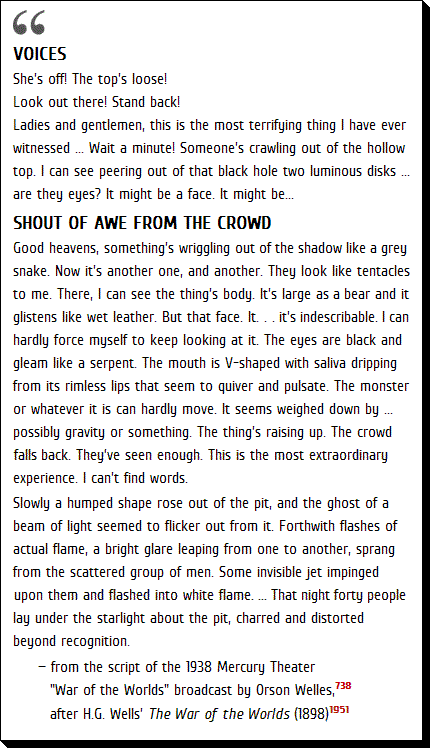 |
There are many reasons why confirmation of the existence of extraterrestrial intelligence may bring a more muted public response than might otherwise be expected.
- To some extent, a great deal of cultural preconditioning has already taken place.1938
- Science fiction and other speculative literature have already introduced people to the possibility, and the success of the television series "The Invaders" a decade ago and the recent box office hit "Close Encounters of the Third Kind" are testimony to considerable popular interest in and acceptance of the notion of alien life.
- Reports of UFOs and radiotelescope listening projects conducted by SETI investigators also have been much in the news.
| Decades or centuries between receipt and response |
In the case of a Remote Contact an alien message may take months or even years to verify, let alone translate and comprehend.
- The necessary compactness and complexity of such communications will require much time and effort to unravel, resulting in a slow trickle, rather than a raging torrent, of information about the aliens and their culture.
- Since radio signals between distant stars must creep along at the speed of light, decades or centuries may pass between receipt and response to an extraterrestrial transmission.
- This considerable time lag after the initial discovery is apt to dampen public and media enthusiasm for the story.
| Press will shape public reaction |
In a Direct Contact scenario the press will play a more critical role in shaping public reaction to the encounter event.
- The accuracy and tone of the initial media coverage during the first few days and weeks will direct and fix public perceptions and attitudes towards the ETs for years to come.
- The possibility of "yellow journalism" cannot be ruled out. Traditionally the news media lose interest in any story that fails to build, to provide new and ever more exciting details leading to a conclusion or climax.695
| Fake stories |
The attention span of the general public is quite brief. At least one science fiction writer has suggested that, in the face of a dearth of sensational newsworthy events, newsmen might fake their own headlline-grabbing stories:
The Des Moines stereocasting station sent mobile units in for spotcast. The pictures they sent out were all long shots, taken from the air. They showed nothing but a disk-shaped object [on the ground]. Then, for about two hours, no pictures and no news, followed later by close-ups and a new news slant: The thing was a hoax. The "spaceship" was a sheet-metal-and-plastic fraud, built by two farmboys in the woods near their home. The fake reports originated with an announcer who had put the boys up to it to make a story. He has been fired.2640
| Cautiously sanguine |
Science editor and reporter Kendrick Frazier, however, remains cautiously sanguine: |
My hope is that from the very beginning there would be accurate and restrained news reports, complete with all the facts available at the moment and including the comments, insights, and perspectives of all the scientists and other persons informed and knowledgeable on the subject.1938
| Full, immediate and accurate disclosure |
The strong desire among scientists and journalists for full, immediate and accurate disclosure must be balanced against the requirements of military security and the current global political climate.
- There may be valid reasons for holding back certain inflammatory or unverified information from public scrutiny, on a temporary basis.
- The immediate hazards of contact may be seriously aggravated if the Direct Contact occurs in a country having "no tradition of openness and candor in the release of news information."
- While it might be difficult to keep secret for long the fact of contact, details could easily be suppressed.
- Unfortunately any brief, distorted, or incomplete report, followed by a moratorium on further information, could lead to mistaken ideas, wild rumors, international outrage, mass hysteria, and serious political misunderstandings.
| Dog in the manger |
Frazier has pointed out that even if reasonably full disclosure is obtained from a nation without a tradition of a free press, Western scientists might still experience great difficulties securing enough data about the event to make a reasoned analysis of the situation. There may be a kind of "dog in the manger" reaction:
Already there have been a few claims coming out of the Soviet Union of receipt of radio signals that were initially attributed to extraterrestrial intelligence. (They turned out not to be.) The difficulty that both the science press and scientists in the United States faced in getting further information from the Soviet Union in the days immediately following the initial news reports has not made me especially confident.1938
| Only get one shot |
How should the news be released to the public? Jill Tarter of the NASA SETI Program team at Ames Research Center has revealed that many scientists have spent some time considering this very question. "Assuming the people who are involved in this field," she says, "we have this cocktail party game that we play: Compose your press release, knowing that you'll probably only get one shot at it. How do you get out all the information you want to, and be sure that it will get a lot of coverage? It is a touchy subject." Kendrick Frazier has the following suggestion:
Wherever the discovery of the first evidence of extraterrestrial intelligence is made, I do hope that the scientific leaders involved will be wise enough to prepare their public announcement with a certain amount of care and with careful attention to the need to supply accurate information and perspective. This would justify a delay of several days to make preparations. In the United States a joint news conference in Washington, with scientists and officers of the discovering observatory, the National Science Foundation, the National Academy of Sciences, and the White House, would perhaps be the preferable method of announcing the discovery. The international scientific community would be brought into the matter as rapidly as possible.1938
Still, when the time comes to announce that mankind is no longer alone, "those who prepare and issue the statement will have a truly terrifying responsibility." Says Arthur C. Clarke: "Though they will certainly try to sound reassuring, they will know that they are whistling in the dark."81
|
Rumor construction is likely to occur
if the demand for news in a public exceeds the supply made available through institutional channels. |
Sociologist Tamotsu Shibutani of the University of California at Santa Barbara has remarked that in disasters one of the first things men seek, after saving themselves, is news. Often they become so desperate for such information that they become careless about its source. If sufficient news is not available, it may develop spontaneously.1875
| Three elements present for spontaneous news |
In a Surprise Contact scenario, and to a lesser degree in Direct Contact situations, the likelihood of such "spontaneous news" is high. Studies in the psychology of rumor by the late Gordon W. Allport and Leo Postman at Harvard University during the 1940s showed that scare stories travel fastest and persist the longest when three critical elements are present:
- Lack of News — rumor flies in the absence of reliable and authoritative news reportage;
- Personal Impact — the theme of the rumor must have some significance both to speaker and listener in a highly personal and private sense;
- Ambiguity — the true facts must be shrouded in some real or imagined ambiguity.741
| Lack of News |
Each of these elements should be present during a typical Surprise Contact. Simply because of the unusual nature of the event and the natural confusion which would result, news would be temporarily unavailable during the first few hours or days following the event. A deliberate governmental policy of suppression of the facts would only prolong the dearth of information.
| Personal Impact |
As for personal impact, the event would be of maximum significance in the immediate locality of the contact. Modern telecommunications networks, which have created a "global village," would have the effect of spreading impact over greater geographical areas, statewide and perhaps nationally. Impact will also be heightened if there are reports of sudden confrontations with other unannounced ETs. The normal background of UFO reports may be blown out of proportion, and wild rumors of new landings and hostile activities by (nonexistent) alien visitors could begin to circulate elsewhere in the host country and in neighboring nations as well.
| Ambiguity |
Finally, ambiguity may be induced by the absence or sketchiness of news, by the conflicting nature of the news, by distrust of the news (as where it is perceived that the government is deliberately hiding something), or by some emotional tensions that make the individual unable or unwilling to accept the facts set forth in the news.741 Since it is clear that all news of the Contact must necessarily remain ambiguous at first, we must conclude that highly compelling and disturbing rumors could spread like wildfire through urban population centers around the world.
| Influence of the media |
One rather unusual psychological experiment reported by Philip Klass in his book UFOs Explained695 illustrates well the influence of the media on public perception of events. On 13 April 1971, John Forkenbrock and several of his sociology students at the West Central high school in Maynard, Iowa decided to test local public and media reaction to a UFO sighting. That night students, after making arrangements with a farmer, poured gasoline in a circle in his pasture and set it afire to form a three-meter-diameter circle and four smaller "landing pad" circles.
- Other students, not party to the hoax, became aware of the sighting the next morning and, thinking it real, called the local radio station KOEL.
- Soon, news of the event was being broadcast, reporters were interviewing students, and a local UFO expert showed up within the hour.
- In 24 hours, news of the UFO landing had been carried by radio stations in Chicago and Minneapolis and by a number of Iowa newspapers, and NICAP Headquarters in Washington had called to investigate.
| Underneath the bed |
Later, when the hoax was revealed, the participants were interviewed to determine their reactions to the event. Some had accepted the reports at face value and concluded that an alien craft had indeed landed in the field outside the town. Others said they suspected a secret military vehicle might have been involved, or that the burned circles might have been caused by a meteor or a Russian satellite. Only a few had suspected a hoax from the first.
- One student remarked: "I didn’t believe it at first, but I came to school and heard my friends talking and I began to believe it."
- Another said: "I believed it and was even fooled into going over and seeing it [burned spots]. The main reason it was so convincing was hearing it on the radio and seeing it on television."
- Said one of the students who had called KOEL: "On the way back to school, after we had called KOEL and told them the whole story, all I could think about was telling more kids about it. Later on I told everybody I could see."
- Among some local residents the incident provoked fear. One woman reported: "My husband came home from work and loaded his gun and put it on the shelf, so I knew he was scared. … I was scared too." Another resident admitted: "I hadn’t locked the door for twenty-five years; but when I heard that, I ran to my door, locked it, and ran underneath the bed and stayed there until I heard it was a hoax."
| Commitment to prior belief |
How might people react psychologically to the fact of Contact? In a 1973 study of this question led by social psychologist Leon Festinger, Dr. Elliot Aronson of the University of Texas concluded that a person’s reaction to disclosure that the Air Force had been secretly studying a humanoid ET (who remained behind after a surprise encounter at an Air Force Base several years before) would depend to a very large degree upon prior belief and the degree of commitment to that belief. Aronson believes that there may arise two major classes of response to the announcement. To make the analysis more clear, he selects the most extreme viewpoints: Sam, a person who is committed to the belief that there is life in outer space and the UFOs are a real phenomenon; and Mildred, someone who disdains the reality of UFOs and prior to the announcement was that there is no intelligent life elsewhere in space.
Aronson continues:
When the press conference was held breaking the news of the humanoid’s existence, Sam’s immediate reaction was intense and unmitigated joy. After all, his belief was confirmed. His commitment was exonerated. But after an initial hurrah, his dominant and persistent response was calm acceptance. He was convinced for years that human life existed in outer space and it is certainly not surprising to learn that the government now has absolute proof of that existence — proof in the form of this person whom they have been interviewing for the past four years or so. They have been in direct contact with this person for four years and no disaster has struck and, accordingly, it is highly unlikely that any disaster would occur in the foreseeable future.
It should be emphasized that Sam’s calm acceptance of the news that human life from another planet does definitely exist is in part Sam’s way of demonstrating his confidence in his prior beliefs. That is, the calmer he can react in public and the. more accepting he is of the event without outward show of intense emotion, the more convincing he will be to himself and to other people. Thus, when Sam arrives at the office and his colleagues ask him if he’s heard the news, he simply shrugs and says, "It was simply a matter of time — I knew it would happen sooner or later."1640
Mildred’s reaction, on the other hand, is extremely different:
When she sees the press conference and views the humanoid she immediately suspects that the government is lying. Because of the fact that she has committed herself to the belief that UFOs are a farce and do not exist and to the belief that there is no intelligent life in outer space, anything that implies she is wrong must be derogated and disposed of.3570 Thus, Mildred immediately assumes that the government has something to gain by implying or demonstrating that they do indeed have a humanoid from outer space. ("Perhaps Nixon is trying to divert attention from Watergate or the energy crisis.") Thus, in almost a paranoid manner she convinces herself that it is a sham, that the so-called humanoid is an actor playing an elaborate role, hoodwinking the gullible. If she can succeed in doing this, then she can succeed in maintaining her high self-concept and in not losing the running argument she’s been having with Sam (and others) over the past several years.
Now in order to do this, she has to go to great lengths to convince herself and others that the government has something to gain by doing this and that the government is dishonest and clever. Moreover, because her belief has been apparently disconfirmed, she will seek social support for the continuation of that belief. Thus, she will frantically run around to try to convince other people that there is no life in outer space, that the so-called humanoid is a fake.1640
| Cognitive dissonance |
Aronson’s reasoning stems largely from Leon Festinger’s theory of cognitive dissonance.3569 |
- According to this theory, if an event occurs which is consistent with beliefs to which a person is committed, then that individual is pleased, happy, calm, relaxed, and generally unmotivated by the event.
- On the other hand, when events occur that are dissonant with the person’s beliefs and commitments, that individual strives to reduce the dissonance.
According to Aronson:
One way to reduce the dissonance is to deny the fact that those events have actually occurred, and in order to deny that fact, one has to construct an apparently reasonable explanation for the events that is consistent with the primary belief. Moreover, since a state of dissonance is an unstable and psychologically uncomfortable situation, one really needs to bolster that explanation for the events and to strengthen one’s initial belief, in this case, the belief that there is no life in outer space. The more you can convince other people that you are right — in this case, the more you can convince other people that there is a government plot — the greater will be the reduction of dissonance and the more comfortable you will become.1640
| Public commitment |
In the same study in which Dr. Aronson participated, a prominent Yale University psychologist (who wished to remain anonymous) concluded that many respected scientists, statesmen, journalists and educators who had not been asked to be present to witness the encounter or subsequent investigations might regard the entire incident purely as a hoax:
The initial skepticism and outright disbelief publicly expressed by many eminent scientific authorities as well as by other prestigious leaders of the national community who were not insiders will have a marked effect on the reactions of the U.S. public. … The announcement will also get a very bad press from leading scientists and politicians in the Soviet Union and in other countries where the U.S. government, and especially. the U.S. military establishment, is not trusted.
In the absence of any clear-cut demonstration that would be utterly convincing to the majority of scientists, outside the little circle of the Air Force Base, the authenticity of [the encounter] will continue to influence the public’s views and actions, even if supposedly convincing evidence is continuously being presented on later TV shows and in documentary movies by the Air Force and its scientists (and by other scientists invited to join the prestigious university lab to which the [alien] visitors have been transferred to counteract charges of an Air Force plot). Many of the scientists who initially attacked the credibility of the original TV show will have publicly committed themselves. And public commitment is a great source of resistance to persuasive communications that might otherwise change a person’s mind. It leads the person to reduce dissonance or conflict by bolstering his original position with new arguments. [See Deutsch, Krauss, and Rosenau,3572 Festinger3573 Gerad, Belvans, and Malcolm,3574 Kiesler,3663 and McGuire.3634] So the public will continue to be treated to a wide variety of impressive negativistic comments during the months following the TV show, which will make for considerable ambiguity.1640
| Demand for news exceeds the supply |
But in a Surprise Contact scenario in which the actual landing receives widespread publicity, news is likely to be in short supply. People will turn first to institutional channels; but there, reporters and the public alike may find only frustration.
- Rumor, a form of news, arises in situations of tension when ordinary communication channels are operating inadequately.
- As Shibutani has pointed out: "Rumor construction is likely to occur if the demand for news in a public exceeds the supply made available through institutional channels."1875
- Typical rumors might include stories of strange diseases going around or reports that mysterious signals had been detected from a supposed "invasion fleet" hovering just out of radar detection range.
- Unusual but natural disasters may be blamed on the aliens' arrival.
| Poisoning effect |
How should rumors be dealt with? Censorship has often been attempted in the past, but this only serves to aggravate the problem when the public becomes aware of it. It is widely agreed that known or suspected censorship increases the incidence of rumors.
- Denials of widely-believed reports or the overt punishment of free speech makes official channels suspect.
- A feeling may develop that officials are trying to hide something, even when they aren't, and often what is suspected of being hidden is far more sinister than the facts.
- There is also a kind of poisoning effect: once censorship is suspected, other items from official sources are also distrusted. Rumors develop even when all known facts have been disclosed. Once official channels are regarded as unreliable, people are no longer reassured by denials and many rumors may develop.1875
| Rumors and panics helped by ignorance |
Reflecting on the explosion of UFO reports during the last two decades and the widespread and persistent rumor that the government is withholding the "true facts," the late Dr. Edward U. Condon, noted physicist, director of a major study of UFOs completed in 1969, and arch UFO-skeptic, once lamented: "Developments of this kind leave no doubt in my mind that a serious mistake was made in early 1953 in not declassifying the entire subject and making a full presentation of what was known."741 In similar vein, the late Dr. Carl Gustavus Jung, the eminent Swiss psychoanalyst, offered the following advice:
If it is true that the American Air Force or the government withholds telling facts, then one can only say that this is the most unpsychological and stupid policy one could invent. Nothing helps rumors and panics more than ignorance. It is self-evident that the public ought to be told the truth.1623
| Surprise launching of Sputnik |
A fine example of free and orderly dissemination of potentially explosive information was provided in 1957 by the Smithsonian Astrophysical Observatory after the surprise launching of Sputnik by the Soviets.
- Smithsonian scientists quickly decided to tell the public all that was known.
- They set up an information center where regular news conferences were held and all data were available, an openhanded approach that helped to dispel much of the fear the surprise launching invariably aroused.3608
- Virtually all psychologists who have investigated rumor seriously have recommended providing adequate information through traditional institutional channels.
| Rumor clinic |
Another useful procedure which might be operated in parallel is the concept of the "rumor clinic." |
- Although most such means have heretofore only been applied in wartime situations, the same technique might prove useful during a Direct or Surprise Contact encounter.
- During World War II, for instance, the Massachusetts Committee on Public Safety dedicated itself to the prevention and control of rumors through publicity.
- Reported rumors were collected at various listening posts, refuted by authorities or experts, and then published in a large newspaper chain.
- Reprints of these articles were then sent to interested parties elsewhere in the country.741
- A more contemporary example was the Rumor Control Center established by Governor Thornburgh during the Three Mile Island nuclear power plant disaster in Harrisburg, Pennsylvania in 1979. The Center provided a phone number that anyone could call to get updated reliable facts.3717
| Tool of special interests |
Of course, there is always the danger that such organizations may come to be perceived as the mere tool of special interests — big business, the military, a political party, the government — unless it is scrupulously honest and objective in its dealings with the public. News thought to be of interest to or screened by those in control is often dismissed as propaganda; when institutional channels are discredited, the supply of reliable news is cut off and unreliable rumors begin to fly.
| Two‑step" model of public communication |
Yet another technique is based on the "two-step" model of public communication.3554 In this model, "opinion leaders" act as mediators between the mass media and the "rank and file."
- That is, information flows from television, radio, and the printed page to opinion leaders and from them to the rest of the community.
- This same principle may be applied in the context of news dissemination during a Contact event. The best way to affect public attitudes towards the ETs might be a mass mailing of calming and informative data to community opinion leaders, both in politics (e.g., mayors, city managers, etc.) and various professional people (e.g., doctors, representatives, bankers, authors).
- As an additional measure, representatives from all major special interest groups should be invited to Washington for a full and complete briefing.
|
None of the primary or contributory factors to mass The hallmarks of such an encounter, and its (Indeed, the less exciting it is, the higher is the |
A televised news conference with the ETs following a Direct Contact encounter would be the media event of the century.
- Xenologists believe that a large majority of Americans will display "news hunger," many remaining glued to the TV set for word of the latest developments.
- The credibility controversy will deepen this hunger and even those who suspect a hoax will be following events closely in an attempt to determine who is trying to fool whom.
- As tension heightens and ambiguity remains high, rumors will begin to fly concerning the nature of the aliens' visit, their intentions, their possible economic, philosophical and religious beliefs, and even their sexual practices.
| Behavioral consequence will be absenteeism |
According to the Yale social psychologist who participated in the 1973 study mentioned earlier:
The main behavioral consequence of all information-seeking and misinformation spreading will be absenteeism. While few workers and clerks will stay home during the day to watch TV, many of them will engage in mental absenteeism in the factory or office. Large numbers of people will be too busy talking to each other about the news, listening to transistor radios, and reading newspapers to do more than a small fraction of their normal daily work. How long this will last will depend partly on how long the story is kept alive by the mass media and partly on how long the major ambiguities persist. If the whole thing is promptly exposed as a hoax and the perpetrators are identified and their intent made clear, public interest will die. Or if the supply of fresh news quickly becomes exhausted, public interest will soon subside — as in the case of the moon shots in the late 1960s. But otherwise for quite some time after the upcoming TV show, interest in [the ETs] will upstage the impeachment proceedings in the House and the trial in the Senate. Even Nixon’s resignation speech on the eve of the Senate vote will receive less attention.1640
| Key factors identified with mass panic |
It has often been suggested that the arrival of visitors from other worlds, or even the admission that they had already arrived, would give rise to widespread unreasoning panic. But studies of public reactions to wars, disasters, epidemics, and other similarly frightening events indicate that such will not normally be the case. Mass panic rarely occurs except under certain very usual circumstances.3642,3575 A number of key factors have been identified which, when present in a single event, may give rise to the most virulent forms of mass panic:
- People are suddenly made aware of clear and present danger of overwhelming magnitude — personal, physical danger — that is rapidly approaching;
- People perceive that all possible escape routes soon will be closed, leaving them trapped with the danger within a very short time (as in a crowded theater or nightclub on fire);
- There is a lack of opportunity to engage in vigorous self-protective action under extreme conditions of potential entrapment;
- People experience a loss or lack of contact with members of the family or with other primary socially supportive groups;
- Ambiguity exists as to the extent and precise character of the danger; and
- There is a lack of reassuring communications from esteemed persons or responsible authorities.
According to the Yale psychologist:
It should be noted that panic is not a likely response to verbal warnings that are ambiguous with regard to authenticity or that create uncertainty as to whether there might be severe, mild, or no danger at all in the offing. The disaster literature indicates that ambiguous warning messages are likely to be discounted and ignored by all except a small percentage of people, mainly hyperanxious neurotic persons.1640
| Aimless zombies |
Another misconception that is current in the popular press is that people are likely to wander about aimlessly like zombies on the heels of a major disaster. While it is true that stunned, dazed, near-psychotic withdrawal has been observed at the scene of catastrophes, studies show that this is the exception rather than the rule.
- Indeed, most victims of large-scale disasters expect their neighbors to panic or to become zombie-like, and are genuinely surprised when they do not.3603
- Usually it is only those who have been severely traumatized (e.g., serious personal injury, injury or death to close family member) that suffer the most extreme forms of psychological disorientation.
| Hallmarks of any reasonable Direct Contact |
None of the primary or contributory factors to mass panic or stunned psychotic behavior should be present in any reasonable Direct Contact scenario. The hallmarks of such an encounter, and its subsequent disclosure to the general public, will be: safety, certainty, and control. (Indeed, the less exciting it is, the higher is the ethical content of the encounter, according to the rules of thermoethics.) Even in a typical Surprise Contact any minor panics which did erupt would be confined to the locality in which the clear and present danger to physical survival existed.1876
- Of course, widespread panic is possible if the extraterrestrials come not as friends or neutrals but as enemies of humankind.
- The immediate threat to personal safety might be deeply etched into the minds of every person on Earth if the ETs performed some spectacularly destructive act — such as blowing up the Moon — to demonstrate conclusively the invincibility of their weaponry.
- This, followed by a general announcement that specific metropolitan areas around the world would suffer similar treatment if certain demands were not met, could give rise to hysteria, mass panic and deep psychoses in the designated areas.
- Within the doomed areas, notes one commentator, wild panic might become widespread "unless extraordinarily skillful leaders took command of the situation, giving impressive reassurances, organizing the evacuation, and mobilizing other protective actions."*
| Mercury Theater invasion-from-Mars |
Indeed, such a scenario has already been rehearsed once in some detail — Orson Welles' Mercury Theater invasion-from-Mars broadcast, which took place on Halloween night, 30 October 1938. The incident is of great xenological and historical interest, and is worth discussing in some detail.
- Drawing from the 1898 novel by H.G. Wells of the same name,1951 Mr. Welles opened his "War of the Worlds" with a harmless weather report.
- The announcer stated that the program would continue from a hotel, with dance music. For a few moments a dance program was heard, but soon there was a break-in with a "news flash" about a professor at an observatory who had seen explosions on the surface of Mars.
- Then the music came back for about half a minute, interrupted again by another news the landing of a "meteor" near Princeton, New Jersey. On-the-spot reporters at the scene of the fall noted that the object was a strange metallic cylinder.
- All of a sudden, the lid unscrewed and out popped Martians with death rays, killing 1500 persons including military personnel, members of the press, and innocent bystanders.
- As the story slowly unraveled, more martian warships began to land all over the United States; people were dropping like flies before an alien assault force armed with deadly gas; Martians were reported entering New York; and so forth.
| Praying, crying, fleeing |
- Long before the fictional broadcast had ended, people across the nation were "praying, crying, fleeing frantically to escape death from the Martians."
- Some ran to rescue loved ones; others telephoned farewells or warnings, hurriedly informed neighbors, sought information from newspapers and the radio, and summoned ambulances and the police.
- In Indianapolis a woman ran into a church screaming: "New York destroyed; it’s the end of the world. You might as well go home to die. I heard it on the radio." Services were dismissed immediately.
- In North Carolina, five Brevard College students fainted and others fought for telephones to call their parents to come and get them.
- One telephone caller in Kansas City said he had loaded all his children into his car, filled it with gas, and was going somewhere. "Where it is safe?" he wanted to know.
- A farmer near Grover’s Mill, New Jersey, took pot shots at a neighbor’s water tower, thinking it was an invading Martian war machine.
- A Pittsburgh man returned home in the midst of the broadcast to find his wife with a bottle of poison in her hand, screaming: "I'd rather die this way than like that."1756
| Invasion broadcast study |
According to Princeton social psychologist Hadley Cantril, who studied the Martian invasion broadcast in some detail, at least 6 million people heard the show, 1.7 million thought the broadcast was a valid news bulletin, and about 1.2 million were "excited" by it.738
- According to Cantril, the unusual realism of the performance may be attributed to the fact that the early parts of the broadcast "fell within the existing standards of judgement of the listeners."
- Radio had become an accepted vehicle for important announcements, and polls indicated that three times more people thought radio was freer from prejudicial reportage than newspapers.
- During the weeks before the broadcast, everyone had been glued to their sets awaiting news of the outbreak of war in Europe, and the "news flash" technique had become the accepted practice to inform the public of fast-breaking news.
- The authorities who supposedly participated in the event were highly respected — military and local Civil Defense commanders, astronomy professors from Princeton and other major universities, the Vice-President of the Red Cross, the U.S. Secretary of the Interior, and so forth.
- Another factor of importance was that specific places were mentioned, lending immediacy to the invasion, and informal colloquialisms and skillful background sounds added in to impart realism.
- Finally, the fact that all observers seemed baffled by events increased the credibility of the reports in the minds of many listeners.
| Trait of susceptibility |
Cantril found that critical rational ability could be overpowered. |
Overpowered either by emotions generated by an unusual listening situation or by an individual's own susceptible personality.
- The trait of susceptibility was more frequent among economically insecure people, persons with phobias, people with less education, and among those having a lack of self-confidence, fatalism, and a high degree of religiosity and church attendance.
- People who thought at first that the broadcast was a regular news report (28.3% of all listeners) could be classified into four major categories, based on their response:
- Those who analysed the internal evidence of the program and knew it could not be true. (6.5% of all listeners)
- Those who checked up successfully with external sources to learn it was a play. (5.1% of all listeners)
- Those who checked up unsuccessfully and continued to believe it was a news broadcast. (7.6% of all listeners)
- Those who made no attempt to check the authenticity of the broadcast. (9.1% of all listeners)
- Cantril also found "that the greater the possibility of checking against a variety of reliable standards of judgement, the less suggestible will a person be." This is an excellent argument for reasonably full disclosure by the appropriate authorities during a genuine event.
| Media learned its lesson |
Clearly the news media must shoulder an enormous burden of public responsibility. A tone of hysteria, sensationalism or "media hype" in reports from the scene of a Direct or Surprise Contact could easily contribute to widespread mass hysteria,1759,1805,1747,740 although instances of classic panic will rarely occur except in certain very unusual situations, Dr. Cantril was confident that the press had learned its lesson:
The Orson Welles performance and its aftermath have instilled on the part of all major networks in the United States a deep sense of responsibility in seeing to it that such a situation does not occur again.738
| Not possible nowadays |
A few writers have taken an even more extreme position than this. |
These writers denying that a repeat of the Mercury Theater "panic" is even possible nowadays. According to Arthur C. Clarke:
The world has become much more sophisticated since the far-off days of Orson Welles’ famous radio broadcast. It is unlikely that a friendly or neutral contact — except in primitive communities, or by creatures of outrageous appearance — would produce an outburst of hysteria like that which afflicted New Jersey in 1938. Thousands of people would probably rush to their cars, but they would be in a hurry to get to the scene of such an historic event, not to escape from it.81
| Incidents of fictional public danger |
Unfortunately there is some evidence to dispute this claim. The Martian invasion broadcast was not the first nor the last reported incident of fictional public danger to give rise to local hysterias. The most similar predecessor to the Mercury Theater incident occurred on 16 January 1926, during a period of particularly strong labor unrest. As Cantril describes it:
On that day the traditionally complacent English listener was startled by a description given by Father Ronald Knox (in the customary news broadcast) of an unruly unemployed mob. The mob was said to have attempted demolition of the Houses of Parliament, its trench mortars had brought Big Ben to the ground, it had hanged the Minister of Traffic to a tramway post. The London broadcast ended with the "destruction" of the BBC's station. After the broadcast, the newspapers, police and radio stations were besieged with calls from frantic citizens. However, Father Knox's broadcast did not cause either as widespread or as intense a fear as the Orson Welles program.738
| Mercury Theater Ecuador broadcast |
In 1939 the script of the Mercury Theater broadcast was translated into Spanish and the settings changed to locales in South America. Broadcast in Ecuador that year, the program again generated widespread hysteria among the radio public.
- When listeners discovered the production had not been factual news but was instead a hoax, the hysteria turned into rage.
- Apparently a huge mob converged on the offending radio station, burned it to the ground, and then murdered six of the show’s cast.2598
- During the 1950s a smaller scale scare erupted in London when a fake news bulletin again described a very specific and immediate threat, in this case a flying saucer holding an atomic bomb over the city.1001
| Fictional nuclear power plant catastrophe |
There are still more recent examples on record. |
For instance, in November 1973 a Swedish radio broadcast described a fictional nuclear power plant catastrophe in a nearby community.
- Widespread hysteria and isolated local panics were the immediate result.
- The telephone network broke down, jammed with calls from fearful and excited people.
- Within a span of ten minutes after the conclusion of the broadcast an enormous traffic jam tied up main thoroughfares, and frantic citizens were reluctant to accept official assurances that no accident had taken place.1674
- (In the real Harrisburg, Pennsylvania nuclear plant breakdown in early 1979, there was no panic but about 100,000 of the 650,000 local inhabitants hastily departed the immediate area.)
| Message from space |
Another case occurred on 26 November 1977 in southern England. As the evening news drew to a close on a local TV network, the signal was abruptly interrupted by an ominous-sounding "message from space." "This is the voice of Asteron," the speaker began. "You have only a short time to learn to live together in peace. All your weapons of evil must be destroyed."
- The six-minute transmission from the "Intergalactic Association" caused a deluge of hundreds of phone calls to local constabularies and to the Southern Television studio.3556
- One child who was severely affected began screaming, and her mother remarked: "I'm not easily frightened, but at the end I was shaking like a leaf."3555
- In another instance a police car had to be sent to calm an hysterical woman. Recalled one patrolman: "Most people had taken it quite seriously. They were frightened and generally scared."
| 20% were "excited" |
According to Cantril's study of the Mercury Theater broadcast, 20% of all listeners were "excited" by the program. There is no reason to expect this percentage, which derives from the psychological susceptibility of the general population and not from characteristics of the specific incident, to be much different today.
- It has also been estimated that approximately 1.5 billion people witnessed the first Moon walk — an event of comparable importance to the first human contact with intelligent extraterrestrial beings from another world.
- If an equivalent fraction of the viewing public became "excited" in the context of a Surprise Contact event due to inept reportage, more than 300,000,000 persons might be involved globally.
- Of course if there appears be no immediate threat to safety there can be no actual mass panic, but the implications even of moderate-scale hysteria in our world are staggering to contemplate.
*Psychologists are well aware that under such conditions of extreme threat, the need for affiliation and reliance on powerful leaders becomes very strong.
See Also: ■ Gerard and Rabbie,3577 ■ Hamblin,3578 ■ Janis,3640,3641 ■ Latane,3579 ■ Rabbie,3580 and ■ Schachter.3581
Law is a product of societal problems. When there are few problems, there is little law. Not surprisingly, there has been virtually no discussion in the literature of the status and legal rights of ETs, their messages, and their artifacts under our various terrestrial legal systems. There exist, so to speak, no legal precedents.
From the legal point of view, there are basically two classes of contact that are significant:
- Those in which no physical contact between man and alien is possible (Remote Contact).
- And those in which physical contact is expected to occur (Direct and Surprise Contact).
| Remote Contact |
In the Remote Contact scenario, direct and immediate ET influence on our society is comparatively slight. |
Consequently, legal issues are few.
- Since information and ideas are the only mechanism for cultural exchange, there may be a few freedom of speech questions (e.g., prior restraint), but these will probably resolved in favor of the government.
- The requirements of national security may force limitations on dissemination and use of knowledge contained in the alien transmissions. (For instance, the 1954 Atomic Energy Act prohibits disclosure of any nuclear secrets that could be used to make bombs, even if they originate with the author.)
- There may be a few attempts to use the Freedom of Information Act of 1974 to pry loose confidential or suppressed material, but these take an enormous amount of time to process and most likely will be to no avail.
| Subsidiary legal questions |
There are a number of subsidiary legal questions in the context of Remote Contact. |
For instance:
- Who will own the patent rights to various inventions and devices described in the messages from the stars: The government, who paid for the radiotelescope; the university scientists, who first translated the messages and drew the first blueprints; the engineers who produced the first working model; etc.?
- Under 35 U.S.C. §101, the invention or discovery of any new and useful process, machine, method of manufacture, or composition of matter is patentable. Data from the Galactic Library surely constitutes a discovery.
Two possible restrictions, however, may moot the issue of patentability.
| Inventions described |
First, inventions described in a printed foreign publication before the application for patent are not patentable. |
- This may perhaps be inferred from the presence of the data in the beacon, but is another planet "a foreign country" for the purposes of this law?
- And what if the ETs don't print or "publish" anything (perhaps using a planetwide computerized solid state database)?
| National security |
Second, and most important: |
Consider the wording of 35 U.S.C. §101 under which secrecy orders could be applied to alien technologies:
Whenever publication or disclosure by the grant of a patent on an invention in which the Government has a property interest might, in the opinion of the head of the interested Government agency, be detrimental to the national security, the Commissioner [of Patents] upon being so notified shall order that the invention be kept secret and shall withhold the grant of a patent.
| Governmental tort liability |
Another legal question might involve issues of governmental tort liability. If information from the stars is released by a U.S. operated observatory, and that information is misused or causes harm in any way, is the government liable to the injured parties? (For example, suppose that a new alien formula for high explosives is released to industry, and the commercial testing station using it detonates unexpectedly, flattening an entire city.)
- In general the answer is no — there would little if any governmental liability.
- Under the Federal Tort Claims Act of 1946, only "operational negligence" and not "policy negligence" is actionable.
- In the landmark case Dalehite v. United States (1953) 346 U.S. 15, in which Texas City was largely destroyed by a harbor explosion of two shiploads of ammonium nitrate placed there as a matter of government policy, the Supreme Court found that the negligent government decisions were at the planning or policy level, hence within the Tort Claims Act exception as to "discretionary function or duty" (so the government was not liable for the mishap).
In a Direct Contact or Surprise Contact scenario, alien beings would actually come into physical (and hence juridical) contact with human society. The question then arises as to what place such creatures would have in our legal systems, and whether or not they would have any rights or responsibilities under our law. Of course, one might question how any extraterrestrial visitor to our planet could have any rights at all.
- The ET is not a member of our society, our species, or even our world.
- And, loosely speaking, these three qualifications are the most fundamental bases for justice under modern human law.
| History of legal rights |
The history of the scope of protection and legal rights in general is most illuminating. |
- In The Descent of Man (1871), Charles Darwin pointed out that among primitive tribal states it was widely accepted behavior to commit what we would regard today as rather serious crimes (robbery, murder) against strangers or innocent travelers.
- As an example, he cited the "North-American Indian … [who] is well-pleased with himself and honored by others, when he scalps a man of another tribe. … In a rude state of civilization the robbery of strangers is generally considered as honorable."3612
| Jus vitae necisque |
The tales of Homer tell us: |
That Odysseus, returning home after the Trojan Wars, summarily executed at least a dozen of his slave girls for suspected "misbehavior" during his absence.
- At that time, slave girls were regarded as mere property with no rights whatsoever. As one legal commentator put it, "the disposal of property was … a matter of expediency, not of right and wrong."3613
- In early Roman times, prior to the introduction of Justinian law, a father retained jus vitae necisque — the right of life and death — over his children. Male parents could banish or execute their children, or sell them into slavery.3614
- Children (nonadult humans) thus were not legal persons, in our modern understanding of the term.
| Dred Scott v. Sanford |
More recently, certain other classes of humans have had less than complete rights under American law. |
For instance:
- In the well-known Dred Scott v. Sanford 60 U.S. (19 How.) 396 (1856) decision, Supreme Court Justice Roger B. Taney spoke for the, majority when he wrote that blacks were "a subordinate and inferior class of beings, who had been subjugated by the dominant race."
- In Baily v. Poindexter's Ex'r 56 Va. (14 Gratt.) 132 (1858) a Virginia court articulated this position with even greater clarity: "So far as civil rights and relations are concerned, the slave is not a person but a thing."
- Hence, little more than a century ago in this country, human beings of a particular race were deemed nonpersons (and therefore mere property) in the eyes of the law.
| Status of personhood |
Over the years the status of personhood has gradually been extended to include blacks, women, children, Indians, aliens (foreigners), and prisoners, and in most recent times has come to signify any "human being." But it should be remembered that in each instance it was a long, hard uphill battle to extend rights to any new class of entities.715 It will be no different in the case of the extraterrestrial.
| Nonpersons |
Furthermore, our Constitution and most of our laws, codes, treaties and statutes afford fundamental rights only to "persons." |
- Nonpersons, such as animals, trees, rocks and machines,3617,1750,3622 have no rights and are treated as property.
- Property may not bring legal actions on its own behalf, although the human owner of property may do so to recover his own losses.3616 (Private groups and governmental authorities can also initiate lawsuits against an owner for misuse of his property, such as in nuisance or animal cruelty cases, but the reparation rarely flows to the benefit of the property itself.)
- All persons physically present within the borders of the United States are protected by the Bill of Rights; animals, however, are not.3620
- The distinction between animals and persons is thus of critical importance.*
| Legal definition of animal |
The strict legal definition of "animal" is: |
Any living being, not a human, endowed with the power of voluntary motion.
- The ET is clearly not a member of the species Homo sapiens, and is therefore nonhuman by definition.
- He does, however, appear capable of voluntary motion. Hence, a rebuttable presumption of animalhood will arise; the ET will be considered a legal animal by default.
| Kinds of legal animals |
There are several kinds of legal animals. |
- Under Roman law all animals were considered ferae naturae (wild animals) — they were regarded as common property having no owner.
- As the law developed, and animals began to play more important roles in society, the courts created a second class, domitae naturae (domesticated animals).
- These were further subdivided into "generous" (of commercial value to man — cows, sheep, and other herbivores) and those of "base nature" (animals not useful for work — household dogs, cats, etc.).711
- Domestic animals can be the subject of ownership, and therefore can be estrays (a kind of wandering property).
- Estrays may be impounded as public nuisances and destroyed after 3 days if no owner makes a claim.
| One free bite |
Owning a domestic ET may entail a variety of legal risks if there is injury to third parties or property, depending upon whether the animal had any "known dangerous propensities" or not. If not, and if the owner had no knowledge of the potentially harmful character of the alien being, then in most U.S. jurisdictions he can only be held liable as negligent if he failed to use due care in restraining the creature’s activities.
- To paraphrase an old legal adage: "Every extraterrestrial is entitled to one free bite."
- On the other hand, if the ET has some "known dangerous propensity" then the owner would be held strictly liable for all harm to persons or property caused by the alien.
- The animal need not be vicious for this rule to apply — if the ET is known to have a propensity for some normally harmless act which, in a certain instance, does cause harm for some reason, the owner will be held strictly liable for all damages suffered by injured parties.
| Ferae naturae |
If the alien visitor is to be regarded as an animal: |
He will undoubtedly be classified as ferae naturae, no proof of tameness or ownership being evident.
- A wild animal running loose on private property may be hunted, captured or killed, and thus reduced to personal possession (unless classified as an "endangered species").
- Such an animal on federal lands is subject to the Department of the Interior’s Fish and Wildlife Commission; on state lands, it is subject to the state’s Department of Fish and Game. Either authority may declare a "special season on said game," (e.g., RCM §26-135 in Montana) or the departments themselves may destroy the animal causing damage to property.
- Individuals in possession of a wild animal are generally strictly liable for any damage they cause, but there is one major and important exception. Where wild animals are kept under a public duty, negligence on the part of the keeper must be shown. This exception applies to zoos, common carriers, and presumably to incarcerated ETs (if they escape).
| Animal cruelty laws |
Even if the extraterrestrial is somehow regarded as being tame, his position is not much improved. |
The fact that, animal cruelty laws exist in virtually all states710 does not alter the creature’s basic rightlessness.3601 For instance:
- A surgical operation, even though it produces the most intense pain and suffering, may be justifiable and noncriminal if the operation is necessary to make the animal useful to man. So the castration of a young horse or bull is not considered to fall within the rules prohibiting cruelty to animals.
- And most cruelty statutes traditionally exclude invertebrate animals (e.g., Cruelty to Animals Act of 1876, Great Britian). If the ET resembles a cross between a sea scorpion and a grasshopper, he will have no legal protection whatsoever.
| Rights consistent with its interests |
* The "guardianship model" recently proposed by Joyce S. Tischler would grant each nonhuman "rights consistent with its interests". Members of other species would not have equal rights with humans (they could be more or less) but would be "entitled to equal consideration based on their individual characteristics, their interest in life and their corollary interests in food, care, and maintenance."2708
|
In nature, a small difference in quantity
can produce a total change in quality. ... man’s intelligence and a great ape’s can't have been much in the way of quantity. But it made a vast difference to their relationship to nature: The animal continued to submit to it; Man suddenly started to question it. ... questioning consciousness, there had to be that schism, that divorce, there had to be that wrenching away from nature. Is not that precisely the borderline? Animal before the wrench, man after it? De-natured animals, that’s what we are. |
The whole idea of treating the extraterrestrial visitor to our world as an animal may seem outrageous to many at first, but this is the letter, if not the spirit, of the law.2130 We’ve seen that human beings have often been denied the elementary status of personhood. (It should come as no surprise that in the 13th century, a law was passed in England proclaiming humans of the Jewish faith to be "men ferae naturae, protected by a quasi-forest law. Like the roe and the deer, they form an order apart."3615) Can we seriously expect better for aliens?
| What is man? |
What is man? More broadly, what characteristics set persons apart from all other entities?819,3623 Ultimately, and in a legal sense, who we choose to give standing in our system of law is a basic policy decision.
- That is, to whom do we, as a society, want to give legal rights to?
- Assuming we have decided that it is a good policy to grant ETs personhood (as it was a good policy for blacks, women, children, and Jews), what is the best way to implement this policy?
| No precise definition of person |
The question is not an easy one (it has been debated for centuries3618), primarily because the law has never had the occasion to devise a precise definition of "person." When pressed, modern jurists must admit they don’t know what a person really is. For example, the usual definition of person is "human being." But in light of modern technology this is wholly inadequate.
- Is a human with a pacemaker a "human being"?
- How about someone with two artificial legs and an artificial kidney?
- And what shall we say of the decapitated head maintained by artificial blood and electronic artificial neural circuitry, perched atop a powerful humanoid robotic body?
- Or full human clones or androids?3619
- How much human biology must be present to qualify as a person?
| Human genome |
The human genome is no better a measure of personhood. |
- Each human has perhaps 30,000 distinct gene loci, and a great deal of variation can occur at each site.
- Geneticists estimate that each of us carries about a dozen lethal recessive defective genes which, if paired with themselves (as in a clone), would cause instant death.
- And studies have shown that about 1% of all newborns have more or less than the normal 46 human chromosomes.
| How far from the average |
Since none of us has a "perfect" genome, how far from the "average" genome should we draw the line of personhood? Should we include people with cystic fibrosis, PKU, or sickle cell anemia?
- How about Down's Syndrome mongoloids? Or E trisomic elves (malformed skull, webbed toes, crumpled ears, club foot, elfin head shape, simian creases in the palms of the hands)?
- Under current law even the most grossly deformed infant is considered a person, so where do we draw the line in the case of ETs?
| Have feelings |
If biological form is a poor measure of personhood, what about feeling? |
- Jeremy Bentham once suggested that the ability to feel pain should be the touchstone of legal rights.3561
- John W. Campbell, Jr. asserted that it was emotionality that made men human.1362
- Both of these definitions fail because they sweep too wide. It is generally accepted that most mammals feel pain, and most are emotional to varying degrees due to the presence of the limbic structure in the brain, the hallmark of their evolution. Surely the titmouse and the bunny rabbit are not legal persons?
| Rationality |
Rationality, by itself, is likewise insufficient, to qualify an entity for personhood. |
- Dolphins and whales, elephants, dogs, pigs and many other animals are able to demonstrate surprisingly high intelligence in certain situations.
- The early belief that animals cannot reason is now widely rejected — yet the law still doesn’t consider them legal persons.
- Yet infants and viable fetuses, drugged people, and the insane or the retarded are all considered persons, even though their mental faculties may be negligible or nonexistent.
- About all we can say is that some degree of intelligence is perhaps a necessary, but not sufficient, condition for personhood.
| Technology |
Possession and utilization of technology is not good enough either. |
- Chimpanzees have long been known to use sticks, leaves and other objects as tools for feeding, cleaning, and bedmaking, and to make tools, such as when one chimp piled several boxes atop one another to construct a staircase to reach a banana fastened to the roof of its cage.
- Even high technology (e.g., starships) cannot conclusively establish either intelligence or personhood. A race of ant-like group-mind creatures could conceivably develop a complex technology without any single member possessing independent intelligence. The concept of individuality lies closer to the heart of personality.
| Ability to communicate |
One characteristic which may be very important to all legal persons is the ability to communicate.613 Science fiction writers have often seized upon this characteristic in determining the legal rights of ETs. For instance, from a story by Philip Jose Farmer we have:
Terrestrial law maintained that the illegal killing of any member of a species capable of verbal symbolism was murder.3563
Or, from one of Robert Heinlein’s novels, the "Cygnus Decision":
Beings possessed of speech and manipulation must be presumed to be sentient and therefore to have innate human rights, unless conclusively proved otherwise.3007
| Linguistic symbols |
Despite the fact that chimpanzees have demonstrated the ability to manipulate linguistic symbols3004,3624, few animals other than man can do this. All animals can communicate in one way or another, but only a handful can manipulate abstract symbols that represent intangibles.
- Of course, in all such definitions we must avoid such terms as "speech" in favor of "communication." That is, we must avoid sensory chauvinism — it is easy to imagine a race of highly sentient but mute electrosensitive or osmic aliens who use nonsonic "speech" to talk among themselves.
| Timebinding |
Three other bases for personality are frequently asserted in the literature. |
All of which have a certain measure of validity in the context of extraterrestrial rights. The first of these, suggested by physicist G.J. Whitrow, is timebinding:
It seems that all animals except man live in a continual present. Unlike animals, man has a sense not only of the past but also of the future. We now have abundant evidence that our sense of these temporal distinctions is one of the most important mental faculties distinguishing men from all other living creatures.1847
| Neanderthal burial practices |
Whitrow then goes on to point out that the burial practices of Neanderthal and earlier humanlike creatures in our ancestry show that these beings were timebinding too and, therefore, presumably entitled to be considered as persons.
- The evidence on chimpanzees and other animals is unclear on this point, but it does not seem likely that human society would wish to bestow the rights and responsibilities of personhood upon any sentient being that had no conception of past or future.
| Self‑reference |
The second oft-cited basis for personhood is self-reference, self-awareness or "self-consciousness." |
For instance, philosopher Joseph Margolis of Temple University writes that:
Persons may be roughly distinguished as sentient beings capable of the use of language and of self-reference; they are normally embodied in specimens of Homo sapiens but may, in principle, be embodied in electronic gear or, as Martians or dolphins or chimpanzees, the evidence permitting, in other biological forms.3562
| Desire for continued existence |
According to Michael Tooley, research scholar at the Australian National University, an organism is a person, possessing a serious right to life, when it is able to conceptualize about its own "self as a continuing subject of experiences and other mental states."3560 Elsewhere, Tooley applies his reasoning directly to the question of ETs:
What properties would an extraterrestrial being have to possess in order to be a person? The answer I have offered here is that it would have to be a conscious being possessing both the capacity for self-consciousness and the capacity for having desires about its continued existence. … Intelligence is not essential to the concept of a person. … An extraterrestrial being need not be alive [in the biological sense] in order to count as a person. There might be conditions under which we would attribute consciousness, self-consciousness and a desire for continued existence to robots that had been manufactured by some extraterrestrial intelligence, even though the robots in question had no capacity to repair or reproduce themselves.1940
| De‑natured animals |
A similar test was proposed in 1953 by the French writer Jean Bruller. In his own words: |
In nature, a small difference in quantity can produce a total change in quality. For instance, when heating water, you can add more and more calories without the water changing its state. And then, at a given moment, one single degree is enough for it to pass from the liquid state to the gaseous one. Is not that what has occurred with our forebears' intelligence? The difference between the Neanderthal man’s intelligence and a great ape’s can't have been much in the way of quantity. But it made a vast difference to their relationship to nature: the animal continued to submit to it; man suddenly started to question it. Now, in order to question there must be two of you — the one who questions, and the one who is questioned. Intimately bound up with nature, the animal cannot question it. The animal is one with nature, while man and nature make two. To pass from passive consciousness to questioning consciousness, there had to be that schism, that divorce, there had to be that wrenching away from nature. Is not that precisely the borderline? Animal before the wrench, man after it? De-natured animals, that’s what we are.1553
The Bruller Test, then, would require that the ET demonstrate some form of self awareness before it could receive the protection of our laws.
(See also Green2163 and Silverberg.2176)
| Ethical behavior |
The third major basis for personhood that has appeared in the literature is grounded in the capacity for ethical behavior. |
- Dr. Roland Puccetti, Professor of Philosophy at the University of Singapore, has proposed that we should equate "legal-persons" with "moral persons." Says he: "Persons are always moral agents and vice versa."71
- The Puccetti Test thus asks the following of the extraterrestrial: Can he take a moral attitude? Alternatively, is he capable of making moral judgements? If so, if he possesses some system of ethics, Puccetti would classify him as a moral and legal person and extend the rights and responsibilities of our laws to him.
| Moral persons |
A similar suggestion has been made by John Rawls in his book A Theory of Justice: |
Moral persons are entitled to equal justice. Moral persons are distinguished by two features: first they are capable of having a conception of their good; and second they are capable of having a sense of justice, a normally effective desire to apply and to act upon the principles of justice.2584
| Four qualities |
In conclusion, then, there are four major qualities which xenologists believe may adequately characterize a "person": |
- Symbolic communication
- Time binding
- Self-awareness
- Ethical behavior
| Author's three‑part test |
The author would like to toss his hat into the ring with his own definition of legal personality. |
It is a three-part test which incorporates most of the important aspects of the above.
To be considered a legal person, an extraterrestrial being must demonstrate the following intellectual characteristics:
| Temporal Relativity "there are other times, than now" |
The first requirement ensures that the alien will view itself as temporally distinct from the environment,50 and so will have some notion of causation and consequences of acts. |
| Spatial Relativity "there are other places than here" |
The second requirement ensures that the ET sees itself as physically distinct from the environment, with an awareness of self, individuality, and therefore of the selves of others. Such a being should have that degree of empathy necessary or an understanding of legal systems. |
| Sociocultural Relativity "there are other societies than mine." |
The third requirement guarantees that the creature will have some concept of cultures generally, rather than merely of his own. This should lead to the social and ethical relativism needed for alien beings to live together in peace and harmony. Individuals who can conceive of no other mode of social ordering than their own are "barbarians," wholly unable to understand the diversity of human society, and therefore should not be entitled to the rights and responsibilities of human law. |
| Symbolic communication |
Since all three requirements by their very nature embrace conceptions of the abstract and the external, and since all sentient beings will be able to communicate in some fashion, possession of all three characteristics should ensure that all beings classified as legal persons are also capable of symbolic communication.
| Outlaw, criminal, or enemy |
In ancient and medieval times, as well as in primitive tribal states, the general tendency was always to view the foreigner as an outlaw, a criminal, or an enemy.
- The jus gentium (the equitable law of nations) originated by the Romans, and the unity of all humans promoted by Christianity ("You shall have but one law for alien and native alike." Leviticus xxiv. 22), helped to encourage an attitude of greater universality.
- But it was not until modern times that the legal alien acquired significant rights under law.
| Legal person |
As far as basic rights for the extraterrestrial visitor are concerned, once he has been declared a legal person he has crossed the most fundamental juridic threshold.404,4634 Our Constitution speaks of the rights of "people" and "persons," and the 14th Amendment extends this mantle of protection into state jurisdictions as well.
- Hence, any person physically present within the borders of our country will be protected by the basic Bill of Rights — whether citizen, alien, or extraterrestrial.*
- This, however, does not tell the whole story, for there are many different kinds of legal persons under American law.
| Considered a refugee |
As far as the specifics of classification are concerned, there are a variety of ways judicially to view the ET. |
- For example, he might possibly be considered a refugee. A refugee is a technically stateless person — he is neither citizen (or national) nor subject of any foreign government on Earth.3564
- One definition of the refugee goes as follows: "Any person uprooted from his home, who has crossed a frontier — natural or artificial — and looks for protection and sustenance to a government other than his former one."709,3611
- In a crash-landing Surprise Contact situation, this would seem to fit the extraterrestrial rather well.
- In many foreign countries, where the United Nations Convention relating to the Status of Stateless Persons is operative, refugees are guaranteed minimal legal rights commensurate with those held by foreign nationals. In the United States, however, even stateless persons are protected by the Bill of Rights.
| Foreign alien |
Another way the ET may be viewed is as an alien, defined as "any person owing allegiance to a foreign government."
The home planet of the extraterrestrial is certainly "foreign," in a very broad sense, so this classification probably makes more sense in the typical Direct or Surprise Contact scenario.
| Several kinds of aliens |
There are several kinds of aliens. |
- An illegal alien is one who has entered the country illegally, without passing through the normal channels of admission (i.e., the U.S. Immigration and Naturalization Service, under the Department of Justice). The extraterrestrial has certainly made an illegal entry, so theoretically should be immediately subject to deportation proceedings.**
- According to the detailed provisions set forth in 8 U.S.C. §1182, numerous general classes of persons may be excluded from entering the country. These include aliens who are mentally retarded or insane, of poor "moral character", or afflicted with "psychopathic personality," or who are drug addicts.
- Other excludable classes are aliens afflicted with any dangerous contagious diseases, aliens who practice or advocate polygamy, aliens who are likely at any time to become public charges, aliens who are stowaways, aliens who are anarchists, aliens "over 16 years of age, physically capable of reading, who cannot read and understand some language or dialect," and aliens who at any time have encouraged or assisted any other alien to enter or try to enter the United States illegally.
- Clearly there are many problems with each of these restrictions from the extraterrestrial perspective, and a decision to "deport" the ET would create more problems than it would solve.
- Another kind of alien is the alien enemy (a citizen of some hostile foreign power). If the President proclaims that the landing of the ET is a prelude to (or represents a serious threat of) invasion and war, he is authorized under 50 U.S.C. §21 to order a federal marshal to "apprehend, restrain, secure and remove" all alien enemies. This course of action seems unlikely in the extreme, since the creature should already be in government custody and, in a practical sense, cannot be "removed."
- If war must be declared, there is another little-known class of aliens in international law known as friendly enemies. Says one jurist: "A belligerent State is free to exempt enemy nationals or certain classes of them from the treatment applied, to persons vested with enemy character."2105
| Essential alien |
A way around the immigration problem is to classify the ET as an essential alien. 50 U.S.C. §403(h) provides that, with the Director of the CIA, the Attorney General, and the Commissioner of Immigration, any alien deemed "essential to the furtherance of the national intelligence mission" or vital to the interests of national security may be admitted for permanent residence (and ultimately naturalization and citizenship) without regard to admission procedures.
- This would seem quite possible in the case of the extraterrestrial, since a major foreign policy consideration will be the creature’s advanced technology.
- Any nation on Earth in possession of the visitor and his hardware would theoretically gain a significant psychological and military advantage.
| Various other alien classifications |
- The creature might also be classified simply as an alien amy — a friendly alien. Although this normally requires proper immigration, there are several ways to get around this rule.
- Alien crewmen of foreign vessels, and aliens in transit, are exempt because their stay in this country is very temporary.
- Or, if the ET visitor is viewed as having entered the country for "business or pleasure," or as a "bona fide student, scholar, specialist, or leader in a field of specialized knowledge or skill," he is again exempt from the normal immigration proceedings by 8 U.S.C.§1101 as a visiting alien.
| Ambassadorial status |
Another alternative to the "alien" approach: |
The possibility of granting ambassadorial status to the extraterrestrial. As a full diplomat, the ET would serve as the representative of his own government while on Earth.
- Diplomats have full immunity from prosecution in American courts. Or the ET may be seen only as a consul, a mere commercial agent for his government, entitling him to fewer immunities.
- Normally, however, there must be diplomatic reciprocity before a foreign envoy of any kind is afforded ambassadorial rank. Since we would know little or nothing of the extraterrestrial’s government, such unilateral diplomatic relations seem problematical.
| Chief Executive powers |
Still, it is a fact that the President of the United States (and his designatees) are our sole representatives in dealing with foreign nations. The Constitutional power of the Chief Executive to receive ambassadors and to recognize foreign governments is considered by many scholars to be virtually unlimited and exclusive.
- Presumably there would be no legal bar if the President chose to recognize the ET and his government, sight unseen; neither Congress nor the Judiciary could complain.
- Executive discretion is absolute in this matter, and this author would suggest that this technique is probably one of the better legal alternatives open to us.
| Naturalization Clause |
Yet another option is available. The Naturalization Clause of the U.S. Constitution expressly authorizes Congress to prescribe rules by which aliens may secure full citizenship. It is settled that Congressional authority is not limited to general rules governing the manner in which individuals are naturalized. There is nothing to prevent the grant of American citizenship to named persons by special act.
- For instance, in 1963 Congress passed 77 Stat. 5, which declared Sir Winston Churchill an "honorary citizen" of the United States. This procedure does not necessitate the swearing of the oath of citizenship normally required of all naturalized aliens, nor does it require the renunciation of "all allegiance and fidelity to any foreign prince, potentate, state, or sovereignty, of whom or which I have heretofore been a subject or citizen."713
- Thus the ET granted honorary United States citizen status could retain his extraterrestrial nationality, a rather unique kind of "dual citizenship."
- Additionally, the naturalization power extends to provisions for collective naturalization of whole populations of legal persons. Thus did Congress provide for the collective citizenship of the citizens of Hawaii when that territory was annexed.
- The power can also be exercised with respect to particular classes, races, or, presumably, any sentient species or other worlds over which jurisdiction can be secured. For example, the American Indians were not considered U.S. citizens until Congress provided by statute that native-born Indians should be citizens at birth. In similar fashion an entire species or society of extraterrestrials could be granted full, partial, or honorary citizenship in the United States.
| Special juridical class |
As a last resort, Congress certainly has the legal authority to create a special juridical class to be called "extraterrestrial persons." It would then have to be decided exactly which rights and responsibilities the ETs should possess.
| Pressing public necessity |
* In cases of "pressing public necessity", even citizens can be summarized incarcerated in camps".
See Korematsu v. U.S. 323 U.S. 214 (1944).
| U.S. citizen by birth |
** If the ET gives birth in the United States and is itself deemed a "person", its offspring could be deemed full U.S. citizens.
What we want to look at here is exactly how the ET would be treated under American law. That is, assuming the aliens, after contacting us, come here in droves to visit our planet and perhaps even to reside here for various lengths of time. Obviously some laws would have to be passed for the specific purpose of making a disposition of their legal rights in our society.
- The classification of "extraterrestrial person" may not include all the rights, duties, or implications of the legal "person," "alien," or "citizen" in our system.
- The ET person will have a unique legal character all its own.
| Crime of homicide |
If beings from other worlds come to live among us, then how will they be affected by our criminal laws? Let's consider a specific example. For humans the most serious crime is homicide. Most statutes define the corpus delicti of this offense as having two elements:
- The killing of a human being, and
- Death ensues as a proximate result of the criminal acts of another human being.
| Strictly construed criminal laws |
In the case of the extraterrestrial creature, it does not appear that the corpus delicti for criminal homicide can be met. Criminal laws are always strictly construed under American law, especially in felony cases, and in favor of the accused.403
- Even if an ET is deemed a legal person, it is not a "human being" any more than are "corporate persons," "municipal persons," counties, estates of dead people, or similar artificial persons.
- Therefore, if a man kills the alien visitor he is not guilty of murder since no human being has died.
As Assistant Attorney General Norbert A. Schlei stated to a radio audience in 1963:
Since criminal laws are usually construed strictly, it is doubtful that laws against homicide would apply to the killing of intelligent, manlike creatures alien to this planet, unless such creatures were members of the human species. Whether killing these creatures would violate other criminal laws — for instance, the laws against cruelty to animals or disorderly conduct — would ordinarily depend on the laws of the particular state in which the killing occurred.1623
| Alien kills man |
Conversely, if an alien visitor kills a man there is again no murder since death did not occur as a consequence of the acts of another human being. If two ETs kill each other there is again no basis for imposing American homicide laws, unless Congress defines an "extraterrestrial person" to be a "human being" for the purposes of the criminal law.
| Crime of rape |
Similar problems arise in connection with the crime of rape. |
The common law definition of the offense goes as follows: "The unlawful carnal knowledge of a woman by a man forcibly and against her will."
- But "woman" is defined as a female member of the human species, "man" as a male of the human species. Hence, since the criminal law is strictly construed, no extraterrestrial nonhuman being can be the perpetrator or the victim of rape.
- Again, this is true in spite of the classification of the ET as a legal person, since all legal persons are not exactly equivalent to human beings.
- But even if the female in question does give her consent and no force is used, the human member of the couple is guilty of bestiality or "buggery" (copulation with a nonhuman of the opposite sex) and may be prosecuted under state sodomy statutes — which usually carry rather extreme penalties.*
- The ET is this case gets off scot free, since nonhumans cannot presently be guilty of any crime.
| Xenocide |
A number of new crimes may have to be defined to cover the special case of the extraterrestrial person. First, and perhaps most obvious, would be the crime of xenocide — the killing of a sentient nonhuman being by any legal person (natural, corporate, or extraterrestrial).
- Xenocide of the first degree would involve malice aforethought on the part of the perpetrator of the deed; xenocide of the second degree would not.** (The crime of homicide would also have to be upgraded to include killing of human beings by an extraterrestrial person.)
- If the alien beings have no personalized sentience but each entity is part of a group mind which is deemed, collectively, an extraterrestrial person, then the killing of any individual member of the group mind might be termed semicide. Like mayhem or battery, the criminal activity is directed only to a part of the person's "body."
| Homosexus and xenogamy |
Lawmakers may wish to invoke legal sanctions against those who engage in interspecies sexual relations.
- Humans are already covered by sodomy statutes; for the sentient nonhuman the equivalent offense might be called homosexus — sexual activity of any kind by an ET with a human being.
- More specific versions of the crime are likely to be legislated — adulterous homosexus, copulatory homosexus, oral homosexus, and so forth. (Further variations in human/nonhuman sexual relations, complicated by the endless possibilities of exotic alien physiology, are left to the imagination of the reader.)
- Laws may also be passed to prohibit xenogamy, the unlawful marriage between a human being and a nonhuman sentient creature.*** These rules may be modeled after the old miscegenation statutes which are now obsolete in this country.
| No analog in human law |
Depending on the characteristics and abilities of the ET visitors, a whole set of peculiar crimes might have to be established which have little or no analog in human law.
- For instance, imagine a race of sentient extraterrestrial amphibians capable of regenerating in a short time various body parts and appendages — fingers, hands, legs, and so forth.
- In their society, it might be the custom to nibble part of the bodies of one’s acquaintances to demonstrate affinity, especially when one is hungry. The bigger the bite, the deeper the friendship.
- Human beings, unable to regenerate lost parts, undoubtedly would want to define this behavior as a crime when practiced on people. Hence we might have a crime called petit cannibalism, the partial consumption of a human being by another sentient being.
| Uxoricide |
Or consider the unusual creatures devised by science fiction writer Robert Sheckley in his short story "The Monsters."3566
Among these oviparous intelligent beings, married females lay at least one egg each day, which hatches in a ratio of eight females to one male. Since destroying eggs is a poor genetic strategy, and female infanticide would rob society of its primary workforce (unmarried females), the only way to hold down population is uxoricide.
- In the story, all wives must be killed after 25 days of marriage.
- Were such beings to come to Earth and live among us, we too would have an interest in the control of their numbers.
- This being the case, and respecting their needs as different from our own, we might be willing to pass a law defining vivuxory — allowing one's wife to live — applicable to these ETs only.
| Countless other crimes |
Countless other unique crimes may readily be imagined. |
- Forcible morphogenesis would involve physically altering another sentient being against its wishes, perhaps using genetically tailored viruses or special "trigger" pheromones.
- Involuntary vility would be the crime of exposing one’s true alien appearance to the general public, if that appearance is so shockingly and horribly ugly as to cause fainting spells, heart seizures, riots or hysteria among the human onlookers.
- A crime for telepathic aliens would be telerape, consisting of unlawful empathic mindreading of the mind of one partner of a married human couple, without their consent, while they are having sex.
| Ignorance (or mistake) of the law |
All charges of criminal conduct are subject to defenses which may be asserted to relieve the accused of liability for his acts. As perhaps might be expected, a variety of unusual defenses may exist in the cases where extraterrestrial beings are involved, such as the ex post facto defense illustrated by Bruller.1553
- However, it should be pointed out at this point that the one defense popularly expected to apply to ETs — ignorance (or mistake) of the law — generally is no defense to criminal acts.
- This is a long-established rule of jurisprudence: Criminal intent requires only a showing that the accused intended to perform the prohibited activity, not that he knew it was illegal.
| Lack of capacity |
A traditional defense to crime is lack of capacity. The plea of insanity is the most common variant. |
- Under the majority M’Naghten Rule, criminal acts committed by an alien being could be excused if the ET was "unable to understand the nature of his act" or, if he knew what he was doing, that he "lacked the capacity to distinguish whether his act was right or wrong."
- Lack of capacity may also be proved by a showing of feeblemindedness, as where the intelligence level of the extraterrestrial actor is significantly below the human norm, for whatever reason, at the time the crime was committed.
| Sociobiological defense |
Perhaps the most fascinating question in this area is whether or not sociobiology565 can be raised as a valid defense in a criminal prosecution. That is, should alien beings be held accountable for biologically predetermined or preconditioned behavioral patterns?
- For instance, it would seem that trisexual creatures (having three distinct genders necessary for reproduction) should be excused of the crime of bigamy.
- Another example: Intelligent beings having a physiology similar to that of the common mole (Antichinus stuarti) might have a brief but concentrated rutting season. Shortly after copulation a sudden surge of hormones kills the male, leaving more resources for the gravid female of the species. Although having sex is tantamount to suicide for the male, his reproductive biology forces him to do it. Should this not be a complete defense to the crime of suicide?
- And what of a sentient alien race patterned after the Adelie penguins of Antarctica,1028 who are sociobiologically predisposed to steal? Will this excuse them of the crime of larceny?
| Claims of compulsion |
It is not entire clear whether courts would accept sociobiology as a full defense to criminal acts. Claims of compulsion and coercion generally are not allowed as defenses if the compulsion derives from some natural (i.e., biological) characteristic.
- Or, drawing another analogy from the defense of intoxication, chronic alcoholics or narcotics addicts are still responsible for crimes they commit while under the influence, even though addiction is now widely regarded as a medical condition to which some people may be more susceptible than others.
|
Figure 26.1 A Jury of One's Peers?3621 |
 |
| Hereditary (genetic) disability |
On the other hand, the defense of insanity or feeblemindedness may successfully be raised-when the perpetrator is suffering from an hereditary (genetic) disability. This is, in a sense, a sociobiological defense.
- Courts have so far rejected insanity pleas-based on the XYY chromosome defect (the extra Y chromosome supposedly causing antisocial behavior).
- However, there is evidence that the judiciary might be willing to allow this defense if there existed scientific evidence tying the genetic defect into the accepted tests for insanity.
| Pervasive and diverse legal difficulties |
The legal difficulties created by extraterrestrials living on Earth in close proximity to human beings will be pervasive and diverse including major questions in such areas of the law as torts, conflicts of law, evidence, family law, wills, and property law (Figure 26.1). Toni M. Mattis, a California paralegal, suggested a few of the problems that might emerge in the law of contracts. If an alien visitor were approached by a literary agent, asked Mattis, could he enter into a legally binding contract to write his autobiography? The legal issues include:
- Capacity — A contract with a minor or mental defective is not usually binding. A person with knowledge or intelligence inferior to that of a "reasonable man" can’t sign a valid contract. If the alien were significantly less intelligent than the agent, he might not have the capacity to contract. If the agent were less intelligent, he (and all humans) would be incapable of contracting with an alien.
- Mistake — A contract is invalid if the parties are mistaken about its terms. The sale of a stud bull was once declared invalid because it was sterile, a "bull in name only." An alien is almost guaranteed to be mistaken about the terms of a human contract. He might lack some human senses (e.g., recall the story of the blind men and the elephant), or he might possess superior senses which would give him irrelevant data. In any case, cultural differences would impede communications.
- Consideration — An alien is unlikely to be collecting greenbacks. He may want his royalties paid in something valueless to humans (e.g., dog droppings or ragweed), excessively valuable (Brazil), illegal to obtain (the firstborn children of Akron), or nonexistent (filet of unicorn).3567
| Copulation with a nonhuman of the opposite sex |
* As recently as 1953, eight states still provided a maximum penalty of life imprisonment.2486
| Xenocide |
** The crime of homicide would have to be upgraded to include killing of human beings by any legal persons.
| Xenogamy |
*** What would be the legal status of the issue of an ET/human mating, if this were biologically possible, if the family were to remain on Earth?1528
What will be the effects on human society when first contact with extraterrestrials takes place? Most writers, drawing upon the record of the European expeditions of conquest and colonization of African, Central American, Indian and aboriginal populations, automatically expect the worst. Carl Jung once wrote:
In a direct confrontation with superior creatures from another world, the reins would be torn from our hands and we would, as a tearful old medicine man once said to me, find ourselves "without dreams," that is, we would find our intellectual and spiritual aspirations so outmoded as to leave us completely paralysed.1920
| Collective belief structure shattered |
For example, Mircea Eliade has described the wanderings of a group of Australian aborigines who always carried with them a pole which was planted in the middle of each new settlement to constitute "the center of the world."
- When missionaries arrived, they confiscated the pole to help cure the natives of their heathen superstitions.
- The tribe soon withered away and died, its collective belief structure shattered.3584
- Perhaps the discovery of the existence of ETs similarly may collapse our basic human cultural paradigms by jolting mankind’s common anthropocentric delusion that we are the center of the universe.
According to the Brookings Institute Report on the Implications of Peaceful Space Activities for Human Affairs in 1961:
Anthropological files contain many examples of societies, sure of their place in the universe, which have disintegrated when they had to associate with previously unfamiliar societies espousing different ideas and different life ways; others that survived such an experience usually did so by paying the price of changes in values and attitudes and behavior.1336
| Response to a challenge |
There is some dissent from this position, however. The English historian Arnold Toynbee believed that the rise of civilization was not a matter of racial, historical, or environmental differences, but rather was due to a people's response to a challenge in a situation of special difficulty and hardship that rouses them to make an unprecedented effort.
- Under this theory, difficult rather than easy conditions would prompt men to cultural achievement; an encounter with beings from space thus might be expected to trigger a cultural rebirth, a new renaissance, a great flowering of human civilization — not its collapse.
| Response to the threat of force |
Even more interesting are the ideas of the Canadian-born American historian William H. McNeill. According to McNeill, a people rise to civilization as a response to the threat of force from alien societies. The mobilization in the face of this threat is often accompanied or followed by an absorption of the aliens’ technology, institutions, and ideas. In McNeill's own words:
The history of civilized mankind can be considered largely as a product of the progressive breakdown of this isolation. When habit and custom, formalized into institutions, written into law, and supported by religious beliefs, are not exposed to the challenge offered by alien ideas, techniques, and manners, no very important changes in the sacred ancestral ways are likely to occur. But, when contact with aliens becomes extensive, something has to be done. Sometimes it is possible to reject the new as unholy; … sometimes alien ways recommend themselves and are willingly adopted because they seem to offer practical or aesthetic advantages. Most often in history, however, what makes most powerfully for social change is the application of force. Alien ways can always be brought urgently to the attention of a people when the bearers of those ways are militarily powerful and threaten raids or conquest.3585
| Culture contact may prove harmful |
The historian admits that culture contact may prove harmful more often than not, but still maintains that these risks are necessary if sociocultural evolution is to occur:
The argument does not imply that every collision between peoples with alien ways of life leads to a superior blending and recombination of elements. Such is of course not the case. Failures and abortions are probably far more usual than successful recombinations, though, almost by definition, the failures bulk far less large in our historical records. But I do suggest that contact with alien ideas and manners provided the mainspring for historical development through most of the recorded past. Without such contact, whether peaceable or violent, men would not have been stimulated to change their ancestral patterns of life; the rate of social evolution would certainly have been vastly slower.3585
| Diffusion |
Anthropologists have made a careful study of the problems and processes involved when two alien cultures enter into contact with each other. In a Remote Contact, when communication is limited to, say, data transmitted on radio waves with a lengthy time delay (decades, centuries, even millennia), most of cultural change takes place by way of diffusion.
- Diffusion is simply "the spreading of culture elements and complexes from one society to another."888
- Diffusion is inevitable when peoples of diverse cultures are in contact, whether that contact is friendly or hostile, direct or through the medium of intermediate societies.
- Diffusion is generally considered a rather slow process — new elements are fitted into the existing framework, a kind of cultural jigsaw puzzle, often with considerable modification in the process.3598
| Acculturation |
Since the 1930s many anthropologists have become interested in culture contact situations that involve, not the mere adapting of new elements to the existing cultural framework, but rather the significant and rapid restructuring of one or both of the cultures in contact. Xenologists have found such studies give much needed insight into the possible effects on human society of a Direct Contact with sentient extraterrestrial beings.
- Since travel, commerce, and even tourism between the stars should be a simple matter for Type II stellar and Type III galactic civilizations (the societies most likely to send visitors to Earth), xenologists believe it is important to study the kind of rapid change that can result from continuous physical encounters between alien races and humanity.
- This process has been called acculturation by anthropologists and social scientists.1765
| Variables of acculturation |
A number of important variables are determinative of the process, extent, and rate of acculturation. According to specialists in the field, there are a number of primary factors:
- Power. Culture contact may be marked by equal or unequal social dominance of the communities involved.
- In a situation of unequal dominance one of the parties controls by force or some other kind of power a disproportionate number of the responses made by the subordinate community.
- In equal dominance the relationship is between peers.
- Mutual Respect. Culture contact may be marked by varying degrees of mutual appreciation.
- At one extreme is a situation in which each party respects the way of life of the other.
- If one is larger in scale and possesses greater social power and more knowledge, these resources are used not autocratically but to help the other party develop in whatever direction the latter chooses.
- Such a relationship exists as the ideal in colonial policy.
- At the opposite extreme one community is interested primarily in exploiting the other.
- The situation is marked by fear, rivalry, or ethnocentrism. Neither values the other's language.
- Change is regarded either as something to be avoided at all costs or as necessary in order to eradicate an unwholesome way of life.
- Hostility. Acculturation that is hostile features not only violence but also discrimination and rejection.
- In the western United States during the Second World War American-born Japanese experienced considerable prejudice from local Americans.
- After they migrated to Chicago they entered a situation of low discrimination that seemingly fostered a high rate of cultural borrowing.
- Regulation. Controlled acculturation means that the culture contact situation is regulated deliberately.
- The purpose of such regulation is to govern the rate of change and maintain a fairly high degree of general persistence or stability.
- The rules may be formulated by the subordinate community [in a Direct Contact, that's us], or by any other party involved.
- The joint agreement between the United States and Canada to build radar stations and airstrips in far northern Canada contains a provision that "all contact with Eskimo, other than those whose employment on the project is approved, is to be avoided except in cases of emergency."890
- Cultural Difference. The extent to which cultures in contact differ in technology, ideology and values, social structure, and so on will play an important role in acculturation.
- Intensity. Contacts may involve a few selected representatives of one or both cultures, or may involve colonization and massive contact.
- Are the persons in contact missionaries, traders, government officials, of high or low social status? To what extent is the flow of innovations one way or reciprocal?
- These variables may change through time when contacts are prolonged, and the nature of acculturation will vary accordingly.888
| Ethical Contacts |
In general, we would expect the most ethical Contacts to be marked by (at least apparently): |
- Equal power
- Mutual respect
- Lack of hostility
- Close regulation
- Minimal cultural differences
- The lowest feasible intensity of contact
But of course we have no guarantees that all contacts with humanity will be properly managed to maintain the highest possible ethical content.
| Processes that may occur during culture contact |
According to Ralph L. Beals and Harry Hoijer of UCLA, depending upon the variables mentioned above, several kinds of processes may occur during culture contact between humanity and an alien race. Several may be operative at the same time:
- Substitution — a new trait or complex of traits that substitutes for pre-existing traits and performs the same functions may be adopted.
- Structural change is minimal.
- Addition — new traits, complexes, or institutions may not replace existing elements but may be added to them.
- Significant structural change may or may not be involved.
- Syncretism — new and old traits may be blended to form a new system or subsystem.
- Structural change is apt to be considerable.
- Deculturation — contacts may cause loss of part of the culture without replacement.
- For example, on the economic level, substitution of pre-made goods may cause loss of technology; imposition of exterior governmental authority may cause loss of institutions or functions.
- Origination — new structures that do not have obvious roots in either culture are invented to meet changing needs.
- Rejection — the changes demanded may be so great or so rapid that a large number of individuals cannot accept them.
- Efforts are made to resist change. In extreme form, rejection may be accompanied by high rates of abortion and infanticide, attempts to return to the past, rebellions, and religious movements involving supernatural support or sanctions.
- The irrational content of large-scale rejective movements often is high.888
| End-states of cultural contact |
Anthropologists have identified end-states of cultural contact when dissimilar communities interact. In the case of a Direct Contact, humanity may find itself in one of the following four "terminal processes":
- Social Extermination — Extermination comes to socially subordinate communities, especially those which seek to resist a more powerful invader by force.
- Others may be destroyed by the ravages of disease or by internal wars fought with newly acquired military hardware.
- One culture loses membership until it can no longer function.
- Stabilized Pluralism — One culture loses full independence but persists as a subculture, forming a caste, class, or plural society.
- Cultural borrowing is regulated, and the origination of change is stabilized.
- The subordinate society isolates itself as much as possible from interaction with the socially dominant community, allowing it to preserve a large portion of its own cultural heritage.
- Symbiosis — Two or more communities may be brought into a state of complex interdependence as a result of culture contact.
- Each society becomes specialized in a different direction but finds itself dependent on the roles or services provided by the other.
- A new internal and external structural equilibrium is achieved. Selective change may continue, but at a slower pace.
- Specialized elements may be compartmentalized, new structures added without abandonment of the old.
- Assimilation — Also known as merger or fusion. The two cultures become indistinguishable and in time form a single culture.
- Assimilation is favored by five specific conditions.
- First, the interacting parties should have considerable similarity and compatibility between linguistic and other cultural elements.
- Second, at least one party should be ready to learn from the other.
- Third, contacts, both direct and mediated, must be frequent between parties.
- Fourth, assimilation is rewarded (by employment, promotion, higher income, security, or prestige).
- Fifth, symbols and rituals should express unity in place of emphasizing social distinctions.890
- Assimilation is favored by five specific conditions.
| Information waste of social extermination |
Applying the above to the situation of a Direct Contact between humans and aliens, the worst thing that could happen to us is social extermination. Since most or all of the weaker culture’s heritage is lost, this alternative represents tremendous information waste and hence is maximally unethical according to our universal standards of first contact. Unfortunately, xenologists cannot guarantee that extinction may not occur.
| Assimilation is more ethical |
Assimilation is somewhat more ethical, as some of the cultural data contained in the subordinate society is preserved. But the thermoethical arguments against colonization and imperialism apply here:
- Imposition of the cultural elements of one group upon another destroy a functioning sociocultural paradigm which decreases the ability of the living universe (taken as a whole) to process survival information.
- Similarly symbiosis, in which humanity becomes dependent upon an alien society for its livelihood and well-being, represents the partial loss of various aspects of the human survival paradigm. Information is lost, hence is unethical.
| Stabilized pluralism |
The best we can hope for is some form of stabilized pluralism, in which humanity is permitted to retain most of its present structure and institutions, with careful infusions of small bits and pieces of the alien culture over a long period of time.
- While we'll lack full independence, change will be sufficiently regulated to allow us to retain most of our own cultural heritage and to continue evolving in our own unique way.
| Predictions as to the outcome of culture contact |
Sociologist David Rothstein of Alfred University has studied the sociocultural dynamics of intergroup contact and is prepared to offer some predictions as to the outcome of culture contact given certain initial conditions.3369
|
Table 26.3 Patterns of Acculturation as a Function of Coercion and Cultural Similarity(after Rothstein3369) |
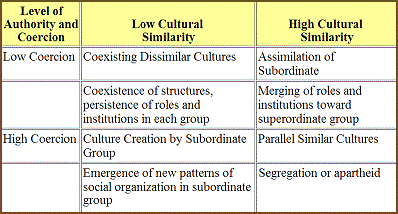 |
Rothstein views two variables as primarily determinative of the adjustments to be expected during acculturation.
- First there is the level of coercion or force, the level of power or authority which the superordinate culture imposes on the subordinate culture during their mutual interaction.
- The second major variable is cultural similarity, the degree to which the worldviews and social structures of the two cultures are compatible.
- These two factors may be used to predict in a general way the probable result of interaction between humanity and an extraterrestrial civilization.
As Table 26.3 demonstrates, Rothstein’s methodology indicates that in cases of contact with ETs (low cultural coincidence, low structural compatibility) the restrained use of force and overt authority will result in humanity retaining its own institutions and heritage. In the event of higher levels of coercion, historian McNeill's predictions may come to pass:
- Confronted with hostile aliens, mankind may be stimulated to produce new patterns of social organization and novel cultural elements.
|
Of course, physical contact and the exchange of
artifacts are not essential for cultural response. has ever been dominated by another solely by radio contact, much of Western civilization is based on ancient Hellenic tradition. reflects many of the values and principles of an "alien" culture thousands of years, rather than thousands of light-years, distant from us. |
How will first contact affect our society? It is again important to distinguish between Remote Contacts (perhaps by radio), in which impact would be minimized, and scenarios involving Direct or Surprise Contacts (e.g., Bracewell probes, UFOs), wherein impact would be at a maximum.
| Life goes on |
When the first message from the stars is received, the impact may be expected to be similar to that of other major discoveries in the past. Most likely, life will continue on much as before. For instance:
- While the heliocentric cosmology advanced by Copernicus in 1543 was an intellectual bombshell for churchmen and university professors, the average man remained unaffected by the revelation.
- In the last century the revolutionary ideas of Charles Darwin caused quite a stir in high society at the time, but there was little social impact until decades later when the Scopes "monkey trial" came to public attention.
- The discoveries of modern science in this century — the expanding universe, the DNA molecule, and so on — have diffused into society at a fairly slow pace.
- Nowadays, remarks one writer wryly, people are actually bored with the notion of men walking on the Moon. We are accustomed, he says, "to receiving graphic new cultural and intellectual inputs via TV and movies — views of far-off lands, strange people, and curious customs — but are very little affected by them.
- A long-distance radio message from the stars would seem relatively innocuous."3257
| Change in perspective |
Many philosophers have insisted that, in the long run, humanity will undergo a dramatic change in perspective. The smallness and uniqueness of our Earth will suddenly be thrust upon us.
- Humans may become more aware of their common humanity.
- Philosophy Professor James L. Christian believes that "at last we will have a mirror by which we can look at ourselves as human beings."1620
| Lenin agrees |
Apparently Lenin, the founder of Soviet bolshevism, agreed. |
In a conversation with H.G. Wells in 1920, the Russian leader is reported to have remarked:
All human conceptions are on the scale of our planet. They are based on the pretension that the technical potential, although it will develop, will never exceed the terrestrial limit. If we succeed in establishing interplanetary communications, all our philosophical, moral and social views will have to be revised. In this case, the technical potential, become limitless, would impose the end of the role of violence as a means and method of progress.3586
| Extreme reactions |
But what of the average person? How would he react? |
- It is possible that a few people, upon learning of the Contact, might plot to destroy all major radiotelescope facilities so that no messages could be sent out (the "Earth Security League").
- Or the destruction of all observatories may be motivated by religious fervor to "avoid evil temptation" or to "turn one’s ear from the Devil."3630
- Others might plot to send messages (where these had been prohibited by the government), in order to establish contact with the "angels from space," the "ministers of our salvation," or the much-needed "facilitators of higher consciousness" (the Sentience Liberation Front?)
| Majority remain unaffected |
Still, the majority of people would probably remain unaffected. Says Arthur C. Clarke: |
Although the philosophical — and sensational — impact of such a discovery would be enormous, after the initial excitement had ebbed, the world would probably continue on its way much as before. Once he had read a few Sunday supplements and watched a few TV specials, the proverbial man in the street would say: "This is all very interesting, but it happened a long time ago and hasn’t anything to do with me." And he would be quite right.373
| Cultural preconditioning |
Even in the context of a Direct Contact with extraterrestrial life, many writers believe that so much cultural preconditioning has taken place that the event would come as an anticlimax rather than a shock. Ian Ridpath speaks from personal experience:
I recall joining an audience of several hundred people at Caxton Hall, London, in 1973 to hear Duncan Lunan describe what he believed might be a radio message from an alien space probe. The scene reminded me of nothing so much as Professor Challenger’s public address on his return from the Lost World, in Conan Doyle’s book of the same name. The press had heard of Lunan's ideas, and the meeting had been widely publicized. But there was no panic; no hordes tried to force their way in, and the audience remained calm throughout. A similar religious orderliness prevails at UFO group meetings. From this I can only conclude that people are either thoroughly prepared to meet extraterrestrials, or that they don’t believe what they are being told.3257
| Public interest at a peak |
Still, the social impact of meeting ETs "in the flesh" may be enormous. Public interest certainly will be at a peak.2166 In one of his recent science fiction novels, James P. Hogan describes the scene near a well-publicized first contact site:
A peppering of colors, becoming denser as the hours went by, appeared on the green inland slopes that overlooked Ganyville, as the first spectators arrived and set up camp with tents, sleeping bags, blankets and picnic stoves, determined to secure and hold a grandstand view. A continuous cordon of jovial but overworked policemen, including some from Italy, France and Germany since the numbers of tiny Swiss force were simply not up to the task, maintained a clear zone two hundred meters wide between the rapidly growing crowd and the perimeter fence, while on the lakeward side a flotilla of police launches scurried to and fro to keep at bay an armada of boats, yachts and craft of every description. Along the roadsides an instant market came into being as the more entrepreneurial members of the shopkeeping fraternity from the nearby towns loaded their stocks into trucks and brought the business to where the customers were. A lot of small fortunes were made that day, from selling everything from instant meals and woolly sweaters to hiking boots and high-power telescopes.3518
| Effects on business |
For weeks or months following the encounter, business worldwide will operate in slow motion due to absenteeism, daydreaming, extended coffee breaks, and higher incidents of industrial accidents.
- The stock market will fall precipitously for a brief time. Uncertainty, change, and threatened disasters always depress the Dow Jones,1173 but stocks will slowly recover as it is discovered that the aliens represent no serious immediate threat.
- Selected industries may suffer permanent depression if it appears their product may be rendered obsolete because of an influx of advanced extraterrestrial technology.
| Other effects |
- Media industries will boom; motion pictures, TV documentaries and interviews, fact books and novelizations, opinion polls, magazine articles, Broadway plays, "Sounds of Space" records, special exhibitions and other events pertaining to the ETs will capture and hold the public attention.
- Tourism will increase to the locale of the original alien landing site.
- "Alien jokes" will make the rounds in governmental and business circles; a wealth of "star-slang" should appear; new drinks will be named after the space creatures and their physical attributes.
- Aggressive merchandising will exploit the ready market for ET-oriented toys, games, tee-shirts with catchy slogans, masks, alien dolls, helmets, buttons, bubble gum, bumper stickers, wall posters, models, pendants and rings, articles of clothing, automobile designs, haircuts and toothpaste and "authentic replica" alien artworks, instruments and musical scores.
| Fads of imitation |
Fads of imitation may spring up on college campuses and elsewhere in the community especially among younger people who are still searching for an identity.
- Much like the behavior of the devotees of Star Trek, and the imitative "toga parties" that sprang up across the U.S. following the release of the popular movie "Animal House," fans of the ETs and their culture may try to adopt alien ways, manners of dress, and customs.
- Some of these may prove particularly offensive to the general American public — the aliens may have "disgusting" habits, such as that of Indian Prime Minister Morarji Desai who is accustomed to drinking his own urine (one 8 oz. glassful each morning) for its supposedly rejuvenative properties.3627
| Promote détente |
Others may promote détente. According to one "Trekkie" anecdote: |
Fanzine publisher Fran Hitchcock was walking past the Soviet embassy in New York City recently when a ball flew over the fence and landed at her feet. As she threw it back, she noticed the waiting boy was wearing a blue Mr. Spock shirt. She made Spock's Vulcan sign for "live long and prosper" (palm facing out, hand split between the middle and fourth finger). Not a word was said but the Russian boy returned the Vulcan greeting.3587
| Enrichment of the humanities |
There is a tremendous potential for the enrichment of art, music, dance, literature, architectural design, and other aspects of human culture. A wonderful new richness of experience could be ours.
- To witness the visual art forms of an alien species that "sees" with sound (such as intelligent extraterrestrial dolphins).
- The music of sentient creatures that "hear" with scent.
- Or a ballet performance by graceful unjointed multiped alien dancers whose native habitat is three-dimensional (sea or space) could vastly expand the cultural horizons of mankind.
| Severely culture-shocked dancers or painters |
On the other hand, what happens to those artists who desperately want to adopt or mimic alien ways, but are physically incapable of doing so?2929
- Weird skeletal structures, metabolisms, and muscle distributions within the body will permit some ETs to see, hear and do many things beyond human abilities.
- One can imagine severely culture-shocked dancers or painters willingly undergoing delicate, painful and expensive surgery on limbs or eyes in an attempt to emulate the extraterrestrial mode of expression.
| Orgiastic dances |
The orgiastic frenzied nature of some religious dances such as the Greek Dionysiac rituals have emerged repeatedly throughout history, the most extreme examples being the quasi-religious dance hysterias that broke out during the Middle Ages.
- Periodically there are outbursts of "primitive" dancing, often touched off, many believe, by contact with some new dance influence.
- An example in recent times is the strong influence on Europe of North/South American and West Indian dance forms during and after each of the two World Wars. Exhibitions of peculiar alien dances in terrestrial theaters may cause similar effects.
| Eating habits |
Another response to Direct Contact may be a change in our eating habits. |
- Besides the possibilities of strictly imitative behavior, consumption of meat may fall to an all-time low.2117,712
- Human beings, note philosopher Robert Nozick, justify the eating of meat on the grounds that the animals we kill are too far beneath us in sensitivity and intelligence to bear comparison.3202
- An encounter with another sentient species will focus attention on interspecies relations and the way we treat other "intelligent" species on this planet — dolphins, primates, dogs, pigs, goats (we eat them).3380
- If representatives of a truly superior extraterrestrial race were to visit Earth and apply the same criterion, they could proceed to eat us in good conscience.
- That is, if we allow ourselves to dine on the semisentient nonhumans who share our planet with us, what ethical barrier can stand in the way of highly advanced, hungry aliens seeking to augment their otherwise drab starship menu with a side order of hairless-primate meat?2136
- There may be a strong resurgence of vegetarianism.
| Division into subcultures |
American society may be analytically divided into numerous subcultures, each of which will have its own peculiar reaction to the first contact event. While the exact response will depend heavily upon the nature of the alien, the method of encounter, and the character of the media coverage, a few tentative generalizations may perhaps be offered. For instance:
- If the extraterrestrial sociobiology includes within the species a sentient male and a nonsentient female sub-race (like Larry Niven's fictional Kzinti), it is hard to imagine that the National Organization for Women (NOW) and other women’s rights groups would be very happy about it. Violent confrontations with representatives of the alien culture are not inconceivable.
- On the other hand, aliens with perfect equality among the genders (there may be more than two) or monosexual ETs might be more readily accepted, and could even serve as the basis of a new publicity campaign in favor of the Equal Rights Amendment or other similar political issues of the day.
- Hermaphroditic, parthenogenetic, and variable-sex aliens would be perplexing and difficult to deal with conceptually by all parties concerned.
| Generation gap |
Age could be another distinguishing element. |
- Older people grown used to the prospect of imminent death and the expectation of Social Security benefits might resent the appearance of beings who hold out the promise of rejuvenation or medical cures for senescence and aging of which they could not personally partake (because of irreversible prior deterioration).
- Younger persons would welcome the opportunity to remain youthful forever, creating a new kind of "generation gap".
| Other possible consequences |
- Diehard football and baseball fans would become incensed when the Super Bowl or the World Series was pre-empted to cover some event involving the aliens.
- Political activists would resent the government’s preoccupation with the extraterrestrials, believing that the encounter had diverted official attenton from the immediacy of their cause. (Some might turn to terrorism or other extreme tactics to regain the public spotlight.)
- Devout fundamentalists will curse the "atheists from space" (if the aliens are atheists), or denounce the aliens' own religion as heretical (if the aliens are theists).
- Industrialists will want to learn how to drill, mine, and mass produce goods more efficiently; environmentalists will want advanced lessons in planetary conservation.
- Antitechnologists will beg the ETs to keep their mouths shut, but their very arrival will bear testimony to the practicality and utility of high technology for any developing civilization.
- The space program will be vindicated and funding increases will be authorized without delay by Congress, provided the alien visitors do not preach a message of technological evil.
| International celebrities |
The ETs may become international celebrities, traveling around the country and the world meeting the public. The author is reminded of film clips of people cheering and chasing after a train, from whose caboose a strange large-eared creature waved a tiny hand and smiled at the crowd.
- The occasion was "Mickey Mouse’s Fiftieth Birthday," in November 1978. Asked Jack Perkins, an NBC newsman, with unexpected aptness: "Do you know many humans who would draw those kinds of crowds?"
| New cults |
Would new cults and other organizations spring up in response to the presence of the extraterrestrial visitors?262,3628 |
- People who remain skeptical or uncertain as to the reality of the Contact are unlikely to develop a grassroots antigovernment campaign unless there is a clear-cut threat or deprivation to mobilize collective action.3636,3637
- At the other end of the "believer" spectrum, however, many existing groups may be preadapted for extreme behavior and may mobilize into action (proselytizing, organizing demonstrations, etc.). The Directory of the Religious Bodies in the United States (Garland,1977) lists twenty-three distinct denominations which originated from purported contacts with beings in flying saucers.
| Doomsday cults |
According to the unidentified Yale psychologist who participated in the 1973 study chaired by Leon Festinger: |
There are the religious doomsday cults that thrive on flying saucers and little blue humanoids. All the publicity about their "thing," on which they practically held a monopoly until the upcoming TV show, will mobilize them to become more active in making statements to the press; some will predict that the alien civilization will destroy the earth next Tuesday. When their prophecies fail, some of these groups will react the way the doomsday group studied by Festinger, Riecken and Schachter1757 did — markedly increasing their proselytizing behavior. Other such groups, however, may limit themselves to a "joyous reunion" when their prophecies fail, as did the members of the "Church of the True World" studied by Hardyk and Braden.3576
The proselytizing activity of some of the doomsday groups will be matched and possibly exceeded by that of religious youth groups, like the jesus freaks, who will treat the [Contact] story as a long-awaited sign that superhuman forces are at work in the universe. Many of the people who were impressed by the "Chariots of the Gods"1326 (the book and the movie) and who are longing for an out-of-this-world hero like the "Stranger in a Strange Land"2643 will rally to the cause of the blue humanoids and endow them with superhuman loving kindness and messianic qualities. Support for the messianic religious movement — in the form of joining the group, participating in religious ceremonies, etc. — will be greatly increased insofar as the authenticity of the aliens is attested to by reputable scientists and political leaders. (A messianic movement in Europe several centuries ago was given just such impetus when leading authorities of the time endorsed the authenticity of the messiah, as described by G. Scholem in "Sabbati Sevi.) But the messianic movement may be limited in its appeal, attracting mainly those already predisposed to religious fringe movements. It will have more widespread appeal if the aliens encourage it, directly or indirectly, by claiming that they will help earth people to save themselves from the evils that beset mankind. In this case, a much more popular messianic religious movement is to be expected, especially if it is endorsed by prestigious national leaders.1640
Xenophobia — the distrust of strangers — is another likely response by many people.
- Inhumane attitudes towards human "monsters" and congenital "freaks."3609
- The 17th century public persecutions of suspected witches in Salem, Massachusetts.
- And countless other episodes of poor treatment of foreigners1846 lead the author to conclude that some will welcome the aliens' arrival with hoots and jeers of derision, open hatred and jealousy, and sadistic plots for exploitation.
- Will we exhibit the infamous "Cockroach Response", where we try to stamp out an alien creature simply because it is different?720
- (Asks Ray Bradbury: "Confronted with beings resembling cockroaches will we pause to consider whether their IQ is 50 or 250? Or will we simply build the grandest shoe in history and stamp them out?"147)
| Surprise becomes fear; fear becomes war |
According to science fiction writer Katherine MacLean: |
When we read the National Geographic on historical fiction, and when we read science fiction we are eager to understand and enjoy the stranger and find adventure in the strange, we change from xenophobes to xenophiles, lovers of the outlandish, finding mental refreshment in the strange universe the world becomes when viewed through strange eyes.
The function of intelligence is to understand, predict, and control the unfamiliar. It enjoys functioning. So we will travel looking for alien races and they will travel looking for us. But when we see each other, interesting differences suddenly become terrifying abnormalities. Surprise becomes fear; fear becomes war.3097
| Threat to culture |
Perhaps it will turn out that there is nothing in the natural world, however strange its appearance may be, that we cannot eventually grow accustomed to.81 But the fear that strangers may pose a threat to native culture is endemic to most societies on Earth.3525
- During the 1800s fully one-third of the American population supported "nativist" (xenophobic) movements.1846
- When extraterrestrial beings visit Earth, the perceived threat to human culture may become so intense as to impel many to search for a measure of security in organizations promising to perpetuate those traditions we call our own.3643,3344,3610
| Blue Menace movement |
The Yale psychologist from the Festinger study continues: |
If the dissimilaries between the aliens and us are stressed in the mass media, and if the visitors continue to be kept in isolation, and if there are no promises of interaction between mankind and other representatives of the extraterrestrial civilization, then the more hostile type of fringe-group movements will be aided in recruiting more participants. These groups are generally made up of people who have seen better days and who chronically project evil intentions to out-groups. Many of the members seem to be addicted to patriotic fervor, directed against enemies from within and from without, because it provides them with compensatory feelings of restoring their lost status.243,3638 (There may even be plots to abduct and kill the aliens.) But as long as the mass media continue to emphasize the main message of the upcoming TV press conference — that the aliens are benign, friendly, and cooperative — the Blue Menace movement is not likely to become anything more than a slightly expanded fringe movement.1640
There is also the distinct possibility that humankind may suffer from the effects of "culture shock" in varying degrees. Culture shock has been described as a profound disorientation suffered by the traveler who has plunged without adequate preparation into an alien culture.
- There is in any Direct Contact situation the immediate danger that first encounter might wreak such profound changes in terrestrial society that people would become alienated from their own culture.
| Cultural fatigue |
Anthropologist A.L. Kroeber of the University of California at Berkeley has described the related phenomenon of "cultural fatigue" among the Polynesians of Hawaii.
- Captain Cook had discovered the islands in the late 16th century, and during this contact the natives had observed the Europeans repeatedly broaching a number of local religious taboos (women could not eat bananas or coconuts, men and women could not take meals together, etc.) without suffering any punishment at the hands of the gods.
- In 1819, five months before the first missionary landed on the islands, the Hawaiians in a single stroke abolished their religion.
- Says Kroeber: "The main factor seems to have been a kind of social staleness; the Hawaiians had become disillusioned, and tired of their religion.
- In addition, the whites enjoyed prestige with their guns, steel tools, and big ships; and, by extension, their only vaguely known religion was probably accounted superior."889 (Margaret Mead has described a similar effect among the Manus in New Guinea.3625)
| Cargo Cults |
The less advanced culture involved in the Contact may be subject to peculiar cultural pathologies. |
The New Guinea Cargo Cults are a familiar example of this.1218,895,3599
- After extensive contact with Western culture and artifacts, native islanders developed a powerful conviction that spiritual entities would deliver large cargoes of technological goods into the hands of true believers.
- Other examples of such retrogressive behavioral systems include the Slave Society of Jamaica,3597 the Peyote Cults and Ghost Dance of certain American Indians,3635,812 the Kingdom of Father Divine,3645 and of destructive potlatch among the Kwakiutl, the aboriginal inhabitants of Vancouver Island in Canada.2581
| Anthropological evidence |
Is this a likely prospect for Western civilization? |
- Anthropological evidence seems to suggest that such extreme pathologies generally result either from extensive physical contact between disparate cultures, or from territorial expansion by the stronger society, or both.
- If we are overwhelmed by an aggressive extraterrestrial race, we may see the emergence of cults on Earth which zealously glorify or denigrate our interstellar captors.
- Furthermore, research shows that millenarian movements, uprisings and cargo cults generally accompany the first stages of culture contact, while political movements and the emergence of churches and separatist sects appear only in more advanced periods of contact.3590
| Remote Contact of years distant |
Of course, physical contact and the exchange of artifacts are not essential for cultural response. Although it is probably true that no society has ever been dominated by another solely by radio contact, much of Western civilization is based on ancient Hellenic tradition. Like a kind of Remote Contact, our society today reflects many of the values and principles of an "alien" culture thousands of years, rather than thousands of light-years, distant from us.
How would the major world religions, particularly Christianity, react to first contact? Here there is the opportunity for the gravest misunderstandings between races. This problem is well illustrated by the remarks of Robert Hamerton-Kelly, Dean of the Chapel of Stanford University, at a recent SETI Symposium:
Does an extraterrestrial intelligence have a conception of God? I'd guess that they do, and that it'd be like ours. If they don’t have a notion of God, frankly the first-thing I'd like to do is send missionaries.2160
| Convert and baptize |
According to Father Clifford Stevens, a Roman Catholic priest and former Air Force chaplain, the central issue is whether Christians should "attempt to convert and baptize intelligent creatures from other planets, creatures who are not children of Adam and who may not have received or needed the redemption brought by Christ."1333
| Two gifts / four states |
As best the author can discern, modern Christian theology holds that beings from other worlds may be created in any of four distinct states, depending upon the qualities which the Creator has chosen to bestow upon the race.
(See Donceel,719 Zubek,119 Raible,116 Lewis,107 Grasso,326,113 Perego,115 and Stevens.1014)
| Two gifts |
There are two kinds of gifts — hence four possible combinations. |
- Preternatural (gifts of the body, such as knowledge, long life, freedom from disease and accident).
- Supernatural (gifts of the soul, such as sanctifying grace and other "privileges which partake of the nature of the divine").
| Four states |
- State of Pure Nature — no gifts of the body or of the soul. Such beings would enjoy only ‘those qualities which are proper to a rational animal" and nothing more.
- State of Integral Nature — gifts of the body but not of the soul. These creatures would enjoy various preternatural advantages over mere rational beasts but would retain a "natural destiny."
- State of Supernature — gifts of the soul but not of the body. This would be a race of rational beings with a supernatural destiny and possessed of sanctifying grace which would make them capable of "quasi-divine acts," despite their lack of preternatural gifts.
- State of Innocence — gifts of the body and of the soul. Such beings would enjoy "a relatively carefree life," with "no disease, concupiscence, ignorance or death" and everlasting happiness. This enviable condition was the status of Adam and Eve before the commission of original sin.
| Supernatural gifts |
Furthermore, any race endowed with supernatural gifts holds them in trust for God, and therefore conceivably may betray that trust. Hence, beings in a state of pure nature or integral nature cannot "fall" or sin against the Creator.
- Races in a state of supernature or innocence may "fall" from Divine pleasure.
- These latter species may be considered "temptable" in the sense that they are susceptible to the temptation of original sin.
| Four possible conditions |
Once again, there are four possible conditions in which these "temptable" extraterrestrial races may be found, according to traditional theology:
- Untempted by sin as yet.
- Once tempted by sin, but successful in overcoming it.
- Once tempted by sin, fallen, but redeemed by the Creator. (Mankind)
- Once tempted by sin, fallen, and unredeemed by the Creator. (Seen as unlikely by most theologians, in view of "the infinite mercy of God.")
| Redemption |
Redemption could occur in many ways. For example: |
- He could simply forgive the transgression and re-elevate the race to its previous dignity.
- He might demand merely a partial satisfaction for the offense, perhaps accomplished by one or more representatives (Redeemers) of the fallen species.
- He could demand personal disposition from each individual, in the form of repentance, for the forgiveness of sins.
- Finally, God might choose a combination of the above, combining the mediation of a Redeemer with the cooperation of repentant sinners.
| Gifts returned |
Another aspect of redemption that would depend entirely upon the will of God is the number and kind of gifts which He would return to the redeemed race. According to Father Daniel G. Raible of Brunnendale Seminary of the Society of the Precious Blood:
In the case of our mankind, He willed to return only the supernatural gift of sanctifying grace, without the preternatural gifts of infused knowledge, freedom from concupiscence (perfect control of the will over man’s lower faculties) and immortality. Another fallen race He might treat differently, by returning both the preternatural and the supernatural gifts.116
| Religion and xenology are compatible |
Taking this broad theological viewpoint, the discovery of extraterrestrial intelligence presents no insurmountable difficulties to current conceptions. It is clear that the concepts of God, preternatural and supernatural gifts, and the basics of redemption are not called into question or challenged in any way by the existence of ETs. Theologists will merely classify the space creatures according to traditional categories. Religion and xenology are quite compatible.
| Ticking ltime bomb |
Many writers have argued that the particularistic character of most of human revealed religion must inevitably doom it when sentient life is found in space.71 For example, Arthur C. Clarke suggested nearly two decades ago that:
The proof, which is now only a matter of time, that this young species of ours is low on the scale of cosmic intelligence will be a shattering blow to our pride. Few of our current religions can be expected to survive it, contrary to the optimistic forecasts from certain quarters. The assertion that "God created man in his own image" is ticking like a time bomb in the foundations of Christianity. As the hierarchy of the universe is slowly disclosed to us, we will have to face this chilling fact: If there are any gods whose concern is man, they cannot be very important gods.55
| Resiliency of the church |
This and similar appraisals that appear frequently in the literature appear to be rather serious overstatements of the expected consequences of discovering alien lifeforms.3370,1231,206,3607 In light of the adaptation and survival of Roman Catholicism in spite of Copernicus, Galileo, and Darwin, it seems ludicrous to suggest that the Church would be destroyed by any Contact less severe than acculturation resulting in extinction or total assimilation of human society (in which case religion would be the least of our worries).3589,1776 As science writer Kendrick Frazier admits:
Institutions, especially those with a good record for endurance, have a certain amount of stretch built into them; thus it may be an underestimation of their resiliency to expect them automatically to crumble at the first hello from elsewhere in the galaxy.1938
| Only Earth has been redeemed |
There seems to be at least two viable viewpoints from which Christians (and members of other particularistic faiths) can view the problem of exterrestrial sentience without precipitating theological catastrophe or dogmatic crises of inconsistency.
- First, the terrestrial messiah may be regarded as unique in all the universe.103,978,104,562
- In this conception, only Earth has been redeemed. For instance, since Christ took human form, only human beings have been rescued from spiritual oblivion by God. Alien races comprised of nonhumans, who are deemed "fallen" by the Church, cannot have been saved by Jesus, who was human.
- The ETs thus are either the fallen sinful, unworthy of the Creator’s salvation and hence to be quarantined and forever shunned by humanity (lest we become tainted with "diabolical" evil), or they are the redeemable unredeemed, in which case missionaries should be dispatched immediately to bring them the "good news" of Christ on Earth.3596
- Any local messiah whom the extraterrestrials may claim as their own redeemer is a false prophet or "antichrist," an apparition of the Devil to be exorcised by special ritual cleansings, crusades or holy wars of extermination, or Divine intervention.
| Effrontery to common sense |
Besides violating the Principle Thermoethic, the above (self-consistent) conceptual framework also violates one of the cardinal assumptions of xenology — the Hypothesis of Mediocrity.
- Roland Puccetti at the University of Singapore has calculated that if there are 100 million sites of extraterrestrial intelligence in our Milky Way galaxy, and at least 10 billion galaxies in the universe, then if each such community had but one distinct religion of its own there would exist some 1018 independent sacred traditions throughout the cosmos.71
- By what horrendous effrontery to common sense, he asks, can Christians claim that Christ chose to redeem only Earth instead of one of the 1,000,000,000,000,000,000 other sentient races in the universe?
| Slumming in space |
A few theologians are willing to do without the Hypothesis of Mediocrity. |
According to Dr. Andrew J. Burgess, visiting associate professor of religious studies at Cleveland State University:
- The setting of the bible is not in mighty Rome or Greece but in remote Palestine.
- The actors are a small band of slaves who migrate to an out-of-the-way territory and never even manage to control that for more than brief periods of time, rather than a powerful people shaping history.
- The Messiah was born of obscure parents, spent his early years in backwards Galilee, assembled an otherwise undistinguished crew of followers, and finally was executed as a common criminal. (God has shown "an exasperating tendency toward what, in other contexts, one would have to call slumming.")
- Thus it should not seem at all strange to speak of Christianity as beginning on "an insignificant planet of a secondary star of an unimpressive galaxy somewhere out in space."2606
| Terrestrial messiah is not unique |
More intellectually preferable is the second viable Christian viewpoint alluded to earlier: That the terrestrial messiah is not absolutely unique in all the universe, that other races may be redeemed by Him, and that Jesus may have assumed different physical forms on different worlds.1558,100,356,108,109,3632,3558 Notes Father Raible:
Suppose that God intended to demand adequate satisfaction from a fallen {extraterrestrial} race. That would necessitate that God become a member of the fallen race in order to redeem it. Could it be the same Second Person of the Blessed Trinity who became incarnate for our salvation? Yes, it would be possible for the Second Person of the Blessed Trinity to become a member of more than one human race. There is nothing at all repugnant in the idea of the same Divine Person taking on the nature of many human races. Conceivably, we may learn in heaven that there has been not one incarnation of God's son but many.116
| Saving power: in all places |
Paul Tillich, one of the foremost Protestant theologians, is in basic agreement: |
Incarnation is unique for the special group in which it happens, but it is not unique in the sense that other singular incarnations for other unique worlds are excluded. … Man cannot claim to occupy the only possible place for Incarnation. … The manifestation of saving power in one place implies that saving power is operating in all places.3591,3592
| Theological imperialism |
In this view the Church will not be interested in converting other planets to Christianity105,1014 C.S. Lewis stood firm against "all theological imperialism." Said he: "To different diseases, or different patients sick with the same disease, the great Physician may have applied different remedies."106 The Lord's mission was to Earth only, to the human race — other intelligent species did not share in the Fall and thus do not require redemption. Or, if they are not in a state of grace then God will have made His own provision for them.3593 Jesuit Paul Curtin of Boston College insists that there exists no theological authority for man’s spiritual proselytizing beyond the Earth:
The only theology I know or can know is that of a revealed God in relationship to the children of Adam. If there are beings on another planet, then they must be the object of another Providence. They are not the children of Adam, and so they are not a part of our salvation history, which is that of a fallen and redeemed race.259
| Descended from Adam, born in original sin |
Professor Eduard Stakemeir, Roman Catholic theologian at the Philosophical-Theological Academy at Paderborn, Germany, is in full agreement:
The inhabitants of other worlds could be like us, but they could also be much superior to us in sense and will. And perhaps they also surpass us in gratitude to the Creator and in goodness and love to all that demands love and kindness. [But] in principle we must say that the Christian order of redemption was realized by God for this world. Only we, who are descended from Adam, are born in original sin, and God became man to redeem us. His church and His sacraments are not valid for other planets.118
| Infinitely partitionable |
Only one minor technical problem remains if the above position is adopted. |
Recall the calculation that there may be as many as 1018 religious traditions extant in the universe.
- Assuming most of these required a redemption, and if Jesus' lifetime on Earth is considered typical (about 30 years), then 3 × 1018 years would have to transpire for the Son of God to pass from birth to resurrection on each inhabited planet of the cosmos.
- This is about 100,000,000 times the estimated age of the universe, so either the cosmos are very much older than scientists suspect, or the relative fraction of redeemed civilizations is exceedingly small (i.e., most races never fall, or go unredeemed).
- Or at any given time approximately 100,000,000 Incarnations must be occurring simultaneously throughout the cosmos.
- While a few philosophers have argued that one God cannot be in more than one place at a time,71 the better theological view seems to be that the Supreme Being, who is both omnipotent and omniscient, may also be omnipresent and infinitely partitionable without dilution.2865 There is theological precedent for this viewpoint in the traditional Christian doctrine of the Trinity.
| Sufficiently resilient |
All this is not to suggest that human religious institutions will be unaffected by the discovery of extraterrestrial intelligence. Far from it. Major modifications and adjustments will have to be made in order to adapt to changed circumstances and to respond in a meaningful way to alien revelation (or the lack thereof). Hardest hit will be those people whose attitude is characterized by "I have a private conviction that They'll turn out to be Catholics after all."102 The more excessive the chauvinism, the greater the shock. But most world religions are probably sufficiently resilient to absorb such events without ill effects.
Anthropologist Leslie White has suggested that all civilization ultimately rests upon a foundation of science and technological achievement. A culture's social order and philosophical assumptions are determined to some extent by scientific knowledge and its application. Xenologists are therefore very interested in the effects on human science if extraterrestrial intelligence were discovered elsewhere in the cosmos.
| More than half the battle |
Arthur C. Clarke offers a highly optimistic vision: |
The things we could learn might change our own society beyond recognition. It would be as if the America of Lincoln's time could tune into the TV programs of today; though there would be much that could not be understood, there would also be clues that could leapfrog whole technologies into the future. (Ironically enough, our commercials would contain some of the most valuable information!) Nineteenth Century viewers would see that heavier-than-air machines were possible and simple observation would reveal the principles of design. The still-unguessed uses of electricity would be deomstrated (the telephone, the electric light) and this would be enough to set scientists on the right track. For knowing that a thing can be done is more than half the battle.373
| Impact of the message |
In a Remote Contact scenario, the impact of the message is likely to be fairly small.15,3241 |
- At first only very little about it will be known, save that it exists, and perhaps some general information about the source.
- This in itself may be very significant, for it will tell us that it is possible for technological civilizations to survive long enough to gain control over tremendous energies and devices.
- Such information may prove extremely valuable for all of humankind: The Von Hoerner Feedback Effect named after its originator, hypothesizes that the mere knowledge that cultural longevity has been achieved by one culture may enable others to do the same.1054
- Using this idea the most harmless message with the greatest potential for good (hence most ethical) would, according to Princeton physicist Gerard K. O'Neill, be "the flash of a lighthouse, a simple message endlessly repeated carrying just enough information so that we know it was formed by intelligence."2710
- For the first time in many peoples lives, they would take a look at where they stood in the galaxy and the universe.
| Voluminous technical information |
Assuming another civilization more generously beams us all the information they have, how would this affect human science? Says Philip Morrison:
And you will have pouring into the radiotelescope's recorders, week after week, month after month, decade after decade, an enormous body of obviously interesting and meaningful postals. You will be able to read them, slowly and fitfully, because they will not be coded but anticoded; the beings who designed them will have thought very carefully how to make the meaning clear. And it will be a large volume of material, not something that the "New York Times" will publish in its entirety. It will be too voluminous, too technical, too uncertain, too much in need of study. So I do not think we are talking about just a normal enterprise; we are talking about an enterprise more like the development of agriculture than even the discovery of America.24
| A discipline rather than a headline |
Scientific shock will thus be mitigated by the long time necessary to receive, decode, and digest the information from the stars. It will require the full equipment of human scholarship over a period of many decades — in the words of one xenologist, it will more resemble "a discipline rather than a headline or an oracle."22
| Decades to receive |
Even taking the optimistic assumptions about human radio equipment and the maximum bit rates we can receive across interstellar distances, it is doubtful that such messages could ever come to totally dominate human experience. A simple calculation reveals the truth of this.
- Since about 1011 humans have ever lived; each with an average lifespan of about 109 seconds, and each processing conscious data at a rate of about
10 bits/second, the net human informational heritage is roughly 1021 bits total. - According to Philip Morrison, the best analogy to a message from the stars would be the impact on modern thought of the Greek world. As a body of material it can be summed up in about 10,000 books, written from Hesiod to Hero down to the Alexandrians.
- If we add in the number of volumes of photographs and other materials necessary to describe the architecture, climate, pottery, fish, botany and whatever else is required to give us the context of Hellenic times, then the best estimate is that the total information transmitted to us from the Greeks is about 1012 bits.22
- Across a distance of 100-1000 light-years the Arecibo radiotelescope would require decades to receive all of this.
| The galactic heritage |
What might the messages tell us? According to B.M. Oliver: |
The galactic heritage could include a large body of science that we have yet to discover. It would include such things as pictures of the Galaxy taken several billion years ago; it would include the natural histories of all the myriads of life forms that must exist in the planets of their member races. We could see the unimaginable diverse kinds of life that evolution has produced in other worlds and learn their biochemistries, their varieties of sense organs, and their psychologies. Culturally, we might learn new art forms and aesthetic endeavors.
But more significant will be the societal benefits. We will be in touch with races that have achieved longevity. The galactic community would already have distilled out of its member cultures the political systems, the social forms, and the morality most conducive to survival, not for just a few generations, but for billions of years. We might learn how other races solved their pollution problems, their ecological problems, and how they have shouldered the responsibility for genetic evolution in a compassionate society.3606
| Inferiority Syndrome |
There are two major concerns about extraterrestrial messages which crop up rather frequently in the literature. The first of these might be called the Inferiority Syndrome — the notion that a meeting with a race that is too superior might produce a kind of racial inferiority complex, a sense of worthlessness and utter futility in being human.1766,2170,875,81,24
- Or, as G.C. Homans has observed: Anyone who accepts from another a service he cannot repay in kind incurs inferiority as a cost of receiving the service. The esteem he gives the other he forgoes himself.3571 This phenomenon has also been refered to in the literature as "ego blow".3663
- While this reaction is certainly possible, in general students do not become disturbed when their teachers appear smarter than they. And if the teachers are so vastly smarter than the pupil (as, for instance, when Einstein teaches his dog a trick), it is likely that the student will remain more or less unaware of the vast intellectual gulf that separates them.
- The further apart two beings are in sentience, the less they have to talk about and the fewer are the opportunities to display crushing mental superiority.62
| Library Effect |
The second and more serious objection to the receipt of alien messages might be called the Library Effect. |
- As Joshua Lederberg recently asked,3241 might not the realization that it's "all in the library" somewhere have a demoralizing effect on research scientists?2210,24,2879
- Comments O'Neill: "Why continue to study and search for scientific truth on our own? Gone then the possibility of new discovery, or surprise, and above all of pride and accomplishment; it seems to me horribly likely that as scientists we would simply become television addicts, contributing nothing of our own pain and work and effort to new discovery."2710
| Live, persevere, and maintain |
Philip Morrison counters with the argument that all scientists today must face the possibility that someone has already solved the problem they are working on, or will do so before they can.3241 This does not deter research.
- Few have rejected schools because teachers and textbooks exhibit learning of which they were thus far ignorant.2865
- Whatever the extraterrestrials may know, there will always be new possibilities (recall Gödel’s theorem), and whatever we think we are learning from the ETs will have to be checked out experimentally before scientists should rely on it. Furthermore, says Morrison:
I think the most important thing the message will bring us, if we can finally understand it, will be a description, if one exists at all, of how these beings were able to fashion a world in which they could live, persevere, and maintain something of worth and beauty for a long period of time. Again, we will not be able to translate it directly and make our institutions like theirs; the circumstances will be too different. But something of it will come through in this way. This will be the most important message we could receive. But it will be more of a subtle, long-lasting, complex, debatable effect than a sudden revelation of truth, like letters written in fire in the sky.24
| Trust them? |
One major difficulty that scientists will have to face whenever they come into possession of alien information concerns trust. |
Can we trust them not to harm us intentionally?
- For instance, assume we receive a message which, directly or indirectly, suggests the following advice: "For maximum political stability worldwide, slow your material-technological growth rate to permit your social technology to catch up."
- While this would doubtless be accepted by many, skeptics might point out that ETs bent on invasion and conquest would find it most convenient to have us keep our material technology in a primitive state.
| Poisoned candy |
There is also the possibility that malevolent alien sociologists have learned that all developing technical civilizations must pass through certain critical points, during which time "triggers" inherent in our society or sociobiology could be tripped off to cause rapid destabilization3593 or self-destruction.3594
- The ETs might, for example, beam us instructions on how to build compact antimatter doomsday bombs using current (primitive) human technology; similarly with bioneering technology, advanced ecology engineering techniques, and so forth.
- They may be handing us "poisoned candy," too sweet for us to resist yet too deadly for us to digest.
- Certainly it is hard to imagine a motive on their part, but since mere information is the energetically cheapest weapon (provided it is effective) xenologists cannot absolutely rule out the possibility. In any event, we should always be extremely wary of accepting any "free" advice.3286
| Security and stability |
As Michael Michaud, U.S. Foreign Service Officer, reminds us: |
Our basic interest will be to protect ourselves from any possible threat to Earth's security. Our second concern would be to assist in developing or to participate in a stable system of interstellar politics that provides an acceptable level of security for all. Our third concern would be to learn from the aliens in order to advance our knowledge of the universe and to add to the tools of civilization. The last interest, so often placed first by writers on this subject, would be meaningless or impossible if the first two concerns had not been satisfied.272,1760
